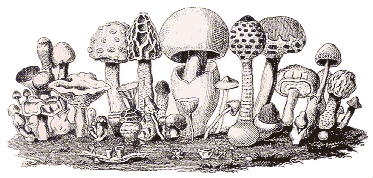(Link to new North West Fungus Group site)
MykoGolfer

The intrepid MykoGolfer, winner of the Golf Cup, is now providing regular updates to our website. Watch this space....
FUNGAL SNIPPETS for 2012 / 2011 / 2010 / 2009
Wednesday 25th December 2024

My turn to cook Christmas dinner this year so having sorted out the duck, sprouts and roasties I took advantage of the unseasonable weather to undertake my last foray of 2024. I was encouraged by the growth of numerous Galerinas (Bells) on the few lawns along the road that have not been converted to parking for cars. The Eric Hardy Reserve was a bit muddy but there were enough fungi in the undergrowth to maintain my interest. A lot of Hemimycena tortuosa (Dewdrop Bonnet) some covered with water droplets. Lentinus brumalis (Winter Polypore) was growing in substantial-number on the fallen branch of a dead cherry tree. Also an interesting find of Crepidotus epibryus (Grass Oysterling) growing on a rotting stem of Himalayan Balsam. These stems can be good for finding Ascomycetes but this is the first time I have recorded a gilled fungus.
Good hunting in 2025.
Saturday 14th December

A bright sunny morning that could not be wasted so I went for a walk locally to Springwood Crematorium and The Eric Hardy Reserve. Still lots of fungi on the lawns but very little elsewhere. Usually, at this time of year, I could guarantee dozens of Rhodoollybia butyracea (Butter Cap) and Clitocybe nebularis (Clouded Agaric) in the woods. Nothing this year. Quite a few regular species have not appeared this year. I was pleased to see that Geastrum floriforme (Daisy Earthstar) was still present. Fortunately my morning took an upward turn when I saw something white on a piece of dead plant stem. It looked like white hairs. Under my hand lens I could see it was a very tiny Typhula on what appeared to be thistle. Out came the books. My conclusion is Typhula uncialis. The photo from my microscope is x40. Very tiny.
Friday 6th December

Taking heed of the weather warnings for an approaching storm I decided to visit Speke Hall fo make a final search for waxcaps on the main lawn. The weather had been nice and there were plenty of fungi around. But they were species that I had seen on my previous visits. The only new Speke Hall record for this year was Stereum rameale on an oak branch. Probably my last visit for this year. Then, when I got home, my wife pointed out a tny fungus growing on my back lawn. It was an Entoloma (Pinkgill). The cap was only 1 centimetre and brown so I had to consult a number of authorities to reach an identification. My conclusion is Entoloma minutum. Not common but it is small and difficult to spot in the grass.
Friday 15th November 2024

A weather forecast of rain and ice at the weekend, persuaded me to have one last attempt at finding waxcaps. The large lawn in front of Speke Hall is the best place I know in my immediate area. Success at last. The main grass area had the usual common varieties in number and had recently been mown. I also noted that someone had been foraying before I arrived as I found a Xerocomus chrysenteron (Red Cracking Bolete) species cut in half which you do to see the colour changes when exposed to air. Obviously someone with knowledge, But who? I therefore decided to search the more remote and undulating areas which would be difficult to mow. Hurrah. Gliophorus laetus (Heath), Hygrocybe chlorophana (Golden) and a lone Hygrocybe insipida (Spangle) in addition to the usual Ivory, Parrot and Meadow Waxcaps. Result.
Monday 11th November 2024
Another attempt at waxcaps. This time at Allerton Cemetery which is a massive city burial ground. Lots of grass. Lots of Cupophyllus pratensis (Meadow Waxcap) and a couple of Hygrocype ceracea (Butter Waxcap) but nothing unusual. The only other fungus was alone Mycena flavoalba (Ivory Bonnet). Where have all the waxcaps gone?
Thursday 7th November 2024
I decided to look for waxcaps. My best chance is the 14th century All Saints Church at Childwall. Unusually disappointing. Only Cupophyllus virgineus (Snowy Waxcap). I did find both Galerina clavata (Ribbed Bell) and vittiformis (Hairy Leg Bell) and a host of probable Geoglossum fallax (Deceptive Earthtonge). So I tried Springwood Crematorium but found only Galerina clavata there as well.
Monday 4th November 2024

I decided to visit what was one of my favourite sites, Allerton Golf Course. It is being redesigned and a lot of it dug up, trees cut down and tons of soil to raise the course and prevernt flooding. Not much left as it is now fenced off and most of the productive areas are inaccesible. I am limited to the sides of the footpath. My few finds included Baeospora myosura (Conifer Conecap) and Tricoloma scalpturatum (Yellowing Knight). Also seen were Aleuria aurantia (Orange Peel Fungus) and Hygrophorud hypothejus (Herald of Winter) clear signs that winter is on its way. Over to the adjoining Allerton Tower where I found a few waxcaps, Gliophorus laetus (Heath Waxcap) and Hygrocybe chlorophana (Golden Waxdcap) in good numbers.
Sunday 27th October 2024

A bright morning so I decided to foray at Speke Hall, getting there early beforte the hordes arrived. Disappointingly there was nothing in the wood surrounding the car park. Nor was there very much on the North Lawn, usually good for waxcaps. Perhaps too early? I decided to take my usual route round the woodland areas. Even there, I struggled to find much until I came across a fallen tree. A tiny orange coloured resupinate attracted my attention. I mamaged to extract it and took it home. It keyed out as Skeletocutis amorpha. Even more spectacular on the next fallen tree were a couple of Pluteus aurantiorugosus (Flame Shield). Not seen very often but they were on the main path so I doubt they would last long. Excellent find for me. Then the kids and dogs started to arrive so I went home.
Saturday 26th October 2024
I needed some shopping. It was a nice afternoon. Having found waxcaps on my neighbours' lawns, I thought I might find something interesting in the local churchyards. There are three Victorian churches near the supermarket. All are well maintained. I visited all three. Total finds was one Cupophyllus virgineus.(Snowy Waxcap). I shall cross these sites off my foray list.
Monday 21st October 2024

After a very windy Sunday, I took advantage of improved weather to visit some woods at Hale Hall. Usually very good, I found very little. It was muddy and it looked as if an army had passed through. Very overgrown with bramble and ivy, I had to poke around in the undergrowth to see anything. The only fungus of any size was Lepista saeva (Field Blewit) and that was well hidden in the brambles. Disappointing.
Saturday 19th October 2024


Library books to exchange. There is an ornamental shrubbery at the entrance to the library. Under an exotic conifer was a large group of Inocybe napipes (Bulbous Fibrecap) and a Cortinarius (Webcap) which I have not yet identified (as usual, too difficult). When I got home I noticed a group of Geoglossum fallax on the lawn of my next door neighbour. I did mention to him that they grow on poor quality grassland. He did not seem pleased. I then popped my head over my other neighbour's fence and saw some waxcaps on her lawn. I could not resist. They turned out to be Cuphophyllus virginea var ochraceopallida (Snowy Waxcap variety). Not one I have recorded before. I might as well stay at home to foray. Nobody's garden is now safe.
Friday 18th October 2024


A sunny afternoon so I paid a quick visit to Springwood Crematorium. I filled my collection box within an hour. Finds included Entoloma conferendum (Star Pinkgill) named because of the spore shape and Pholiota squarrosa (Shaggy Scalycap) growing in large numbers round a Beech tree. Sadly my favourite areas produced very little and nothing of interest. I then had to go to the local library. Under an ornamental conifer in their shrubbery were lots of Inocybe napipes (Bulbous Fibredcap). You never know where something will turn up.
Sunday 13th October 2024



Out with North West Fungus Group to my favourite site, Ainsdale Sand Dunes NNR. As we are getting too old to climb up and down sand dunes, a colleague and I decided to foray the flatter areas. It was very productive. Our joint effort contributed Tricholoma stiparophyllum with its soapy sweet smell, Lepiota pseudolilacea and Cystolepiota seminuda (Bearded Dapperling). The last two are said to be native to southern England but this is not the first time that fungi so described have been recorded at Ainsdale. Are they moving north as the weaher gets warmer? At the last count the group had recorded over 120 species. Way above the numbers that I am finding in my local area. It would take me a couple of weeks to find that many.
Thursday 10th October 2024

I met up with the Merseyside Naturalists Association at Childwall in Liverpool for a walk round Black Wood and Childwall Woods. I live five minutes drive from these sites but rarely visit because I rarely find anything of interest. Both sites are dominated by beech and have a heavy footfall being surrounded by houses. In Black Wood we found some very large Cupophyllus virgineus (Snowy Waxcap) and lots of Tricholoma sulphureum (Sulphur Knight). But nothing in Childwall Woods. When I first became interested in fungi over thirty years ago both sites were very good for fungi. I sometimes find very interesting micro fungi but not the larger species. What changed?
Friday 4th October 2024


Things are improving after a few sunny days. A visit to the local crematorium Garden of Remembrance. My first waxcap, Cuphophyllus pratensis (Meadow Waxcap), Russula nobilis (Sickener) under a beech hedge together with lots of Mycena leptocephala (Nitrous Bonnet), given away by its strong smell. A rarely recorded Lepiota ochraceofulva was growing under a Cupressus leylandii. It has grown in exactly the same spot for the past nine years. Finally a very nice group of Pleurotus dryinus (Veiled Oyster) was growing on a beech tree in the adjoinng park.
Saturday 28th September 2024


I joined Merseyside Naturalists for a morning at Freshfield Dune Heath. A nice day but we only recordrd 38 species. All the usual suspects. Pluteus salicinus (Willow Shield) and Russula emetica (Sickener) were the only two gilled fungi that were more unusual. The star find, which was not identified until I got it home under my microscope was a crust fungus Laxitextum bicolor. It looks like Stereum hirsutum, so I have probably passed it by on many occasions. Laxitextum has smaller spores but the key is that it has clamps on the hyphae. The Stereum does not. But they took some finding. I had to keep it damp so that I could take a decent specimen from a fungus where each piece is only half a centimetre. After three days, I managed to find five clamps. Perseverence is the key.
Wednesday 25th September 2024

At last. I found somewhere that grows fungi. My lodal crematorium garden of remembrance is open parkland with mature trees dotted around. Not many but encouraging if only it would stop raining. Lactarius blennius (Beech Milkcap) and deliciosus, (Saffron Milkcap) and Geastrum striatum (Striate Earthstar). I identified one as Cortinarius decipiens (Sepia Webcap) but it is so so difficult to be certain these days. There were hundreds of Laccaria laccata (Deceiver) everywhere. Not impressive but it is a start. I will get my new glasses next week so things might improve.
Wednesday 18th September 2024
I went to my allotment this morning to pick some beans and pears for the evening meal. On the path to my site I found one Lycoperdon pratense (Meadow Puffball) on the same bit of grass that I recorded Agaricus comtulus. I have found a different fungus on each visit to my allotment site for the last two weeks. More than I have found in two large public parks.
Tuesday 17th September 2024
I decided on a quick visit to Sudley House in Liverpool. It is 5 minutes from home. Very good for Russulas and Boletes. But as with most Liverpool Council sites it is now very overgrown and the gas board were digging up my favourite area. The result of my visit is zero fungi. Not even a small brown job on the few bits that had seen some sort of mower. Another site off my list for this year.
Sunday 15th September 2024
I was helping one of my fellow allotmenteers to dig out a large patch of unwanted Jerusalem artichokes (or Sunchokes). They make a good soup so I was to be rewarded for my effort. In the middle of the patch we came across a number of Lepiota cristata (Stinking Dapperling). I wonder what the attraction was.
Friday 13th September 2024

Nice day and a visit to Speke Hall. Things are improving. A few Amanita phalloiudes (Death Cap) still hanging on. Suillus luteus (Slippery Jack) and Lactarius deliciosus (Saffron Milkcap) under the pines at the side of the North Lawn. Other finds were Inocybes sindonia (Beige Fibrecap) and geophylla (White Fibrecap), both poisonous. In the woods around the hall were Russula amoenolens (Camembert Brittlegill) and Pluteus cervinus (Deer Shield). I only managed half of my usual route before the public arrived en masse when the sun came out. Must go back and finish the rest.
Thursday 12th September 2034
Two and a half days of rain and strong winds. I went to my allotment to discover that most of my pears had fallen off the tree. I managed to salvage enough for my needs but my friends are going to be disappointed. Passing one of the allotments on my way home, I noticed that some turf had been laid as a lawn feature. In the middle of this small patch of grass was a small Agaricus with a lovely almond smell. Microscopic examination revealed very small spores. It is Agaricus comtulus (Mini Mushroom). Obviously introduced with the turf. It is not a fungus I have found very often.
Friday 6th September 2024

A nice surprise at my allotment to find some Lacrymaria lacrymabunda (Weeping Widow) growing on one of the paths together with Panaeolina foenisecii (Brown Mottlegill). Could this be the start? I am hoping to go foraying on Sunday so I hope so.
Sunday 25th August 2024
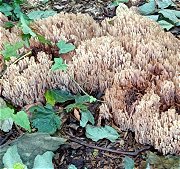

A beautiful early morning so I went to the woods at Hale. But it was still very over grown and most of my usual paths were inaccessible. So I had to be content with powdery mildews until the end of my two hour wander. I decided to look at a new area and within a minute I found lots of Ramaria stricta (Upright Coral), Russulas grisea (Oilslick Brittlegill) and ochroleuca (Ochre Brittlegill) and an Amanita crocea (Orange Grisette). Not a lot but more than I have found recently.
Sunday 18th August 2024
I had time for a couple of hours walk round my favourite fungi spots at Calderstones Park in Liverpool. My first visit this year. How things have changed. My favourite shrubbery is now a jungle with a number of Buddleia amongst the more exotic plantings. My usual path had disappeared and I abandonned trying to find anything. The same comment applied to the various tree plantings in other areas and the grassland had turned into wildflower meadows. Clearly no maintenance is being done by the Council. The wildflowers produced a few mildews. The only higher fungus I found was a single Lepiota castanea (Chestnut Dapperling). Another good site gone to wrack and ruin. I shall wait until the vegetation has died down before I go back.
Sunday 4th August 2024


Out early this morning to Speke Hall in order to take a look round before the dogs and kids arrive. The car park opens early and the surrounding strip of woodland is usually rewarding. This morning I counted 20 Amanita phalloides (Death Cap) with lots of little ones to come. Also a sweet smelling Hebeloma sacchariolens (Sweet Poisonpie). Once the Hall opened I identified a number of rusts and mildews but a few are unidentified because I could not tell what the plant was, many being non native. One Conocybe apala (Milky Conecap) in the orchard but nothing on The North Lawn. It was in the adjoining woodland that I came across Apioperdon pyriforme (Stump Puffball) and a splendid display of Pleurotus pulmonarius (Pale Oyster). One Inocybe (Fibrecap) that I have not yet been able to identify. No surprise there.
Wednesday 24 July 2024

My intention was to look for truffles following the adventures of some of my colleagues on Facebook. I knew of a most promising area at Hale Hall woods. Large mature trees with an extensive open woodland floor. But it was winter when I last visited. To my disappointment, a couple of the mature trees had been downed and the whole area was covered in thick vegetation. Not a squirrel excavation to be seen. The only higher fungus I found was a nice group of Ramaria stricta (Upright Coral). Not truffles though, are they?
Thursday 18th July 2024


It has not been the weather for fungi forays. Pouring rain and when it is not raining I have had other things to do. My collections have been restricted to rusts and mildews on various weeds and flowers at the allotment site. Until today. I have a patch of ornamental grass that has been identified by Liverpool Botanical Society as Phalaris arundinaris var. picta, a variety of Canary Reed Grass. The grass has grown outside my back door since I bought the house decades ago. I noticed that the seed heads were darker than I have seen before. Closer inspection revealed black seeds. I suspected a fungus so put some under the microscope which revealed spores of a smut fungus. With the help of Debbie Evans, co-author of a book about the smuts of Wales, we identified the smut as Tilletia menieri. There are only eight records on the National Database. After an exchange of Emails I have been asked to send it to Kew to be kept in The Fungarium. You just never know what might turn up.
Friday 5th July 2024
A morning walk around some local parks. Not a lot of finds. My difficulty is that Liverpool Council have extended No Mow May to No Mow Anywhere Ever. Most of my favourite spots are overgrown and the paths impassable. I need a machete. Two interesting finds. Crepidotus luteolus (Yellowing Oysterling) on dead nettle stems. Not too hard to identify as most of this Genus grow on wood and nettle is its favioured host. The other was the tiny Marasmius setosus (Beechleaf Parachute) that grows on the petioles of dead Beech leaves. Beech is the dominant tree in this park but identifying a rotten leaf is not easy.
Sunday 16th June 2024



It is so cold and windy. None of the tender veg such as courgettes and borlotti beans are making any progress on my allotment. I decided to go fungi hunting instead. I went to Springwood Crematorium where the trees give a bit of cover from the keen breeze. But nothing much was growing. A single Geastrum striatum (Collared Earthstar) and a group of Geastrum floriforme (Daisy Earthstar) in their ususal spot. Both under Cupressus as were a few Chlorophyllum rhacodes (Shaggy Parasol).
Saturday 1st June 2024

I managed to get out today and joined Liverpool Botanical Society at Hightown on the Sefton Coast. I did not expect much in the way of fungi and I was correct. Only one species, Psathyrella ammophila in the marram grass on the frontal dunes. We did identify some uncommon plants like Clustered Clover and Twiggy Spurge. Also a few Bee Orchids. In the village, numerous plants grew on the sandy grass verges. We met Phil Smith, the local expert, who had identified 130 plant species along the roadside. Not a rust fungus on any of them. I did eventually find Bovista nigrescens (Brown Puffball) on my way back to the station.
Friday 5th April 2024
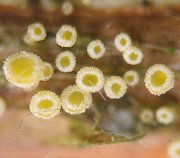
It was a nice day. Heavy gales forecast for the weekend. Time for a walk to test progress of my plantar fasciitis problem. I decided on Freshfield Dune Heath which is easy for me to get to by train. I was disappointed to discover that in the year I have been unable to walk far, the Reserve has been fenced off, leaving only a muddy path through adjoining woods. My favourite bits were inaccessible. The wood had one or two species, one being a Postia. Very difficult to identify except this had sausage type spores so this cuts the field down. My best guess is Postia hibernica. Not often recorded and very little voucher material which probably reflects the identification problem. I shall lodge my specimen at Liverpool Museum. I also found a very nice stalked Ascomycete on a dead herbaceous stem but I have not been able to identify it yet (if I ever do). My foot held up but I am out of condition after a year off.
Sunday 31st March 2024
The weather has been so poor that I have not been able to venture far. Even the golf course is closed. I managed to mow my lawn today. The Entolomas (Pinkgills) had increased in number to about twenty. Usually I only get a couple. They had been joined by a group Psathyrella corrugis (Red Stem Brittlegill). This is a species that grows in association with wood remants, sawdust or buried. It must have beeen growing on the remains of my old, dead Cotoneaster that I had to cut down last year. I cut it into pieces on the lawn. It will be interesting to see if any return.
Wednesday 20th March 2024
No rain today so I went to see if anything was showing at Speke Hall. Surprising that there were not many visitors. Not many fungi either. Nor were there any gilled fungi either. A few crust fungi and a slime mould, Trichia decipiens. One of the crusts caused me a problem. It was on very rotten wood in a pile within a Scot's pine area. Under the microscope it looked a bit tired. I assumed it would be a common Phlebiopsis. I put it in for a spore print that I looked at this morning. The spores clearly identified the specimen as Subulicystidium longisporum. But this grows with beech. Someone had piled wood from other areas of Speke in one heap. Confusing. I wish people were not so tidy.
Tuesday 19th March 2024
I took advantage of a break in the rain for a quick walk to the crematorium grounds. Still nothing of note around except for a large patch of Entoloma sericium (Silky Pinkgill) on the large lawn. I even ventured down to the Eric Hardy Reserve but had to give up when one of my wellies came off in the mud. I am surprised that I am not finding many crust fungi under the damp fallen wood.
Tuesday 20th February 2024

I decided to give a first cut to my tufty lawns before it rains again. To my surprise I had six Entoloma sericium (Silky Pinkgill) growing. Early, but I have found them on my lawn in February before.
Sunday 18th February 2024

It was such a nice afternoon so I paid a visit to Speke Hall. Being the last day of half term it was packed to the gills with children in the various play areas. I retreated to the adjoining Stockton's Wood. I only saw three people. Heaven. Still no gilled fungi in my collection, only crusts and a couple of brackets. The problem I find in local woods, especially maintained parks, is the lack of decent size pieces of fallen wood. This particular wood frequently loses trees in severe gales. But although there are numerous fallen and decaying trunks, there are very few large branches lying around. The size being easy to roll over and more likely to support fungi. Where do they go? My finds included the colourful Peniophora incarnata (Rosy Crust) and Phlebiella sulphurea (Yellow Cobweb), this woodland being the only place I find the latter.
Monday 5th February 2024
Not everything goes to plan. I decided to take a look at a wood I have never visited, Mill Wood, Speke. It is one of the few remnants of ancient forest left in Liverpool. I have been told it is alive with fungi in autumn. It is situated on the edge of a huge Liverpool Council estate. Looking at the path it is obviously popular with the biker boys. Boots on, I set off and then realised it is a wellies job. Undeterred, after twenty yards I was faced with a huge puddle. I tried to go round. My foot got snagged by a bramble. I then fell into the puddle. Fortunately a soft landing in the deep mud. End of visit. 'He stepped in a puddle, right up to his middle and never went there again'
Saturday 3rd February 2024



A nice morning until another gale arrived. Not much around. A couple of poor samples from dead wood that proved easy to identify from the spores. The crust fungus Cylindrobasidium laeve is known as the Teardropper because of the spore shape. The other was a mystery until I managed to spot some very tiny spores in my microscope. They are allantoid or sausage shaped, difficult to see unless you keep changing the focus. It had to be Skeletocutis but because of the condition I had not noticed any pores. I did spot some eventually and was helped by the specimen changing colour to an orangy colour as it dried. My conclusion is Skeletocutis amorpha.There is a Larch plantation at the entrance to this wood although I suspect my rotten piece had been deposited by a dog.
Sunday 14th January 2024

I visited Black Wood in Childwall, Liverpool. It was one of the first woods that I forayed when I began my interest in fungi. It was very good then but in recent years I have found very little on my visits. I did not expect much today and was proved correct. A lot of birch with some beech and oak, there is a lot of dead wood to examine. After over an hour of searching, looking under logs and along branches, all I found of interest was one Scleroderma citrinum (Earthball), two Skeletocutis semipileata and Kretzschmaria deusta (Brittle Cinder). Even Auricularia (Jelly Ear), Stereum (Hairy Curtain Crust) and Trametes (Turkey Tail) were difficult to find.
Monday 1st January 2024

It stopped raining for an hour so I took advantage to take a bit of fresh air after last night. I took a look at a small wood beside Dowsefield Lane, Liverpool. A very damp area hence the name of the lane. The wood is marked on my plan as The Imagined Forest but I have no idea why. I Must ask. For once the boy racers had stayed in bed. But apart from a couple of Crepidotus Mollis (Peeling Oysterling) everything else was a white crust fungus from the underside of dead wood. I identified Botryobasidium aureum which is easy because of the large lemon shaped conidia. Another on broadleaf, had basidiospores of a size that matched Botryobasidium vagum. The other six specimens that I collected all microscoped as Hyphodontia sambuci (Elder Whitewash). Not very interesting. Then it rained.
Monday 25th December 2023
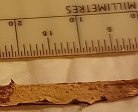


Christmas Day in the morning and it was not raining. I therefore took the opportunity to take a walk in the woods at Hale Village. I did not expect to get too far as there are a couple of ponds that overflow when it rains hard and the paths turn to thick mud. First find was of Mycena inclinata (Clustered Bonnet) on an oak stump, followed by the tiny Crepidotus epibryus (Grass Oysterling) on a sycamore leaf in pile of dead leaves. I found Mycena filopes (Iodine Bonnet) and a couple of common crust fungi. While searching the undergrowth I spotted something on a tiny piece of thin bramble stem. It has taken me until the 30th to work out what it is, with the help of colleagues. It is the crust fungus Aleurodiscus aurantius. My photo shows how small it is. Lucky find. A new personal record so a good end to the year.
Thursday 14 December 2023



At last it has stopped raining. I needed a walk so went to one of my local sites to see if anything had not been drowned. In the woods were a number of fruitings of Flammulina velutipes (Velvet Shank) in very good codition. A couple of common Mycenas (Bonnets). I was surprised to find two Geastrum floriforme (Daisy Earthstar) under Cupressus leylandii. In the same spot as my first find in 2019. Then it started to rain again.
Sunday 26th November 2023

Looking at the weather forecast I decided to have one last visit to Speke Hall to see if any waxcaps had shown their presence on the North Lawn. Disappointingly, all I found were Gliophorus psittacinus. No other grassland species at all. This piece of grassland has always been the best spot in Liverpool for these fungi. Perhaps the heavy rain has defeated them for this year. A look round the woodland delivered the tiny Crepidotus epibryus (Grass Oysterling) on small twigs and a leaf and a group of Infunibulicybe geotropa (Trooping Funnel) but little else.
Monday 20th November 2023


A couple of years ago I dug out the root ball of a bamboo plant that had started to send out runners. It was too heavy to lift so I rolled into a corner of my garden where it has remained, hopefully rotting away. I happened to look at it to see if I could shift it and was surprised to see numerous fungi fruit bodies growing from it. I identified them as Mycena leptocephala (Nitrous Bonnet). Turning it round I saw that it is also growing Psilocybe cyanescens (Blueleg Brownie). I shall leave it where it is for the time being to see if it produces anything else. The Mycena is probably growing from soil that adheres to the ball but the Psilocybe usually grows from rotten wood so bamboo is an unusual host.
Friday 17th November 2023


At last a sunny dry morning. I went Springwood Crematorium which is just down the road. I hoped to find waxcaps but none were there. The Council have been clearing up after the recent storms and placed the fallen wood into piles. Very convenient for me. I identified a few crust fungi such as Phlebia rufa and Postia subcaesia on the dead branches. In the pine plantation was a huge ring of over one hundred Clitocybe nebula (Clouded Agaric) surrounding a fir tree. I also came across Tricoloma ustale (Burnt Knight) well camouflaged under the autumn leaves.
Thursday 9th November 2023
Beautiful sunny morning although a bit too bright when looking for fungi. As I had recorded some waxcaps, including on a neighbour's lawn, I paid a visit to Speke Hall. The North Lawn is usually excellent for waxcaps and other grassland fungi. Today nothing but a few Cystoderma amianthinum and a couple of Clavulinopsis helvola (Yellow Club). I think all the rain is affecting them. The only area of interest was where a fallen pine tree had been cut into pieces. Growing on the wood was Phlebiospis gigantea, a waxy crust fungus. Interestingly this species is used commercially to impede the growth of Heterobasidion annosum (Root Rot) which also grew on these trunk pieces.
Tuesday 7th November 2023

The rain stopped so I paid a visit to a local park, Allerton Towers. Fallen leaves and mud. There is a small piece of lawn that supports waxcaps. It did and there were hundreds of Gliophorus psittacinus (Parrot Waxcap). But nothing else. I did locate four Geastrum striatum (Striate Earthstar) in a small plantation but that was it.
Wednesday 1st November 2023

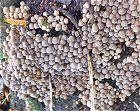
The weather forecast looked dreadful so I took advantage of a bit of sunshine to take a walk to a local park, Clarke Gardens and the adjacent Springwood Crematorium. I toured the parts where fungi usually grow and recorded what I expected to be there. No surprises. Of interest was lots of Gymnopus fuscopurpuresu under a Cupressus as, according to the literature, it does not grow under conifer. Yes it does. A first find of Leotia lubrica (Jellybaby) on this site and my first find of Calycina herbarum on a dead nettle. The rotting Sycamore is still displaying a fine collection of Coprinellus disseminatus (Fairy Inkcap).
Thursday 26th October


I agreed to take a training foray for Merseyside Biobank staff at Speke Hall. I took a look round on Wednesday afternoon and found very little so was not optimistic. Friday morning it was raining which was not promising but by the time we had assembled at 10am the weather perked up. We had permission to go into Speke Hall but I had found a few specimens in the car park so we started there. My group of eight started to find fungi everywhere. I shall have to go to Specsavers. We spent an hour and a half on one hundred yards of woodland surrounding the car park were we recorded over thirty species. We eventually went into Speke Hall and had a look at the main lawn for twenty minutes where more species were recorded that were not growing the previous day. The total was forty-eight identified. Not bad for the distance covered.
Tuesday 17th October 2023
I went to Court Hey Park in Huyton to arrange a training foray for staff of Merseyside Biobank. An old site having belonged to Gladstone's elder brother in the 19thCentury. I had a look round to ascertain the most promising areas. Since I was last there one good area is now an adventure playground and it looks like the local population have run riot everywhere else. I found one Tricholoma. I would suggest another site but there is no guarantee it would be any better. I hope more eyes on the day will produce something. I may have to bring specimens in from elsewhere.
Wednesday 11th October 2023
Met up with my friend Dave Higginson-Tranter who was taking a foray at Speke Hall. Before he started we had a little wander round the woods surrounding the car park and checked on the Amanita phalloides (Death Cap). Only a few this year but still going strong. Nothing new to add to my recent visit. I was going to join him in Speke Hall but it poured down. I made my excuses and left.
Monday 9th October 2023

Visit to my local library hoping for something intelligent to read. Outside is a raised shrubbery with a small Abies alba (Silver Fir). It was surrounded by a host of Inocybes (Fibrecaps). Not easy to identify but having just one species I was able to concenrate on it. I am very confident that it is Inocybe posterula. Goes to show that you can find fungi anywhere.
Sunday 8th October 2023

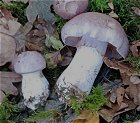

I felt confident enough to join North West Fungus Group at Rixton Clay Pits near Warrington. I lasted longer than I thought I would but gave up eventually. Some interesting finds especially Tricholoma quercetorum, a species that has only recently been reported for the UK. Others that I had not seen before were Cortinarius largus and Paxillus olivellus. My contribution was Tomentella fuscocinerea, a nondescript white fungus that grows on damp soil. Very spiny spores.
Saturday 7th October 2023


Still suffering from my sore heel, I tested it out at Speke Hall at the end of September. After walking round the large North Lawn I had to call it a day. They had cut the grass so all I found were bits of Lycoperdon utriformis. Still easily identifiable. The only other siting of note was Fistulina hepatica (Beefsteak Fungus) near to where my car was parked. I had hoped to go to Ainsdale on the following Saturday and join North West Fungus Group at Wepre on Sunday but my foot was too sore. I gave it a rest until Thursday the 5th October when I tried it out at Calderstones Park and survived. A couple of interesting finds. Phaeoclavulina (Ramaria) curta an uncommon coral fungus under coniferous trees and Singerocybe (Clitocybe) phaeophthalma (Chicken Run Funnel). The Funnel Cap smells disgusting.
Monday 18th September 2023
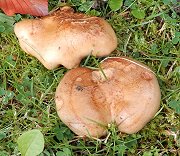
I managed a quick hobble round before it rained. Not much showing at the moment. Agaricus augustus (The Prince) under Yew, Lactarius blennius (Beech Milkcap) and Russula ionochlora (Oilslick Brittlegill) under Beech and a couple of common small species in the grass. My mystery Milkcap is still there. I took another specimen. After taking it apart and using Geoffrey Kibby's key from his Lactarius book, my conclusion is Lactarius pallidus (Pale Milkcap). Although it is not particularly pale it is said to darken with age. Nothing else seems to fit. New one for me.
Wednesday 30th August 2023


Dodging rain showers again. I was able to get out for a quick walk around the gardens at Liverpool Crematorium. Some new arrivals under Beech were Russula nobilis (Beechwood Sickener) and a milk cap I had not seen before. I usually find Lactarius blennius in this area but this turned out to be a close relative, Lactarius fluens (photo). Both have very acrid milk. Under a small stand of Cupressus, I counted six Geastrum striatum (Striate Earthstar) and along the boundary, again Cupressus, I found a small collection of the rare Geastrum floriforme (Daisy Earthstar). This the third year running it has grown in this one small spot. The Cupressus also supported Echinoderma asperum (Freckled Dapperling) and the uncommon Lepiota ochraceofulva, the latter being another that reappears in the same place every year.
Sunday 20th August 2023


I am struggling with plantar fasciitis at the moment but I still managed to hobble to the North West Fungus Group foray at Wigan Flashes. I only lasted until lunchtime but I still managed to make my contribution. Tarzetta catinus (Greater Toothed Club), Mycoacia uda, a few Ascomycetes on dead nettle stems and the star of my effort, Flagelloscypha minutissima. It looks like a common Ascomycete but is one of the tiniest Basidiomycetes. My colleagues made some interetsing finds in my absence. Details will appear in the NWFG website in due course.
Tuesday 8th August 2023

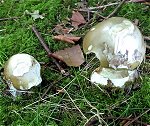
I went to Speke Hall to see if the Amanita phalloides (Death Cap) had returned after the bumper crop of over 50 last year. Since then the National Trust has 'maintained' the area by cutting down the tree saplings. The police have used the area for training woodland searches. There has been a lot of disturbance. The result is that I counted only a dozen. A few Lactarius pyrogalus (Fiery Milkcap) were present. Yes, I stupidly tasted it. A very nice collection of Clitocybe odora, unusually under pine (Aniseed Funnel). Lovely smell. Other finds were of Leotia lubrica (Jelly Babies) and Clavulina rugosa (Wrinkled Club) both in large quantities.
Sunday 6th August 2023

A quick turn round a couple of local parks while the rain stopped. Fungi are starting to appear but not many. All my finds were in one small area of mixed woodland at Springwood Crematorium in Liverpool. A nice fruiting of Agaricus arvensis (Horse Mushroom) in some open grass but the insects had got there first. I was able to compare them with a patch of Agaricus xanthodermus (Yellow Stainer) growing out from the adjoining cemetery, bright chrome yellow when cut and without the pleasant almond smell. A single Lacrarius deliciosus (Saffron Milkcap) and a lone Russula sanguinaria (Bloody Brittlegill) under on of the pines. A nearby stand of beech revealed a mass of Russula nigricans (Blackening Britlegill).
Thursday 27th July 2023

After all the rain, I ventured out again. This time to my favourite local woods at Hale beside Liverpool Airport. There are always large piles of prunings and stumps and woodchip by the entrance. I am not sure that this debris is from the site but it has produced numerous interesting fungi over the years. Today it was a group of Agaricus sylvicola (Wood Mushroom). I cut out a tiny red object from a rotten tree that turned out to be Scutelina crinita. Under the same tree I spotted a couple of yellowish fungi. I assumed they would be Pluteus leoninus but the cap cuticle has round cells not long ones. The choice is between Pluteus romellii (Golden Shield) and chrysophaeus (Yellow Shield). I have not yet worked out which it is. Having regard to the varying descriptions in the literature and the similarity of the microscopics, I may never do so.
Sunday 16th July 2023
A visit to Speke Hall proved more rewarding than expected. Nothing unusual. Amanita rubescens (Blusher), Parasola auricoma (Golden Haired Inkcap) on wood chip and Parasola plicatilis (Pleated Inkcap) on the lawn, I intended to walk through the woods but it was so dull that it was too dark to see anything much.
Sunday 9th July 2023
Saturday's violent thunderstorms encouraged lots of Agrocybe pediades (Common Fieldcap) to sprout on the grass paths round my allotment. I had a walk round the site but nothing else had shown themselves.
Sunday 2nd July 2023
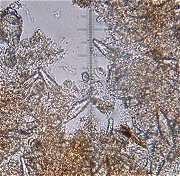
At last, I found a fungus. At my allotment on a grass path, I came across Boletus cisalpinus (Bluefoot Bolete). Easy to identify because the flesh in the cap and stem turn blue when cut. Said to grow with oak but I could not see one. I do know that squirrels bury acorns on my plot so there must be one close by. This find encouraged me to take a look at my local haunts. Apart from a couple of Marasmius rotula (Collared Parachute), I found only a few common crust fungi including Peniophorella pubera. Under a microscope I could see the remnants of the encrusted cystidia. Better than nothing. Hopefully things will pick up soon.
Saturday 20th May 2023

Despite the fact that it has not rained for weeks in the Liverpool area, I decided on a visit to Freshfield Dune Heath at Formby. It was hot, sandy and dry. It did not look promising and so it proved. I did find a couple of Psathyrella candolleana, now Candolleomyces candolleanus (Pale Brittlestem) and some Laccaria tortilis (Twisted Deceiver). Both species were next to each other under the same birch tree. By midday, it was getting hotter so I crossed the golf course to Ainsdale Pinewoods where it was much cooler. I found nothing. By the time I left for home I had spent four hours walking over five miles for two fungi.
Saturday 29th April 2023
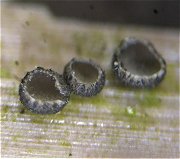

I went out with Liverpool Botanical Society to Dibbinsdale Nature Reserve. A large patch of Ficaria verna subsp. verna (Lesser Celandine) was immediately identified. It was infected by the rust Uromyces dactylidis. I then delved into the dead stems of nettle and hogweed on which I identified a number of species that included Stictis stellata and an uncommon Pyrenopeziza chailletii. The long spores are up to 31 x 3 m. One short piece of nettle produced four different species. Only a couple of gilled fungi, both inkcaps. Strangely there were no Sulphur Tufts, no Glistening Inkcaps, No Jelly Ears nor Birch Polypore, all of which are common elsewhere.
Sunday 2nd April 2023


My front lawn has sprouted numerous Entoloma sericeum (Silky Pinkgill) and some Galerina clavata (Ribbed Bell), Encouraged by these finds, I went to one of my local parks and found the same two fungi. The Entoloma is a regular visitor but the Galerina is said to appear after heavy rain, which we had. I also found Sarcoscypha austriaca (Scarlet Elf Cup). You might think this not unusual but it is the first I have seen in Liverpool this year. My usual sites have disappeared under redevelopment schemes. This is what happens in urban areas.
Saturday 01st April 2023
My green lichenised Ascomycete has progressed. My photos ended up at the Royal Botanical Gardens in Edinburgh where the senior lichenologist identified it as Lecania cyrtella. You expect to find lichens on wood but according to Edinburgh there are several otherwise mainly corticolous lichens that can find their way onto grasses, esp. Bacidina species. They need a keen eye to spot and happenchance of being in the right place at the right time and in decent weather conditions to be able to 'screen' such a habitat. Also, being aware that such a habitat niche can exist!
Monday 27th March 2023

When I find something that I cannot identify, I take photos, note the details, and keep it in a Mystery Folder in case something 'turns up'. In 2017, I visited the green beach at Ainsdale & Birkdale Hills Reserve. The beach is slowly being taken over by land plants and I am interested to see what fungi might appear. In 2017 I found a green Ascomycete on Ammophila (Marram Grass) I could not identify it so into the folder it went. Last week there was an item on the Ascofrance forum about an Ascomycete on marram that looked like mine. It suggested it might be a lichenised species, a Lecania. I informed the NWFG of this progress to discover that another member had found this Ascomycete on marram in Argyll. Still do not know what it is but I am patiently moving forward.
Sunday 26th March 2023
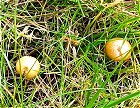
I was due to join a group at Sefton Meadows as it included a lichens expert. But it was cancelled at the last minute. As I had made my sandwiches I decided to wander round my local sites. Surprisingly dry conditions. I found very little and nothing of much interest. When I returned home, I discovered my front lawn had six Agrocybe praecox (Spring Field cap) growing and two more on my rear lawn. Should have just stayed at home.
Saturday 25th February 2023
North West Fungus Group AGM at Risley Moss. After selecting committee members and a talk from our president Geoffrey Kibby, we went for the now traditional walk round the Reserve. Not a lot to find but nice to meet up at the start of the year and compare notes. We ended up with 38 species, brackets such as Fomes fomentarius (Hoof Fungus), different Xylaria species and Sarcoscypha coccinea (Scarlet Elf Cup), a guaranteed find at Risley at this time of year. My contribution was a stemmed Ascomycete, Phaeoheliotium subcarneum found on some very rotten wood. Not many records on the National Database.
Tuesday 21st February 2023
Still no rain so despite the lovely weather, I did not go foraying. I did not expect to find anything. But you can never tell for on my front lawn was a small fungus. Immediately taken for examination. It is an Agrocybe. But a problem. The spores are the correct size for Agrocybe praecox (Spring Fieldcap) but the cystidia are not swollen and match the description for Agrocybe pediades (Common Fieldcap). I can not be certain what it is.
Tuesday 14th February 2023
Now that the weather has warmed up a bit and snowdrops and crocuses are blooming, I took advantage and went for a couple of local walks. The first to Stockton's Wood at Speke, the other to The Eric Hardy Reserve, both in Liverpool. Both woods were very dry, not a puddle in site. Not many fungi in sight either. The few I recorded were either common brackets or resupinates on fallen wood, the exception was two Mycena arcangeliana (Angel Bonnet) hiding under large piece of cut branch. The problem at Stockton's Wood was that there was very little fallen wood of a size I could turn over to examine. It was all large heavy bits of trunk or very long branches. National Trust assure me that they do not tidy it up. Could it be that people take it away for wood burning stoves? The wood is outside the Hall grounds and free to enter. There was a lot of fallen wood in Eric Hardy Reserve but this is a very young wood so not yet very productive. My best find there was Phellinus pomaceus (Cushion Bracket) on one of the many cherry trees.
Saturday 31st December 2022
I did manage to get out for my usual walks on Christmas Eve and Boxing Day. In past years I have done quite well. But this year everywhere was very wet and the few fungi bedraggled and past their best. A few Mycena hiemalis in moss at the base of a tree and a group of Gymnopus fuscopurpureus on bare soil were all I could identify.
All the best for the New Year and Good Hunting.
Thursday 15th December 2022
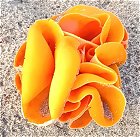





I have not been able to catch up on my forays in November. A busy time on my allotment made more difficult by the persistent rain. I managed the odd hour here and there but some of my usual sites were very disappointing and not worth the visit. I shall report the highlights.
I did get to Rimrose Valley again on the 6th, as assistant to a friend who was taking a public foray. This new woodland and it was wet so 62 species was good. It included an uncommon Hemimycena hirsuta. The best find of Schizophyllum amplum (Poplar Bells) went to a small girl who was very proud when told.
My next sighting was of dozens of Tricholoma scalpturatum (Yellowing Knight) on woodchip at an Aldi car park. Followed by a crowd of Clitocybe amarescens on rotted manure on a allotment. This species is a relative newcomer to the UK from Europe.
My next outing was on the 13th with North West Fungus Group to Ainsdale where the recorded total was 125 species. I was part of a splinter group who searched the dune grassland. Lots of finds but the only one of interest was Neottiella rutilans, a short turf specialist.
The 19th, a beautiful day, found me at Freshfield Dune Heath They have been removing large areas of gorse, leaving large areas of bare sand. These have been colonised by masses of Aleuria aurantia (Orange Peel). Amazing sight. I crossed over to Fisherman's Path for my lunch in the pinewood. Within arms reach of my pine stump seat, I recorded Strobilurus tenacellus (Pinecone Cap), Baeospora myosura (Conifercone Cap) and Auriscalpum vulgare (Earpick Fungi) on buried cones. I have never seen them all together before.
Two late visits to Stockton's Wood and Hale woods were disappointing and a visit to Calderstones Park on the 30th produced nothing until I spotted a swarm of tiny fungi on a dead tree. I thought a slime mould but research came up with Phleogena faginea (Fenugreek Stalkball). So called because of the smell of fenugrfeek or curry. New to me. It is now well below freezing outside so could be the end for this year.
Wednesday 2nd November 2022


It had been raining for a couple of days so I went to Speke Hall before the grass mowers started on the large lawn in front of the Hall. I was not disappointed as there were lots of waxcaps and other grassland fungi, a bit rain bedraggled but unmown. I identified six waxcaps and lots of common grassland fungi. A good find was of Galerina clavata in large numbers. This uncommon large spored species grows after heavy rain on old lawns so qualified on both criteria. A better find was of Gymnopus imudicus in the patch of heather that National Trust has grown in the middle of the lawn. Another pleasing fact was that Ramaria decurren (Ochre Coral) that I first identified in 2017 is still growing under the same ornamental Yew bush.
Monday 31st October 2022
Mereseyside Biobank invited me to take a look at some ancient woodland in an area known as Howard, Pits, adjoining the M57 motorway. It was bit muddy along the path between fields to the wood. Despite some mature oaks, I found not a thing. Perhaps too late. However, the adjoining wood of young birch and willow trees, growing on an abandoned field, produced a number of species but nothing of any note. Very disappointing.
Friday 28th October 2022

I called into Court Hey Park, Roby to meet with my colleague who manages Merseyside Biobank. He usually suggests a site I should look at and report any finds. I had a qick look round while I was there. The only fungi I found was a group of Agaricus altipes under some Rhododendron. An uncommon member of the Agaricus, noticeable by it's height, the stipe being 14cms.
Thursday 27th October 2022

This morning I had a tyre puncture so had to get a new one fitted. My tyre fitter is on the road to Speke Hall. Opposite his garage is a piece of wast ground which is usually fenced off. Until the local people make a hole in the fence because it is the only way to walk from the housing estates to the River Mersey. So I took advantage while I was waiting. In an area of scrub were hundreds of Lepista flaccida (Tawny Funnel Cap), Hebeloma sacchariolens (Sweeet Poison Pie) and a large number of Helvella Lacunosa (Elfin Saddle). Sadly no time to look further.
Wednesday 26th October 2022


I went to Croxteth Hall, Liverpool, a large estate with plenty of old woodland. It was difficult to search because loads of leaves had fallen and the sun was extra bright. In the first half hour, I collected only two species. I went into Mull Wood and the scene changed. Loads of fungi. I recorded forty species. Highlights were Clitocybe geotropa (Trooping Funnelcap), the tiny Mycena capillaris (Beechleaf Fungus) and one Pluteus aurantiorugosus, a bit battered but recognisable. Also Tomentella sublilacina, a crust fungus which I thought would be an Oak Crust. Good job I always check spores on these crusts. Tomentella spores are very spiny. I walked a bit further along the path and had lunch where I added a couple more. Off I went again but in the next one hour I found one Honey Fungus. I gave up and went home.
Saturday 22nd October 2022



I joined Merseyside Naturalists at Lunt Meadows Nature Reserve, my last visit being ten years ago. The Reserve is wetlands and acts as the River Alt flood storage basin, a different ecology from my usual forays. I did not expect a lot of fungi. My first find was of an ink cap that I knew was unusual and I identified it as Coprinellis hiascens. Along the raised river bank we found Lepista saeve (Field Blewit) and Volvariells gloiocephala (Stubble Rosegill). The alder woods were a disappointment. I expected more after ten years. The only Alder fungi I found was a small patch of Naucoria escharioides (Ochre Aldercap). The birding was good. Peregrine, Marsh Harriers and someone disturbed about 500 Pink Footed Geese in a carrot feld. They all went up together. A sight to behold.
Tuesday 18th October 2022
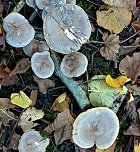

Acting on a tip off from a good friend, I went to Speke Hall.The target was a troop of Amanita phalloides (Death Cap). My friend had counted 86 but I think they had started to get old by the time I got there. I go to Speke Hall quite often being a NT member but I never think of going to this part of the estate. There were also numerous Lactarius pyrogalus (Fiery Milkcap). I tasted one but it was not as hot as I expected. More Laccaria proxima (Scurfy Deceiver) in the car park. It must be the year for this species.
Monday 17th October 2022
Today I led a foray for members of my golf club. At last they are taking an interest in the natural world in which they play. Because of the danger from badly hit golf balls, our foray was limited to the areas by the car park and practice ground. In one hour we managed to find 35 species. Laccaria proxima (Scurfy Deceiver), with its very scurfy cap was more abundant than the smaller Deceiver. Chalciporus piperatus (Peppery Bolete) was found under some birch. Then someone spotted a nice squat Bolet. What is that I was asked. Mine, I replied. I very nice Boletus edulis (Cep) into my bag. I was leader after all. The last collection was Agaricus urinascens (Macro Mushroom) with lots of squamules at the bottom of the stem. I took it home to confirm the identification. Very nice it was too.
Sunday 16th October 2022


I joined Merseyside Naturalists on a foray at Dibbinsdale Nature Reserve, one of my favourite sites. Noticeable was the abundance of Bulgaria inquinans (Black Bulgar) on dead wood. It was everywhere. A good selection of all types of fungi. The star of the day was Pluteus aurantiorugosus. No English name because it is a rarity. Not in the best condition but clearly identifiable.
Friday 14th October 2022


A wander round local parks today. I have seen lots of the Lepiota family recently, especially Echinoderma asperum (Freckled Dapperling). Other notable finds were Pluteus salicinus (Willow Shield) and a couple of Agaricus augustus (The Prince) in their usual site by a pine tree.
Thursday 13th October 2022
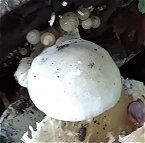
Starting to get busy. A walk up the old lane alongside Allerton priory. I wanted to take a photograph of Clitocybe giganreus that I saw last week. It had totally collapsed. I did find lots of Oudemansiella mucida (Porcelain Fungus) on the fallen beech trees. Not a species I find very often in south Liverpool.
Saturday 8th October 2022



National Fungus Weekend. I joined Liverpool Botanical Society. I collected and identified the fungi for the botanists while my colleague from Liverpool Museum did the same for flowers, trees, lichens and everything else. We surveyed Rimrose Valley Country Park. This is under threat from a new road between the container port and the motorways to take heavy goods. Lots of local objections. It is new woodland much of it being created from a refuse tip. Hardly any microrrhizal fungi, no Amanitas, Russulas. Mycena filopes (Iodine Bonnet) was the only Mycena we found. Hundreds of Inocybe geophylla both white and lilac throughout. Lots of Lyophyllum decastes (Clustered Domecap), some large Lactarius controversus (Blushing Milkcap) and fuliginosus (Sooty Milkcap). Lots of microfungi, some of which were lichenenicolous. I let my Museum colleague identify those as I did not have a clue about them.
Wednesday 5th October 2022
I went for a quick look at a local park, Allerton Tower, to see if local fungal numbers are as good as Sunday at Moore. There is a small area with a Monkey Puzzle tree, Cupressus and Sweet Chestnut which is usually very good and so it was. Twenty-five species in just an hour. Lots of Hygrocybe ceracea (Butter Waxcap), Russula farinipes and praetiversa, Inocybe fuscidula (Darkish Fibrecap), Gymnopus fuscopurpureus and Cortinarius hinnuleus (Earthy Webcap) which smells very strongly of gas.
Sunday 2nd October 2022


North West Fungus group Beginners Foray at Moore Nature Reserve, Warrington. Good weather. Eager novices. Plenty of fungi - mostly standard fare which is what you want for beginners. Lots of Amanita muscaria (Fly Agaric), Paxillus involutus (Brown Rollrim), a good selection of Mycenas (Bonnets), Russula, Lactarius and Boletes including Boletus edulis (Cep) which I managed to snaffle. I took a lot home for microscopic examination. I have to confess I got a couple wrong on the day but I was close enough for a beginners foray. My best was Tomentella pilosa, a cobwebby resupinate under a rotten log. Difficult to get a decent specimen without bits of wood breaking the cover slips. I managed to spot the spiny spores which is the giveaway clue. No photos from reserve as I was too busy passing on my knowledge.
Thursday 29th September 2022


After a morning of allotment digging, I went for a walk to unwind my muscles. Calderstones Park and my favourite shrubbery did not disappoint. My first find in the middle of a nettle patch was of a good number of Collybia cirrhata (Piggybank Shanklet). It grows on mummified fungi but I did not risk being stung to delve further. It has always been a good place for Lepiota species. Lots of expected Lepiota cristata (Stinking Dapperling) and also Echinoderma asperum (Freckled Dapperling) and Echinoderma jacobi although the latter can be confused with other species. I gave up on another collection. Another difficult identification was of Ramaria curta (Ochre Coral) which also has a lookalike and the microscopy is not very clear either.
Sunday 25th September 2022
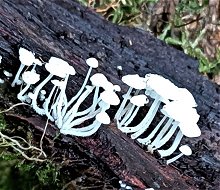

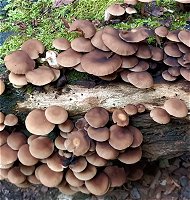
I attended the North West Fungus Group foray at Stanley Bank Woods, St. Helens. I have been before but the foray leader took me to parts I had not been to on past visits. Plenty of fungi about. The beechwood gave us Boletus edulis (Penny Bun), Kuehneromyces mutabilis (Sheathed Woodtuft), Caloboletus radicans (Rooting Bolete) and the usual collection of Mycenas (Bonnets), Inkcaps and brown jobs. At home I spent some time getting to grips with a couple of Xerocomus species and eventually decided on porosporus (Sepia Bolete) and chrysenteron (Red Cracking Bolete). My best contribution was identifying one I had never identified before. A whitish resupinate under a log turned out to be Goiothele lactescens. The final list will appear on the NWFG website when all the results are in.
Saturday 17th September 2022
Today I visited Hightown on the Sefton coast hoping to find something on the dunes. A walk along the Sefton Coastal Path was more like an army survival course. It was very overgrown as the residents tend to take the route along the beach. Most of my finds were of rusts and mildews on very different plants from my local finds at home. Some higher fungi turned up. Agrocybe molesta (Bearded Fieldcao), Psathyrella potteri and a couple of Agaricus campestris (Field Mushroom). I had not been to this area before and had expected some dune grassland but the vegetation was thick throughout. The dunes are all frontal and it had been windy so no sign of any fungi. It was a lovely walk back along the beach watching hundreds of pink foot geese flying north and hearing the curlews across the bay.
Sunday 11th September 2022
I visited one of my pet sites at Hale woods. I have never seen it so dry. The small brook and one of the ornamental ponds had dried up. Usually the area floods and wellingtons are required. After two hours the count was a few Psathyrella microrhiza, one Gymnopus dryophilus and a very nice Pluteus plautus hidden on the underside of a fallen branch. We are promised a week of rain, but there will have to be a lot of it to improve the lack of fungi.
Saturday 10th September 2022

After three nights of thunder storms I went for a walk in the hope that some fungi might have shown up. I tried one of my favourite Liverpool sites but after an hour had only one specimen. But an interesting one. Gymnopus fuscopurpureus. It is probably a alien species. According to the British Checklist, it grows with broadleaf trees. My recent finds have ben under conifer. I sent one from last year to Kew for DNA sequencing. No result yet but Kew believes there are a number of different species. This one will also be dried to await sequencing.
Thursday 1st September 2022


Still no rain in Liverpool. I went for a short walk round Stockton's Wood this morning. Very dry with the leaves crackling under foot. No fungi on the ground at all. I did find a nice Fistulina hepatica (Beefsteak Fungus) and a Laetiporus sulphureus (Chicken of the Woods). But that was all. It might rain at the weekend or so they say.
Friday 5th August 2022


As it had rained for a couple of days, I did the rounds of my local parks. A good start with some nice Agaricus arvensis (Horse Mushroom) and Gymnopilus peronatus (Wood Woollyfoot) at the crematorium, A few common species in the adjoining park including Hyphoderma setigerum on fallen wood. Interstingly this piece of wood also supported the ascomycete, Tapesia fusca which was growing through the corticiod. On a fallen tree I noted a crustlike pink cushion. This was Hypocrea rufa, identified by the ostioles that make it look like a pepperpot. I then went to Speke Hall but did not find anything and it was so full of people that I called it a day.
Wednesday 6th July 2022

I visited Speke Hall before a promised heatwave arrived. Back to pulling dead stems and checking on mildews and rusts. I picked a good selection of leaves and even knew what the plants were. Another collection of Flagelloscypha minutissima, this time on the usual host of broadleaf twigs. In a gloomy part of the woods I turned over a large rotten log and noticed two very tiny specimens, only 5mm, which I collected. When I looked at them under a microscope, I was surprised to see that they are Entolomas (Pinkgills). My literature does not take me further than Entoloma byssisedum or parasticum. A colleague sent my research to Machiel Noordeloos, the expert on this Genus. He is currenty researching these tiny species and that there may be up to fifteen different species. Therefore he could not help me. Nothing more I can do.
Monday 4th July 2022
More rain. Another visit, this time to the woods at Hale. At last a fungus with gills even if it is only Coprinellus micaceus (Glistening Inkcap). Back to dead stems. A lot of tall plants grow along the line of a ditch. One of the picked stems of hogweed (or teasel) was very thick at almost 2cms, and solid like a wooden stick. Back home I dentified Flagelloscypha minutissima, one of the very tiny Basidiomycetes. As it is unusual to find this on a herbaceous stem, I checked some specimens further down the stem. They identified as Lachnella villosa. The hairs are different, one long and pointed, the latter blunt and rounded. I checked my first stem area again and confirmed the Flagelloscypha. It appears that both species can grow on the same substrate. Not something I expected but not uncommon for other species.
Friday 1st July 2022

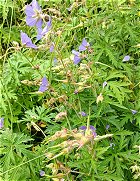
After a few healthy rain showers I went to one of my local parks to see if anything had been encouraged to grow. Nothing. Back to looking at dead stems. I found one Ascomycete I had not seen before despite the books saying it is common, Crocicreas coronatum. Next, I found a patch of tallish blue flowers. I am a vegetable person and it took me most of a day to identify them as Anemone coronaria. The leaves had a rust on them that I identified as Tranzschelia discolor, another new one.
Tuesday 14th June 2022

I went back to Clock Face Country Park for anoter specimen of the rust growing on Carex otrubae (False Fox Sedge Grass). Fortunately I rembered where it was. Having examined it under a microscope I identified it as Puccinia caricina. A common rust fungus but as the host is not, it is of interest.
Saturday 11th June 2022




I joined Liverpool Botanical Society at Clock Face Colliery Country Park near St. Helens. Still very dry but lots of standard Ascomycetes on dead stems and an number of rusts on Field Rose, Hawthorn and Southern Marsh Orchid. One interesting rust was on Carex otrubae (False Fox Sedge Grass) I have not yet identified it as the sedge is not mentioned in any of my literature. I enlisted the help of a rust expert but her advice was not conclusive so I will have to go back for some more. I did find Hygrocybe conica (Blackening Waxcap) only one. Coincidentally, a colleague found one on the same day at a Colliers Moss, another country park a couple of miles away. We both found Bee Orchids.
Friday 3rd June 2022



There is a small field near to home which I believe was formerly a refuse tip. It has been allowed to run wild and I describe it as Tall Ruderal. All plants are at least knee high, nettles, thistle, dock, knapweed, hogweed and large clumps of Deschampsia grass. Very good for dead stems and I visit it a couple of times a year to see what is growing on them. I found ten discomycetes including Brunnipila palearum, Pyrenopeziza chailletti, Belonidium mollisimum, Mollisia clavata and a few spots and pimples, some of which are new to me. Also Lachnella villosa which looks like Lachnum virgineum but is a Basidiomycete. I always check for asci to make sure. It does not have any. I am not sure how long this field will remain as it is because it has been decided to make it The George Harrison Memorial Wood. A pity as there are very few areas like this in south Liverpool.
Saturday 21st May 2022
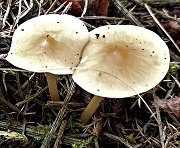


I fancied a day out so caught the train to Freshfield Dune Heath Reserve. It looked as if it had been hit by a bomb. They are removing the gorse and lots of trees. The result is large patches of bare sand in some places. A lot of the most fruitful fungus areas have been destroyed. There were still some fungi about. Gymnopus dryophilus in the moss, Conocybe apala on a bonfire site and Mollisia obscura on a dead heather stem. I then went into the adjoining Ainsdale Sand Dunes Reserve. It was very overgrown and a few of my short cuts had disappeared, including to the area where morels grow. I know that they are trying to take the area back to a dune system but this seemed to have reversed in some places. I did spot Auriscalpium vulgare on a buried pine cone and a few microfungi but disappointing overall.
Friday 20th May 2022
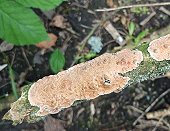
A nice afternoon. I went for a walk round Calderstones Park in Liverpool to see if anything had started fruiting. All I found was a single crust fungus, Cylindrobasidium laeve (Tear Dropper). I need the exercise but had to run when it suddenly started to rain.
Thursday 19th May 2022
A wander around the Eric Hardy Reserve. For once it was completely dry. A bad sign as it is usually very muddy. A nice walk but it was when I climbed to the upper level that I came across a large patch of fungi that I thought were ageing St. Georges Mushrooms. I was wrong. They were Entoloma clypeatum (Shield Pinkgill). But that was all folks.
Sunday 8th May 2022



I hoped that after a couple of days of rain it would be a good idea to visit the Formby dunes to look for fungi. Wrong. After two hours of search I located a few Agrocybe pediades (Common Fieldcap) and two Conocybe apala (Milky Conecap). My day was saved at the very end when I came across a sandy bank full of Tulostoma brumale (Winter Stalkball). Having returned home early, I went to my allotment to find a group of Conocybe rickenii growing on bare soil with my coriander. This species likes nutrient rich soil. When I got home, my wife handed me a couple of Entoloma sericium (Silky Pinkgill) that she saved while mowing the lawn. I may as well have stayed at home.
Saturday 23rd April 2022

I joined the Liverpool Botanists on a visit to Sankey Valley in St. Helens. An area of canals and streams, a wet site. It was "wettish" but this did not persuade many fungi it was time to show themselves. We did find Calocybe gambosa (St. Georges Mushroom) but only one. A lone Inocybe rimosa (Split Fibrecap) an early summer species and a couple of mini Bonnets under a log. A very nice show of Phellinus igniarius (Willow Bracket) one of the hoof fungi on fallen trees. I benefit joining the botanists because they identify the plants for me (I am getting better at it) and I can identify the plant fungi accurately. Interesting rust on the Ramson leaves was Melampsora allii-fragilis which is much less common that the usual Ramson rust. It is one of the rust species that have two hosts, the other being Willow which was everywhere in these woods.
Saturday 9th April 2022
I have not been out much due to the weather. Cold and dry is not the weather that encourage fungi to grow. I visited a couple of local sites last week and found nothing. The only species on Saturday from Speke Hall was the tiny Resupinatus applicatus (Smoked Oysterling) and only a couple. Not much better on Saturday when I went out with Liverpool Botanical Society to Croxteth Hall. The only gilled fungi were both together on a lawn. Panaeolus fimicola (Turf Mottlegill) and Galerina clavata (Ribbed Bell). Let us hope for a bit of wet and warm soon.
Saturday 5th March 2022
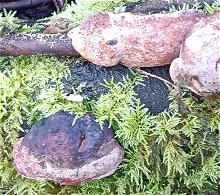

I have managed to go for a few walks in between the rain storms. But all I have found is mud. Until today. I finished up at the local crematorium gardens, It was mostly cordoned off because of all the trees that have blown down. Along one boundary a good 100 yards of mature Cupressus has been demolished like a pack of cards together with five mature broadleaf trees. Quite a mess. There is a cherry tree that died last year but did remain standing. I am interested to see what will grow on it. It was finished off by Armillaria (Honey Fungus). It now supports a large growth of Trametes versicolor (Turkeytail) and some Daldinia concentrica (King Alfreds Cakes) one that I have not seen on a cherry tree before. On another dead cherry I identified Phellinus pomaceus (Cushion Bracket). Lots of Scurfy Twiglets but nothing else.
Thursday 10th February 2022

I visited Stockton's Wood, part of Speke Hall grounds. A strange wood. I have found some rarities over the years but it is very unreliable. For a couple of weeks per year it is marvellous. For the rest of the year, nothing. Today was nothing. A nice walk in the woods on a sunny day. Except for a tiny white specimen on the end of a fallen branch. I thought it was a discomycete, Under the microscope it proved to be a basidiomycete, Flagelloscypha minutissima. This is a species that often grows high up in a tree. Recent gales have felled a lot of mature trees in this wood which may explain my find. It is identified by the shape of the hairs. It is so small, I did not know it was hairy until I looked at it under a microscope.
Sunday 6th February 2022


A walk round a local park. Nothing much to see. A lone Galerina clavata (Ribbed Bell) on the lawn, the second one I have found recently. I collected what looked like a white crust fungus but got no information from it. But I did notice some small black round Ascomycetes on the same piece of wood. These were Chaetosphaeria pulviscula. Meanwhile, back at home, I found a group of Peziza varia (Layered Cup) hiding behind my compost bin.
Friday 28th January 2022

Another nice day so I took advantage to go for a bit of exercise, this time my local golf course. It is being redeveloped and they are dumping rubbish everywhere. Most of my favourite spots are unrecognisable. On to the next site, Allerton Tower, a local park. Nothing until I noticed a promising fallen branch. It was under a holly bush. When I moved it to look underneath I noticed a tiny fungus. Closer examination revealed that it was Marasmius hudsonii (Holly Parachute). This the second time I have found it this month. It is rare but favours the west coast. It is very small and this is not the most promising time to look for fungi. In some moss, I found a single Galerina clavata (Ribbed Bell). This was difficult to identify. It took five attempts before I found the necessary microscopic features. Perhaps affected by the time of year and weather.
Wednesday 26th January 2022
Lovely weather. A trip to my favourite woods at Hale that I had not visited since the gales before Christmas. It is usually very, very muddy but it has not rained for over a week. Paths were good but not much in the way of fungi. Mainly looking under logs and there were fungi to be recorded. Nothing unusual but microscopy was necessary as the crust fungi were white. I identified Brevicellicium olivascens and Postia tephroleuca (Greyling Bracket) from their spores. Only one gilled fungus, a lone Mycena filopes (Iodine Bonnet). Disappointing.
Tuesday 18th January 2022
Nice day. I walked up to Calderstones Park, one of the main parks in Liverpool. I have not visited for a long time because it gets so busy. I was surprised by the number of trees that had been blown down in the gales, one stand of three conifers was totally decimated. My favourite shrubbery had also suffered, looking a bit bare. Liverpool Council were busy making woodchip. My favourite derelict tree, Polylepis australis from South America, had been removed. I was looking forward to see what would grow on it. Not to be disappointed I found Stereum hirsutum (Hairy Curtain Crust) and Byssomerulius corium (Netted Crust) on the adjacent Zanthoxylum (Sichuan Pepper Tree) so not all is lost. Only other species of interest was Sarcomyxa serotina (Olive Oysterling).
Sunday 16th January 2022

Family visits, poor weather and the need to prepare my allotment prevented me from doing much foraying since Christmas. I have managed to get out for a bit of exercise round local parks but even that was difficult as everywhere is so wet and muddy. All the expected species were present such as Flammulina velutipes (Velvet Shank), and Clitocybe nebularis (Clouded Agaric). Species of more interest were all tiny, hidden on small twigs and leaves. Marasmius hudsonii (Holly Parachute) growing from dead leaves has very unique spiky cap and is hard to find due to its size. Mycena capillaris (Beechleaf Bonnet) grows from the leaf petioles of dead leaves. Mycena hiemalis (Winter Bonnet) grows in large numbers on the moss round the base of large trees. Baeospora myosura (Conifercone Cap) was seen on litter from Cedar. There are still fungi about but they take a bit of finding.
Monday 27th December 2021


I needed a post Christmas walk so went to the Eric Hardy Nature Reserve. I kept to the upper section but after the rain it was also a sea of mud and difficult to negotiate. I hoped to find crust fungi but there was not much under the piles of fallen wood. However there were a lot of small basidiomycetes around in the litter. Clitocybe nebularis and Mycena filopes recorded as expected. In the drifts of beech leaves I found Mycena capillaris and Mycena polygramma. Best by far was a holly leaf on which was growing Marasmius hudsonii with its spiky cap. I have only seen this once before, at Dibbinsdale on the Wirral. But it is very small and hard to find under all the dead leaves.
Friday 24th December 2021

Success. A morning visit to Stockton's Wood beside Speke Hall. Lots of old stumps. I found my Xylaria hypoxylon (Candlesnuff). I managed to get a decent photograph. Unfortunately, the good collections of specimens were all under the dead wood so too difficult to get a decent picture. My article is now complete and submitted for publication. I found only one other fungus, a Mycena. In view of the weather, I expected to find more. Very disappointing.
Wednesday 22nd December 2021
I am writing an article about winter fungi for a local organisation. It includes photographs of the selected species. I need a photo of Xylaria hypoxylon (Candlesnff) as I do not have one in my collection. It is so common anyway. Until I went to look for some. I spent two hours in all the places where I was certain they would be growing. I found only one miserable specimen. If it does not rain, I shall try again tomorrow. There were masses of Flammulina velutipes (Velvet Shank) particularly on dead trees in the very wet areas. I did not see much else as it was so cold my eyes kept watering.
Tuesday 14th December 2021
After the storms and continuous rain, this was the first time I had a chance to look round for a couple of weeks. I had a wander through a couple of local parks. More trees down which have been cut up. As long as the Council does not move of burn them that should be source for future fungi. The usual species for this time of year, Clitocytbe nebularis (Clouded Agaric), Lepista sordida (Sordid Blewit), a nice Pleurotus dryinus (Veiled Oyster) growing in a crack on a fallen tree. Best find was of Hemimycena lactea (Milky Bonnet) growing underneath a large Thuja tree which must have protected them from the bad weather.
Wednesday 24th November 2021

Not much recent rainfall so I decided to risk the lower level of The Eric Hardy Nature Reserve. There is a stream that flows through which is prone to flood at the slightest excuse. The paths are usually very muddy, often impassable. But it produces some interesting fungi as there is a lot of dead and fallen wood. I found Inocybe geophylla var. lilacina (Lilac Fibrecap), Mycena rorida (Dripping Bonnet) and the uncommon Entoloma minutum that looks like a very small version of Silky Pinkgill. The damp soil conditions are perfect for this species. Then I crossed the stream which was a grave error as the mud came up to my ankles. Should have worn my wellies.
Monday 22nd November 2021
In my last posting, I reported I had identified the earthtongue Glutinoglossum glutinosum. I was wrong. During the course of further study of some more recent literature, I had another look at my specimen. I have concluded that it is Geoglossum umbratile although the identifying features are not a lot different from glutinosum. Only a couple of points in it. As there are more growing on the lawn, I took a fresh specimen for another look. It turns out to be different. Geoglossum fallax. Much longer spores. There are still a few more left so I may get another species before they are done.
Thursday 18th Novenber 2021
I happened to look at my next door neighbours' front lawn and noticed some fungi. I therefore picked them before they came home. Mycena flavoalba (Ivory Bonnet), although I think it may have changed name to an Atheniella, Clavulinopsis corniculata (Meadow Coral), Galerina vittiformis (Hairy Leg Bell) and a Geoglossum glutinosum (Glutinous Earthtongue). Not bad. I shall wait until they go out tomorrow and sneak into their back garden to see what else is growing.
Monday 15th November 2021

I made an early start to beat the dog walkers to my favourite woods at Hale Hall. The fungi were standard for the time of year, Mycena inclinata (Clustered Bonnet) on fallen oak, a nice Pleurotus dryinus (Veiled Oyster) in a hole on a living tree. Three tiny Mycenas attracted my attention, minute would be a better description. They all had to be taken home to look a them under a microscope. One was Marasmius setosus (a Parachute) growing on a leaf petiole but the other two were on a twig, so different. They turned out to be Mycena tenerrima (Frosted Bonnet). I then spotted a tiny oysterling type fungus when I was examining a fallen tree. It looked like Resupinatus but had brown gills. I took it home thinking it would be a Crepicdotus or a Melanotus. But the spores and cystidia, flexuose with round heads, were wrong. After much research I found Simocybe haustellaris, a new one for me. I had to check the cap cystidia which were the same as for the gills which confirmed the identification. This is why these are my favourite woods.
Wednesday 10th November 2021
No longer any need to book in advance so I went to Speke Hall to look for waxcaps on the large North Lawn in front of the hall. It is a very good site for grassland fungi. There were lots of fruit bodies but unfortunately the lawnmowers got there first and squashed a lot of them. Not a bad list of waxcaps. My finds include virginea (Ivory) irrigatus (Slimy), psittacinus (Parrot), pratensis (Meadow) and insipida (Spangle). I expected to find other species but there were only a few squashed Lycoperdon utriforme (Mosaid Puffball) and hundreds of Clavulinopsis helvola (Yellow Club). Away from the lawn I came across a patch of Tricholoma ustale (Burnt Knight) under a beech tree.
Monday 8th November 2021
Having found a number of interesting species at my local cemetery, which covers a huge area in south Liverpool and was opened in the late 19th century, I decided to take a look at the older Aintree Cemetery, a place I have never been to. It is another huge area in central Liverpool. Very interesting with catacombs and massive funerary statues and stones. Despite the age of some of the areas and the acres of grass, the fungus species count was very disappointing, only sixteen. Most of my finds were under the same pine tree by one of the catacombs. Russula delica (Milk White Brittlegill), Lactarius deterrimus (False Saffron Milkcap) and Mycena flavoalba (Ivory Bonnet).
Saturday 6th November 2021

After over an hour of digging on my allotment, I went for a short walk to unwind my muscles so as not to seize up when I got home. The local golf course is just across the road and I have not been for some time because they are busy with a massive redevelopment of the course and buildings. There are diggers and lorries everywhere. I still found a few fungi. Russula delica (Milk White Brittlegill), Melanoleuca grammopodia (Grooved Cavalier) and two Inocybes (Fibrecaps) that I managed to identify, sindonia (Beige) and cincinnata (Collared). Also Tricholma terreum (Grey Knight) under some pine trees. Sadly, quite a few of my 'good spots' have been ruined where they have dumped soil and rubbish in the woods. A large part of the area has been dug up and covered with mounds of topsoil. I have no access anyway so I will have to strike this site off my list for the time being.
Wednesday 3rd November 2021



I took a friend with me to one of my better sites at The Crematorium Garden of Remembrance. He is a photographer. I was not sure if we would find much as it had poured with rain for over 24 hours and places were flooded. It turned out to be a good day as the Council had been unable to mow the lawns and the fungi enjoyed the respite. A lot more fruitbodies than when I went the week before. Additions to that list include Tricholoma scalpturatum (Yellowing Knight), Gymnopus brassicolens (Cabbage Parachute) and Helvella elastica (Elastic Saddle). I also have a mystery, a yellow Entoloma of which there are very few. There is one that seems to fit the physical and microscopic features but is said to be easily identified because it smells strongly like pear drops. I can not smell anything on mine. I shall have to ask my mycological family for assistance on this one.
Monday 1st November 2021
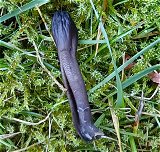

A break in the rain. I decided to take a quick visit to the 13th century All Saints Church in Liverpool. The mossy graves and grass surrounding the church are always maintained and a good spot for waxcaps and other small grass lovers. A bit disappointing as the only waxcaps were virgineus, ceracea and reidii, all fairly common. A few Golden Spindles and Geoglossum fallax and that was it. Then it rained again.
Monday 25th October 2021



I paid a short early morning visit to Calderstones Park as it gets too busy later especially as it is half term. I only had time to visit my favourite ornamental shrubbery and was not disappointed. First find were two excellent Echinoderma aspera (Freckled Dapperling). Then a mass of Ramaria curta, one of the lesser known Coral fungi. Thus was followed by Pluteus nanus (Dwarf Shield) and, new to me, Cystolepiota bucknallii (Lilac Dapperling). The only thing lilac on my specimens were the stems. The giveaway is a very, very strong smell of coal gas. Then I found a very dry orange resupinate fungus on a dead tree. I identified it on the spot as a Peniophora. But when I checked it at home, having kept it in a damp box, it had a wrinkled skin and the spores were wrong. After much research, I identified it as Hymenochaete cinnamomea, which is not a common species.
Friday 22nd October 2021



I have been taking people out on forays and finding difficult species so I am now having to catch up on my reporting. A visit to Springwood Crematorium after heavy rain produced twenty specimens that included Lepiota ochraceofulva, Gymnopus fuscopurpureus, Russula nobilis (Beechwood Sickener) and Cortinarius talus (Honey Webcap). Yes, it did smell of honey. Then I made the error of crossing the road into Allerton Cemetery. Just for a look round the older parts. Another twenty to add my box. Lots of fruitbodies but as this is a huge area there is a lot of walking involved. Mainly grassland species but I found a nice group of Tricholoma sulphureum under some trees. Someone reported to Merseyside Biobank of finding eight different waxcaps on the site. I only found one but must go back if time allows.
Tuesday 19th October 2021


Returning from my allotment along the grass path to the exit I came across a number of small Bonnet fungi. Brown edged gills told me they are Mycena olivaceomarginata (Brownedge Bonnet). They have been growing regularly in the same small patch but nowhere else on the paths since 2009. Another regular is Tubaria dispersa (Hawthorn Twiglet), except mine flourish under a Cotoneaster that grows over the boundary fence from the neighbouring garden and have been doing so since 2002. Only five today. They grow from buried berries. They clearly like red.
Monday 18th October 2021

This morning I went to my local waste disposal centre to get rid of some broken electrical items. The centre is opposite Otterspool Promenade, an area of grassland and shrubberies that extends for about two and a half miles along the River Mersey. Although fairly new, a lot of fungi grow in the grass and in wood chips around the trees and bushes. As it had stopped raining, I took a short stroll and noted a number of fungi, mainly Agrocybe praecox (Spring Fieldcap) along the grass verges. One in a shrubbery caught my eye and when I picked it up, it immediately bruised bright red, although by the time I got it home it had turned almost black. It is Leucoagaricus badhamii (Blushing Dapperling). Must return as soon as possible to see what else has grown.
Sunday 10th October 2021

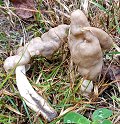

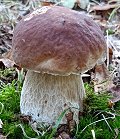
Foray number two, this time with North West Fungus Group at Ainsdale Sand Dunes Reserve. There were lots of fungi and lots of forayers. Although we did not travel far from our starting point a growing and interesting collection was made. From round the small lake we found Hypholoma mysotis (Olive Brownie) which has a very long stem, Cortinarius uliginosus (Marsh Webcap). Along the path were lots of Lyophyllum connatum (White Domecap). In the oak wood was a variety of species including Helvella elastica (Elastic Saddle) and Boletus edulis (Cep). Most exciting was the rediscovery of the very rare Stereopsis reidii still in the same place as two years ago.
Saturday 9th October 2021




First foray of a busy weekend. I joined the Liverpool Botanists at Dibbinsdale. Not a large quantity of fungi about. Some of the favourite spots were bare of any of the usual specimens. Part of the problem is that more people are using the woodland so a lot of disturbance. Nevertheless by working hard we found quite a few and it ended as a successful day out. Our finds included Leotia lubrica (Jelly Babies), Kuehneromyces mutablis (Sheather Woodtuft), Cortiarius albobiolaceus (Pearly Webcap) and Scleroderma verrucosum (Scaly Earthball).
Thursday 7th October 2021
Some friends wanted some sloes to make sloe gin. Knowing of a thicket of blackthorn, I went to see if there was any fruit. There was. Sloe gin is now under production. I had a look round for fungi and managed to find Lactarius blennius (Beech Milkcap), a couple of Gymnopus confluens (Clustered Toughshank) and Gymnopilus sapineus (Scaly Rustgill). The last one is difficult to identify as it is separated from more common species by the size of the hyphae in the cap. A microscope is essential.
Wednesday 6th October 2021
I visited some friends and afterwards popped into the nearby small Black Wood before I went home. It was very dry despite the recent rain. A couple of common Mycenas (Bonnets). The only find of interest was of Heterobasidion annosum (Root Rot) growing on fallen birch. Usually a coniferous species, I have found it on birch on a few other sites. I do not know of any conifers in this wood.
Tuesday 5th October 2021

Back to normal. Back to the allotment. Some fellow allotmenteers directed me to their site which has wood chip paths. The paths were covered with Parasola conopilea (Conical Brittlestem). It looks like other brown species but this one has hairs in the cap that can be seen with a decent hand lens. Tiny whiskers. Also on the paths were Marasmius oreades (Fairy Ring Champignon) and Lacrymaria lacrymabunda (Weeping Widow), the latter growing out of a gravel path.
Sunday 3rd October 2021
I went to Scotland for a week to play on the steam trains running to Mallaig and Oban. It was a little damp but it was the first rain they had seen for weeks. I looked for fungi on my walks but nothing to be seen. Until we went to Mull and visited Duart Castle which sits on a rocky outcrop over the sea. One lonely pine tree stood beside the castle walls. It was surrounded by fungi. Cupophyllus virgineus (Snowy Waxcap) and Hygrocybe ceracea (Butter Waxcap), an Entoloma (Pinkgill) some Panaeolus (Mottlegill) and a couple of Lactarius (Milkcaps) with orange gills. I suspect deterrimus (False Saffron Milkcap) because of the green tints in the caps but the gills were too dry to extract any milk to be able to confirm.
Wednesday 22nd September 2021


Still no rain to speak of. I took a quick walk on my local golf course. An old bridleway runs along one side. To stop scrambler and quad bikes trespassing on the course, the club has built a barrier by piling soil on top of fallen trees and branches. A good spot for fungi. Today there was a circle of huge Leucopaxillus giganteus (Giant Funnel), the second local site this month. Beside them were dozens of a small whitish fungus. I thought they would be Lepiota cristata but when I picked one my finger was powdered white. Cystolepiota seminuda (Bearded Dapperling). Stinking Lepiota was also there. Much larger than I have seen before. My only other find was one tiny Rickenella fibula (Orange Mosscap) growing on my lawn.
Thursday 16th September 2021
After recent rain I thought it would be a good time to have a wander around some of my usual sites. Everybody is posting photographs of finds on Facebook. I wandered far and wide, turned over every log, poked about in the nettles and brambles. My reward was zilch. I did not find one specimen of anything. Still very dry but I thought something would turn up.
Saturday 4th September 2021
I joined Liverpool Botanical Society on a visit to North Wirral Coastal Park starting at Leasowe Lighthouse. It is dune heathland. It was very dry. I found only one gilled fungus all day, a small group of dried up Marasmius oreades (Fairy Ring Campignon). I did return home with a reasonable collection of rusts and mildews. Perfect weather for them. The reason why I join the botanists is that I have no idea what most of the plants are. So, they identify and record the plants and I can then find the relevant fungus in my books. The botanists are also interested in my records as these parasites affect the plants. Everyone is happy.
Wednesday 1st September

I went out to look for elderberries for wine. My usual path was blocked by a fallen tree. They were not ready anyway. I wandered down to the stream, now dry, in the Eric Hardy Reserve. Lots of soggy wood and lots of Polylyporus squamosus (Dryads Saddle). I was surprised to find two Oudmansiella mucida (Porcelain Fungus) not often seen in this area. Then I met a man and his dog who I bump into from time to time. He gives me information about any fungi he sees. This time it was about a group of large specimens in a blackthorn thicket in another park. Off I went on my mission and found them immediately. A large group of Leucopaxillus giganteus (Giant Funnel). I managed to get the photograph but it was quite a thorny fight to get near. This group appeared in this same spot in 2018 so nice to know they have returned.
Sunday 29th August 2021


A visit to Halewood Triangle Country Park. Until the 1970s it was a major railway complex serving Liverpool Docks. Despite its youth, it produces interesting fungi. My collection included Lactarius pubescens (Bearded Milkcap), Hymenopelis radicata (Rooted Toughshank), Russula velenovskyi (Coral Brittlegill), Laccaria tortilis (Twisted Deceiver) and an uncommon Inocybe calospora (a Fibrecap). This last one was easy to identify because if its unusual spores. A pity all the other Fibrecaps are so difficult to identify. I still have two left to do without any confidence I will succeed.
Thursday 26th August 2021



An early morning visit to woods at Hale to beat the crowds. Quite a decent collection. Some Hygrophoropsis aurantiaca (False Chanterelle) growing on wood chips together with Agaricus xanthodermus (Yellow Stainer). Three Calvatia gigantia (Giant Puffball) just starting to grow in the nettle bed. Also a very young Fistulina hepatica (Beefsteak Fungus) on an old oak stump. Lots of Russula amoenolens (Camembert Brittlegill). A lot of minute Inocybe geophylla (White Fibrecap) and the smallest Entoloma (Wood Pinkgill) I have ever seen at only 2 centimetres. Find of the day was another tiny 2 centimetre species that I could not identify in the field. The pink spore print next day suggested Pluteus. I tracked it down to Pluteus podospileus, a species more of southern England than the north west.
Tuesday 24th August 2021
I had to take my car to a local garage for service. It is just over a mile from home so I walked there and back. My route is along a dual carriage way which, like many in this area, has a wide central reservation and grass verges lined with mature trees. They support a good selection of fungi. Early days but I recorded Parasola plicatilis (Pleated Inkcap), Agaricus xanthodermus (Yellow Stainer), Agaricus sylvicola (Wood Mushroom) and Laetiporus sulphureues (Chicken of the Woods). This was growing on the cut stump of an old ornamental cherry tree, not the usual host for this species.
Sunday 15th August 2021


I attended my first North West Fungus Group foray since the pandemic began. Nice to talk to people I have not seen for so long. Not an easy foray as fungi were not abundant and the site has become very overgrown. We still managed a collection of forty odd. Not bad as a lot of the searchers were beginners, this being the purpose of the foray. A good number of common species, always welcome on a beginner's foray. A few unusual species, Mycena corynephora, a small white Bonnet fungus growing on a mossy trunk. The best being a group of Melanophyllum haematospermum (Redspored Dapperling). With its red gills and stem, this was exciting to many of the experienced members who had not previously seen one. With luck we may have attracted some new members to the Group.
Tuesday 10th August 2021

I was invited to a local wood to see a fungus found by a dog walker who is also an enthusiastic fungus finder. Until the pandemic he was proprietor of a very good restaurant. He knows his edibles. The fungus he showed me was Hericium erinaceus (Lions Mane). It was well hidden. On hands and knees to see it at all. Normally a species in the south and south west of England, only two known records on the National Database for this far north. One I visited when it grew at Erddig in north Wales. It is edible, popular in Chinese cuisine. I tried it when on holiday in Hong Kong but was not impressed.
Thursday 5th August 2021

I went for a wander to see if the recent rain had encouraged the fungi to appear. Still not much progress. One Boletus luridiformis (Scarletina Bolete) under some beech trees was all I saw although there was a broken Russula that I could not identify from the bits, The large group of Phallus impudicus (Stinkhorn) 'eggs' has increased in number. I also noticed a couple of open Geastrum floriforme (Daisy Earthstar) in the area they grew last year. They looked old so could be leftover from 2020 but I did not see them when I looked for them on a recent walk in that area. A few Ascomycetes on nettle stems and that was all I found.
Friday 16th July 2021
A wander around the Speke Hall area this morning before it got too hot. I could not get into the Hall because you have to prebook. But I know of a hole in a fence which leads to a path through a narrow stretch of mixed woodland on the boundary. The locals use it as it is the only route to the river from the residential areas as the way is blocked by the airport, the Hall and many industrial complexes. The boundary ditch was dry but enough to support Psathyrella candolleana (Pale Brittlestem), Laccaria laccata (Deceiver) and a couple of slime moulds. Agrocybe pediades (Common Fieldcap) grew on the pathside grass and the dead nettle stems produced a couple of Ascomycetes. Enough to be interesting.
Wednesday 7th July 2021

Another morning of picking on my allotment, followed by a walk in one of the local parks. Things are picking up. A couple of Pluteus cervinus (Deer Shield), Psathyrella candolleana (Pale Brittlestem) and a couple of 'eggs' of Phallus impudicus (Stinkhorn). It was difficult to find anything because a lot of the park is swamped by Himalayan Balsam. The Council do not seem to be taking any steps to control it.
Tuesday 6th July 2021
After a busy day on my allotment picking redcurrants, blackcurrants, loganberries, broad beans and digging up some potatoes, I needed a walk to straighten my back up. I popped across the road to my local golf course to see if the rain had produced anything. It had. Russula ionochlora (Oilslick Brittlegill) under beech, Lepiota cristata (Stinking Lepiota), lots of Panaeolina foenisecii (Brown Mottlegill) clearly excited by the rain. One that attracted my attention was a pinkish Russula with ochre gills that I did not recognise, After further research at home I concluded that it is Russula puellaris (Yellowing Britlegill) so called because the flesh turns yellow when handled. I have not seen this one before. Must look out for it.
Friday 2nd July 2021


Bored with my local area, I had a day trip to Formby, more in hope than expectation. I was right. Freshfield Dune Heath was very dry but I did record a lone Amanita fulva (Tawny Grisette) and a couple Amanita rubescens (Blusher). I continued my walk along Fisherman's Path into Ainsdale. Again it was dry and very overgrown. The only fungus I found in two hours was Microbotryum violaceum, a smut that affects the flower anthers of Silene dioica (Red Campion). I got very excited about some large purple spots on a Sonchus oleraceus (Smooth Sow Thistle) but they are galls produced by a midge, Cystophors sonchi. Unfortunately, I did not have any binoculars with me because I think there was a pair of ravens sitting on a dead tree at a quiet stretch of the coast. If not, they were very large chicks. I must check with the Site Manager.
Sunday 20th June 2021

I watched Royal Ascot on TV and the heavens opened. It poured. All we got in Liverpool was a teaspoonful. In the hope that something might be persuaded to grow, I took a walk round a couple of local woods. All I found were lots of large Polyporus squamosus (Dryad's Saddle). I had not been to these woods for over a month. Where I expected to find fallen trees and branches it was completely overgrown with bramble. Impossible to penetrate.
Saturday 12th June 2021

Elderflower picking today. I make wine with them. Also superb dipped in batter and deep fried then sprinkled with icing sugar. Lots of Polyporus squamosus in my local nature reserve. The species seems to thrive in the current dry weather. Unfortunately the weather is perfect for rusts and mildews.. My pear tree has acquired Gymnosprangium sabinae (Pear Rust) and my apple trees have both been attacked by Podosphaeria leucotricha (Powdery Mildew). Happy Days.
Monday 7th June 2021

The kids have gone back to school so I went for a walk in my local park. It was hot and dry and slow going. Not much to see. An old Polyporus squamosus (Dryad,s Saddle) on a dead tree and the Myxomycete Ceratiomyxa fruticulosa. I doubt I will find anything until we get a bit of rain. Emptying my garage seems a good plan for this week.
Thursday 3rd June 2021
A spot of rain this morning. And I mean spot after three days of very hot. I was surprised to find eight Agrocybe praecox (Spring Brittlestem) growing on a grass path adjoining a vegetable allotment. If the weather stays cool I shall consider going for a wander.
Thursday 20th May 2021
I visited a small wood only five minutes drive from home. It has been closed for a year for safety reasons. Someone went for a walk during a severe gale. Unfortunately and tragically a tree fell on him. Usually overused it looks beautiful at the moment. I found one gilled fungus, Mycena galericulata (Common Bonnet). The rest were dead wood species. Interestingly, I identified three species of Botryobasidium, aureum, conspersum and subcoronatum. They all look the same, white and cottony but the spores and microscopics differ. Usually when you find one, all other finds are the same so this is unusual to me. All other finds were standard stuff.
Friday 14th May 2020
I joined a friend on my first post vaccination foray. We decided on Ainsdale Nature Reserve to look for morels. The weather was beautiful. Unfortunately after all the rain this month, the water table was very high and the usual route was impassable due to flooding. Alternative cross country attempts to by-pass the floods were also thwarted by water. So we gave up the attempt and followed our usual foray route. Not much around, as one would expect, although I had hoped the dune grassland would have produced something. Most finds were on dead wood. We did find two species not recorded by us previously. Thanetophorus fusisporus, a non-descript crust fungus and a Hyphomycete, Brachysporium masonii. This was identified from rogue spores that were found on a crust fungus. We could not identify the crust fungus even though it was bright yellow.
Tuesday 11th May 2021
As it has been raining a lot I thought now would be a good time to see if anything had started to grow. I chose the wood adjoining Speke Hall. Unfortunately, I failed to spot the menacing black cloud that loomed over me. It then thundered and lightninged and poured down. I got soaked. I did mange to retrieve a couple of specimens. One was Schizopora paradoxa (Split Poregill), one of the most common fungi in any wood. The other was Mollisia cinerea (Common Grey Disco), probably the most common disco in any wood. Not one of my successful forays.
Wednesday 28th April 2021

I went for a walk as part of my exercise regime so did not expect to find anything even though it poured with rain last night. Everything was still very dry. To my surprise, I came across two Coprinopsis atramentaria (Common Inkcap). Life at last.
Friday 23rd April 2021
I went for a walk round my local parks. It is so dry that even the bracket fungi have completely dried out. Nothing under the few logs I turned over except woodlice. I do not expect anything until it rains so It is exercise only until that happens. But there is nothing in the forecast. It is very difficult doing anything on the allotment as it is too dry to sow seeds but too cold in the mornings to plant things like peas and beans. Everything is on hold.
Sunday 11th April 2021
A nice but cold morning so I decided to go for a walk. Back to the same route like everyone else. Still very dry as well as cold. A morning of looking under dead wood although not much of that left as the local children seem to have collected it to make hides. Just like I did when I was young. I found a few crust fungi but nothing new for the sites I visited. I had to miss out on going to Ainsdale last weekend but the Manager informs me that there is much flooding and I would not have been able to follow my usual route. It was the same as when I went last year.
Thursday 8th April 2021
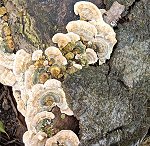
A chilly morning so I decided to make another attempt at Hale woods, before everyone realised it was going to be a nice day. It was so quiet until the sun came out but by then I had completed my round. Still very dry and not many gilled fungi. A couple of Melanotus horizontalis (Wood Oysterling) under a log. I found a nice group of Trametes ochracea (Ochre Bracket) and a good selection of crust fungi that I managed to identify at home. The tiny uncommon disco Mollisia subglobosa was where I found it last year. One that has me fooled is a tiny hairy basidiomycete disc. It has the spores and basidia for Episphaeria fraxinicola. It was on a fallen ash tree. But the hairs are wrong with no encrustations. Is there another cyphelloid fungus I do not know about?
Thursday 1st April 2021


Freedom (nearly) at last. I went to Hale to visit my favourite woods. It has been off limits, the Police stopping non residents and issuing fines. But when I got there it was crammed full of kids and dogs. So I turned tail and went to Speke Hall. It shuts on Mondays but the good folk of Liverpool have knocked a hole in the fence of an adjoining wasteland that leads to a path down to the Liverpool Sailing Club. This path is through an avenue of Pinus sylvestris which are in poor state. Lots of dead wood. Still very dry so not much to collect. I did extract a white smear from a dead pine branch more in hope than expectation. It gave me a spore print which was very like Elder whitewash so I thought I must have got the wood wrong. But under the microscope I could not find any clamps or crystals on the cystidia. I did see lots of 'spiders'. Nothing in Fungi Europaei matched. I started on B&K and there it was - Stypella vermiformis. The spiders are basidia. Not one I have recorded before. There is a good illustration at asturnatura.com. As someone recently on Email, it is a victory when you identify one of these.
Monday 29th March 2021
Lockdown over so I went to Hale Woods which have been off limits for a while. Silly me. Warm day. Kids off school. It was packed. So I made for Speke Hall which is closed on Mondays. But I know a hole in the fence which the good people of Liverpool have created that leads to a path from the Speke Hall entrance through a narrow strip of pine trees to the river Mersey and the Speke Coastal Reserve. It still has gun emplacements and machine gun posts built to protect the airport during the war. Still very dry so only a few crust fungi under branches collected. Nice quiet walk.
Thursday 25th March 2021
A bit more rain this morning. I needed my daily exercise. I went for a walk to the usual park. One thing about fungi is that every time you visit the same place there is always the chance that something new has arrived on the same tree you look at every time you go. No agarics but some different crust fungi. My finds included Scopuloides rimosa, Sistotrema brinkmanii and Peniophorella praetermissa. Long names but all very common species.
Monday 22nd March 2021




Very little to report recently as the weather has been cold and dry, a bit eyewatering when trying to search for small Ascomycetes. I did not find any. A few crust fungi but not many and nothing unusual. I did not really need my microscope to identify them but one should always check. You just never know. But today, Spring may have sprung. On my lawn, a couple of Entoloma sericeum (Silky Pinkgill), a common resident. So I had a look at the lawns at the Crematorium and found Entoloma conferendum (Star Pinkgill). They look pretty much the same, brown. It is the spores that differ so they always need checking.
Wednesday 3rd March 2021
I have managed a few local visits to the golf course and parks but since the freeze it has been cold and dry. Nothing seems to want to grow except a few crusts and the odd bracket. Today I went to Stockton's Wood beside Speke Hall. You have to book and entry time for the Hall but not for this wood. Being National Trust they lock the gates on Monday and Tuesday so today was the day. Still very little under the logs and branches. Seven crusts and a slime mould. Annoyingly, people keep sending me photos of Scarlet Elf Cups from all over Lancashire. I have not yet seen any, not even in the usual places.
Wednesday 17th February 2021
I went for a post arctic freeze walk and ended up in Allerton Cemetery. A huge site of 56 acres going back to 1900. I have found fungi there but only at one corner when I take a short cut to home after taking my car for service. Looking round the oldest parts near the chapel, there are some promising areas that should be worth a look later in the year. Lots of tight grass and moss that should suit waxcaps. I ended my walk back at the Crematorium to check on the Geastrum floriforme (Daisy Earthstar). Still there but all closed up. Difficult to see because they now look just like Cupressus leylandii cones. I had to look hard to spot them in the litter.
Thursday 4th February 2021
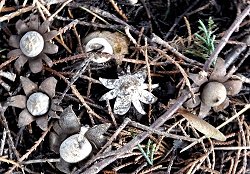
Another visit to Liverpool Crematorium, one of the few places that is not covered in mud after all the rain. I only went for a walk before the next storm blew in. Not much fungi around. Probably drowned. The site has a long boundary of Cupressus leylandii which is always worth a look. I was looking for Geastrum striatum which regularly appears there. Part of the boundary is not easily accessible. I persevered through the brambles and I came across a patch of small white stars that I took for petals from paper flowers that are left on the memorials. When I looked closer, I saw that they were overturned Geastrum floriforme (Daisy Earthstar). I counted twenty of this rare species. This is the third time I have recorded it in the last eighteen months at three different sites
Monday 25th January 2020
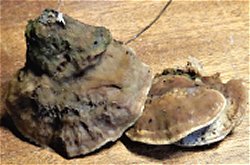
The snow started to melt as the sun came out so I went for my exercise to the local golf course. Still no golf so allowed to wander. I came across some large stacks of cut trunks from various trees. Lots of bracket and crust fungi so I took a selection home. Scopuloides rimosa was easy due to the tine sausage spores. The brackets were tricky. I thought my samples were all the same until I put them under the microscope. The pores are different. One is Daedala quercina (Oak Mazegill). This surprised me because I do not know of any oaks on the course. I have never seen an acorn. First for the site. As is the other, Bjerkandera fumosa (Big Smoky Bracket). This is not a common species. Not bad for a couple of hours in the snow.
Friday 22nd January 2021


I am writing an article and needed to check that I had correctly identified the tree where I found the subject fungus. So I went to Calderstones Park, Liverpool. The lake had overflowed. The area was a marsh. I managed to get to where I wanted. Tree identified. I also checked on my small site of Geastrum striatum and counted sixteen, twice as many as last year. I could get no further so gave up. In the afternoon I went to a wood beside Speke Hall. Decent paths but the ditches had overflowed so most of it looked like the Everglades.I managed to collect a few crust fungi which are awaiting spore prints. Interesting finds so far of Creidotus epibryus (Grass Oysterling) on a beech leaf and Volutella ciliata on a dead Ivy stem.
Sunday 17th January 2020


As it was a nice morning in that it had ceased raining, I went for my daily exercise. I had hoped it would be quiet in the morning but I was wrong. The usual funny looks as I turned over large branches and logs so gave it up. I shall just have to go out in the rain in future. I did find Stereum rugosum (Bleeding Broadleaf Crust), the Asomycete Hyaloscypha hyalina and a Myxomycete Didymium squamulosum. Most interesting were some tiny white spots on a leaf which usually amount to nothing but in this case they have basidia. So I am keeping the leaf moist to see what might grow. My guess is a Mycena (Bonnet).
Thursday 14th January 2021

I managed a couple of hours on Tuesday. A few Mycenas made an appearance. Mycena vitilis (Snapping Bonnet), one I do not find in Liverpool very often. Mycena speirea (Bark Bonnet) was found under a log. The crust fungi have taken a couple of days to get spore prints. The results are Phlebia radiata (Wrinkled Crust), Brevicellium olivascens, Peniophora limitata and Phlebiella vaga (Yellow Cobweb). The last one is usually bright yellow but does turn white with age. My specimen had small yellowish traces but the spores and hyphae matched and I could not find anything else that did. Since Tuesday we have had incessant rain which has now frozen. I had slippery mud problems on Tuesday and could not access some of my favourite spots. It will be impossible now.
Thursday 7th January 2021
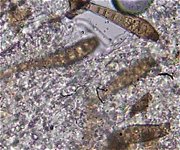
A frosty morning but then the sun came out. So I took advantage and went to the local golf course as they are not permitted to play. Lots of dead and fallen wood about but not much growing on it. I found a single Psathyrella microrrhiza. (Rootlet Brittlestem). All of the crust fungi were Xylodon sambuci (Elder Whitewash) which is not unusual. When looking at the Xylodon under my microscope I found some different spores that I tracked down to the microfungus, Helminthosporium velutinum. A large Tremella mesenterica (Yellow Brain Fungus) and that was all that I found.
Thursday 31st December 2020


My last foray of the year. I did go out yesterday but it snowed after twenty minutes so I gave it up. Better weather today. The golf course was closed for golf so I was able to wander to places not usually accessible. Plenty of fallen wood from which I recorded Datronia mollis (Common Mazegill) and the Corticioids, Radulomyces confluens and Scopuloides rimosa. Species to be expected now that winter is here. My most interesting find was of a decent sized Basidiomycete under a Cupressus. Under the microscope it proved to be an Inocybe (Fibre Cap) which was a surprise. After further study my conclusion is Inocybe praetiversa. Then it started to snow again. Happy New Year.
Monday 28th Decermber 2020
A smattering of snow but the sun came out so I took my permitted exercise at my local park. Unfortunately everybody else had the same idea so children and dogs everywhere. Moving off the paved paths just ended up in mud so getting about became difficult. I did see Lepista nuda (Wood Blewit) and Paralepista flaccida (Tawny Funnel) in the shrubberies. I managed to collect a Peziza micropus from a fallen beech tree which is new to that site. But the mud and cold and trying to keep a social distance from people persuaded me it was time to go. So I did.
Saturday 26th December 2020


I took advantage of a lull in the weather to get out before forecasted storms arrive. Some interesting finds. A single Geastrum striatum (Striate Earthstar) under the same stand of Cupressus that I found the rare Geastrum floriforme. What is it about this small area that attracts these unusual earthstars. This is always the first place I look at when I visit this site. I have never seen striatum there before. I also had a look at The Eric Hardy Reserve which was not as muddy as I had feared. A fine example of Ceratiomyca fruticulosa under a large branch and Ascocoryne cylichnium (Purple Jelly Rot). Still lots of Tubaria, Gymnopus and Clitocybe around. I was more interested in dead wood and came home with a good selection of crusts and slime molds to look at at home.
Wednesday 23rd December 2020
It has been so wet that I have to spend dry days on my allotment to keep the maintenance up. I managed a short walk to the golf course but the paths were so muddy that I gave it up. I did find a bracket that looks like a Postia but I can not find any spores. So I gave up. I had to park outside one of the local churches. On the lawn I spotted a lone Geoglossum (Earthtongue) so I took it home. Geoglossum fallax (Deceptive Earthtongue). Being forced to stay home, I have been catching up with the specimens I have not yet identified. More news later. Merry Christmas.
Tuesday 15th December 2020



I went to Springwood Crematorium in Liverpool to see if any waxcaps had grown on the lawns. I usually find a few different species but nothing at all this year. Nothing today either. I had a look round a small Scots pine plantation which had a few Mycenas in the grass. I also noticed a bright orange fungus under one of the pines. A Gymnopilus. The common one is Gymnopilus penetrans but this looked different. It has small squamules on the cap which identifies it as Gymnopilus sapineus (Scaly Rustgill), an identification I confirmed microscopically at home. In moss that covered the base of a nearby broadleaf tree, I noticed a lot of small brown fruitbodies. I assumed they were Psilocybes, but despite having brown gills, the spore print was white. These I identified as Gymnopus fuscopurpureus. This species is becoming increasingly common, my first ever find being on woodchip which it is said to prefer. I do find it on moss in another park nearby. The only other specimen of note was Mycena olida (Rancid Bonnet), another that likes moss on trees. Usually they are very tiny fruitbodies, making microscopy difficult. This one was at maximum size of 1.5cms, biggest I have ever seen. Made further examination much easier.
Saturday 12th December 2020

The sun. The sun. A dreadful weather forecast for Sunday and Monday so I took advantage of a clear period to see if anything had popped up. A few of the usual Mycenas (Bonnets), a grey crust fungus Peniophora limitata. Under a pine tree, among the needles and cones, I found a large group of Baeospora myosura (Conifercone cap). One that made me think was Agrocybe elatella (Marsh Fieldcap) as this site is not a marsh. I do have records from previous visits of species more associated with wet habitats. Taking account of the wet weather we have had this autumn, as we did last year, no reason why not.
Thursday 10th December 2020
In my search for waxcaps, I visited the old graveyard at St. Mary,s Church in Hale. Nothing to find as it was so overgrown. So I set off down the road to the Mersey marshes. I took my binoculars because this used to be a good bird watching spot. It was eye wateringly cold. Only a flock of Pink Footed Geese grazing in a field. I did find some fungi despite the exposed terrain. The fields are bounded by hawthorn hedges which are regularly cut. So lots of twiggy debris. Finds included a huge Psathyrella conopilus (Conical Brittlestem), with a cap of 5 cms and the Ascomycete, Hymenoscyphus imberbis and a few Mycenas (Bonnets). I was surprised how many specimens I brought home.
Tuesday 8th December 2020


Encouraged by my finds of waxcaps in a local graveyard, I ordered a ticket to visit Speke Hall. You can not get in at the moment unless prebooked. My target area is the Great Lawn in front of the Hall. Unfortunately, on Monday we had 24 hours of incessant heavy rain so everything was soaked, with puddles everywhere. Only two waxcaps, both Hygrocybe insipida (Spangle Waxcap). Very disappointing. So I squelched my way round the Estate looking for other species. Ramaria decurrens (Ochre Coral) was back under the yew hedge. This has been the subject of DNA but until it is matched against a type specimen, the identification can not be confirmed. A find of Rutstroemia firma (Brown Cup) nearly had me fooled as it looked like baby Auricularia auricula-judae (Jelly Ear) which was growing everywhere.
Monday 7th December 2020
A bright sunny day so I paid a visit to All Saints' Church, the only medieval church left in Liverpool. It has a graveyard and the oldest area close to the church building is very good for waxcaps. Short grass and moss. Today was no exception. Ignoring recent name changes were Hygrocybe pratensis (Meadow), reidii (Honey) and irrigata (Slimy). A good number of Geoglossum fallax (Deceptive Earthtogue) and an uncommon Galerina clavata (Ribbed Bell). I then tried my luck at Childwall Woods Local Nature Reserve which is just across the road. But it was so muddy and the undergrowth so thick that I gave it up very quickly. I did spot some Mycena rorida (Dripping Bonnet) growing on a blackberry cane. Then the sun went down and home beckoned.
Wednesday 2nd December 2020
The sun had got his hat on so I put mine on and went for a walk. I tried a small area of woodland that I rarely visit which is said to drain into a lake in the adjoining park. The nearest street is Dowsefield Lane so the clue is there. A lot of fallen wood. Very few fungi. I keep intending to go earlier in the year but the access is so muddy I give up. Hardly any crust fungi, no Ascomycetes. A couple of Mycena speirea (Bark Bonnet) and Hemimycena tortuosa (Dewdrop Bonnet), so called because it has water droplets on the cap and stem. Both species are very small. Not much better in the adjoining park. Two large rings of Clitocybe nebularis (Clouded Agaric). That was all.
Friday 27th November 2020


A nice day. So I took advantage before winter sets in for a stroll round a couple of parks. A lot of tiny Mycena hiemalis (Winter Bonnet) growing in the moss at the base of large trees. I have seen this in every site I have visited this month. A bit of log rolling produced some Ascomycetes for the first time this year. I usually look at the same logs every time I visit so these have only recently grown. A sure sign of winter. Tapesia fusca, Hypocrea aureoviridis, looking like a pepper pot, and one I have not yet identified.
Wednesday 25th November 2020

A visit to Calderstones Park, Liverpool to see if I could find some more Earthstars. Very muddy. Too many people and dogs. There is a long shrubbery of exotic plants and trees that usually provides something of interest. The poor old Polyepsis australis tree seems to be suffering and is now covered with Hypholoma fasciculare (Sulphur Tuft). A fallen Beech was showing Sarcomyxa serotina (Olive Oysterling). Most unusual was Clitopilus hobsonii growing on a Pine cone. I thought it was a Panellus until I saw the spores. Very few records for this species growing on a coniferous substrate.
Monday 23rd November 2020

Because the weather has been so mild, I took the opportunity to look at a number of local sites before winter set in. It has taken me a few days to finish off my identifications. My first port of call was my favourite woods, Hale Hall and Icehouse Plantation. Still very muddy and too many people. So I did not find much. An attractive Bisporella sulfurina made a good photo.
Tuesday 17th November 2020


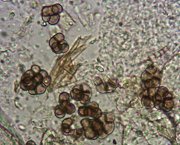
I needed a change of scenery. The weather forecast was good. So I took advantage and went to Ainsdale Nature Reserve. One of my North West Fungus Group colleagues had the same idea so we joined forces. Too many fallen leaves in the broadleaf woods so we headed straight for the dune grassland. Lots of interesting species only found on dunes. Melanoleuca ablfolia, Entoloma sericium var. cinero-opacum, (Silky Pinkgill - dark version), Hygrocybe insipida (Spangle Waxcap), the tiny Atheniella flavoalba (Ivory Bonnet) in moss. The only new fungus for the site was the Hyphomycete, Cheiromycella microscopica, that was only detected when the spores appeared on the surface of the Ascomycete Hyaloscypha aureliella.
Friday 13th November 2020
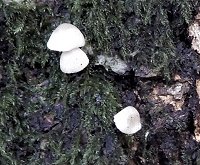
Another fine day. Another site to visit this time Woolton Woods and Camp Hill. Although only five minutes from home, I rarely visit because it is so popular and only one linear path. Despite the weather clouding over it was full of prams and dogs as usual. I tried a couple of lesser paths through the woods and met a man who was looking for fungi to photograph. I directed him elsewhere. All I had was mud and lots of leaves. There was a lot of dead wood about and I managed to find some interesting fungi. A lot of trees were mossy and lots of Mycena olida (Rancid Bonnet) was growing on a number of them. On one piece of branch I recorded Stereum hirsutum (Hairy Stereum), Schizophyllum amplum (Poplar Bells) and Rustroemia firma (Brown Cup) all growing together. A fallen beech tree produced Melanotus hoirizontalis (Wood Oysterling) and two Ascomycetes, neither of which I have yet identified. Candidates for the Mystery Folder.
Thursday 12th November 2020

The weather is still holding good so I went to another local site, Halewood Triangle. I have not visited this year. It was disappointing. A couple of large rings of Lepista irina (Flowery Blewit) which I expected to see. A few Tricholoma sulphureum (Sulphur Knight) and some Mycenas (Bonnets) and that was it. It was very muddy and my usual route around the many small ponds was too wet to negotiate. The deep drifts of leaves probably covered anything else. I took one of the Flowery Blewits home. The sweet smell was still in the car on Friday morning.
Tuesday 10th November 2020
Back again to the golf club. This time for more Mycena specimens to prepare for DNA. This time I walked through the small nine hole course. Fungi were growing everywhere. Different species from the main course. Fortunately I had enough boxes to collect but it poured with rain so no photos. Also it is getting dark at 4pm. I recorded Imleria badia (Bay Bolete), Gliophorus irrigatus (Slimy Waxcap) and Tricholoma ustale (Burnt Knight). But I have only just started to identify my coilections. Interesting how different parts of the same site produce different fungi.
Monday 9th November 2020

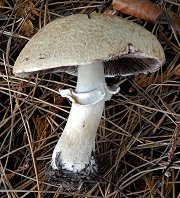
Not wanting to waste the opportunity, I went back to the golf course to see if I could reach the parts that other mycologists fail to reach. I spent almost three hours walking round. But apart from one small copse at the far end of the course, most of the fungi were in the areas I had looked at on my previous two visits. The new finds were of Laccaria proxima (Scurfy Deceiver), and under conifer both Agaricus augustus (The Prince) and Lepista personata (Field Blewit). The Lepista is said not to grow with conifer but this is the third time I have found it under Cupressus at different sites in 12 months. Another interesting find was of a group of small Mycenas in moss on a tree. Either Mycena hiemalis or olida (Rancid Bonnet). But one was white and the other was greybrown. Could be both growing together. So I have prepared specimens for DNA examination.
Friday 6th November 2020
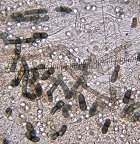


I took a colleague from my currently closed golf club, who is on the ecology committee there, to my open local golf course to teach him a few things about fungi and their importance to ecology. Fortunately he is a naturalist with a degree in something relevant. He brought along his camera with a massive super zoom lens. Sadly, a lot of the fungi were not in the best condition. We had a severe hail storm at the beginning of the week. But good enough for a novice. I managed to add to my records of the day before. Macrocystidia cucumis (Cucumber Cap), Cortinarius alboviolascens (Pearly Webcap), and Gymnopus fuscopurpureus. An interesting find of the common Clavulina cinerea. It was not particularly grey and had a blackened base. I examined this and found that it had been attacked by another fungus, Helminthosphaeria clavariarum.
Thursday 5th November 2020
Liverpool has gone into a major pandemic lockdown. I am very disappointed that my own golf course will not allow people to exercise. Fortunately, my local golf course has no restrictions so I took advantage for a quick survey. No golf so nobody hitting golf balls at me. Loads of fungi especially under the birch trees. Most of them I know, Lactarius tabidus (Birch Milkcap), Lactarius turpis (Ugly Milkcap). But interesting that I had never before recorded some very common species for this site such as Leccinum scabrum (Birch Bolete), Leccinum variicolor or Cortinarius hemitrichus (Frosty Webcap). Probabaly because I have no access to the main golf course when people are playing.
Monday 2nd November 2020



A quick wander round a local park. Rickenella fibula (Orange Mosscap) and Rickenella swartzii (Collared Mosscap) on the lawns. Lepiota ochraceofulva still under the Cupressus leylandii. Most interesting find was of Gymnopilus sapineus (Scaly Rustgill) under some Scots Pine. I have never identified one before. It has always been Common Scalycap.
Friday 30th October 2020
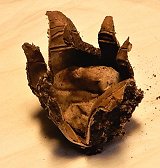

Must be all this rain. Fungi are not doing what they are supposed to do. An earthstar that I collected on Wednesday has only now decided to curl up. This must be Geastrum floriforme (Daisy Earthstar).It closes like a daisy. An uncommon species that I found in a different park last year. Both under Cupressus leylandii. I went to my allotment today to pick some veg for tomorrow, torrential rain forecasted. On the grass path I collected Peziza varia (Layered Cup), Lepiota cristata (Stinking Dapperling) and Mycena olida (Rancid Bonnet) on an an old Hawthorn stump.
Wednesday 28th October 2020


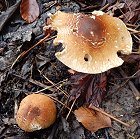
I took advantage of a small window of good weather to walk round Calderstones Park. I have a favourite shrubbery that never disappoints. But it was so wet and muddy and covered with fallen leaves. I had to work hard to find anything and then had to take it home to identify and photograph. My first bit of luck was a very large Lepiota type. Because of size and spores it has to be Lepiota aspera (Freckled Dapperling) but there could be something I do not know about. Then, under a Cupressus, a small earthstar. I have identified this a Geastrum rufescens (Rufous Earthstar) because of size of fruitbody and spores. Geastrum triplex also grows nearby but the difference in size is obvious.Then a couple I am sure of, Leucoagaricus badhamii (Blushing Dapperling), which I have never seen before and Clitocybe ditopa (Mealy Frosted Funnel). I must go back but, being half term, so many people made it difficult to do a decent collection.
Sunday 25th October 2020
Dodging the showers to my local golf course. Again. I only went for a quick walk. I managed to find six species. But the problems they gave me have lasted through to Monday. To start I had a Clitocybe fragrans (Fragant Funnel) that is not fragrant. Two Inocybes (Fibrecap). I got one as Inocybe fuscidula (Darkish Fibrecap) but gave up on the second one. I identified Entoloma longistriatum var. sarcitulum which looks very much like Mycena galericulata (Common Bonnet) which I also identified. Microscopically they are very different. Then a Cortinarius (Webcap) but my specimen was a bit old so I gave it up. My final specimen that I thought was an Inocybe turned out to be Laccaria tortillis (Twisted Deceiver).
Saturday 24th October 2020



Despite the atrocious weather, it did manage to stop raining for a couple of hours. I had to go to my allotment to pick something for tonight. So I went for a quick walk to the local golf course. In the short space of time that I was there, I found Chalciporus piperatus (Peppery Bolete), dozens of a tiny discomycete covering twigs on the ground. I later identified it as Rutstroemia firma (Brown Cup). Finally the largest Lactarius turpis (Ugly Milkcap) that I have ever seen at nine inches across. More rain. Back to football on TV for the rest of the afternoon.
Friday 23rd October 2020




Back to Liverpool parks after my day away at Ainsdale. A very good day for white coloured fungi. It started with a large group of Clitocybe phyllophila (Frosty Funnel) in the local nature reserve. This was followed by Lepista irina (Flowery Blewit) under Cupressus on the golf course. Into the next park for Pleurotus dryinus (Veiled Oyster). For a bit of balance, I also found Russula nigricans (Blackening Russula) amongst the beech trees. Not a bad return for a pleasant walk.
Monday 19th October 2020



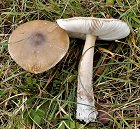
I took advantage of some promising weather to pay a visit to Ainsdale Nature Reserve. A change of scenery from wandering around the parks of south Liverpool. I was well rewarded with swathes of fungi and managed to collect fifty species in the first two hours. Sadly there is only me to identify them so I went home early as I had filled my collection box. Nothing new for the site which is unusual. Some good finds of Amanita submembranacea, one that has to be identified from the microscopic make up of the volva. In sand this is very deep and had to be dug out hence the absence from my photograph. Some photogenic Bolbitius titubans (yellow Fieldcap) and Otidea onotica (Hare's Ear) and the dune grassland specilist (Neottiella rutilans) are also recorded. I only saw three other people. It was so peaceful.
Tuesday 13th October 2020

Another allotment that had horse manure spread over it. This time the rain had not destroyed the young fruitbodies. This is Coprinellus radiata, a horse manure specialist. My previous identification of Coprinopsis lagopus is probably wrong as there are no previous records for it growing on horse dung. I went back to the garage for my car today. The piece of roadside verge that last week hosted Xerula radicata (Rooting Shank) now has Pholiota gummosa (Sticky Scalycap) and Pluteus plautus (Satin Shield). Why this one tiny spot?
Wednesday 7th October 2020
The vegetable patch that had Peziza vesiculosa growing in the horse manure now has fifty Coprinopsis lagopus (Haresfoot Inkcap) as well. Unfortunately, the heavy rain has all but demolished them so no photograph. Pity. Meanwhile, back at home, Psathyrella microrhiza (Rootlet Brittlestem) is added to the growing list of species growing on my lawn.
Sunday 4th October 2020

I went back to the allotments and took photographs of the Peziza vesiculosa (Blistered Cup). I was surprised that they had not been washed away after all the torrential rain.
Saturday 3rd October 2020


Last week I was looking through my photographs of fungi. I came across a file marked 'Unknown' of a tiny unidentified white species from the golf course. Behind my garage is an old rotten branch that I had forgotten to dispose of. Today, I picked it up to see if anything had grown on it. I saw this patch of what looked like sand. Under low magnification they looked like very tiny Xylaria. Seeing them under a microscope, I remembered a diagram in my book about microfungi. I can identify them as Phaeoisaria clavulata. I then realised that this was the same as the 'unknown' fungus on the branch from behind the garage. The new photographs were much better. I managed to get rid of a file from my Mystery folder which happens very rarely.
Friday 2nd October 2020

No car. Still in the garage awaiting parts. I had to walk to my allotment so I entered by a different gate. As soon as I walked in I found Echinoderma asperum (Freckled Dapperling). Someone had kicked it over but it is a very large Dapperling so easy to identify. It was next to a plot that had been recently manured, looked like horse. There were dozens of Peziza vesiculosa (Blistered Cup) growing in the manure. Sorry no photos but my spare camera is in the car. I shall try to get some photos after the promised heavy rain has gone. I have got a photo of a little 'brown job' from the golf course. But it is not a 'brown job' because it is an almost albino form that has no spores. Psathyrella corrugis (Red Edge Britlegill) and pseudogracilis can produce what was forma substerilis but this is no longer recognised. I have found it a number of times. It could easily be mistaken for a Mycena (Bonnet). Microscope essential.
Thursday 1st October 2020

Took my car in for repair. It had stopped raining so I walked home. It is only three miles and I pass through the cemetery, the crematorium gardens, two parks and a golf course all of which are regular foray sites. Of course the first fungus I found was Xerula radicata (Rooting Shank) on the grass verge outside the garage. I found nothing at all for two miles until I reached the golf course. There I found a patch of Leucopaxillus giganteus (Giant Funnel), one Russula xerampelina (Crab Brittlegill) under the pines and two Russula delica (Milk-white Brittlegill) which were brownish. Not much for three hours walking.
Wednesday 30th September 2020

I may have found another species of fungus new to the UK. I have five clumps of an ornamental Sedum given to me over forty years ago. This year, for the first time, a powdery mildew appeared on the leaves. I took the easy route and declared it as Erysiphe sedi but was asked to prove it as there is another Erysiphe that grows on Sedum. Out came the microscope as the two are different microscopically. I satisfied my questioner and the author of a recent book about mildews that I had found Erysiphe sedi. When I reported this to the National Database, I was told someone else had also reported a find. But they had not recorded this. So I have claimed the discovery. Now waiting to see if Kew Fungarium are interested in a sample.
Thursday 17th September 2020



I visited the crematorium garden of remembrance. Lots of old trees. Poking about along the boundary, I could smell Phallus impudicus (Stinkhorn) but could not find it. So I pushed through the Cupressus hedge and there it was. It was also surrounded by stinkhorn eggs. I stopped counting at 100. I have never seen so many in one small space. I do not intend to visit when they all mature. Other finds of Agaricus bitorquis (Pavement Mushroom) with a double ring, Lactarius blennius (Beech Milkcap) and Lactarius delicosus (Saffron Milkcap). I also took a leaf from a Sycamore that had powdery mildew. I took a photo of the fruit body (Chasmothecia). First time I have captured a whole one. They are usually broken to allow the spores to escape.
Tuesday 15th September 2020
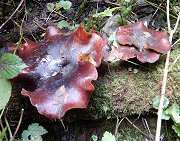

A quick visit to some local sites produced a good mix of species but hard to find as everything is so overgrown. Lepiota ochraceofulva has appeared for the fourth year running under Cupressus leylandii but only one specimen so far. A few common ones, Amanita rubescens (Fly Agaric) and Russula parazurea (Powdery Brittlegill). I then chanced a visit to The Eric Hardy Reserve, the bottom path. In a ravine with a stream, I thought it would be dry. Wrong. Ankle deep mud and a blocked path. Nice finds of Physisporinus sanguinolentus (Bleeding Porecrust), a bracket that turns pink to red when bruised and Polyporus badius (Bay Polypore). Also a couple I did not identify. A strange whitish thing that grew in great number on a fallen tree and a small brown job that I thought would be a Conocybe (Conecap) but the microscopic features were wrong. Must go back for some more.
Monday 14th September 2020

I was getting into my car when I noticed some fungi growing by the roadside kerb. On closer inspection, they were Coprinellus micaceus (Glistening Inkcap). They were lodged in a crack in the road surface probably caused by tree roots. The road is lined with large, old beech trees which regularly fall over in storms. One such tree did so during the 2018 winter so there may be dead roots to sustain the fungi. The Magic Mushrooms on my lawn are increasing daily. Up to ten now.
Monday 7th September 2020


I had to take my car for new brake pads to a garage round the corner from Speke Hall. The Hall was closed but I knew of a hole in the fence of an old industrial site that leads to a wood that runs down the side of the Hall. Only used by local dog walkers in the know, the wood still has the wartime gun posts to defend Liverpool Airport. The hole was blocked but a young lady with a dog came along and told me they had made a new one. I had an hour so had a quick look round. In a patch of birch scrub I found Russula exalbicans (Bleached Brittlegill) and Lactarius pubescens (Bearded Milkcap), a Deceiver and a few brown Psathyrellas. Best find was Galerina clavata along the path. Back home I was examining the lawn and found a Psilocybe semilanceata (Magic Mushroom). It is over ten years since it last appeared in my garden.
Friday 4th September 2020



A lovely day so I went to Freshfield Dune Heath. A large Boletus edulis (Penny Bun) that the pickers must have missed. Too far gone to be edible. Also a large Leccinum aurantiacum (Orange Bolete) under Aspen and Oak. Lots of Mycena metata under pine on the dune heath. Over to Ainsdale Sand Dunes where I counted dozens of Russula caerulea (Humpback Brittlegill) in the pinewoods. A small clearing in a birch wood produced hundreds of Humaria hemisphaerica (Glazed Cup). Finally, Psathyrella ammophila (Dune Brittlestem). Sadly it was blowing a gale on the front so I retired back to the woods. It was so quiet now that the kids have gone back to school. I only saw three other people. Heaven.
Wednesday 2nd September 2020


As soon as the children went into their school, I set off for my local park. It is the largest in Liverpool but being surrounded by housing, the most popular. Early this morning I was there on my own. But I was disappointed. A few bits and pieces, mainly mildews. I expected Russulas but none to be seen. Ramaria stricta (Upright Coral) seems to be everywhere at the moment. Also Marasmiellus vaillantii (Goblet Parachute) which is said to be uncommon but is probabaly overlooked due to size. The only thing to lift my spirits was Geastrum striatum (Striated Earthstar) still hanging on under the same stand of Cupressus leylandii where it has survived for a number of years.
Monday 31st August 2020


A quick visit to my favourite woods at Hale. Last day before the kids go back to school. The car park was packed but as it had rained heavily the night before, the paths were flooded. So most people turned back. Being suitably shod, I was left in peace. I found Xerocomellus pruinatus (Matt Bolete) and engelii (Ruby Bolete) and a few Russula nigricans (Blackening Russula). The remains of an oak tree produced an attractive display of Laetiporus sulphureus (Chicken of the Woods) on the stump. Peeking out from a crack in the fallen trunk was Fistulina hepatica (Beefsteak Fungus). Quite a menu.
Monday 24th August 2020
A walk up to a small local museum before the storms arrive. It has a small wooded area, mainly beech. It always produces fungi much earlier than other local sites. It did not disappoint. Russulas fellea (Gernium Brittlegill)) and nigricans (Blackening), Clitopilus prunulus (The Miller) and Caloboletus radicans (Rooting Bolete). A new find for me of Leptosphaeria maculans on Alliaria petiolata (Garlic Mustard). I pulled out a dead stem with no idea what it was. Fortunately the fungus was easily identifiable.
Monday 17th August 2020




An old refuse tip has been allowed to grow wild so lots of tall plants that are now dead stems. One of the dead nettles produced Lachnella villosa. A nearby Hogweed stem supported two Discomycetes, two Hyphomycetes and a couple of Lachnella alboviolascens. I managed to find a spore on the Lachnella alboviolescens so my identification is correct. I was helped by my purchase of a new microscope camera to take the pictures. This also was important in my identification of Scleroderma bovista (Potato Earthball) where the spores have total reticulation. Not having a prominent stem also helps.
Tuesday 11th August 2020
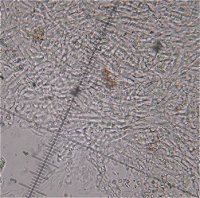

I was wrong. Last week, I identified a medium sized white Agaric as Calocybe gambosa (St. George's Mushroom) but it bothered me that it was still growing so late in the year. So I went back for some specimens to take a better look. It was in a spread out group rather than a ring. The size was fine but not as chunky as Calocybe and It did not smell of anything. Under my microscope, the spores were much the same as Calocybe. To reach a decision, I had to look at the hyphae in the cap. Instead of being long and regular, these were short and more like a jigsaw puzzle. My belated conclusion is Clitocybe phyllophila (Frosted Funnel).
Wednesday 5th August 2020

Working through my finds of yesterday, I found myself struggling to identify a medium sized Agaric from the woods, I thought it might be Calocybe gambosa (St Georges Mushroom) that I did record on the day. But the spores were wrong, spiny and too large. After a lot of research I came across Calocybe constricta (Mealy Domecap), so I was close. It is now named Tricholomella constricta. I have not recorded it before for myself nor North West Fungus Group.
Tuesday 4th August 2020



A cooler, windy day. I figured that not many folk would be about so I visited some local parks. My first find was of a magnificent Hymenopellis radicata (Rooting Shank). It was 10 cms across, all by itself in some long grass. This was followed, in the next park, by a group of Calocybe gambosa (St Georges Mushroom) still hanging on into summer (Query summer?). Also Marasmiellus vaillantii (Goblet Parachute) on fallen twigs. Moving on, a most interesting find of Laetiporus sulphureus (Chicken of the Woods). Not on oak but at the base of a Yew. The toxins in the Yew render poisonous this usually edible fungus.
Wednesday 29th July
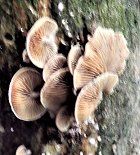


Managed to get out after a wet morning to a local wood only to discover that everyone else had the same idea. So I disappeared to some of the quiet spots. First find was Calvatia gigantea (Giant Puffball). This was followed by Agaricus macrocarpus (best described as a woodland Horse Mushroom). Quite a brassy yellow and I thought it was a Yellow Stainer. But it had a delightful smell. Most interesting was Pluteus nanus (Dwarf Shield) which I thought would be a 'little brown job' until I saw the pink gills. Not very often recorded. My only other find was Melanotus horizontalis (Wood Oysterling), a species that has become naturalised over the last thirty years. I first saw it then on imported plywood that had been stored outside. It also regularly popped up on nesting boxes.
Tuesday 21st July 2020

My grass stem is sprouting dozens of Flagelloscyphas in a damp box. But I can not get a decent photo of a four spored basidia to nail my identity as pilatii. I even bought a microscope camera to improve my picture fire power but they are quite small and with the magnification of the camera it may not be possible to get the correct focus to see all the basidia at the same time. A couple of finds close to home. Agaricus campestris (Field Mushroom) on the grass square at the front of my house and Calocybe carnea on my front lawn.
Thursday 16th July 2020

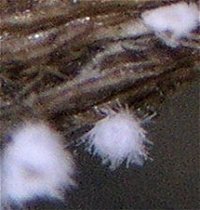
I am determined to get a photo of a basidia of my Flagelloscypha to prove it is Flagelloscypha pilatii. Back to the place I found it. I searched around. Nothing obvious. So I extracted a lot of dead stems in the hope I would be successful. Back home, under my microscope, I was delighted that I had found some more. Into my damp box they went to try to get them to mature. Watch this space. I had never before looked at grass stems as a fungus source. I have added Brunnipila palearum to my list.
Tuesday 14th July 2020
A visit to Childwall Woods, a local nature reserve. A dead stemming day with some interesting finds. Nothing much in the beech woodland but the scrub and fields were productive. I pulled out some dead stems of Agryporon repens (Couch Grass). A tiny, tiny white species. My identification is Flagelloscypha pilatii, a rare species that only grows on grass. None of the other Flagelloscyphas grow on grass so I am confident but would like to take a photo of a basidia to confirm. It should be 4 spored. I can not find one.
Friday 10th July 2020
Not far to go today. I got the mower out on my back lawn and noticed Rickenella swartzii (Collared Mosscap) and Rickenella fibula (Orange Mosscap). They both grow in moss so not much to be said about the quality of my lawn. I also found Entoloma minutum. The clue is in the name. It is not often recorded but it is small, pale brown, growing in grass. Not very exciting. I thought it might just be another Rickenella until I looked at the spores. I did not expect an Entoloma.
Wednesday 8th July 2020


Last week I collected a pretty yellow Ascomycete. I put it a damp box. As it matured the surface became covered with spots. These are ostioles. The fungus looks like a pepper pot. I identified it as Hypocrea aureoviridis. Today I found an orange companion, Hypocrea rufa. Two pepper pots in a week. I also found three Russulas (Brittlegills) under the same beech tree, Russula sororia (Sepia) , ionochlora (Oilslick) and cyanoxantha (Charcoal Burner). On looks, I thought the last two would be the same but when I rubbed iron salts on the stems, one was rusty orange the other green. Things are looking up.
Tuesday 7th July 2020
Hurried up to my allotment to pick blackcurrants before it rained. Under the bushes, in some moss, I found half a dozen Rickenella fibula (Orange Mosscap). So not far to go. One never knows what will turn up.
Thursday 2nd July 2020


A visit to Hale Hall wood this afternoon. Not for long as there were people everywhere. I came across a large patch of dead nettle stems that were covered with Lachnella villosa. Looks like an Ascomycete and fools a lot of folk. It is a very tiny Basidiomycete. The photograph is x40 which tells you how tiny it is (click for larger image). There were also a few Pyrenopeziza atrata. Interesting to me was a find of Fuscoporia ferruginosa (Rusty Porecrust). This wood has only produced Fuscoporia ferreus in the past. I did find some other fungi but they have conidia and conidiophores. I struggle with these because I do not have the necessary literature. Into the Mystery Folder they must go.
Wednesday 1st July 2020
Not far to travel today. On my front lawn is a couple of Panaeolina foenisecii (Brown Mottlegill). On my next door neighbour's lawn are six Agrocybe pediades (Common Fieldcap). I must take a walk around the block to see if any other lawns are growing fungi.
Sunday 28th June 2020

During my visit to Ainsdale last Monday I collected a piece of dead Ammophila arenaria (Marram grass) because it had a fungus needing further research. The fungus turned out to be Lophodermium arundinaceum (Leaf Split). However the piece of grass also had small black spots on it. To get it under my microscope I had to slice the leaf. Marram leaves curl into a tube. To my surprise, there was another fungus inside, a discomycete. After much research and help from colleagues, it was identifed as Belonium psammicola. Only six records on the National Checklist but this is not surprising as to find it you would have to sit and uncurl lots of dead bits of grass. Or get lucky like me. No idea what the black spots are.
Thursday 25th June 2020
Early to my allotment to get some work done before it got too hot. At the entrance to the site, poking though the hardcore, were a dozen Lacrymaria lacrymabunda now velutina (Weeping Widow). I think the old name was better. They are probably growing from the buried remains of a Beech tree that was blown over in gales a couple of years ago and removed.
Monday 22nd June 2020

I decided to visit Ainsdale Sand Dunes Reserve intending to foray on the dunes but it had been a touch windy last week and nothing was showing through the sand. So I dropped back to the dune slacks. Lots of Agrocybe pediades (Common Fieldcap) everywhere. In one slack there were patches of charcoal where encroaching scrub had been cut and burned. In a small hole I spotted a couple of small inkcaps. To identify these firesite inkcaps it is essential to find a young one to check if it has a veil. I was in luck. One did. From my microscopic examination of the veil I concluded that it was Coprinopsis gonophylla. Not often recorded but they are not species one comes across very often. Other finds included Suillus bovinus (Bovine Bolete) and Gymnopus peronatus (Wood Woolyfoot) together with few small Ascomycetes on various dead stems. I had not been to this part of the Reserve for a long time. I actually got lost. I did know where I was but since my last visit, stock fences had been erected for cattle, blocking my old paths. Routes through the woods were overgrown and impassable. New routes had been created. I had great difficulty working out which paths would get me to where I wanted. I walked for miles. I must go back to acquaint myself with the new layout.
Saturday 20th June 2020
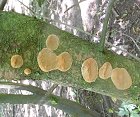
Nice afternoon so I visited The Eric Hardy Nature Reserve to see if any fungi had appeared. But there were people everywhere so I had to disappear into the depths of some very wet woodland. I recorded 15 species in just over an hour which is quite good for one person in June. Most of them in one small area that surrounded a large puddle. Pluteus plautus (Satin Shield), Tubaria dispersa (Hawthorn Twiglet) growing on buried berries and a late Calocybe gambosa (St Georges Mushroom). Lots of wild cherry trees in this wood, a dead tree supporting a good growth of Phellinus pomaceus (Cushion Bracket).
Wednesday 17th June 2020

Having manured my bean patch at my allotment I am pleased at the progress my runner beans are making. Having had lots of rain recently, fungi are starting to appear and twenty or so Panaeolus papilonaceus (Petticoat Mottlegill) decided to join my beans.
Wednesday 10th June 2020
Today I visited the Speke-Garston Coastal Reserve, known in Liverpool as 'The Old Airport'. Allowed to grow uncontrolled, I would describe it as Tall Ruderal in the NCC Ecosystems Code. A pleasant walk along the river and then back along the old runway through waist high nettles, reeds, bracken, thistles and the like. Lots of dead plant material but identifying it is the problem. I collected a number of dead stems. Species identified include Pyrenopeziza atrata and rubi, Lachnella villosa and a new one for me, Cyathicula cyathoidea var. pteridicola, which grows only on dead bracken. However a check on the Index Fungorum shows it is now renamed and bundled together with the standard Cyathicula. This despite the literature describing a difference in the spores.
Tuesday 9th June 2020

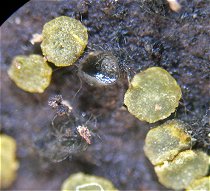
In March, I was foraying at Hale and came across a rotten tree trunk. Underneath I found an Ascomycete. Looking at the spores under my microscope they had ornamentation. I looked through every book, the forums on Ascofrance and asked help from colleagues. No identification. As soon as strict lockup ended, I went back and was lucky to find some more. But with the same result - no identification. So I Emailed Peter Thompson who wrote a book on Ascomycetes. He replied that 'it is Mollisia subglobosa, species 373 in Ascomycetes in Colour. From what is known about this rarely recorded species, it grows on decaying wood of mature holly = Ilex aquifolium, which should be present where you found it'. There is lots of Holly in this wood. Previous finds have been in Hampshire, Somerset and Pembrokeshire, so my find is unusual being so far north.
Friday 5th June 2020
Now that restrictions are lifted, I managed an outing to one of my favourite woods. A bit cold and windy so not many people about. A couple of molds and a rust on grass. One Ascomycete, Pirottaea nigrostriata on the dead stem of a Hogweed. What I was really after was some more specimens of an Ascomycete I found before the lockdown. It has ornamented spores which is very unusual. I have not been able to identify it. I managed to find the rotten log and it still had fruit bodies. Difficult to remove because the wood is so rotten and brittle. I was able to get a few crumbly bits. Fortunately I did get a few specimens and they are the same fungus. But I am no further forward in identifying it. Very frustrating.
Wednesday 3rd June 2020


This warm weather has encouraged the return of my old friend Pear Rust - Gymnosporangium sabinae. It starts as bright orange spots on the upper leaf surface but develops quite large brown galls on the underside. It needs an overwintering host which is Juniper. I had this great idea that if I removed affected leaves from the Pear it might prevent the spores going back and forth to the Juniper. But this has not worked. So I will have to put up with it. Defoliating my tree may not be such a good idea.
Wednesday 13th May 2020
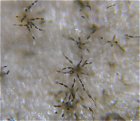


My allotment neighbour grows a number of flowering plants. I noticed some dead stems that looked promising. Identifying the plant will have to wait until it flowers but I am fairly sure it is Daisy family, probably Aster. A couple of days in a damp box and a couple of species have now provided sufficient microscopic information to be identified. Both are very common and grow on all sorts of dead stems. Colletotrichum dematium is a small black spot. It has setae or spines but you need a microscope to see them. The other was Alternaria alternata. The photograph shows the spores growing on the stem in strings. I have not seen this before usually having to rely on finding the spores on a slide.
Thursday 7th May 2020

I have been checking my damp hogweed stem and have found a fifth fungus growing on it. The Ascomycete Belonidium mollissimum. A good collection for three inches of dead stem. Sadly, the weather has turned hot and dry. I have collected nothing on my recent exercise walks. It would be nice to have a look at some of my other sites. But one is five miles away and the paths are narrow, so no chance of avoiding other people. Like all other National Trust sites, Speke Hall is closed. The larger parks are very popular. So, for the time being, I shall have to stay local.
Sunday 3rd May 2020



My finds from Friday have been sitting in a damp box to keep them fresh and growing. Some results. A crust fungus found on a fallen pine branch is Hyphodontia subalutacea. Interestingly the British Checklist says it is rarely on conifers. Yet my European text book says it is regularly on conifers. I am happy with my microscopic identification. Europe wins. My Hogweed stems were very productive. Cyathicula cyathoidea and Pyrenopeziza atrata are common on a variety of dead stems. I also managed to to spot Colletotrichum dematium, a spiny black spot and Botrytis cinerea. I shall keep the stems damp to see if anything else starts to grow. It is surprising how many different fungi these stems can support.
Friday 1st May 2020

Two rainy days at last. So, I escaped from lockdown to see if any fungi had been persuaded to show. I was in luck. Calocybe gambosa (St. George's Mushroom) in my local Eric Hardy Nature Reserve. A few bits and pieces just starting on dead stems but they need to go into a damp box for them to develop. Promising with more rain to come.
Wednesday 22nd April 2020
The allotment is coming along although it has been very cold at night so too early for the more tender plants. A few walks round my local golf course but only rust in bluebell and dock leaves to be seen. Same at home. Rust on my hellebores. A lone Entoloma sericium (Silky Pinkgill) appeared in the lawn but not for long as my wife had the lawnmower out. The only thing of interest is a small black erumpent fungus growing on the dead stems of Sedum. I have spores but can not find anything in my literature that fits.
Monday 6th April 2020

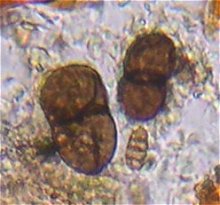
Back to my allotment although there is not much I can do as it is too dry to sow seeds. Potatoes and onions are in. So I went for a wander round the site. I came across some old prunings from an Alder on the boundary. Looked like it might have something buried in the bark so I took it home. A bit of scraping on to a microscope slide and I got a result. Looking through my Microfungi on Land Plants, an essential book if you want to identify this type of fungi, I found a diagram of the spores I was looking for. A check on the Internet for more information. The result is Otthia spiraeae. Encouraged, I tried a scrape from a piece of Birch bark from yesterdays walk over the golf course. It produced some spores. More research and checking. The result is Pseudospiropes obclavatus, which through the microscope is a very tiny hairy thing, the hairs being the spores. Both new to me. Keeps me busy.
Sunday 5th April 2020


I decided to avoid the allotment today as there would be too many people milling around. So I went for an early walk cross the golf course. There is a public right of way across the course. As golf is banned I can get to places I would not be permitted to go. Along one boundary there is a wealth of fallen wood. Pity it is so dry. It was rolling logs and pulling dead stem time as there was nothing else. Back home under a microscope, I was looking at some black spots on a nettle stem and noticed a couple of little brown stars. I thought they were microscopic mites. Looking through my books for clues to the spots, I came across a diagram of the stars. They are from Asterosporium asterospermum. But this is a beech wood fungus. So how it got onto my nettles is a mystery. Still no idea what the black spots are. A bit of scraping of some dead wood also produced spores from Pseudospiropes obclavatus, new for me. OK. So these are desperate times for a fungus forayer.
Tuesday 31st March 2020
My first coronavirus foray on my allotment. Some Hypholoma fasciculare (Sulphur Tuft) growing from the main path. Schizopora paradoxa (Split Porecrust) on the ends of my old Bamboo canes. I am planning an extended Bamboo cane foray in the very near future. Now that I have the recent publications on rusts and mildews, not a leaf will remain unturned.
Saturday 21st March 2020

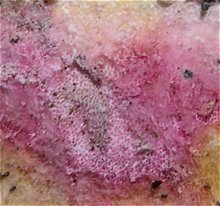
I managed to get out the day before restrictions were imposed. Problem was that with no football on TV, no pubs and the kids off school, everyone and their dog was out as well. I went to Hale Hall woods, hoping it had dried up a bit. It had. But with all the people around I disappeared into the darkest part of the wood where nobody goes. Nothing exciting. Three new for the site. Hypomyces rosellus, a parasite on Trametes versicolor (Turkey Tail), lots of the slime mould, Physarum album and Botryobasidium subcoronatum. The last one caused me problems because the microscope showed large conidia type spores which this species does not have. They seemed to be from Botryobasidium aureum. Although I did not find it on this day, it is common in the woods. I suspect, one was nearby and the spores contaminated my specimen. Very confusing. Good news. An allotment is considered as exercise. Jeremy Corbyn has an allotment.
Sunday 15th March 2020

As there is no football on TV, I decided to visit Ainsdale Sand Dunes Reserve before Boris Johnson locks me away. It is extensively flooded and I could not use the normal paths but had to go cross country, up and down hill and fighting the brambles. I managed to fill my collecting box, mainly Ascomyces and Crusts. A few slime moulds. None of these are easy to identify and I am still struggling with some. Best find of the day was a single Gyromitra esculenta (False Morel) under a pile of fallen branches. It was in the same place as when I first recorded it in 1999 but I have not seen it since 2004. Interestingly, a colleague found one on the same day at the National Trust Red Squirrel Woods. I recorded one new species for the site. Phanerochate velutina is very common crust but never been identified on previous visits. But it is not very interesting to look at.
Sunday 8th March 2020

I went for a walk to my local golf course. Nothing. I played golf at my golf club. Nothing. I went for a walk to my local nature reserve. I could say nothing except I did find a small black spotty thing on a dead Rubus (blackberry) stem. To my great surprise, I managed to identify it as Clypeosphaeria mamillana. I was quite proud of my effort until my books told me it is very common.
Friday 28th February 2020
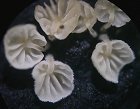
A nice day. I decided that I would visit Stockton's Wood, which is a National Trust property now attached to Speke Hall. It was closed because of dangerous trees. So I went to Speke Hall instead. I was there a week ago but today, after all the rain, the paths were so muddy it was hard work just getting round. Peniophora lycii was common on the dead gorse branches. Another find of Hemimycena tortuosa (Dewdrop Bonnet) which seems to be very common this year. Mine were so small at 0.5mm that I needed a magnifier just to see that they had gills.
Sunday 23rd February 2020


A colleague tipped me off that there were some morels in a flowerbed at my local park. The flowerbed is beside the renowned Calder Stones, the remains of a neolithic burial. The stones are inside a mansion house garden beside a cafe. Fortunately it was blowing a gale and raining so clientele was few. I sneaked in, took a few photos and pinched one together with a Peziza that was also growing in the mulch. I left before I had to explain. The morel was probably past its best. I got very few spores but the paraphyses were in favour of Morchella vulgaris. The Peziza was Peziza varia (Layered Cup). Not a bad excursion on such a rotten day.
Monday 10th February 2020

I have managed to get out in between the storms and rain. Hard walking through the mud. But not a lot to find. Very few Ascos, crusts and brackets. What I do find is usually very dirty and I am breaking a lot of cover slips. I have found a few patches of Hemimycena tortuosa (Dewdrop Bonnet) at various sites, hiding under piles of logs. No much evidence of dewdrops but the thin spores and very hairy stem give it away. Under a microscope, many of my collections, especially crusts, have lots of other spores floating around. Trying to identify what they come from is a challenge. I found a real beauty on one specimen and after research concluded it is Bactrodesmium obovatum. Looking it up in my Microfungi book, I was very disappointed to learn that it is the commonest species on wood and bark all year round. So why have I not found it before??
Tuesday 4th February 2020
My bird feeder was blown off in the high winds. I went out into my back garden to retrieve it. Growing on the lawn are five Entoloma sericium (Silky Pinkgill). Seems early but we have not had any hard frost in Liverpool so far this winter.
Saturday 1st February 2020


No rain again. A nice walk in the winter sun to one of my favourite woods. Not much of interest but it was nice to get the exercise. I wandered off my usual route to a spot called Lady Pond. Lots of dead hogweed stems. At last an Ascomycete. My decision is Belonidium mollissimum. It is common but I rarely identify it. The other find was Byssocorticium corium which is also very common. Ususally flat but this one had grown like a small bracket. I assume the piece of wood had been moved at some time.
Thursday 30th January 2020

Sunny day so I played golf. Nothing at all on the golf course. As I was walking back to the clubhouse, I noticed a black patch on a piece of fallen oak. I thought it might be the very common Torula herbarum so I took it home to check. This fungus looks hairy and has spores in long chains. Checking the literature, it only grows on herbaceous stems. I examined the spores which are in long chains but the links are not quite the right shape, squarish and not round. More research came up with Diplococcium spicatum which grows on oak. I also found three other spores on my wood, one set being in asci. One matched Bactrodesmium pallidum, another Brachysporium nigrum. No idea on the spores in the asci which is a pity as it looked the most interesting.
Tuesday 28th January 2019
I needed to recheck a find from last week so I popped up to my local golf course. The target was Phlebia rufa. I did get it right first time. The weather was so dreadful, I was able to take a look at a part of the course usually out of bounds for me. I did not last long as it started to hail but beneath the wealth of fallen branch, I found Mollisia cinerea (Common Grey Disco), Hyphoderma argillaceum and Peniophoriella praetermissa, these last two being white crust fungi. I must go back for a better look but will have to wait for poor weather otherwise I might be chased off the course.
Saturday 25th January 2020
I paid a visit to Childwall Woods, not a favourite as it is full of dogs and never produces much even at the top of the season. Last year the 'Friends' asked me if I would lead a foray but not much point if there is nothing to see so I declined. I was not disappointed today. I found very little and nothing of great interest despite the wealth of fallen trees and branches. Crepidotus luteolus (Yellow Oysterling) is expected in winter although not a regular in this area. The star was the remains of a huge Lycoperdon gigantea (Giant Puffball). On the corner of two paths, I was surprised it had lasted so long.
Wednesday 22nd January 2020


The weather has calmed down so I went for a walk to my local golf course. A nice collection of Arrhenia retiruga (Small Moss Oysterling) in some moss. I was surprised to find a very nice Melanoleuca cognata. A spring fungus. Very early. Kicking over some fallen Beech leaves I spotted Crepidotus epibryus (Grass Oysterling).
Saturday 18th January 2020
Our third training session on DNA sequencing. I have mastered preparing the specimen and do not think I will have a problem preparing one to be sent for sequencing. We got some results from previous samples we submitted. I am having difficulty interpreting the results. My Caloboletus radicans (Rooting Bolete) is as I identified it but it seems there are two other groups that are close and may be different species. It is not known for certain which mine is. The same for my Lepista saeva (Field Blewit). It is confirmed against known sequences. This pleased me because it proves that the species does grow under conifer. The British Checklist and all the books I have say it grows with broad leaf trees. So they are wrong. But it is also only one of three similar groups so may be a separate species. Who knows? One of my colleagues submitted Flammulina velutipes (Velvet Shank) and it returned as Flammulina elastica, a rarity.
Friday 17th January 2020


It stopped raining so a quick walk round a local wood. Not much around but I did find what looked like the very common Chaetosphaeria phaeostroma. But it did not look quite right so I took it home together with a couple of Slime Molds. It keyed out as Chaetosphaeria pulviscula. The spores are different and there are no hairs that I could detect.The spores in the pics are immature. I did see some mature ones but lost them before I could take a photo and could not find any more. It pays to check even the most common finds.
Wednesday 15th January 2019




Slim pickings at the moment. A couple Myxomycetes (Slime Molds) are interesting. My photos show how they change their form as they age. You need to be patient with these species as it is necessary to wait until they mature before you try to identify them. The changes can be quite dramatic in a short space of time. The pink one that turns brown is Trichia meylanii, a variety of Trichia decipiens. The other two are of Physarum album.
Saturday 4th January 2020



I decided to have my annual allotment bonfire to get rid of all the fruit tree and bush prunings. Because of the constant rain my pile of material has been sitting on the ground for a couple of months. So I carefully examined all the branches and stems before they got burnt. It took 3 hours to finish the job but I did have some success with a collection of Lachnella alboviolascens on my blackberry. To wind down I went for a walk to a local park where a couple of trees had blown over. Some good pickings including what looked like an Asco on a branch. Under a microscope, there were no asci but lots of strange spores that did not fit. So I left it for a couple of days and had another go today. Different result. Bean shaped spores, encrusted cystidia. The conclusion is Episphaeria fraxinicola. This tiny Basidiomycete is difficult to find because it usually grows high up on living trees. I have found it only twice, on fresh prunings and now on this fallen tree. It often grows with dead Pyrenomycetes which explains the strange spores. I can not identify the Pyrenomycete but I suspect a Melanomma.
Thursday 2nd January 2020
And so we start again. A local wood has piles of wood from dead tree trunks which have been cut up into smaller pieces. A good haul of all the usual brackets and crusts, Bjerkandera, Trametes and Stereum, a couple of Psathyrellas (Brittlestems) and Mycenas filopes (Iodine Bonnet) and tenerrima (Frosty Bonnet). Hiding under the wood was a large number of Hemimycena tortuosa (Dewdrop Bonnet). No dewdrops present but, using a decent magnifier, you can see the hooks on the stem which would hold the dewdrops.
Friday 27th December 2019
One wood I visit which is not a mudfest is Stockton's Wood beside Speke Hall. Said to be ancient woodland it is crossed by drainage ditches making it a more pleasant walk after all the rain. I was surprised to find a large Pluteus cervinus (Deer Shield) still hanging on. A couple of Ascomycetes at long last, Cudoniella acicularis (Oak Pin) being common. While looking at fallen branches, I noticed some very tiny Mycenas on an old leaf. Not sure what leaf as Beech, Oak and Sweet Chestnut form the bulk of the larger trees. My conclusion after microscopy is Mycena polyadelpha. A couple of other larger Mycenas were a problem. One is Mycena metata which is almost identical to Mycena filopes except there was distinct pink colouring on the gills. The other requires more study.
Tuesday 24th December 2019
Taking advantage of some sunshine, I went for a walk in my local park, more for the exercise than fungi. The park is home to the Allerton Oak, tree of the year for 2019. I pass it often but the only fungi I have ever seen are Laccaria laccata (Deceiver). The Park was previously owned by one of the founders of The Cunard Line. He imported a host of trees from all over the World. One, a Polylepis australis from the high Andes, is showing its age and has been attacked by Bjerkandera adusta (Smoky Bracket), Coniophora puteana (Wet Rot) and Hypholoma fasciculare (Sulphur Tuft). It is also known as The Filo Pastry Tree because of its bark. Today I recorded four tiny Mycena corynephora growing in the 'folds'. I have a list of the imported trees that are planted but no map of where they all are. Some interesting fungi possibilities.
Sunday 22nd December 2019


Not been out much due to the weather. I tried a local park yesterday but all the paths were thick mud and I saw very little except for Crepidotus cesatii (Roundspores Oysterling). Better luck today at my local golf course. Daedalea quercina (Oak Maxegill) is a new record for the site. I went back to some Cupressus leylandii, where I had recently collected some odd Lepistas. I thought there was a bit of purple on the stem so decided they were Lepista saeva (Field Blewit). Although this is a golf course, therefore grassland, they were directly under the tree, I had to crawl in to get them. But this species is said not to grow with coniferous trees. So I decided that they must be Lepista irina (Flowery Blewit).Today I found a very young specimen, another hands and knees crawl under the tree. The photo clearly shows a purple stem. So either they are sheltering from the weather, the books are wrong, or it has hybridised. There are loads of Lepista nuda (Wood Blewit) nearby so plenty of close relatives.
Thursday 12th October 2019
My finds on my recent visit to Hale woods are proving difficult. I have discussed the Oxyporus with Kew who favour Oxyporus latermarginatus (Frothy Porecrust) from the information and photos that I sent, not O. corticola. Still a good find and an example of species moving north from southern England.
Wednesday 11th December 2019


Last week, from a pile of prunings and brash, I collected three pine cones. A mystery to me because I do not know where there is Scots Pine in the wood. One had Strobilurus tenacellus (Pinecone Cap) growing on it. It also had Bisporella citrina which is unusual. So I took it home to check. This second cone had a covering of a white crust fungus. I have keyed it out to a Sistotrema (Earthfan family) but am struggling to name it. While examining this cone I also spotted a tiny red species that I have identified as Neonectria fuckeliana. The third cone had a tiny oysterling type fungus. The cap and shape and size of the spores fit Crepidotus epibryus but that is said to be deciduous only so I am still no nearer to identifying it. Interesting but frustrating.
Friday 6th December 2019


The sun was out so I took a quick walk round my favourite local wood at Hale. Still very muddy. Large wellies. A few bits and pieces. Most interesting was a large expanse of a thick, corky, resupinate polypore on a very rotten fallen tree. The microscopic examination matched an Oxyporus but there are two very similar species. The main difference is the encrustation on the cystidia. But the cystidia are said to be rare. As it poured with rain again. I decided to try to find one. After about thirty minutes and ten slides, I think I found one. It matched a photo on the Internet. So it should be Oxyporus corticola for which there are only eleven records on The Database. Said to be southern England but moving north, it has finally reached Liverpool.
Wednesday 27th November 2019
Rain all morning then the sun came out. So I took advantage to visit my local nature reserve. Mud everywhere but a few fungi had surfaced, mainly Mycenas (Bonnets). My first find in the moss growing on a Sycamore was Mycena corynephora then Mycena hiemalis on a mossy stump followed by Mycena flavescens. A lot of Scutellinia citrina (Eyelash) on the mossy wood. Returning home, I noticed that my lawn had sprouted lots of Arrhenia retiruga (Small Moss Oysterling). A mossy day.
Tuesday 26th November 2019
I was not happy with my identification of Lepista saeva under Cypress trees so I went back to take another look. The sun came out (at last). The specimens I looked at today had grey stems so I changed my decision to Lepista irina (Flowery Bonnet) even though I could not detecy any smell. This is also unusual under conifer but the records of this are substantive. Interestingly, some of my colleagues to whom I sent pictures of these fungi are satisfied they are Lepista saeva. Shows what a difficult genus this is.
Sunday 24th November 2019
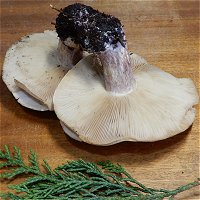
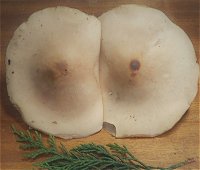
It stopped raining but it was like an allday evening. The sun never appeared. I went for a walk. There were fungi to be found, probably because the weather had warmed up. A species I had never recorded before this year, Psathyrella spadicea (Chestnut Brittlestem), was growing at the base of a Sweet Chestnut. I have found it at two other sites this year. Another mystery was a find of, what looks like Lepista saeva (Field Blewit), under a Cypress tree. It is said to grow only with broadleaf trees. But it was so gloomy that it was difficult to decide the colour of the stem which should be purple. Artificial light at home does not help. I shall have to go back if the sun ever comes out.
Saturday 16th November 2019


Decent weather at last so I paid a visit to Speke Hall to see if there were any waxcaps on the North Lawn. Lots of fruitbodies but only two varieties. One part of the lawn has been set aside as a feature and is not mown closely. The grass is more coarse and it supports Calluna (Heather). One of the waxcap varieties was Gliophorus laetus (Heath Waxcap). Heather is a perfect place for it to grow. There is also a sunken lawn that bounded by sculpted Yew bushes. A couple of years ago, I found a coral fungus growing beneath one. It was there again. I have identified it as Ramaria decurrens but most of the samples at Kew have been redetermined as Ramaria curta. However, that is said to have a larger spore than mine and decurrens likes Yew. So I shall stick with my identification.
Saturday 9th November 2019
Frost on my car roof this week. A walk to a local park that usually has a selection of waxcaps but they were all Gliophorus psittacinus (Parrrot Waxcap). Only three Geastrum striatus (Striate Earthstar) in their usual spot but there was evidence of a lot of Haloween traffic. A pile of coniferous waste was supporting numerous Hemimycena lactea (Milky Bonnet). And that was all there was to see.
Sunday 3rd November 2019


I joined a colleague for another visist to Dibbinsdale Nature Reserve, On my previous visit, I identified Hygrocybe pratensis (Meadow Waxcap) growing in woodland. My colleague had also identified the same species in the same area of woodland. All the books say that this is not possible. It must be Hygrophorus nemoreus (Oak Woodwax). So we returned to the spot and found a dozen along the bank of a stream. We also found Parrot Waxcap and Snowy Waxcap in the same area so why not Meadow Waxcap? I took some home to look at under the microscope. There are some differences so Oak Woodwax it is. Other good finds on the day were Coprinopsis spelaiophila, an inkcap that specialises in living in treeholes, Craterellus tubaeformis (Winter Chanterelle) and Craterellus cornucopiodes (Horn of Plenty).
Sunday 27th October 2019

My turn to lead a foray for North West Fungus Group at Ainsdale Sand Dunes Reserve. My favourite. A good turn out of members in excellent weather. The first find was a tree stump covered with Scutellina (Eyelash Fungus). It has to be a microscope identification but we all agreed on crinita. A major surprise along the track was the return of Stereopsis reidii. That such a rarity should show again suggests it has become established although it has not yet extended further. Another one in a box for Kew. Then we set about identifying and recording the fungi in the pinewoods and on the dunes. We recorded 138 species, a record for a foray. Highlights were Humaria hemisphaerica (Glazed Cup), the green Entoloma pleopodium (Aromatic Pinkgill), lots of Melanophylum haematospermum (Redspored Dapperling). Neottiella rutilans, Arrhenis griseopallida and Clitocybe barbarulum, the last few being dune fungi not found very often. Also an uncommon Myxomycete (Slime Mould) Lamproderma columbinum. An interesting find of Pholiota spumosa. It looks just like the very common Gymnopilus penetrans (Common Rustgill) that grows everywhere on the conifers. We might have to check them all in future.
Thursday 24th October 2019
I have been asked by Kew to send my specimen of Geastrum floriforme (Daisy Earthstar) for the Fungarium. The last previous record for the north west was in 1953, further up the county. I am also to write an article for Field Mycology I have been back to the site but did not find any more. It is so light when curled up into a ball it may have blown to where I found it. I visit the area regularly so I may see it again now that I know what to look for.
Tuesday 22nd October 2019
Lovely morning for golf. Early start to beat the mowers again. I was well rewarded with a bagful of Boletus edulis (Cep). They were not there on Friday because I searched all the usual places. Seems that a couple of days of dry weather has persuaded them to fruit. Amanita muscaria (Fly Agaric) is beyond counting at the moment and I ignored all the Russulas, numerous but lacking variety and nothing unusual. Large growths of Pholiota gummosa (Sticky Scalycap) and Coprinellus disseminatus (Fairy Inkcap) have also appeared from buried wood.
Monday 21st October 2019

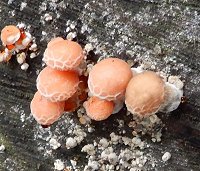
Because of the poor weather I have ignored my favourite woods at Hale. They flood very quickly. I took a chance today, muddy but passable. My first find, on a stack of cut tree trunks, was of Rhodotus palmatus (Wrinkled Peach) on Ash. The fully grown specimens are fairly large pinkish brackets having lost the pretty wrinkly bits. A pair of Grifola frondosa (Hen of the Woods) in their usual place under an Oak tree. Sadly past their best. Most of my finds were on wood. Three separate sites of Pleurotus dryinus (Veiled Oyster). The rest of the area was inhabited by ring after ring of Clitocybe nebularis (Clouded Agaric), hundreds of them.
Saturday 19th October 2019

A return to Freshfield Dune Heath, this time with Liverpool Botanical Society. We added some interesting species to the list from two weeks ago. Firstly a brain fungus, Ascotremella faginea on a fallen branch. New one for me. Myxomphalia maura was recorded on an old bonfire site together with Coprinellus angulatus. An interesting find of Aleuria aurantia (Orange Peel Fungus) was compared with the much smaller Neottiella rutilans which was in moss only a few yards away. The Neottiella is the same coloiur of orange, the differences being in the size of fruitbody, the fact that the Neottiella has a stem and also the shape of the spores. None of these species were there on my last visit of two weeks ago.
Friday 18th October 2019
I was out very early on the golf course, before the mowers went out. On the first hole was a huge Agaricus arvensis (Horse Mushroom). Into my bag it went. Next hole some more. But also a lot of Agaricus xanthodermus (Yellow Stainer). It certainly confused my playing partners as to why I picked some but left the others. The last hole produced a couple of Agaricus augustus.(The Prince). They all made a lovely soup. I did also collect Mycenas flavoalba (Ivory Bonnet) and olivaceomarginata (Brownedge Bonnet) and Leccinum versipelle (Orange Birch Bolete) which I had not seen on the golf course for many years.
Monday 14th October 2019
No rain. Golf. The fungi were everywhere. Even my playing partners became interested. Highlights were a large patch of Clitopilus prunulus (Miller) and two huge Amanita excelsa. One was 12cms across. Both had lost their spots so had me fooled until I got them home under a microscope.
Sunday 13th October 2019

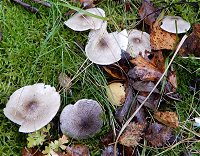
A foray for beginners with North West Fungus Group at Moore Nature Reserve near Warrington. Althought the rain held off it was very damp and muddy. Compared to other sites it was a struggle to find a good variety and number of specimens for our beginners. A large group of Tricholoma sacplturatum (Yellowing Knight) to start us off and two large Geastrum triplex (Collared Earthstar). Bits and pieces after that including an interesting Macrotyphula fistulosa var. contorta (Pipe Club) on a fallen branch. The best collection was brought for us to identify by one of our guests who had raided his neighbours gardens. We should arrange a foray at his place.
Friday 11th October 2019


Terrible weather. Golf course closed. The sun came out so I went to my allotment but too wet to dig (it is now digging season). I went to a local park, actually a Garden of Remembrance for the crematorium. There is a stand of three Cupressus and a dead stump. I always have a look to see if the Lepiota ochraceofulva has returned. It had and now also occupies another stand of Cupressus nearby. As I was looking, I saw this tiny Geastrum which is not G. striatum which grows with Cupressus in another part of the site. Sac stemless, 1.5cms across x 1cm high. No sign of a beak. Seven rays flat to ground 3.5cms across, curling tightly over the sac when dry, hygrophanous - uncurling again when damp. Spores 5-6um excluding warts. My conclusion is Geastrum florifirme. Only 39 records on the old database.
Sunday 6th October 2019




I led the North West Fungus Group foray to Freshfield Dune Heath. An excellent day and it did not rain. A good start just walking past the houses on the way to the Heath. Psathyrella spadicea (Chestnut Brittlestem) which I could identify having found it in Liverpool on Wednesday. It is not brittle at all, quite chunky. The cystidia are unusual as they have 'little wigs'. Then a very small Agaricus. It was Agaricus comtulus, not common. It has very small spores. We spent a little time in the mixed woodland before settling on the Dune Heath. Good sightings of Thelephora terrestris (Earth Fan), Rhizina undulata (Pine Firefungus), Coprinellus angulatus on a old firesite (has unusual mitriform spores). Then over to Ainsdale Sand Dunes Reserve which produced a selection of Mycenas and Russulas. And more Earth Fan. Also a beautiful group of Amanita citrina (False Death Cap) that were very citrine.
Saturday 5th October 2019

A walk at Ainsdale Sand Dunes Reserve for members of the public. Everything was in place for such an event. Lots of Amanita muscaria (Fly Agaric), some Leccinum scabrrum (Birch Bolete), Paxillus involutus (Rollrim), something from every Genus in perfect condition. I could not have asked for more. I got a couple wrong but it happens when you have to identify something on the spot, particularly, Cortinarius, Inocybe and Mycena. One I could not identify at the time was Cortinarius torvus (Stocking Webcap), a new species for me and the Reserve.
Friday 4th October 2019


A couple of hours digging on my allotment. It is that time of the year. I went for a quick walk to the local golf club across the road to unwind my muscles. The first specimen I collected was a Lepiota. It took a bit of sorting out. My conclusion is Lepiota boudieri (Girdled Dapperling) but separating it from castanea is not easy. My specimen had no smell. The second collection was one I had not seen before, Psathyrella spadicea (Chestnut Brittlestem). It has unusual cystidia which made it easy to identify. But it is quite chunky and is unlike other Brittlestems I have seen. Nothing brittle about it.
Thursday 3rd October 2019

Golf this morning. Still not many fungi about. Constant grass mowing to blame. A very large Russula rosea on the grass verge of the car park is a first for the site. Most interesting was a group of 'brown jobs', Psathyrella corrugis. With them were some 'white jobs' that could be mistaken for Mycenae. They were sterile Psathyrellas, given the title of corrugis forma substerilis, though not accepted as a separate species. They have the same cystidia but there are no basidia and no spores. Some of the other Psathyrella produce similar fruibodies and I am told you can get the same with Hypholoma fasciculare (Sulphur Tufts).
Sunday 29th September 2019

Another visit to Dibbinsdalde. This time with Merseyside Naturalists. After a few days of solid rain the whole area was flooded and our foray was restricted to a very small area on higher ground. Very muddy ground. Lots of Leotia lubrica (Jelly Baby) in the moss. Clavulinopsis helvola (Yellow Club) was everywhere, hundreds of them like a carpet. On the bank of a stream, I identified a Cupophyllus pratensis (Meadow Waxcap). But as it was in muddy soil in oak woodland I took it home to check. All the books and The British Checklist all say that Meadow Waxcap does not grow in woods. It is therefore Hygrophorus nemoreus (Oak Woodwax), a Red Data List species that is often misidentified, like I did. Sadly, I only found this out after I had dissected it and thrown it into the dustbin. I have since been told of another record of Meadow Waxcap in the same wood, so I am not the only one to get it wrong. Sadly we did not photograph it. Missed out there.
Friday 27th September 2019

It stopped raining. I went to Speke Hall in the hope that the weather had been so bad they could not mow the huge North Lawn. It was unmown. Still not a lot growing. Lycoperdon utriformis (Mosaic Puffball). This was one of four different puffballs found on the day, the others were L. pyriforme (Stump), nigrescens (Dusky) and excipuliformis (Pestle). The other species of interest was Leucoagaricus leucothites (White Dapperling) under a stand of Scots Pine. A new one for my records. Then I got one wrong. I found a mass of yellow fungi in a small stand of pine but surrounded by beech. My research resulted in an identification as Rhodocybe gemina. I announced my result. Then a colleague suggested I take a look at Lepista flaccida. More micrscopics, on a section of the cap, where I found clamps on my septa. Very painful. So Lepista flaccida (Tawny Funnel) it is even though it is not tawny nor a funnel.
Thursday 26th September 2019

I identified one of my mystery Lepiotas as Lepiota aspera (Freckled Dapperling). It is large with a cap of 11 centimeters. The final bit I was missing was the hyphae in the cap. They should be like hoops but all I had was sausages. Then I remembered to take a sample from the squamules. The hoops were there and the identification confirmed. Job done.
Monday 23rd September 2019

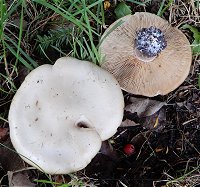
Having seen the weather forecast, I decided to visit Calderstones Park to collect something for me to look at when it rained. And it did. An interesting find of Lepista saeva (Field Blewit) under Yew. The photo shows the berries. It does not look like Lepista nuda. Geatrum was still in the usuaI place but diminished in number to only two. Also found three different Lepiotas (Dapperlings). I have identified one as Lepiota boudieri (Girded Dapperling). But the other two have defeated me and one has a cap size of 11cms. Calderstones has a 1000 year old Oak tree. Tis said that the Ancient Britons held their important meetings beneath the boughs. But surely not. It would have been very little then. Liverpool Botanists tell me it is a hybrid Oak anyway. The only fungus I have ever seen beneath it is Laccaria laccata (Deceiver).
Sunday 15th September 2019


Having been told by the Reserve Manager of Ainsdale Sand Dunes Reserve that the fungi were sprouting in number, Fungalpunk and I paid a visit. The Manager was correct. Russula persicina, an Ainsdale dune specialist that has been seen in large numbers in previous years. Russula velenyovski (Coral Brittlegill). Melanoleuca brevipes (Stunted Cavalier), Entoloma grisrocyaneum (Felted Pinkgill), Clitocybe agrestris to name just a few. We had time to look at some areas of the Reserve that are not on our usual route. We found a new site for Cordyceps ophioglossoides (Snaketongue Truffleclub), a black club fungus that grows on the truffle Elaphomyces granulatus. We counted a couple of dozen. We recorded 113 species from a variety of Genus. Not bad for only two pairs of eyes..
Sunday 8th September 2019

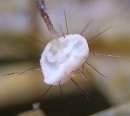

North West Fungus Group foray to Dibbinsdale, one of my favourite sites. It did not disappoint. We easily reached close to 100 species identified on site. My stars of the day were Craterellus cornucopiae (Horn of Plenty) and Marasmius hudsonii (Holly Parachute) with a hairy cap. Also Tomentella fuscocinerea that grows on muddy ground. Not very pretty. My colleagues thought that a dog might have left it and so avoided it. Probably why it is not often recorded.
Saturday 7th September 2019
A wander around Liverpool City centre with Liverpool Botanical Society. I was disappointed that I only found one gilled fungus, Parasola plicatilis (Pleated Inkcap) on a small amenity area. Very interesting plants growing in the cracks in the pavements and on waste ground. Being a major port, a lot of the plants are aliens. I did find some rusts and mildews on plants such as Black Medick and Hoary Mustard. I would never have been able to identify those plants without expert help, which I fortunately had.
Sunday 1st September 2019


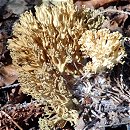

North West Fungus Group foray at Hawarden. Although it was still dry, a good turn out of twenty forayers had collected 80 species by the time I left. I have a few to put through the microscope but most were identified on site. Mainly larger gilled fungi. I only have a couple of Ascomycetes to work on. A good variety, some of which I would not find on my local sites.
Saturday 31st August 2019
Today I attended a course on how to prepare samples of fungi for DNA sequencing. As there are so few academic mycologists about, groups like North West Fungus Group, who collect and identify fungi, are being encouraged to take on the task of submitting specimens to obtain a sequence and compare with other sequences to see if there is a fit. You need a Bento Lab which costs 1300. Then chemicals and test tubes and pipettes and gel etc. in order to prepare a specimen to send away to get a DNA sequence. Then it is compared with others on a database and with a fair wind you might get a positive result if the other database contributions are correct. I have no problem with the mechanics of the system but wonder where it would fit in with my allotment and, of course, my golf.
Saturday 24th August 2019

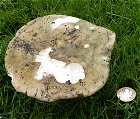
I played golf at Childwall on Friday and recorded nothing. Todays visit to my local golf course and adjoining park produced lots of species, a proper foray. Most of the species were common. A large, green coloured Russula cyanoxantha (Charcoal Burner) was the star, with Russula parazurea (Powdery Brittlegill) and sororia (Sepia Brittlegill), Lactarius pubescens (Bearded Milkcap) and vellereus (Fleecy Milkcap). Also a nice collection of Sceroderma bovista (Potato Earthball) under ornamental conifers.
Wednesday 21st August 2019

Heavy overnight rain so I stayed away from my allotment and went to a couple of my favoured foray sites. The first, Sudley Hall, is usually good for early Russulas Brittlegills). I was not disappointed. Russulas atropurpurea (Purple) and fellea (Geranium), the latter named because of the smell and Lactarius blennius (Beech Milkcap). Also Inocybes (Fibrecaps) geophylla (White) and rimosa (Split). All under beech. On a very muddy lawn I was lucky to spot a group of tiny Tubaria conspersa (Felted Twiglet). You need to check the cheilocystidia to be sure, some of which are polymorphic, a variety of shapes, plump and bent. In the afternoon, I went to Hale Hall. This time I was disappointed. After the morning finds I expected more than lots of Gymnopus confluens (Clustered Toughshank).
Monday 12th August 2019
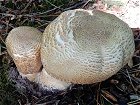
As it has rained, I paid a visit to Speke Hall. It was packed with children so I tried the adjoining Stocktons Wood. No gilled fungi at all. I then went round the fishing pond where I found a solitary Leccinum scabrum (Brown Birch Bolete) and Xercomellus engelii, easily identified by the orange stem base. I went back to another site at Springwood. A few Russula puellaris (Yellowing Brittlegill) under beech. I then came across a decent patch of Agaricus augustus (The Prince) under pine. Also a lone Boletus badius (Bay Bolete). Not much for three hours walking.
Wednesday 31st July 2019


After all the rain, I went for a walk to my local parks. Five different Russulas, ochroleuca (Ochre), fellea (Geranium), grisea (Oilslick), amoenolens (Camembert) and nobilis (Beech Sickener), all under Beech. Patches of Marasmius rotula (Collared Parachute) and Gymnopus confluens (Clustererd confluens). A massive body of Coprinus disseminatus (Fairy Inkcap) at the base of a Sycamore tree. I also came across the dead body of what looks to be, from the protruding tooth, a Muntjac deer in a ditch. An intereresting find in a built up city area.
Tuesday 16th July 2019
Just got back from a week in Norfolk. Mrs. Myko and I went to Sandringham to see the Queen but she was not in. Walked around the extensive garden. Lots of old trees. Not a fungus in sight. Best day was our visit to Norwich Cathedral where the resident peregrine falcons gave a very noisy display. I suspect that their fledglings were about to leave the nest.
Monday 8th July 2019
A few holes of early morning golf. First sighting of Leccinum duriusculum (Slate Bolete). Always one of the earliest to fruit. It favours Populus tremula (Aspen) and is very reliable on my golf course. But this may soon change. The Aspens are gettying old. They are not popular on golf courses as they regenerate by sending up suckers. This makes them more difficiult to manage. They will not be replaced. You might have expected the large Polyporus squamosus to have been broken off by somebody. You would be right. It has been.
Friday 5th July 2019
We could do with some rain. I played golf today. A large patch of Agaricus arvensis (Horse Mushroom) in a sheltered spot but all were too dry to collect fo breakfast. A massive Polyporus squamosus (Dryad's Saddle) feeding on the dead wood of a living Sycamore. The fungus has appeared on the same tree for a number of years. I have not seen a fruibody this big before. A good three feet across. The tree still looks healthy but for how long can it support this fungus? A couple of Conocybe apala (Milky Conecap). And that was all.
Sunday 23rd June 2019
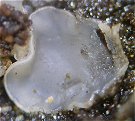

Up early so I went to for a walk through Stockton's Wood next to Speke Hall. Still no gilled fungi. Still upturning logs and collecting dead stems. Some interesting finds. Phlebiella sulphurea (Yellow Cobweb) in the same place as last year. A grey disco Ascomycete that I thought would be a Mollisia is an Orbilia. The paraphyses are distinctly capitate. Probably an Orbilia. I can not key it out so it goes into the mystery folder. An anonymous looking resupinate turned out o be Tomentella sublilacina. The spiny spores give it away.
Thursday 20th June 2019
Things are starting to grown on my golf course. A mass of Psathyrella candolleana (Pale Brittlestem), presumeably from remains of felled trees. Some grassland species, Conocybe apala (Milky Conecap) appeared after the heavy rain. The problem species was a large Xerocomus type bolete, found under a newly planted copper beech in the middle of a pine area. When cut in half the colour change suggested Boletus chrysenteron but there was no red in the cap at all. I gave in.
Sunday 16th June 2019

Spent all morning on my knees weeding my onions. So in the afternoon I went for a walk to my favourite woods at Hale. After the heavy rain, everything has grown quickly. So not a lot to see but enough fungi to be interesting. Phallus impudicus (Stinkhorn), Gymnopus dryophilus (Russet Toughshank) and Mycena acicula (Orange Bonnet) which is new for the site. Lots of Scihzophyllum amplum (Poplar Bells). This seems to be a good site for this species. A collection of dead stems proved fruitful but I have not yet found anything unusal on them.
Monday 10th June 2019



Just popped out for a walk before rain starts again. Found some Panaeolina foenisecii (Brown Mottlegill) in grass. I picked one to check. There was a small pile of leaves and tiny twigs beside them. I noticed a tiny white disco (Lachnum virgineum) on a twig so picked it up. A quick rummage around produced a disco on a Sweet Chestnut leaf (No idea what it is). At the very bottom of the pile was a soggy, disintegrating Blackberry leaf with something tiny so into a box it went. Under a microscope this leaf had two white cylindrical fruit bodies, a number of orange? ones and lots of yellow dots. Spores were a nightmare because the leaf had lots of different spores on it. But I found a basidia. I took a guess at Typhula but could not match any spores with a white or orange species. So I took lots of pics and went for a cup of tea. When I came back my two white ones had turned pink. So I have identified them as Typhula micans which has been found on Rubus. Spores also fit. I assume the orange ones are the same. There is a similar orange pic on Google but one has to trust that the person who took it got the identification right. Amost had me typhooled.
Wednesday 5th June 2019
At last. A gilled fungus on my golf course. A lone Amanita rubescens (Blusher). Quite early but I have recorded them in late May. Hopefully, after the heavy rain on Tuesday, I might start to find some more.
Saturday 1st June 2019
I have had nothing to report recently. It has been so dry. A smattering of rain tempted me to see if anything had grown. All I noted were large numbers of Polyporus squamosus (Dryad's Saddle), one Volvariella gloiocephala (Stubble Rosegill) on a pile of fresh woodchip and some Peziza micropus on a fallen tree. I dried my Entoloma aprile from April and sent it to Michael Noordeloos in The Netherlands. Will he agree with my identification?
Tuesday 7th May 2019


Rain forecast so I took the opportunity for a whizz round Speke Hall. I found two rings of Calocybe gambosa (St. George's Mushroom), a species that has not been prolific locally this year. Late too. Nothing else but a few Ascomycetes on dead stems. Then it started to rain so I went home. And had a look at the bits of Himalayan Balsam from my previous excursion. Not much literature about fungi that can be found on this plant. I located two species growing together that I have identified as Hyalopeziza millepunctata and Pyrenopeziza atrata, the latter seemingly attacked by a hairy parasite fungus which made identification complicated.
Sunday 5th May 2019

I am wearing in a new pair of golf shoes so went for an early morning walk round my local nature reserve. It rained on Friday so I was hopeful. Success. A good number of Calocybe gambosa (St Georges Mushroom) in the woods. First I have seen this year. I also found an Entoloma aprile (April Pinkgill). This looks very like the more common Entoloma clypeatum (Shield Pinkgill) which also grows in spring. A chemical test with guaiac turns aprile blue/green. I tested it. It did. I also found two tiny Ascomycetes species on Himalayan Balsam. Probably the same as grows on other dead stems but I will have to wait until they grow a bit bigger before I can take specimens.
Saturday 4th May 2019
As rain was forecast last week, I applied some weed and moss killer to my lawn. It did rain. The application did work. I now have a healthy flush of a dozen Entoloma sericium (Silky Pinkgill) . It is growing in the area where the moss has now died. A quick wander round my garden also produced Coniothyrium hellebori, a leaf spot on my Hellebores.
Tuesday 30th April 2019


Rain at last. I went to one of my favourite woods in the hope that something might have grown. I did not find a single fruitbody. Not even a Sulphur Tuft. I did collect a lot of dead stems. I came across a patch of Arctium (Burdock) which I have not examined before. Trichopeziza leucophaea (now a Lachnum) and Lachnella villosa on the stems. The nettle stems produced a lot of species. All the typical Ascomycetes except one that made me work. Usually, orange discs on stems are Calloria neglecta (Nettle Pox) but this one looked slightly different. This one turned out to be Laetinaevia carneoflavida. The differences between the two are minimal. Same size spores, similar paraphyses, only a chemical test with iodine confirmed the identification.
Sunday 14th April 2019



I attended the North West Fungus Group foray at Rixton Claypits, near Warrington. It was very cold and dry. A good start with the remains of a very large Langermannia gigantea (Giant Puffball). How did it last so long. Because of the dry weather, the day was spent looking under logs and delving into piles of sticks. We did find a good number, it was over sixty when I left. A few Polypores such as Gloeophylum sepiarum found on some wooden steps but mainly it was tiny Ascomycetes, spots and rusts. Some of these are hard to identify because of the difficulty in extracting microscopic material embedded in plant material. Lots of broken cover slips.
Saturday 30th March 2019

Another mission to Ainsdale to find black morels for Kew Herbarium. Eight of us set off across the dune heath to the distant slacks. It has been so dry. There were very few fungi about. At the usual site we found ten black morels. We were given coordinates for another site where we counted twenty-four more. The only other fungus we found was a Cheilymenia on some cow dung. On the way back we collected a few resupinates and disco fungi from bits of dead tree but there was nothing else. Specimens are now drying. The question is - are these the same as the Morchella purpurascens we found two years ago? They were very brown.
Thursday 28th March 2019

I decided to empty my black plastic compost bin. It had three feet of material which had been maturing for over a year. More useful on my garden. When had almost reached the bottom, I uncovered a group of very large Agaricus bisporus (Cultivated Mushroom). The largest was 16cms across and the total weight was 0.78kgs. They were fresh but just gone over. My wife did not fancy them for tea. I do add mushroom peelings to the bin but never expected to find fully grown specimens resulting from this. Keep them in the dark and cover them with???
Sunday 24th March 2019
Gardening at home today. Lawn needed cutting, Dead plants to remove. Entoloma sericium (Silky Pinkgill) on my mossy lawn, Lepista nuda (Wood Blewitt?) round my compost bin. A worrying collection of Crepidotus mollis (Peeling Oysterling} on my largest flowering bushes. Probably doomed. A better foray than yesterday at Eastham?
Saturday 23rd March 2019
I got it all wrong today. I went to join the Merseyside Naturalists at Eastham Woods for a bird and fungi foray. Wrong day. It is on Sunday. So I forayed on my own. Not one of my favourite woods. I took a couple of public forays there a few years ago. It was so poor, I took specimens from my golf course just to give it a start. Today it was very dry. Then the sun came out and the wood filled with people, their children and their dogs. So I went home. I found not very much and nothing unusual.
Saturday 16th March 2019

Last Sunday it stopped raining for a few hours. So I took advantage and went for a walk in my local nature reserve. No fungi. Just lots of mud. I looked at a few dead stems but there was nothing showing. I stuck some nettle stems in my bag and took them home where I put them in a damp box. It only took until Monday morning for Calloria neglecta (Nettle Pox) to appear. Today I have large crops of Cyathicula cyathoidea and Periconia byssoides. But the stems are starting to go mouldy so I do not expect anything else will appear.
Saturday 23rd February 2019

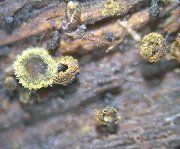
The North West Fungus group AGM at Risley Moss. After very intereting talk about DNA and problems species given by our President, Geoffrey Kibby, we went for our usual post prandial walk round the Reserve. We recorded 34 species which is not bad for the time of year. Nothing special. The usual fruiting of Sarcoscypha austriaca (Scarlet Elf Cup). Geoff Kibby and a couple of others said that they never see it in their particular areas and were surprised by the number of fruitbodies seen on all sorts of substrate. The only other find of note was of Neodasyscyphus cerina on the inside of a split in a fallen branch. There were also four other species on the same piece of wood.
Friday 15th February 2019


A week ago I collected a hogweed stem which was growing black lesions that looked like fungi. I got nowhere so put it in a damp box to see if it would produce some spores. I forgot about it. A week later, my hogweed stem has grown some white spherical fruit bodies that I thought might be a slime mould. However the spores have unusual hairlike appendages (click on the image of the spores above for a larger picture). I found it in one of my books. It is Chaetospermum chaetosporum. The National Database has only 20 records, none on hogweed. Not surprising if you have to stick it in a box for a week. Easy foraying. Pick some stems and put them in a box.
Sunday 10th February 2019

No horse racing on TV so I went for walk round The Eric Hardy Reserve. They have been doing lots of work clearing the undergrowth. I hope they leave the branches on the ground for my future examination. Chances are they will burn it. Two more big trees down so they will do for the future. So much new wood has been blown down by Storm Eric. Difficult to select what to look at. One dead tree caught my eye. It was supporting a good group of Phellinus pomaceus (Cushion Bracket). Said to be common, especially on Prunus. Although we have lots of cherry trees I rarely see this species.
Friday 8th February 2019

Another nice day so I visited Childwall Woods. I only seem to go there in the winter when it is quieter, not so many dogs and yoofs. Apart from Flammulina velutipes (Velvet Shank) all my finds were from fallen branches and larger bits of tree. All the usual polypores and corticioids that are common at this time of year. My best find was of the Ascomycete Eriopezia caesia. I thought it was another Lachnella but the microscope showed asci. Nor was it the common Mollisia. Goes to prove that it is not possible to identify these tiny species without a microscope.
Friday 25th January 2019



Another visit to Speke Hall to take advantage of nice weather. I found a lot more Lachnella alboviolascens and in the same small patch I also found Lachnella villosa, both on hogweed stems. One on a twig that proved difficult to identify was Basidiodendron eyrei. It has very small round spores and unusual basidia but there is very little literature on this Genus. Most interesting was a Diatrype on a piece of bark. I could not find any spores first time round so put it on some damp paper overnight. A scrape produced a long thin spore that I identified as Lylea tetracoila. Under my micrscope I could see the silvery hair like structures. But I also saw a small red fruitbody. Overnight on paper again. More scraping revealed spores for Diatrype stigma so the red one is Dialonectria episphaeria. Three for One. Better that Tesco. You need to be patient with these winter fungi.
Friday 11th January 2019


Weather still holding so I went to Speke Hall today. My first find was Resupinatus trichotis. The same as Resupinatus applicatus (Smoked Oysterling) but it has hairs where the fruitbody connects to the substrate. You can usually see the black area on the top of the fungus but need a decent magnifier to see the hairs. Seems to be a lot of Resupinatus about so trichotis is worth looking out for. On a rotten fallen branch, I thought I had found Vuilleminia comedens, a thin waxy crust fungus. I took it home to check the spores which should be like large sausages. But not this one. I have identified it as Sebacina epigaea. The fungus is barely visible but the spores and basidia are the same as Exidia or Tremella. Same family. First time I have found it. Always worth checking even if you think that you know what you have found. You just never know. A large patch of dead stems from all sorts of plants was covered with the tiny Lachnella alboviolascens. Now seems to be the time to look for it.
Wednesday 9th January 2019
Still good weather so I visited another Liverpool park, Otterspool. Very disappointing. No Ascomycetes, a couple of the most common gilled fungi and a few crust fungi. One crust fungus puzzled me. I narrowed it down to Hypochnicium puntulatum but the spores are only 5um which is too small. My literature tells me of a smaller spored species, Hypochnicium cremicolor. Only a few records but it was only identified in the 1980s. Why a new species is identified because it has smaller spores is a mystery to me. Why not punctulatum with a wider spore range? Hopefully DNA will provide the answer.
Saturday 5th January 2019

Another visit to Calderstones Park. An interesting site as it was bought by Liverpool Council from one of the founders of the Cunard Line. He imported trees from all over the world, especially pines from the Americas. Despite the freezing cold weather, I put together a good collection. Pholiota gummosa (Stick Scalycap), Peziza repanda (Palamino Cup) and an interesting Ramaria decurrens (Ochre Coral). According to Kew, this may be Ramaria curta. It seems most of the specimens they hold turned out to be this. But as I have no literature about curta, I shall keep the name as I identified it. It has smaller spores than the common Upright Coral. There were hundreds of Geastrum triplex (Collared Earthstar) in the shrubberies and almost every fallen beech tree had Schizophyllum commune (Splitgill). Although I have a list of the trees, I only know where a few are. There is one I always check and this time found Bjerkandera adusta (Smoky Bracket). The fungus is common. The tree is Polyepsis australis from the Andes.
Friday 4th January 2019
The mysterious orange thing has not been resolved. The Group experts on rust fungi say it is definitely not a rust. I delved into my books again and the only fungus I can find that is red/orange with spores like mine is a truffle, Paurocotylis pila. But if it is, what happened to the rest of it? Did a squirrel eat it? Did someone stand on it? I went back to see if I could find some more but no luck. Another one for the unidentified mystery folder.
Monday 31st December 2018


The final hurrah. An hour in a local park. I picked up an old oak leaf which had a orange thing on it. Looked like Aleuria aurantia (Orange Peel Fungus). When I put it under my microscope, the spores looked like those of a rust fungus. Nothing like it in my books. I asked my colleagues for help. Nobody can say what it might be. So I end the year with a mystery.
Saturday 29th December 2018
As the weather was still holding up, I visited Stocktons Wood next to Speke Hall. My previous records show that this is a good site at this time of the year. But, like my walk on Xmas Eve, it was a disappointment. A few small Mycenas (Bonnets) but no Ascomycetes at all. I found only two Rhodocollybia butyracea (Butter Cap) whereas a couple of years ago I recorded hundreds. I wonder if the warm weather and lack of frost has affected the fungi. Is it because many things are still in growth and not yet dying off or, like plants such as blackcurrants, rhubarb etc., they need a period of cold to stimulate them?
Monday 24th December 2018

All my jobs done. A sunny day. So I went to the woods at Hale. It was very muddy as the recent heavy rain has filled the ponds and streams. I was disappointed. Very few gilled fungi. Some tiny Mycenas, including corynephora, metata and polyadelpha, the last one is very tiny and grows on oak leaves. No Ascomycetes, just a selection of crust fungi. I took a few home to examine under my microscope. I had four white things that looked the same but were all different. Xylodon sambuci (Elder Whitewash), Hyphodontia arguta, (on a dumped Xmas tree), Subulicystidium longisporum, (clue is in the name) and Phanerochaete velutina (with spiny spores). Nothing unusual but these species can not be identified without microscopic examination.
Thursday 20th December 2018

Rain yesterday. Rain promised for the future. I decided that I should take a look at the local Eric Hardy Reserve. The usual path was impassable, a swamp. So I tried a small wood on the opposite side of the stream, slightly higher ground. A few small species including Mycena speirea (Bark Bonnet). No Ascomycetes at all but the fallen trees and branches provided a selection of bracket and crust fungi, not as many as I had hoped for. A lot of Basidioradulum radula (Toothed Crust). The most interesting find, I could not identify until I had a look at it under my microscope. It was a new species for me, Eichleriella deglubens (Blushing Crust). My specimen was more rusty than blushing.
Wednesday 12th December 2018
Golf today. There was some fungal life. A large growth of Coprinopsis atramentaria (Common Inkcap) on some buried wood. A Cortinarius species but it was featureless. Not even a cortina. Just anonymous brown. So I gave up trying to identify it. Pity as I rarely see a Cortinarius on the course. The Greens Committee have decided to strim nearly every piece of woodland to make it look tidy? All the fallen branches are being burnt. They have invited the RSPB to advise as to how they can encourage more birds on to the course???
Sunday 9th December 2018

One of my fellow allotmenteers keeps a rain measurement gauge and passes his records to the Met Office. Liverpool (his garden) has recorded 45mls in the past three weeks. Taking advantage of a break in the weather, I did a quick spin round some of my local parks. Still a few fungi about, mainly bonnets. I did find both Lachnella alboviolascens and Episphaeria fraxinicola in the same patch of dead stems. Best find of the day was of Crepidotus carpaticus on a recently fallen tree. It being brown I almost dismissed it as a Melanotus until I looked at the spores which were round and elliptical.
Friday 30th November 2018


I paid a visit to the local Eric Hardy Nature Reserve, a deep gully with a stream at the bottom. The stream frequently over flows. Muddy is an understatement. Apart from keeping the path open, no maintenance is performed. So there are lots of fallen trees, branches, twigs. I filled my box within the first hundred yards. It was too muddy for me to go further even with my wellies on. Lots of little fungi, Ascos and resupinates under the logs and debris. Good collections of Mycena stylobates (Bulbous Bonnet), Roridomyces rorida (Dripping Bonnet) and Mycena speirea (Bark Bonnet). I am still battling with the corticioids. Best find of the day was Henninsomyces candidus, like dust, the tiniest Basidiomycete I have ever found.
Saturday 24th November 2018
I met up with Merseyside Naturalists at Lunt Meadows Nature Reserve, an area of wetland and flood plain around the River Alt. Part of it was a refuse tip which has been taken under the wing of The Forestry Commission. So the tree plantings are fairly new. My day started in the graveyard of St. Helen's Church in Sefton, an ancient burial ground. Melanoleuca polioleuca (Common Cavalier) and Tricholoma ustaloides (Charred Knight) were recorded. The rest of the day in the new woodland was as expected. A mix of small Agarics and Corticioids on fallen wood. The only one of interest being Mycena galopus var. candida (White Milking Bonnet). Not one I see often. Most of the Corticioids defeated me as I could not extract any decent microscopic material for a positive identification.
Sunday 18th November 2018
Another sunny afternoon so I took a quick stroll through the woods at Hale. Lots of Mycena inclinata (Clustered Bonnet) and a large group of Leratiomyces ceres (Redlead Roundhead) under a pile of rotting twigs. Looked under a few logs but nothing special to be seen. Best find was Crepidotus caspari (ex lundellii) under a large fallen branch. I took a photo but found it was out of focus.
Friday 16th November 2018 [Click on the images below for a larger picture]


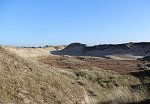
Oh what a beautiful morning. Not to be missed. I set out for Devil's Hole on the Ravenmeols Sandhills Reserve. This a large dune blowout. Some say it was caused when a German bomber attacked a nearby lookout post. Whatever the cause it is a large crater. Usually a wet slack, because of the dry summer it was only damp. I found no fungi on my walk there but the bright sun was in my eyes. Quite a few fungi on the slack. A small patch of Tricholoma singulatum (Girdled Knight) and lots of fruit bodies that I have recorded as Inocybe squamata and Hebeloma gigaspermum. Neither is rare but perhaps restricted by habitat. On my way back, with the sun behind me, I collected a number of species, the most interesting being Steccherinum fimbriatum, on the underside of a rotting branch. The records show it as common but in southern England. Another example of a warming climate?
Sunday 11th November 2018
I went for a walk to a local park. No large fungi to be seen so it was back to poking in the undergrowth and looking under logs. I collected a few Crusts and Brackets. Included was a Postia leucomallella, one I have not identified before. Most of my Postias turn blue. This one has brown colouring. It was not on conifer which is not in this wood. It differs from the Postia fragilis I found on Pine earlier in the year, which stains brown when touched. While searching, I turned over lots of leaves and litter to discover that underneath were dozens of Marasmius setosus. They are very tiny but fortunately have distinctive microscopic features.
Friday 9th November 2018
I played golf this morning. Apart from a few Russula fragilis (Fragile Brittlegill) and a Mycena olivaceomarginata (Brownedge Bonnet), there were no other fungi to be seen. I was asked by some of the members who know of my interest if it was a bad year for mushrooms as they had not seen much on the course either. As we seem to be finding good numbers on our forays, I can only think that it is the course maintenance regime, which involves almost constant mowing with modern machines that can get close to the trees that is not giving time for the fungi to grow. If I should start to play golf badly and there are no fungi either, I may have to resign.
Wednesday 7th November 2018


I paid a visit to Speke Hall. There is a huge lawn in front of the hall that is usually excellent for small grassland fungi, waxcaps, pinkgills, bells and bonnets. But today was very disappointing. Hygrocybes virginea (Snowy Waxcap) and pratensis (Meadow Waxcap), Mycena aetires (Drab Bonnet) and Galerina clavata (Ribbed Bell) were the only ones on show. I recorded a few bits and pieces from the surrounding woodland, including the Ascomycete Hypocrea aureoviridis (Cushion). I believe this may have been redesignated as a Trichoderma?
Tuesday 6th November 2018
I have at last finished my microscope work on the fungi from the Formby foray. The final total is 81 species. A quick walk to a local park to see if Lepiota ochraceofulva had returned under a small copse of leylandii. It had but in smaller numbers than last year. Another reappearance is of Arrhenia retiruga (Small Moss Oysterling) on my back lawn. Nice find but as it grows in moss it does not say much for my lawn.
Sunday 28th October 2018

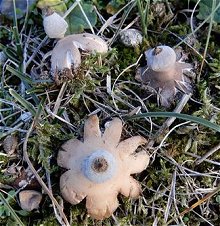
I was leader for the North West Fungus Group foray at the National trust sites of Ravenmeols and Lifeboat Road, Formby. Sixteen forayers searched a variety of ecosystems that included sand dunes, pinewoods, coastal scrub and coastal grassland. Something for everyone and a wide range of fungi were recorded. About ninety species were recorded which, with a bit of rain and warmth, could have been better. Specialist dune fungi were the most interesting, such as Arrhenia lilacinicolor (Dune Navel), Omphalina subhepatica and Lycoperdon lividum (Grassland Puffball). An uncommon Agrocybe litoralis on the dune grassland and lots of Geastrum schmidelii (Dwarf Earthstar), Macrolepiota mastoidea and Melanoleuca excissa (Smoky Cavalier) in coastal scrub woodland. And the weather was fabulous.
Friday 19th October 2018
A beautiful morning so I decided to go to the Devil's Hole at Ravenmeols Reserve. It is a huge dune blowout with water filled depressions which act as breeding ponds for Natterjack Toads. It proved to be quite a hike through the dunes. Not a lot of fungi. A few Tulostoma brumale (Winter Stalkball) and Lepiota erminea (Dune Dapperling) but mainly Marasmius oreades (Fairy Ring Champignon) everywhere. Back at Lifeboat Road, I had a scout round as I am leading there next Sunday. Still very dry. Nothing on the dune grassland. The best area was scrub woodland where a variety of fungi were recorded, the most interesting being Macrolepiota mastoidea (Slender Parasol). This is very hard to split from the very similar Macrolepiota excoriata. I looked at seven different authorities and the spore sizes and cystidia were differently described in every one. Very little consistency. So I had to pick the fungus that had the most positive elements.
Sunday 14th October 2018


I had three forays I had to choose between this weekend. Eastham Woods on Saturday but the weather was so horrendous with heavy rain and high winds, that it was not feasible. Eastham is not one of my favoured sites for fungi. I used to take a public walk for the rangers. It was always a struggle to find specimens. Sunday was a choice between the top of the Pennines at Turn Slack or a warm valley at Dibbinsdale to where I can catch a train. Decision made. Difficult to find decent specimens after the heavy rain and heavy leaf fall. We recorded 50 specimens before we called it a day. Augustus agaricus, which was lovely in my omelette on Sunday morning. Pholiota leoninus (Lion Shield). And a magnificent Grifola frondosa (Hen of the Woods). Only five attended. I am sure we would have done much better with more eyes as this is a very good site.
Wednesday 10th October 2018
Golf. Still nothing much growing. A group of Lacrymaria lacrymabunda (Weeping Widow) has joined the Pholiota gummosa by the side of one of the teeing areas. At last, a small group of Leccinum duriusculum (Slate Bolete) has appeared under Populus tremula (Aspen). Usually, nearly every Aspen has supported this fungus. But not this year. Weather or maintenance? I do not know.
Tuesday 9th October 2018


One of the specimens I brought home from the woods at Hale surprised me by turning out to be Schizophyllum amplum (Poplar Bells). Described as near threatened Red Data List, I seem to find it on most local sites. Kew told me that the north west coastal woods are perfect habitat and we also have a lot of (Populus nigra) Black or Manchester Poplar. I usually find it on tree prunings or after gales when the brittle ends of branches blow down. All my finds have been on thin branches. It looks like a small Auricularia so perhaps it is ignored. I walked home through one of my local parks today. Dry as a bone. All I saw was a mass of Coprinellus disseminatus (Fairy Inkcap). Very impressive.
Saturday 6th October 2018
International fame at last. Today I was contacted by a Master of Sciences in Biogeosciences from Switzerland. He wanted more information about Morchella pupurascens following my recently published article in Field Mycology. So I sent him all I have. Not sure what use it will be as he is not going to find a site like Ainsdale Sand Dunes in Switzerland.
Friday 5th October 2018

I have been so busy that i have not been to look at some of my favourite local sites.Today I went to Hale, next to Liverpool Airport. Usually very wet, it was surprisingly dry. I did not need my wellies. I found a number of species but nothing particularly special. The management had been clearing up fallen trees which had been cut and stacked, probably awaiting a woodchipping machine. Masses of Ramaria stricta (Upright Coral) was growing in and under these stacks. A lone Clitocybe nebularis (Clouded Agaric) had appeared which I thought is a bit early.
Monday 1st October 2018
A cold and foggy morning on the golf course. Things starting to grow at last. A couple of Agaricus augustus (The Prince) and a large group of Pholiota gummosa (Sticky Scalycap) in places the mowers can not get at. Hopefully the damper weather will slow down the course maintenance and allow more species to come through.
Saturday 29th September 2018

I was joined by a friend from Cheshire Fungus Group, Dave Higginson-Tranter for a mooch round Croxteth Patk in Liverpool. Once the estate of Lord Sefton, it was purchased by the Council. A lot of it has disappeared under new housing but there is still a very large acreage of woodland and water to wander around. Not a site I visit often having not previously been impressed with the fungi. Dave had been before and had a similar opinion. I know my way round so was able to identify the most likely areas and so it proved. We identified 115 species, lots of fruitbodies, in the three hours we searched. Highlights were Oudmansiella mucidas (Porcelain Fungus), a rarity in Liverpool. One of the woods produced six different Russulas. A species of interest and new to me was Postia fragilis, which turns orange brown when bruised.
Thursday 27th September 2018


Nice afternoon. Had to go to B&Q which is close to Speke Hall, so I decided to spend a couple of hours there. People everywhere, so I decamped to the adjacent Stockton's Wood. It was very dry. The ditches, usually full of water were empty. It allowed me to get to parts I would not normally be able to visit. I struggled to find anything to begin with but suddenly I was inundated with fungi. A couple of Inocybes I have identified as Inocybe flocculosa (Fleecy Fibrecap) and napipes (Bulbous Fibrecap). Most impressive find was an Inonotus, I think radiatus on a fallen tree, oak? I am waiting for confirmation.
Wednesday 26th September 2018

After a fruitless morning on the golf course, in the afternoon I went for a quick walk around my local sites. A newly constructed bank of earth had hundreds of Lepiota cristata (Stinking Lepiota) mixed with Agaricus xanthodermus (Yellow Stainer) growing on it. Neither unusual species but the numbers were astounding. Another area where I expect to find Russula virescens (Green Russula) under the beech trees, instead supported Russula cyanoxantha (Charcoal Burner) and Russula nobilis (Beech Sickener). Also two massive Boletus luridiformis (scarletina Bolete).
Saturday 22nd September 2018

I led a public walk at Ainsdale for the Reserve Manager. About 15 turned up including five children about ten or eleven years of age. What enthusiasm. And they have the advantage of being closer to the ground than I am. They were all over the place and we recorded 42 species in ninety minutes. Speed Foraying? The finds included Cystolepiota pulverulenta, a rare species. Interestingly this species was recorded on a corresponding public walk in 2013, only one hundred yards away. This suggests it has made a permanent home there. I must keep this area under observation on future visits.
Sunday 16th September 2018



I led another foray. This time to my favourite hunting ground, Ainsdale Sand Dunes Nature Reserve. I poured with rain when we started so I stuck to the woods. An interesting start with a small Basidiomycete on a rabbit dropping. I took it home. Disappointingly it was Panaeolus fimicola (Turf Mottlegill) but the substrate is interesting. I had been told that there was not much fungi around but, after two hours, we had got no further than two hundred yards at most. Lunchtime at the site of Tolypocladium ophioglossoides (Snaketongue Truffleclub) where we also found Rutstroemia sydowiana on the stem of an oak leaf. It stopped raining so we continued to more open dune grassland bordering the pinewoods. A recent fire produced a few burnt ground specialities such as Anthracobia. Fallen pine cones were inhabited by Crucibulum laeve (Common Birds Nest). Saving the best till last, on the way back to the car park, the final discovery on a rotten bough was Clitopilus hobsonii. We recorded 76 species on site with lots of boxes to take home. Already two new species for the Reserve. Ainsdale never fails to surprise.
Sunday 9th September 2018


North West Fungus Group foray at Wigan Flashes, a site new to me. The flashes are ponds caused by coal mining subsidence now replanted as nature reserves. Fungi were plentiful. We started with Leucopaxillus giganteus (Giant Funnel Cap), the third site for this in recent weeks. There were lots of Inocybes (Fibrecaps), Leccinum versipelle (Orange Birch Bolete), Mycena pseudocorticola, Mycena stylobates (Bulbous Bonnet), Lactarius pubescens (Bearded Milkcap), Lactarius pyrogalus (Fiery Milkcap) which I made the error of testing by taste - it is fiery. Postia subcaesia (Blueing Bracket) is not much better. Someone has to do it. I concentrated on smaller species and Ascomycetes. Another collection of Lachnella villosa , this time on Pastinaca (Wild Parsley). I have not yet seen what the other forayers identified, Between us we should have a good number.
Thursday 6th September 2018

A quick visit to my nearest park, Calderstones, named after a set of standing stones. A few fungi about but just the usual suspects, Coprinellus micaceus (Glistening Inkcap), Lacrymaria lacrymabunda (Weeping Widow). The park also has 'The Allerton Oak', said to be 1000 years old. My botanist colleagues tell me it is a hybrid oak, despite it's age. I had never before seen a fungus growing with it, but today there were a number of Russula parazurea (Powdery Brittlegill) and Laccaria laccata (Deceiver). So nothing exciting but at least there were fungi to be found.
Wednesday 5th September 2018
I was inspecting the moss patches on my back lawn this morning and found one Rickenella fibula (Orange Mosscap) and four Rickenella swartzii (Collared Mosscap). Off to golf this afternoon where I recorded two lots of Polyporus squamosus (Dryad's Saddle). One has been growing on the same tree since 2010. It is a tree that was damaged early in its life as it grew two trunks. One has the fungus the other is fine. Also one Leccinum scabrum (Brown Birch Bolete). Things are looking up. The final total from Friday's bioblitz at GreenAcres is 115. Not bad.
Friday 31st August 2018

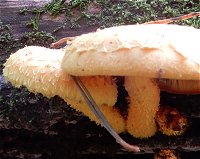
An interesting day. I joined a bioblitz at GreenAcre, Rainford which is a woodland cemetery. A good mix of broadleaf and pine with a couple of meadows thrown in. I joined up with lots of local naturalists who I have known for years. The fungi group was me, John Watt and Dave H-T, leader of Cheshire Group. A powerful team. We easily hit the hundred mark. Finds include Pluteus hispidulus, Crepidotus carpaticus, Pholiota flammans (Flaming Scalycap), Physisporinus vitreus, Dialonectria episphaeria, Parasola kuehneri, Ganoderma pfeifferi (Beeswax Bracket), Mycena pearsoniana, lots of Ascomycetes such as Psilachnum pteridigenum (on bracken) and various rusts. Each of us has a speciality so together we can cover a lot of species.
Monday 27th August 2018


One I have not seen for a long time appeared at The Eric Hardy Nature Reserve in south Liverpool. I was poking about in some undergrowth when I was accosted by a man with a dog who told me about some large white mushrooms. Following his directions I came across a very large ring of Leucopaxillus giganteus (Giant Funnel). I counted at least fifty covering a wide area. Mainly in a thicket of blackthorn, so hard to get at, with some having spread through broadleaf woodland twenty yards away. I measured the largest I could reach at 32cms. Both macro and micro features need to be checked carefully because Clitocybe geotropa and Lepista panaeolus are also large, can look very similar and grow in rings.
Friday 24th August 2018
It poured with rain this morning so I went out, armed with my knife to cut a piece off that Ganoderma. I took my camera and pretended to be a council worker. It was hard work to get at the pore layer. I have looked at the spores and my interim conclusion is Ganoderma resinaceum. The spores are in the middle lengthwise, mostly 10-11um. Only one at 7.5 wide was above 7 with a couple at 5um. The average is 10.7 x 7um. These are not easy. I might have a better idea in the winter when the wax layer forms and the smell of Ganoderma pfeifferi is said to be sweet However, looking at the top of the tree, the canopy looked very poor compared to it's neighbours, so I have reported it the the Council. If it falls, it either hits the road or the adjoining houses. Someone was recently killed when a tree, just around the corner came down in a gale. My allotment is just up the road and a beech came down last year and destroyed a telephone pole, and roadside light and tore out our water supply. So I did my civic duty. Hopefully, if they cut the tree down, they will leave the stump. And my Ganoderma.
Sunday 19th August 2018

North West Fungus Group foray at Clock Face Country Park, St. Helens, the site of a defunct colliery. Despite the unpromising ground conditions and the threat of Storm Debby, twelve forayers attended. Fortunately, Debby failed to turn up.The morning was disappointing, a hilly section which was very dry. However, after lunch we visited a mixed woodland and came across a very large fire site which had the remains of lots of burnt trees and branches. This kept the Group occupied for over an hour. Finds included Anthracobia maurilabra and melaloma growing together, a Trichophaea species, a couple of other Ascomycetes as yet unidentified and a Tomentella species. Other finds for the day include Tephrocybe confusa, Chroogomphus rutilus (Copper Spike) and Auriscalpum vulgare (Earpick Fungus) and the Russulas velenovskyi (Coral Brittlegill) and aeruginea (Green Brittlegill). Over fifty species which is pretty good for the time of year, especially this one.
Friday 17th August 2018
Golf today. The course is still bare of fungi. My only find occurred when my opponent hit his ball into the trees. I came out with a Parasola leiocephala. There are four common Parasolas that look the same, the difference being microscope territory. I can not remember if my opponent found his ball.
Tuesday 14th August 2018
While I was in Gloucester, it rained heavily in Liverpool. So I went for a walk around my local sites to see if anything had popped up. Not a lot. Gymnopus confluens (Clustered Toughshank), a nice find of the uncommon Marasmius torquescens and a large group of Schizophyllum commune (Splitgill) on a beech tree that blew over in heavy gales. Nothing else.
Monday 13th August 2018

Having driven back from Gloucester, I popped down to the fish and chip shop for our tea. In a large busy square surrounded by flats, stands a large beech tree. At the base is this beautiful Ganoderma. I did not notice it last week as I pass this tree regularly. Hard to miss. Is it Ganoderma pfeifferi or resinaceum? I need a spore. But how am I going to hack a lump off without attracting attention? I need a plan. One suggestion is to get there early before the unemployment office opens.
Saturday 11th August 2018
I am in Gloucestershire for the week. Visits to Sudeley Castle and Westonbirt Arboretum. All I found were a few rusts and mildews on comfrey and teazel, most of them on my daughter's allotment. Yet Westonbirt was lush and green compared to the yellow desert of Liverpool.
Wednesday 25th July 2018
Golf this morning. Still very little raid despite promises of biblical floods from BBC weather. It always seems to miss us. Two more finds. Coprinopsis friesii and Panaeolina foeisecii (Brown Mottlegill). I am surprised that the inkcap does not have a common name, being a fairly regular find on lawns. Both these species were found on the same teeing off area as the Meadow Puffballs of last week. They are still growing. Yet there was not one fungus anywhere else on the course.
Saturday 21st July 2018

I went out with Liverpool Botanical Society to Green Beach on the Sefton Coast. This is an area where the vegetation is reclaiming land from the sea. My interest is to see how quickly fungi adapt to this new habitat. Psathyrella ammophila (Dune Brittlestem) sems to adapt quickly but no other Basidiomycetes turned up. I did find a couple of rusts, the plants being identified to me by the botanists. The most interesting was Uromyces lineolatus on Bolboschoenus maratimus (Sea Clubrush). Not common. This is a fascinating area. I go every year. You get new plants colonising the more established areas and you can see the pioneer plants taking hold on the beach and forming new sectors of reclamation. Also popular with Natterjack Toads.
Wednesday 18th July 2018
Another find. This time the Meadow Puffball - Lycoperdon (ex Vascellum) pratense. Despite the continuing lack of rain a dozen or so were growing on one of the teeing areas at my golf course. I suspect that it had been watered. What surprises me is the speed at which they grow. I played golf on Tuesday and there were none then. And the teeing areas are mown daily. They must have ducked.
Saturday 14th July 2018

I found a fungus at last. Although it rained a bit yesterday, it was not enough to encourage anything to grow.This fungus was discovered growing inside my closed plastic compost bin on the rotting vegetation. It is Coprinopsis lagopus.
Sunday 1st July 2018
Still no relief from the sun. My allotment is becoming a disaster area. I dug up a potato plant and it had only one potato. The newspapers are warning of a shortage of crisps. I can forsee a shortage of chips in the Mykogolfer household. This weather encourages rusts. My pear tree has succumbed to an attack of Gymnosporangium sabinae (European Pear Rust). I am doing my best to pick off the affected leaves in the hope it will restrict damage. Like many rusts it requires two host trees to complete its life cycle. The pear is the secondary host, the main host being Juniper. Somewhere out there is a Juniper tree that is passing spores to my pears.
Monday 25th June 2018

Still no rain nor any sign of it. So I am still collecting dead stems. I collected one from Fallopia japonica (Japanese Knotweed). After a few days in a damp box, it developed a small colony of Flagelloscypha minutissima, one of the smallest Basidiomycetes.
Thursday 7th June 2018
Still no rain and the temperature keeps rising. My allotment requires regular watering which is an unpleasant task in the heat. The elderfllowers are out so time for wine making. I went out to pick some. My favourite spot is being redeveloped as an all weather football complex so they have removed my usual trees. The problem with an urban environment is that sites quickly disappear in the name of progress. The field next door was an old dump and is now covered in waist high plants. Tall ruderal is the official description. I concentrated on dead thistle stems and have put them in a damp box to see what grows. I next tried a small wood beside the Mersey. Fortunately it is well stocked with Elder so mission accomplished. It has always been a scruffy little wood but it has improved immensely since last year and looks a promising spot for fungi. I could not resist the nettle stems so another collection was made.
Sunday 3rd June 2018
I read the weather reports that forecast rain. I watch the news on TV about torrential rain, yellow warnings, flooding. Everywhere except Costa Mersey, A light drizzle is all we had. As a result, not a fungus to be seen. So I am still collecting dead stems and putting them in damp boxes. I have managed to finish writing a couple of articles. We shall have to wait and see if they are published. My allotment could certainly do with some decent rain.
Saturday 26th May 2018
An embarrassing moment. I went to my local Aldi. The Agrocybe praecox from last week on the woodchip in the car park were all dried up. Then I spotted what looked like a Peziza cup fungus. I managed to pick it without anybody seeing me and took it home. It was a piece of ham. Nothing growing in this hot weather. The only species I have seen is an old Cerioporus squamosus (Dryads Saddle).
Wednesday 16th May 2018


My allotment neighbour has retired from gardening and his plot has run a bit wild while it waits for a new tenant. He had a fabulous pot of garden mint. I pulled out ten or so old stems to see if anything had grown on on them. Only one had signs of fungi. Little black spots immersed in the stem. I scraped them off and put them under the microscope. Unusual long spores. My literature search came up with Ophiobolus erythrosporus, a new find for me. I try to keep samples as Liverpool Museum have asked for specimens to put in their herbarium. But I had scraped them all off. I looked for more and came across another small patch. I decided to check to make sure they were Ophiobolus. To my surprise they were Lophiostoma vagabundum, another new find for me. Both species are fairly common generalists on herbaceous stems but I can not find any records for either on mint.
Tuesday 15th May 2018


A couple of rounds of golf but nothing growing on my golf course. Still working my way through some dead nettle stems from Colliers Moss. A new find for me of Phlagiosphaera immersa. It took it over a week to grow in a damp box. A little black pointy thing with very unusual spores. I have not yet seen a Calocybe gambosa (St Georges Mushroom) anywhere. Not in the usual places at golf. Where did it go?
Tuesday 8th May 2018
I popped down to my local Aldi to stock up on essentials. This is a new store. The car park is bounded by ornamental shrubberies mulched with woodchip. Hundreds of Agrocybe praecox (Spring Fieldcap).
Sunday 6th May 2018

I joined a colleague who was leading a spring walk at Colliers Moss Common, another nature reserve arising from a disused coal mine, Bold Colliery near St Helens. A beautiful spot considering it was once a large coal mine with its own powers station. None of that exists and the area has been replanted by Mersey Forest and includes two lakes and a large reedbed well populated by warblers. It was hot and dry but we did record forty or so including Helvella acetabulum (Vinegar Cup).
Saturday 5th May 2018
A lovely morning so I went to Ainsdale Sand Dunes Reserve. I hoped to find some morels even though the Reserve Manager had not reported any. It was a nice walk. I did not find any morels or anythng else. It was so dry. Last year, at the request of Kew, I collected some specimens to be DNA sequenced. We, the North West Fungus group, have always recorded the morels as Morchella elata (Black Morel). The specimens from last year were brown, not black. The result of the DNA is that they are Morchella purpurescens, previously known as Morchella elata var. purpuracens. There are only two records for this species. So we were very close. Because of changes to the ecology of the area where they have grown for years, they may not return. A pity now that we know what they are.
Sunday 29th April 2018
A colleague of mine who is also a member of a Yorkshire Fungus Group expressed an interest in some articles I wrote about Lachnella villosa. As I had some specimens, I sent some to him so that he could examine them and circulate his findings to his Yorkshire members. He managed to get more microscopic information from the specimens than I did. Meanwhile, his wife was pruning her Fuschia bush and came across a dead twig with some white blobs on. So it was also examined and it was also Lachnella villosa. So now he has two examples. What were the chances of that happening?
Saturday 28th April 2018
I joined Liverpool Botanical Society on a trip to Wepre Park in Flintshire a rare trip to north Wales for me. At last I have driven over the new Mersey Gateway Bridge. Difficult terrain with steep slopes to the river so one had to stick to the paths. Still not a lot about. No gilled fungi today. The benefit of foraying with biologists is they can identify the various plants. I found Belonidium mollisimum on a thin dead stem. It was identified for me as Geum urbanum (Herb Benet). Very interesting because there is no record on the BMS database for this species on this plant. They identified Great Wood-rush on which I identified a rust, Puccinia obscura. And a couple of ferns with what appear to be corticioids on them. I also get to visit sites not on the NWFG programme. I recommend it.
Saturday 21st April 2018

I joined the Liverpool Botanical Society for a meet at a new site for me. Cronton Colliery, now defunct, was sited on the Halsnead Estate near Whiston. It was hard work with a ploughed up field, streams and gullies to cross. Not much to collect. Only two with gills, Psathyrella spadiceogrisea (Spring Brittlestem) and Coprinellus micaceus. It was surprisingly very dry so very little on fallen wood and piles of twigs of which there was an abundance. I am cultivating bits of stem that I collected. Up to now, I only have Lasiosphaeria ovina (Wooly Woodwart). Some of the terrain looked promising but it is not a place I would venture into on my own.
Friday 20th April 2018
Golf competition today so concentration more on hitting the ball. I did find a small group of Psathyrella candolleana (Pale brittlestem) on a Sycamore stump. That was it.
Wednesday 18th April 2018

Things are on the up. Both my golf course and rear lawn sprouted a good number of Entoloma sericium (Silky Pinkgill). I then went on a expedition to my favourite site at Hale. A few Coprinellus micaceus (Glistening Inkcap) and a Mycena tenerrima (Frost Bonnet) and that was it. I found a new path down to the Mersey which was very marshy and supporting a host of dead herbaceous stems. I collected a few Ascomycetes, some of which I am struggling to identify. But the star find on a very large Hogweed stem was a mass of Lachnella villosa. For some reason I find it regularly in this area. The photo is x 40 which shows you how small they are.
Thursday 12th April 2018
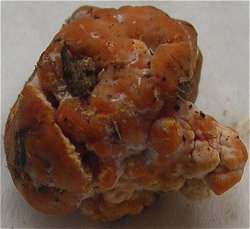
Woe is me. Four years ago, I found a strange orange/red thing under some very rotten wood. It was February. I associated the specimen with the wood so treated it as some sort of resupinate fungus. I took it home and tried a scrape but no spores were revealed. Unable to get out due to the monsoon conditions, I was looking through my old unidentified photos and came across a picture of this specimen. I remembered an article that pictured something similar.The article was about Paurocotylis pila, a truffle of New Zealand origin. My specimen looks very much the same. I consulted Caroline Hobart, an expert on underground fungi. She agreed but, quite rightly, would not give an opinion based on a photograph. Unfortunately, I had a spring clean last year and threw the specimen away. But at the time, I had no knowledge of an orange/red truffle so never considered it. I think I missed out on this one.
Tuesday 3rd April 2018
Encouraged by my find of an Entoloma on my back lawn, I walked up to my local park in high hopes. Nothing. Lots of children, it being Easter holidays. But no visible fungi except Geastrum triplex (Earthstar). So a collection of nettle stems is all I took home. It will take a week for something, if anything, to grow.

Sunday 1st April 2018
At last a fungus with gills. Growing on my rear lawn. Entoloma papillatum. Described as growing from summer to autumn. Looking out of my window, I think it must have got lost somewhere.
Thursday 29th March 2017
A bit of gardening this morning. Then it got cold and hailed on me. Back home I had a look at my mysteries folder, the ones I could not identify at the time. I have all the relevant bits photographed in the hope that something turns up on the Internet or I find the right page in my books. I had a success while searching for something else on the Internet which pointed me to Ellis & Ellis. I had found this tiny black spiny species at Carr Mill dam in 2016 growing on Peniophora. I had photographed the spores. I have at last identified it as Helminthosphaeria corticiorum. I can now cross it off my mysteries.
Tuesday 27th March 2018
Car in for service. Pouring with rain again. So I sorted my collection of dried fungi to give to Liverpool Museum Herbarium. I kept them to use when I do a talk but some are starting to fall apart. They are in a shoe box and not used for any other purpose. I did check an old specimen that I had identified ten years ago as Lactarius helvus (Pestle Milkcap) as it might have been Lactarius camphoratus. I managed to get all the bits under my microscaope and it was correctly identified. Even after ten years it has a very strong smell.
Sunday 25th March 2018
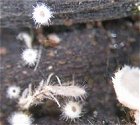


Taking advantage of a lovely spring day - at last, I went off to my favourite small woods at Hale. The weather still has not persuaded any gilled fungi out. Not even the tiny Mycenas on stems and logs. Most stems were covered with Acrospermum compressum that looks like a very tiny Xylaria. I did not find any spores but some species that stick up like a finger keep the spores in the base, the head being sterile. Too difficult for me to dig them out. I managed to find yet another Lachnella, this time on blackberry. Having gone through all the literature again I have decided on Lachnella villosa. The more I read what the differences are supposed to be the less they become. Perhaps they are all one species. But it did not finish there. The next specimen under the microscope is a Flagelloscypha, with encrusted, pointed hairs. I shall stick with minutissima. I am going to keep all my specimens just in case somebody decides to sort these species out.
Thursday 22nd March 2018



Let us hope this unfriendly weather has ended. Managed to get a game of golf this morning but there was nothing about. I was hitting the ball straight so not much opportunity to foray. This afternoon, I popped down to a local reserve to find that some of it had disappeared because the Council and FA are constructing artificial football pitches on one side of the stream that runs through. The site suffers from erosion and a lot of trees had fallen down the steep banks. Plenty of dead wood. I did not collect much, my best find being Subulicystidium longisporum. You might easily mistake it for Hyphodontia Sambuci (Elder Whitewash) but I always check as there are many lookalikes. This one has long spores and encrusted hyphae, so easy to identify.
Sunday 11th March 2018
I joined my colleagues for a visit by North West Fungus Group to World Museum, Liverpool. A home game for me as I visit often. Today's visit was to look at the herbarium material, which is kept in controlled conditions under lock and key. I have contributed specimens in the past, some of them being freeze dried and used in nature tableaux in the public galleries. We also went to discuss the future of the Bess Harthan diaries and paintings (some of which can be seen at http://fungus.org.uk/nwfg/bess.htm) The Museum hope to have them all scanned and published. We discussed transcribing the notes but there is a lot of handwritten material so it would take a lot of dedication. Having volunteered for a similar task a couple of years ago. Not sure my eyes are up to it.
Saturday 3rd March 2018
The weather has been so cold but we did not get the snow that everyone else has suffered. I went for a walk but quickly came home. So I had another look at my Flagelloscypha and Lachnella specimens. Frustrated, I asked Kew if there is any up to date definitive literature on these species. The answer was NO. So I am stuck. I shall keep my specimens in case something turns up.
Saturday 24th February 2018
I attended the AGM of The North West Fungus Society at Risley Moss. Good attendance. Our President, Geoffrey Kibby gave a talk about the increasing number of varieties that have been uncovered using DNA. Looks like we are going to get a Bento Box so that we can do our own. A few of us went for a walk round the site to see if anything was showing. But apart from a few Ascomycetes on dead nettle stems and the usual Sarcoscypha autriaca (Fairy Elf Cups) and Daedalea quercina (Mazegill) there was nothing of interest.
Thursday 22nd February 2018


I kept one of my nettle stems for ten days in a damp box. It rewarded me with a collection of Lachnella, another tiny, tiny Basidiomycete. It is identified by the hairs and large spores which are different from Flagelloscypha. But then it becomes difficult.There are two common species, L. alboviolascend and L. villosa. I consulted fourteen books, papers and Internet sources. None agree on the colour, the spore size, does it have cystidia? I am totally confused. My spores are too short for one and too wide for the other. I might have found one cystidia if indeed either species has one. My leaning is toward villosa but I can not rely on the expert authorities to help me.
Friday 16th February 2018
I made a good collection today. So I thought. Lots of what looked like Ascomycetes on various dead stems. But when I examined them under my microscope, I could not find any spores, so was unable to identify most of them. I ended up with one Tapesia fusca and a couple of Myxomycetes. Very disappointing.
Tuesday 13th February 2018

At last it stopped raining so I went for a quick walk. It turned out to be very slow due to the muddy paths. Nothing much. Calloria neglecta (Nettle Pox) was on most dead nettle stems. The interesting finds were of Flagelloscypha minutissima, in both of the parks I visited. Both finds on dead herbaceous stems, nettle and hogweed. A couple of weeks ago I found it on thistle. According to the books, it grows on wood, rarely on herbaceous stems. The spores are right, the pointy hairs are right. I seem to find it regularly on dead stems. The small size of the spores precludes the other tiny basidiomycetes, unless there is one I do not know about.
Saturday 10th February 2018
Before I sent my Ramaria decurrens to Kew, I went back to Speke Hall to check the ecology of my find. NT have recently built a marquee to hold events in. Now they are constructing a path from the car park to the marquee. Right through the area where I find Boletus edulis (Cep). Is nothing sacred?
Friday 9th February 2018

In November, I collected a coral fungus under the yew hedge at Speke Hall. I identified it as Ramaria decurrens. This identification was based on spore size, white rhizomorphs and ecology. As it is uncommon, I offered it to Kew. Last week Kew replied and asked for my specimen. There is some confusion regarding this species. An alien woodchip lover, Ramaria curta is very similar. to decurrens. My literature and the B & I Checklist give the impression that curta is an unusual if not rare find. Kew tell me that of specimens identified as R. decurrens, lodged at Kew, many of them are R. curta. It may be that decurrens is the rarity. I suppose the lack of literature would be one reason for this. I await the sequencing of my submission with interest.
Sunday 28th January 2018

I took the opportunity to visit a new site today. Lunt Meadows, a Lancashire Wildlife Reserve. It is a wetland site, a flood plain for the River Alt. Mostly marsh but with some adjoining Forestry Commission Alder woods. Lots of dead herbaceous stems. A nettle bed produced a few Ascos including Stictis stellata. A few Mycenas and Tubaria in the woods. Also one Arrhenia retiruga (Small Moss Oysterling) in the mossy floor. So small, I am still wondering how I spotted it. A pleasant walk if a bit muddy. It was nice to share the space with a hundred or so pink footed geese although they are noisy blighters.
Friday 26th January 2018
A bright sunny day had me back on the golf course. I was very surprised to find Ramaria stricta (Upright Coral) growing under Hornbeam in a very exposed spot. After snow, frost, gales and heavy rain I did not expect to find anything. The National Database records it growing in late December so it is a species that grows in winter. Not rare but a first for the site.
Tuesday 23rd January 2018
I managed to get out to the woods at Hale Hall for the first time this year. It was very muddy, wellies essential. A few trees have been blown down since my last visit. It was a fresh breeze today as well. The woodchip machine had been out so I can look forward to searching the woodchip piles later in the year. Nothing much of interest although I did add five species to the list for this site. It was a pleasant walk. No dogs. Too muddy.
Friday 19th January 2018

Well. We had some rain. My allotment is awash. I managed to get out this morning for a quick walk. Nothing much to see except my first Sarcoscypha austriaca of the year.
Wednesday 10th January 2018

Another sunny afternoon so I paid a visit to Speke Hall and walked round The Bund, which is a high bank that was built to help blot out the sight and sound of Liverpool Airport. A visitor once asked why someone had built such a beautiful house next to an airport. A few bits and pieces on dead wood and herbaceous stems, including Pyrenpeziza urticicola on nettle stems. Dropping down to the woods, I found lots of Schizophyllum amplum (Polar Bells) on fallen twigs from a line of Black Poplar. I find it every year in the same area and always January to February.
Friday 5th January 2018
My first competitive game of golf since my shoulder injury eighteen months ago. Hurrah. Gloeophyllum sepiarum (Comifer Mazegill) was still growing from some wooden steps leading up to one of the tees. At one hole, I hit my ball to the same spot as two years ago, under a line of Populus nigra (Black Poplar) and Willow. There was a lot of fallen twigs after the storms. The first bit I looked at had a group of Schizophyllum amplum (Poplar Bells) growing on it, almost the same place as two years ago. Kew informs me that black poplar and west coast weather is a perfect combination to support this species. It is said to be uncommon but it is tiny and needs moisture as it dehydrates which makes it difficult to spot when dry.
Thursday 4th January 2018
Storm Eleanor passed through and there was a small window of sunshine before the next gale started. I took advantage by going for some exercise to my local golf course. To my amazement I found a solitary Inocybe sindonia (Beige Fibrecap) still hanging on. I also recorded Crepidotus luteolus (Yellowing Oysterling) on dead blackberry stems. A winter specialist, my first record of this species on this site.
Thursday 28th December 2017
Watching the rest of the country in chaos due to snow which has not yet arrived on the Liverpool Riviera. Taking advantage of the sunshine, I went out for my constitutional, visiting Calderstones Park, once the home of a partner at Cunard Shipping. Lots of interesting and rare trees brought from overseas that frequently support fungi. But not today. One old Mycena and the slime mould, Tubifera ferruginosa were all that I saw.
Tuesday 26th December 2017


The sun came out all day so I took some necessary exercise after all the food and drink I managed yesterday. Just down the road is the Speke-Garston Coastal Reserve, some of which has been snapped up by Speke Hall. It was part of the runway area of the old Liverpool Airport and is now populated by grasses, herbs and reeds. Tall ruderal probably best describes it. I was lucky to find a dead thistle stem with tiny fungi on it. They are smaller than a pin head. Back home to my microscope. It is a Flagelloscypha and is one of the smallest Basidiomycetes, not a Disco. But which one? The books describe half a dozen but the differences are so small I have my doubts. Probably all the same species. Anyway my decision is Flagelloscypha minutissima based on the type of hairs and the size of the spores. That was my lot. The area is very good for birds as it includes the marshes and mudbanks along the Mersey. So plenty of other things to see.
Monday 25th December 2017

I managed to get a Christmas walk before the inevitable rain. I walked through a small coniferous plantation that was carpeted with Rhodocollybia butyracea (Butter Cap). I checked a few herbaceous stems but nothing is growing on them yet as they are still half alive and difficult to pull out. A stem of Indian Balsam pulled out with some moss attached to it. I was lucky to spot a tiny pinhead that I took home to microscope. It is a Slime Mould. My conclusion is Comatricha nigra.
Tuesday 19th December 2017
It sometimes stops raining long enough to get out for a wander but not often. Nothing much to record this year. A few patches of Clitocybe nebularis (Clouded Agaric) and Lepista nuda (Wood Blewit) but nothing new and hardly any Ascomycetes yet. This time last year I had recorded a good number. I have done no more than add some common species that are new to some of my regular sites. So I have been sorting out my database by adding the latest name changes from Index Fungorum. And what a lot of changes there are. But in a lot of cases I am changing the name back to what it was when first recorded. And it does not help that the National Database differs from the Index. In some cases where I have used a new name, I find that the old name is now a separate species so I should have recorded the previous name. It would help if the name changes were advertised somewhere as they happen instead of having to go through all the species in the Index to match them up.
Monday 18th December 2017
News from Kew about the mystery fungus found at Ainsdale as follows-
I have now had a good look at your and Peter s remarkable Cotylidia from the dunes and for the time being I m determining it as Stereopsis reidii which would be new to Britain and apparently rarely recorded anywhere in Europe. I say for the time being as it will be queued for sequencing here at Kew. Whether this will help or not (there may not be any available sequences for matching if it is S. reidii) only time will tell. It will be interesting to get a sequence in any case. What an amazing find, congrats again to Peter! Will let you know more when results of the sequencing attempt are known.
Martyn Ainsworth.
Thursday 7th December 2017
On the practice ground at my golf club, hitting balls to make sure my shoulder will hold up to such exercise as my expensive fees are due in January. Despite the weather, the practice ground had loads of Cystoderma amianthinum (Earthy Powdercap) growing together with Galerina vittiformis (Hairy Leg Bell). Under an Aspen, I found some Russulas that I thought would be Russula nitida but turned out to be Russula puellaris (Yellowing Brittlegill). The two look very similar although fragilis prefers Birch. When playing golf, I can not examine every red Russula. I wonder how common puellaris is. I must collect more in future.
Sunday 3rd December 2017


Too good a morning to miss so I went to Formby National Trust Reserve. Avoiding the red squirrels, I made for the outer dunes to see if I could find something interesting. Immediate success. Coprinopsis ammophilae (Dune Inkcap) with Marram grass, Red Data vulnerable. I then spent the next hour climbing up and down sand dunes and found absolutely nothing. Retiring to the grey dunes, things improved with Agaricus devoniensis (Sandy Mushroom), Galerina uncialis and lots of Tulostoma brumale (Winter Stalkball). Another one new to me is Entoloma turbidum. It has comparatively small spores and likes Creeping Willow, Pine and Birch, so my identification seems to fit. But my visit was shattered by a sudden rush of people with dogs and children so I retreated home.
Saturday 2nd December 2017
I went to my allotment to pick some veg for dinner. I noticed that a lot of the Couch Grass was covered in black spots. So I took some home, more in hope than confidence. I found some spores and asci and a very good website about plant parasites. My conclusion is Phyllachora graminis. A result I never expected to achieve.
Friday 1st December 2017
Cold but no wind so I visited Otterspool Park beside the river. It was warm in the sun. I should visit this park more often at a better time of year. It is a ravine, a former tributary, so difficult to access without a climb or two. A few bits and pieces but there are still mounds of leaves. My best find, on the adjoining grass promenade, was Lyophyllum decastes (Clustered Domecap).
Wednesday 29th November 2017
At last it has stopped raining. I managed a walk round my local golf course and park. Things are improving. Lots of small stuff, Mycenas and Galerinas. A large Chlorophyllum rachodes (Shaggy Parasol) with Xerula radicata (Rooting Shank) under the Rhododendrons. Numerous fruitings of Lepista nuda (Wood Blewit) and sordida (Sordid Blewit). My best find was Macrocystidia cucumis (Cucumber Cap) under a bush. Not a species I see very often and a first for my Liverpool records.
Friday 24th November 2017
After a week of rain it was a happy event to get out for a walk. I went back to Speke Hall to see if things had improved. A week ago the large North Lawn in front of the house sported numerous Gliphorus psittacina (Parrot Waxcap) but not much else. Today, they had all but gone to be replaced by hundreds of Galerina clavata (Ribbed Bell) and a good number of Entoloma conferendum (Star Pinkgill), so named because of the spore shape. I was also pleased to find a few club fungi, Clavulinopsis helvola (Yellow Club) and Clavulina rugosa (Wrinkled Club). As I write this, the rain has started again so who knows when my next visit might be?
Friday 17th November 2017
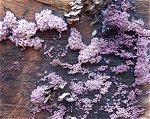
Another disappointing morning. This time at Sudley Hall, an old shipowner's home now museum. It is very good early in the year for unusual Russulas and Lactarius. The front lawn usually has a fair collection of waxcaps and other grassland species at this time of year. Today, like Speke Hall's large lawn, nothing. A fallen beech supported a number of Polypores and Ascoryne sarcoides (Purple Jelly Disc).
Wednesday 15th November 2017
I was passing Liverpool Festival Gardens so I popped in to see if any fungi were growing. Planted out as a woodland and parkland in 1984, the area has great potential. But I have found it very disappointing. Today, there were no grassland fungi on the lawns. I found four species along the pathside, the best being Lactarius pubescens. Nothing in the woodland areas. I find more species in the grassland and shrubberies along the adjoining Otterspool Promenade which was constructed at the same time. I wonder why?
Sunday 12th November 2017
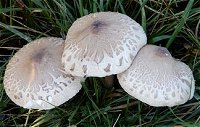

I led my North West Fungus Group foray along the Sefton Coast starting at Lifeboat Road. It blew a gale and was very cold. It hailed on us when we started. Fortunately it did not seem to affect the fungi and we made some interesting finds. We started well when we popped into the Ravenmeols Reserve to look for Stalkballs, that I hoped would be where I saw them a few years ago. Happily, I was able to lead my group straight to a large patch of Tulostoma brumale (Winter Stalkball). Even better, just a hundred yards away, we found Tulostoma melanocyclum (Scaly Stalkball). The attraction of this area is that it is next to the sea so we could foray all types of dunes, coniferous woodland, broadleaf scrub and a large dune heathland. We recorded everything from large Macrolepiota mastoidea (Slender Parasol) to tiny Omphalina pyxidata (Cinnamon Navel) and Lycoperdon limosa. But problems arise trying to identify them all. I have never used so many coverslips on one foray as it is so difficult to remove the sand from specimens. Crunch. There goes another one.
Saturday 11th November 2017

A nice afternoon. So I went for a walk in my local parks and golf course. I was pleasantly surprised that fungi were quite abundant and I recorded a dozen or so without specifically looking for them. Nothing outstanding except for an upside down Leccinum scabrum (Brown Birch Bolete). I thought it was a fallen Birch Polypore until I picked it and saw the stem. I wonder why that happened.
Friday 10th November 2017

Because I am leading a foray on Sunday, I went to Speke Hall to see if any waxcaps were growing on The Lawn, which is usually a good area for all types of grassland fungi. There were lots of fruit bodies but not much variety. Mainly Gliophorus laetus (Heath Waxcap) and psittacinus (Parrot Waxcap) with a few odd grassland fungi here and there. Speke has a very large Yew hedge surrounding the Hall. Under one of the ornamental structures I noticed some Coral fungi. It looked like the usual coral but a little smaller. As I had not taken anything to examine further, I took some home. Just as well. The spores were much smaller than the common Ramaria stricta. I did not realise until I researched further, how difficult these are to identify. My overnight spore print showed that the spores had very tiny spines and after more detailed research, I settled on Ramaria decurrens. Recently Red Data species so I have offered it to Kew Herbarium. I await a response.
Monday 6th November 2017

I have been working on that yellowish white fungus from the soil in my garden. The nearest I can get is Hypochnicium punctulatum, the only one I can find with the same type and size of spores. I have that half log edging round the border so it may be associated with that and then spread over the surrounding bits. Not happy with having probably identified that, I had to find another nondescript fruit body on the edge of a piece of wood. Fortunately the cystidia were very obvious and it is Peniophorella pubera. Some of these this crust fungi can be difficult to identify. You need to get a spore print which can take a couple of days to extract, you need to soften it up to take a sample and then look for cystidia and other microscopic bits and then you hope you can find a book or website that has sufficient detail to be able to match it. It takes time and can be frustrating. At least they will keep for a little while in a damp box.
Saturday 4th November 2017

A day at home to catch up on paperwork AND the ones awaiting spore prints. I feed my birds and use a plant pot saucer as a bath for the smaller birds. I lifted it up to clear out the leaves and refill it. Underneath, I saw that a fungus had grown on the litter and soil. I thought that it would be easy to identify. Not so. The spores are too big or too small. It is a fluffy yellow/white thing. I have a four spored basidia, lots of spores. But I can not find it in any of my books. I struggled for hours to identify it. My final decision is Hypochnicium punctulatum. I can not find anything else that fits or is even close.
Friday 3rd November 2017

I decided to have another go, this time at Calderstones Park, one of the main parks in Liverpool. There is a particular shrubbery that often produces something different. Lots of Geastrum triplex (Collared Earthstar) as usual. And a few Psathyrellas - microrhiza (Rootlet Brittlestem) and pseudogracilis. One that fooled me was a large smooth brown cap with white gills. I had to do some hard research to to reach the conclusion that it was Echinoderma aspera (Freckled Dapperling). I have found this in the Park before but it usually has a very cracked cap. The microscopics clinched the identification. It is essential to check the spiky bits on the cap.
Thursday 2nd November 2017
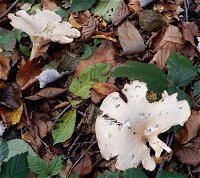
A nice afternoon so I went for a walk to one of my favourite local parks and nature reserve. Fungi were thin on the ground again. Two hours of searching and nothing of much interest to show. The redeeming feature was that Rhodotus palmatus (Wrinkled Peach) was still hanging on to one of the cut tree trunks. I have noted that Clitocybe geotropa (Trooping Funnel) seems to be everywhere this year. It has been a few years since I recorded it.
Saturday 28th October 2017
My annual foray for Natural England at Ainsdale Sand Dunes Reserve. Twenty odd members of the public eager to learn about fungi. First question - Can you eat it? Even at Ainsdale, it was a struggle to put together a decent collection. Two weeks ago, the area was a covered with species. Not today. Fortunately, with the extra eyes, we managed to find a decent diversity of common species but nothing out of the ordinary. Strangely, not one Amanita was found. One thing that annoys me is the recent insistence to photograph everything that is found. I am expected to hold the specimen while a variety of cameras and phones is aimed at my hand. Some of them take for ages. Then they get upset when I suggest that they hold the specimen while I tend to the rest of the group. So selfish.
Friday 20th October 2017


Went for a walk to my local golf club before 'Weather Bomb Brian' arrives. Not much around. I did find Volvariella gloiocephala (syn. Volvariella speciosa - Stubble Rosegill) which is new to the site. On very recent woodchip. More interesting was Leptosphaeria doliolum on a dead nettle stem. Under the microscope was another Ascomycete with spores that had only one septa. My research came up with Didymosphaeria conoidea, which is a parasite of Leptosphaeria doliolum. 'Big fleas have little fleas upon their backs to bite them'.
Thursday 19th October 2017
I paid a visit to Halewood Triangle Country Park. Like yesterday at golf, lots of fruit bodies but no diversity. These woods grow healthy numbers of Lepista irina (Flowery Blewit). I have identified it before over the last two years. In the woods were large patches of white fungi. I assumed that they would all be the same. But, as nothing else was growing, I picked a dozen to have a closer look at home. I was surprised when the pores of my first specimen were clearly from Clitocybe geotropa (trooping Funnel). My second specimen did key out as Lepista irina. So I was right about my previous identification but wrong in not checking any others. Then to my further surprise, one turned out to be Tricholoma album (White Knight). They all looked very similar and smelled similar. I left some for spore prints overnight and my room was very perfumed by morning.
Wednesday 18th October 2017
Where have all the fungi gone? I played golf today expecting to collect a few decent specimens. There were lots of fruitbodies but only from three species. Leccinum scabrum (Brown Birch Bolete), Amanita muscaria (Fly Agaric) and Amanita rubescens (Blusher). Very uninteresting.
Tuesday 17th October 2017

Last Thursday, I wrote that I had identified Volvariella caesiotincta growing with a group of Clitocybe nebularis (Clouded Agaric). But my research indicated that this species usually grows on tree trunks. So today I went back to check. I was lucky to find them. All the leaves were blown off in yesterday's storm. So I checked for a tree trunk that might have been buried. Nothing. But I did end up with a very slimy hand. When I picked a couple of specimens the stems were attached to with dead fungal bits. Then it dawned on me, the connection with Clouded Agarics. What I had picked was Volvariella surrecta (Piggyback Rosegill). All the slime and bits were from dead Clitocybes. No wonder it was growing along the same line. This fungus was once Red Data List and is rarely reported. But a collector might not spot the dead fungi on which it lives, just like what I didn't.
Sunday 15th October 2017
I went to Croxteth Hall on a sunny Sunday. I would like to lead a foray there but need to know what the parking is like and how many people go there. There was a fair on so the car parks were busy. I managed to find a slot easily. People everywhere but only as far as the fair, play areas and Hall and Gardens. The rest of this large woodland area was devoid of people. The problem was that it was also devoid of fungi. After an hour, I had found only six species. I know it is a good site. It covers a very large and diverse woodland. But when is the best time to foray?
Saturday 14th October 2014
The suspected Cotylidia from Ainsdale has arrived at Kew Herbarium. All we can do now is wait for a result.
Thursday 12th October 2017

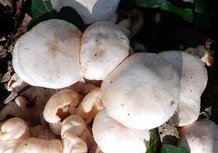
After a hard morning digging my allotment, I needed a walk to straighten out my back muscles. I visited two of my favourite woods at Hale. I made some interesting finds, some I had not seen before. There were hundreds of Clitocybe nebularis in many rings. But in one ring were some fungi, also trooping, that looked wrong. They had pink gills and a volva. Only after I had done the microscopics did I identify Volvariella caesiotincta. On a stack of cut, fallen tree trunks I spotted a crust fungus with shades of pink. This took me some time to identify as some spores were globose and some elliptical. I thought cross contamination. But no. It is Granulobasidium vellereum. some spores are asexual. The pink is caused by an insect. The other good find was the tiny Pluteus nanus (Dwarf Shield). Looks like a Mycena but with pinkish gills. Mycena galericulata also has pink gills but the spores and cystidia are different.
Wednesday 11th October 2017

I cut the lawn before it rained. On the wooden edging round the border I found three Psilocybe cyanecens (Blue Leg Brownie). This part of my garden is low and frequently floods when it rains heavily as it seems to do more frequently these days.
Tuesday 10th October 2017
Flu jab today. I parked my car outside the surgery and on the grass verge were a dozen Geoglossum cookeanum (Earthtongue) and the same number of Hygrocybe insipida (spangle Waxcap). No need to travel far for a bit of mycology.
Sunday 8th October 2017


After a hard morning digging on my allotment, I took advantage of the weather to go for a walk I chose Otterspool Promenade, a large expanse of grassland beside the river Mersey. My first find was of Psathyrella multipedata (Clustered Brittlestem) in the car park. Some grassland Mycenas oilivaceomarginata (Brownedge Bonnet) and flavoalba (Ivory Bonnet). There are two very small islands of shrubbery in this expanse of grass. One supported dozens of patches of Ramaria stricta (upright Coral), some as big as footballs.
Friday 6th October 2017

After a morning of digging on my allotment, I needed a walk. So I went to one of my favourite parks. After some excellent forays, I expected lots of fungi. I was disappointed. I started well with Lepiota ochraceofulva. This species first appeared under Cupressus last year and now numbers over one hundred fruit bodies. Lepista flaccida (Tawny Funnel) was everywhere. I came across a large fruiting of Entoloma clypeatum (Shield Pinkgill). Also Clitocybe nebularis (Clouded Agaric), an indication that winter is near. I had a nice finish with a find of Tricholoma stiparophyllum (Chemical Knight?), pure white with a very strong chemical smell.
Saturday 30th September 2017


I joined Merseyside Naturalists who were holding a foray at Freshfield Dune Heath. They seemed pleased that I could add my fungal knowledge to the event. The site, both woodland and heath was spectacular. Hundreds of Amanita muscaria (Fly Agaric), and Suillus luteus (Slippery Jack). An extensive area of Thelephora terrestris (Earth Fan) under Ulex (Gorse). I have never seen so much. Lots of Lactarius rufus (Rufous Milkcap) and hepaticus (Liver Milkcap). Leccinum versipelle (Orange Birch Bolete) and Amanita citrina (False Deathcap) in the woods. Even a couple of Boletus edulis. I let one of my party have one. I have never shown such generosity before.
Friday 29th September 2017


Received an Email from the Manager of Ainsdale Sand Dunes Reserve attaching a photograph of a fungus. He asked if I could identify it. The nearest I could get was Cotylidia undulata, a Red Data List species. I arranged to collect the specimen only to be told that a slug had eaten most of it. Another call. He had found another one. So I went to Ainsdale where I collected both specimens and found another in situ, growing in sand with moss and pine needles. At home, I managed to find a basidia (so a proper fungus) and some spores. But the spores were a little too large for the Cotylidias in my reference books. So I sent the photo to Kew who requested I send it to them. Whatever it is, it is rare.
Thursday 28th September 2017
Slowly building up my injured shoulder. Playing golf on my own gives me a chance to look for fungi. A new area of Boletus edulis (Penny Bun), this time under oak. Seems to be a good year for this species. Another edible species, Clitopilus prunulus (The Miller), was spotted. Because they look similar to Clitocybe rivulosa (Fool's Funnel), I always check the spores. But by the end of the process it is not worth eating. I also collected a couple of very nice Agaricus arvensis (Horse Mushroom) for breakfast. I checked them before putting them into my golf bag. When I got home a couple of hours later and took them out, they had both turned yellow. Agaricus xanthodermus (Yellow Stainers). Perhaps all the rain affected their colour change. It shows how careful you have to be when collecting for the pot.
Tuesday 26th September 2017
Busy time on the allotment. Picking crops but also preparing for next year. Difficult to achieve in constant rain. On the path to my plot, I came across a single unremarkable Conocybe specimen. Under a microscope it proved to be Conocybe pilosella. Said to be uncommon but this is a genus that is usually left to the end. Fortunately this one had very small spores which made my task easier.
Sunday 24th September 2017


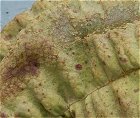
Foray with North West Fungus group at Clock Face Country Park, St. Helens. The site of an old colliery which has been reclaimed and planted with trees. despite the fact that is new woodland, the site always produces numerous fruit bodies of many varieties. Today was no different. The site supports a number of Cortinarius (Webcaps). Cortinarius bivelus and the uncommon Cortinarius alboviolasceus (Pearly Webcap). Other finds were Thelephora terrestris (Earthfan), Taphrina tosquintii (grows on Corylus leaves). A very good day. 91 identified before we left. Lots of unknown in boxes.
Friday 22nd September 2017

I had to visit my golf club to buy some equipment. The car park was full so I had to park on an overspill area. Joy. In front of me were a dozen Boletus edulis. My larder is replenished. I then went shopping at Lidl. On the woodchip in the car park were masses of puffballs. I am still working on them but I think they are Lycoperdon umbrinum. But there may be a woodchip puffball that I do not know about. My specimens are too young for spores so I will have to go shopping again later.
Thursday 21st September 2017

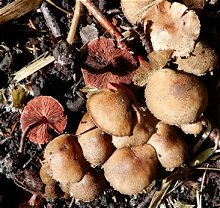
It rained all morning. When it stopped I took a walk round my local golf course. An old lane runs along one side of the course. To stop trespassers, particularly scrambler bikes, they club has erected a five foot high soil bank along the boundary. I saw these nondescript brown fungi growing from the bare soil in large numbers. When I picked one, I immediately saw the red gills. Melanophyllum haematospermum (Redspored Dapperling). Not one I record very often but to see over a hundred in one spot is very unusual. It has a pink spore print. I continued to the adjoining park to check on my Geastrum striatum (Striate Earthstar) that have been in the same spot since 2009. Still there and doing well. They grow in an area that is well trampled by children attending an Adventure Centre. But there are four trees very close together and they grow , protected, in the middle. It seems that the children run round rather than through these trees.
Wednesday 20th September 2017
Lovely morning so I decided to play golf. Not a lot of fungi about but this is due to the efficiency of the maintenance staff cutting the grass. I have recorded a lot of Agaricus augustus (The Prince) this year, this time under Cupressus leylandii. Also Augustus arvensis (Horse Mushroom) in the same place for the past four years. Breakfast was tasty.
Sunday 17th September 2017



I attended the North West Fungus Group foray at Dibbinsdale Country Park. This is one of my favourite sites as it frequently turns up rare species and today was no exception. Pluteus aurantiorugosus is a striking orange species found on elm, so not very common these days. Another unusual species was Peniophora laeta, that grows only on hornbeam and has little pegs that push the bark up from the wood. An interesting Ascomycete was found on a muddy path and identified as Pulvinula convexella. Helvella elastica and Marasmiellus delectabilis were also recorded. the latter is very tiny and found on dead bramble. The important identification features were the size of the spores and that it had just a few gills. While carefully removing the stem from the bramble, I spotted another fungus, a small black ball, that turned out to be Anthostomella appendiculosa. Said to be uncommon. It was identified by the very large spores, up to 35um. We made a large collection and the list will take some time to complete and post on the NWFG website.
Saturday 16th September 2017


I brought home a small yellow Ascomycete from the foray at Moore on the 4th September. I though it would be a Hypocrea but it did not produce any spores. I therefore kept it in a damp box to see if it developed. At last. On Saturday the surface covered in small ostioles like the top of a pepper pot. It is Hypocrea aureoviridis. I only had to wait two weeks.
Friday 15th September 2017

For years my front lawn has grown Entoloma papillatum, a small brown jobbie with a distinctive pointed cap. This year I came across three brown jobbies on my back lawn. But no pointed caps. The cap is flat, even sunken. The fungus is small and disappears very quickly. Having done the microscopics, my conclusion is Entoloma minutum, described as rarely recorded but it is very small and easily overlooked. Interestingly, if it had a papillate cap, the microscopics would have been much the same.
Thursday 14th September 2017
Just got back from Amsterdam. They seem to have a lot of mycologists there. I saw one 'mushroom shop' crowded with people with a queue outside. They were buying something called Amsterdam Truffles and were talking about 'paddos'. I have no idea why.
Sunday 3rd September 2017
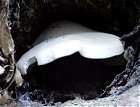


I joined my North West Fungus Group colleagues on our foray at Moore Nature Reserve near Warrington. It had been very dry for at least a week and fungi were hard to find. Very little on the heath area which is now becoming overgrown. We did better along the old canal bed where it was a bit damper. Species of interest were Lepiota grangei (Green Dapperling), Bulbiilomyces farinosus and the reliable Ossicaulis lignitalis (Mealy Oyster) that has lived in the same hole in the same birch tree for years.
Saturday 2nd September 2017

My new camera arrived today and what better to test it out but to have another photo of the Rhodotus palmatus (Wrinkled Peach). It had grown. This time you can see the wrinkles much better. While making my way to the spot, I came across Hortiboletus bubalinus (Ascot Hat) at the side of the road.
Thursday 31st August 2017
This morning I visited Sudley Hall on my way home from shopping. A large site but only a small area produces fungi. A few specimens including more Caloboletus radicans (Rooting Bolete). This time next to the car park. A large group of Lyophyllum decastes (Clustered Domecap). But everything else was past its best. In the afternoon, I had to call in to Merseyside Biobank at Court Hey Park. The National Wildflower Centre has lost finance and now closed. I had a quick look round the area but there was not much to see. I never find much there on a good day and there has been a lot of footfall over the Bank Holiday weekend. The only interesting find was the recent arrival, Agrocybe rivuosa on a pile of woodchip.
Wednesday 30th August 2017


Having recently found Rhodotus palmatus (Wrinkled Peach) in Liverpool, I went to Hale, the site of my previous find in 2008. I found my fallen tree that I always believed was an Ash because it hosted Daldinia concentrica (Cramp Balls). Today it was growing Oudemansiella mucida (Porcelain Fungus). This is an exclusively Beech fungus. So I have been wrong for almost ten years. This is the first Porcelain Fungus I have recorded for Merseyside, which is strange considering the numerous beech trees in the County. No sign of Rhodotus but the tree did produce Pluteus plautus (Satin Shield) and Peziza micropus. Best find of the day that was a first for me was Naucoria salicis. I picked it thinking it was an Inocybe but the spores were very distinctive being yellow, lemon shaped and large at 14-16um.
Sunday 27th August 2017

I went out to collect some elderberries to make wine. I have a patch in the Eric Hardy Reserve which is well away from the traffic. The path has been blocked by fallen trees since the storms last year. I have been pushing Liverpool Council to have them cleared for months as they had the finance from a property development agreement. At last the path is open. As I walked along, I spotted the unmistakable Rhodotus palmatus (Wrinkled Peach) growing on a piece of one of the now cut up trees. Last year I found this fungus on the same tree after it had just fallen and when it was still in one piece. I think the tree is Ash but difficult to be sure as it has been dead for a long time and there is no bark.
Saturday 26th August 2017
I ate the Agaricus arvensis (Horse Mushroom) for breakfast. Very nice too. I was playing with two fellow golfers when I picked them. I was asked the usual questions about how I know they are not poisonous. A task made easy by me finding some Agaricus xanthodermus (Yellow Stainer) a couple of holes later. I was able to demonstrate the chrome yellow colour when cut or rubbed.
Friday 25th August 2017
On Tuesday there were very few fungi on my golf course because the course had been efficiently mown and strimmed in preparation for some major golf competitions last week. After a couple of days recovery, it was back to normal this morning. An interesting fruiting of Paxillus involutus (Brown Rollrim) in a sand bunker in the middle of a fariway. No trees around so it probably arrived with the sand. A large patch of Agaricus arvensis (Horse Mushroom) had also fruited. Some of them managed to find their way into my golf bag for breakfast tomorrow.
Tuesday 22nd August 2017


This one turned up on my golf course. Clearly not Leccinum duriusculum or scabrum. I took it home thinking it would be L.variicolor. it is blue in the stem base, when cut it is reddish in the cap, a bit of blue in the stem and then it turns grey. Perfect for L.variicolor. But the cap cells are short brick-like, which, using the key from Geoffrey Kibby's book should be Leccinum fuscoalbum. However, this is not recognised in the British Checklist nor accepted by the old National Database. My three previous finds, including one agreed by Geoffrey Kibby are recorded as L. variicolor, with a note saying they are a misidentification. But it is recognised in the current Index Fungorum and accepted by the new National Database when I entered my record. In his book, British Boletes, Geoffrey Kibby regards it as a good species but does state that it needs further research.
Sunday 20th August 2017
As it was such a dreary morning, I decided to go to Speke Hall, believing that the weather would keep people away. But shortly after I arrived, car number three, the sun came out. And so did the all the people. I had not realised that it was The Summer of Sport, minimum age 5 years. There were children everywhere. Fortunately not in the woodland to where I retreated. Plenty of fungi about but nothing unusual, the most interesting being Laccaria tortilis (Twisted Deceiver). I also noted Rickenella fibula (Orange Mosscap) and Russula fragilis (Fragile Brittlegill) both growing under Aurucaria (Monkey Puzzle).
Thursday 17th August 2017
Heeding the advice of Mrs. Mykogolfer, I have given up on roadside verges (for the time being). So I took a look at a local churchyard instead. A few of the usual Amanita rubescens (Blusher), Boletus luridiformis (Scarletina Bolete) and a very large group of Entoloma rhodopolium (Wood Pinkgill).
Wednesday 16th August 2017
I was a bit puzzled by the Amanitas that I saw with the Caloboletus radicans (difficult to keep up with these name changes). The first time I recorded this Bolete it was with Amanita franchetii. So I went back to the dual carriageway to check. I noted that both Amanita rubescens and franchetii were present. I went back to the library but got there at the same time as the council grass mower, so that was the end of that. I remembered that my first ever find of Amanita franchetii was on another dual carriageway so I had a look there. The Amanita franchetii was still growing there. Guess what? Also with a large patch of Caloboletus radicans. The puzzle is that the Amanita is said to grow with oak. But no oak was present on the sites I examined, only beech. Is it too much of a coincidence that The Amanita and Bolete grow together, even if there are no oak trees? Mrs. Myko has suggested that I should cease this dual carriageway research before I get run over by a bus.
Tuesday 15th August 2017

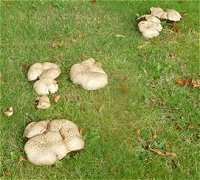
A large patch of fungi on the central reservation of a dual carriageway proved to be Boletus radicans (Rooting Bolete - now Caloboletus radicans). I stopped and took a photo which attracted the attention of passing motorists. I am no longer embarrassed. I continued on my journey to a shop about a mile away. On the central reservation I saw another large group of Boletus radicans. Another photo, this time to the amusement of the driver of a bin lorry. I continued to the library, another couple of miles. On the roadside verge, I saw yet another large group of this species. Definitely Boletus radicans day. No photo this time. Although the books describe this as a southern species, I find it regularly and always by a road. Is there a connection with motor vehicles? Interestingly, two of the groups were accompanied by Amanita rubescens (Blusher). Another connection perhaps?
Monday 14th August 2017
A quick spin round a local park. A bit disappointing in view of my finds on the golf course. A large patch of Xerocomellus porosporus (Sepia Bolete) under beech, Hygrophoropsis aurantiacus (False Chanterelle) under pine together with a nice Chlorophyllum rhacodes (Shaggy Parasol). Then it dried up. The council had recently cut all the grass so I expect any fungi probably disappeared at the same time.
Friday 23rd June 2017

Back to my roadwork. Or parkwork to be accurate. Still very dry. Our Met Yellow Warning for thunderstorms and heavy rain produced two thunderclaps and a teaspoonful. I found Puccinia urticata (Nettle Rust). Said to be common, it is the first time I have recorded it in Liverpool and it was on only one stem of one plant. My other find was Agaricus augustus, (The Pince). A pine lover, this was under Araucaria aruacana (Monkey Puzzle). An unmistakable Agaricus with a beautiful almond smell and a very good edible.
Saturday 17th June 2017

I joined the Liverpool Botanical Society at Court Hey Park. Once the property of William Gladstone's brother, it was recently the home of the National Wildflower Centre. Sadly they went bust. We were looking at mosses and liverworts but it was so hot and dry that they were hard to find in good condition. A large group of Agaricus xanthodermus (Yellow stainer) in the shrubbery and Agrocybe rivulosa (Wrinkled Fieldcap) together with Peziza vesiculosa (Blistered Cup) on a sheltered pile of woodchips made me hopeful of finding more species. A small group of Lacrymaria lacrymabunda (Weeping Widow) were found hiding in the long grass. But after we reached more open ground there was nothing. It was too hot for me so I retired home. I did find Lachnella alboviolascens on Willowherb stems. Made a change from my usual identification of Lachnella villosa.
Friday 16th June 2017

Having missed out on a visit to Ainsdale on Tuesday due to cancellation of my train, I decided to pay a visit anyway. The site is Kenilworth Road Dunes, an SSSI that I did not know existed. It is a small area of dune heath and scrub, cut off from the coastal dunes of which it was once part by roads and houses. The Biodiversity people identified some rare plants and grasses during their visit. Unfortunately, it was so dry and with thick vegetation, fungi were hard to find. Some fallen branches from Populus alba supported some dried up Pleaurotus ostreatus (Oyster Mushroom) and Crepidotus mollis (Peeling Oysterling). I did find some Discomycetes on Deschampsia (Tufted Hair Grass). One was Albotricha acutipila that was growing inside a dead stem that had curled up. I was lucky to spot it.
Monday 12th June 2017

A disappointing start to the day. I set off to join some colleagues at a site near Southport. No trains due to a signal failure. So back to my allotment to plant some celery. I went for a stroll to the adjoining local golf course and found a group of Melanoleuca verrucipes (Warty Cavalier). This species only arrived in the north west in 2011. I have now found it on four sites locally. It seems to like fresh wood chips. I have not yet found it growing in the same place the following year.
Sunday 11th June 2017

Walking home through a local park, I found another 'cascade' of Coprinellus disseminatus (Fairy Inkcap). Must be fungus of the month? Agrocybe praecox (Spring Fieldcap) was growing in a mulched flowerbed. I also noticed a stand of Impatiens glandulifera (Himalayan Balsam) with lots of dead stems on the ground. An examination revealed a large number of various Ascomycetes. I have identified Belonidium mollisimum. There is only one previous record for this on the National Database on Impatiens. Interestingly, I identified this species on a blackberry stem in the same area. Also Pyrenopeziza revincta, which is very common on herbaceous stems.
Saturday 10th June 2017
Taking advantage of a break in the rain, I went back to Speke Hall. Still lots of families experiencing the new children's play areas. So I concentrated on the woodland. A nice group pf Coprinellus disseminatus (Fairy Inkcap) cascading down a stump but no other gilled fungi to be found. Back to searching the piles of sticks. One I took home was a greyish fluffy film that I would not have bothered with but the piece of bark was loose so I took it. It produced an excellent print of small spiny spores which cut down the number of identification possibilities. My conclusion is Phlebiella tulasnelloidea although I did not get anything microscopically as I could not get a clean scrape from the very rotten bark. My cover slips kept breaking.
Tuesday 6th June 2017
Gales and heavy rain. I had to go to my allotment to make sure everything was tied down and the greenhouse closed. On the grass path leading to my allotment I found some gilled fungi. At last. I identified them as Conocybe semiglobata. Not an easy species to get right as it can be confused with others in this Genus. It came down to size of spores and lecythiform caulocystidia (capitate cystidia on the stem).
Monday 5th June 2017
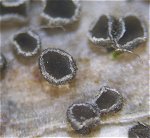
Sunday I went to Speke Hall. Monday I went to pick elderflowers for wine making. Still very dry. No gilled fungi anywhere. On Monday I had to cross a field of knee high plants, grasses, nettles, dock, hogweed and thistle. Lots of dead stems to pull out. They were very productive and I recorded two species new to me. Clyposphaeria mamillana on bramble and Pyrenopeziza carduorum on thistle. Must go again after it has rained.
Friday 2nd June 2017


Just got back from a tour of Ireland. Very pretty. The fungi in Ireland is as sparse as it is here. A few common grassland species at Blarney Castle and that was it. Blarney did have some interesting fungi so I took some pics. As we have has a bit of rain, things should improve. I did manage a quick walk round my local golf course after tending to my dried up tomatoes. I found one fungus under a beech tree that I have identified as Russula sororia (Sepia Brittlegill), based on the very weak reaction to guaiac and iron salts. This apparently separates it from Russula amoenolens which smells of Camembert. Mine did not.
Wednesday 10th May 2017
I played my first game of golf since I damaged my shoulder a year ago. It is still grumbling a bit. When I opened my golf bag, I found some dead nettle stems that I had collected last June. I put them in a damp box and they have grown some Ascomycetes. Calloria neglecta (Nettle Pox). I did not think they lasted so long.
Tuesday 9th May 2017


I finally finished the dead stems from last week. I had to wait for some tiny fluffy hairy specimens to develop on stems from hogweed. Both turned out to be Basidiomycetes. One is Lachnella villosa again. But the first time I have seen it fully open. The second is Calyptella capula. What threw me was that it was not smooth but appeared slightly hairy, although no hairs under a microscope. A third, found under a beech log appears to be Neodasyscypha cerina. My spores are bigger than quoted in my books but a couple of the specialist websites agree with my measurements. A new species for me.
Thursday 4th May 2017
The dry weather continues. On the allotment, there is no point in sowing seeds at present unless one can spend a lot of time watering. So I use the time to put up nets and bean supports. I will be ready when the rain finally arrives. While doing this work, to my surprise, I found Agrocybe praecox growing on one of my paths. A bit dry but recognisable. At least something is growing.
Tuesday 2nd May 2017

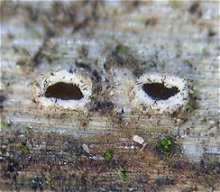
It was such a nice day, I had to go for a walk. It has been very dry so I chose Halewood Triangle Country Park because it has lots of ponds and boggy areas. However, the good weather has encouraged growth so everywhere was overgrown. Even some of the regular paths were starting to disappear. So it was back to dead stems. I did get a bit of luck on a dead Hogweed that I brought home. Overnight in a damp box, it produced Stictis stellata. It was not very obvious until I put it under the microscope. I missed it with the naked eye. I can only find four previous records for this on Hogweed.
Wednesday 26th April 2017

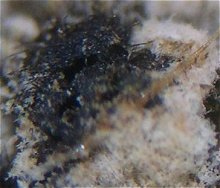
I have been struggling with some of the specimens collected over the weekend. I have a resupinate, fluffy, white corticioid (Crust fungus). I eventually persuaded it to provide a spore print. They are round and fairly small. I can only find Thelephora or Cristinia that fits the spore size. Sadly I can not persuade the specimen to provide basidia or cystidia. So I am unable to take my research further. Very frustrating. Another resupinate crust fungus also produced spores but obviously not from the crust. Further research identified the spores as those from Lasiosphaeris hirsuta. Looking at the specimen and the photos I took, I can just see some hairs peeping out of the corticioid. Not very exciting to look at but a new one for me. I have no idea what the crust fungus is.
Friday 21st April 2017



I have been very busy on the allotment so only mangaed some quick walks in the local woods. Not much to see so I have been collecting dead nettle stems to see what will grow on them. Quite a lot of Ascomycetes, some new to me. Laetinaevia carneoflavida and Mycosphaerella superflua had not been recorded by me before. The most interesting species that I have found on all local stems is Lachnella villosa. This very tiny Basidiomycete has appeared on both nettle and hogweed stems. It is so small it could easily be mistaken for a grain of sand. It is when you look at it under a microscope that you notice that there are no asci. Finding a basidia and spore can be difficult.
Sunday 9th April 2017

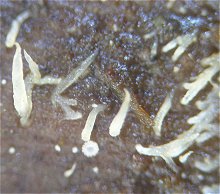
A busy weekend. Today I led the spring foray to Ainsdale San Dunes Nature Reserve. It was a lovely warm day so I took the group out to the slacks to see if the Morchella elata (Black Morel) were still there. Only two left and in poor condition. Last year they did not appear for another two weeks. None of the other rarities from our recent visit had survived the dry weather. We tried a couple of new paths which led to an old Alder carr. There it was quite damp and we collected a number of ascomycetes and resupinate crusts under the dead wood. A lot still to identify including a troublesome Tomentella. Also identified were Verpa conica (Thimble Morel), Psathyrella fatua, Mucronella calva (Swarming Spine), Mensularia radiata (Alder Bracket) and some old Taphrina alni (Alder Tongue). We have reached fifty recorded species so far which is not bad for a dry spring day. The other highlight was seeing two Zootoca vivipara (Common Lizards) sunning themselves in the grass. Unusual colour.
Saturday 8th April 2017

I joined Liverpool Botanical Society at Sankey Valley Country Park in St. Helens. I had been there once before when it was a mass of mud. At the moment it is very dry. There were a few gilled fungi about, Kuehenomyces mutabilis (Sheathed Woodtuft) and Coprinopsis atramentaria (Common Inkcap). The nettles produced a couple of Ascomyetes and a fallen log yielded the tiny Episphaeria fraxinicola. Highlight of the day was watching a pair of nuthatches performing a courtship dance.
Tuesday 4th April 2017
A disappointing visit to Woolton Wood and Camp Hill. Not an area I visit often as it is very popular. I do not have many records even though it covers a large area and is just across the road from my favourite local park. A few trees down after the storms but looked like the area had been picked clean. Woodburning stoves again? I found only nine species, none with gills. If you tried to name the nine most common fungal species then that is all I found today.
Sunday 2nd April 2017


One I collected on my visit to Speke Hall, after three attempts, produced a decent spore print. It is a grey resupinate from under an oak log. When I collected it, I thought it would be one of the grey Peniophoras. But the spores are small, spiny and have a depression beside the apiculus (the pointy end). It is Phlebiella tullasnelloidea. It is not often recorded. But as it looks very much like the common grey Peniophoras you see on many bits of fallen wood, I probably would have ignored if I had collected a lot of specimens.
Thursday 30th March 2017
I needed some exercise so I paid a visit to Speke. Starting at Stockton's Wood, I walked down to the foreshore now part of the Speke-Garston Reserve. Then back into Speke Hall. There were a few fungi about. An early Coprinus comatus (Lawyer's Wig) and some Lepista flaccida (Tawny Funnel) in needle litter. A large group of Peziza arvenensis was growing in the cracks of an old beech stump. Surprisingly, the fishing lake had overflown it's banks since I last visited just over a week ago. Did it rain that much? National Trust are making a lot of changes to the site. New gardens are popping. They have blocked public access to The Bund, a high embankment that surrounds the site. A new walk has been developed into the Speke-Garston Coastal Reserve. They seem to be taking over the area.
Tuesday 28th March 2017
From very wet, the weather has turned warm and dry to cold and dry. I paid a visit to the Eric Hardy Reserve. Liverpool Council has recently received funding to improve the area but I can not find much evidence of this. Lots of fallen wood after the storms and heavy rain. The lower level is now impassable due to at least six large fallen trees blocking the path. A few more look very dodgy. I am surprised it has not been fenced off. A few Psathyrella spadiceogrisea (Spring Brittlestem) was all I noted. I met a couple with dog who were collecting 'logs' for the woodburning stove. It seems half of of south Liverpool has one. No wonder I am struggling to find dead wood. My best find was in the Crematorium garden. Conocybe rugosa in woodchip. Some say it is just a stocky Conocybe filaris (Fools Conecap). It matched the description in the books. Apparently it has the same toxins as Amanita phalloides (Deathcap). Not to be trifled with.
Monday 27th March 2017
On my way back from the City centre, I pass the Festival Gardens, the site of the 1984 Liverpool Garden Festival. After years of neglect, it has been taken over by The Land Trust, who are restoring some of it. It is very new and I have never found much of interest there. Today was no different. A Lacrymaria lacrymabunda (Weeping Widow), a couple of Galerinas and Coprinopsis atramentaria (Common Inkcap). Not much but more than usual.
Tuesday 21st March 2017
Dodging the showers, I paid a quick visit to Speke Hall. It was cold and windy. Nothing much to see. I did collect Psathyrella spadiceogrisea (Spring Brittlestem) and Phlebiella sulpuhrea (Yellow Cobweb) from under a log. Then it started to rain again and that was the end of that.
Sunday 19th March 2017
I had to sow my parsnips this morning before it rained again. I got the job done and then it rained. On my way past the adjoining allotment I spotted Peziza vesiculosa on the bare soil. I know that this plot has been heavily manured over the years. Perfect for this Peziza.
Tuesday 14th March 2017



I led a mission to Ainsdale to collect Morels for Kew Herbarium. They want to carry out DNA tests to see if they are Morchella elata (Black Morel) or something different. A small group of us set out on a beautiful spring morning to the dune slack area where they grow. It is the furthest point on the Reserve and a hard slog over the dune grassland. We were fortunate to count twenty fruitbodies and I photographed and collected three. They will now be dried.They are much browner than in previous years. During our visit we also came upon a couple of Gyromitra ancilis (Pigs' Ears) and a new site for Caloscypha fulgens (Golden Cup), a first for Ainsdale, a site that rarely fails to surprise. That now makes two sites for Caloscypha, Red Data Vulnerable, for 2017.
Thursday 9th March 2017
Some decent weather at last. So I paid a visit to my favourite woods at Hale. It is not a place to visit during a gale and I had not been to see if any damage had been done in the recent storms. Not as bad as I expected but the ponds had overflowed so it was very muddy. I soon had a good collection from the underside of fallen wood. The difficulty was judging which was old wood and which bits had only recently fallen. Nothing extraordinary. A very early Leratiomyces ceres (Redlead Roundhead) in it's usual spot. Also a collection of Kuehenomyces mutabilis (Sheathed Woodtuft) on a pile of woodchips. The identification was fine under the microscope but I had not heard of it on this substrate. I looked through my literature collection and found a report from Wisley in 2000 and 2001 of it growing on woodchip there. I did bring home a few fluffy things from rotten wood. They all had conidia and I only have literature to identify a few.
Monday 6th March 2017

It just keeps raining. It did manage to stop so I went for a walk but was back home very quickly as the rain returned. So I did not have much time. A number of common species. I did find a yellow Ascomycete that I can not identify, yet I am sure I have seen before. I have photographed it and the microscopic bits and put it into my Mysteries Folder in the hope it will turn up in the future on a website. It does pay off every so often. I recently acquired a book on Imperfect Fungi where I recognised a particular spore. By checking my Mysteries Folder I was able to identify the fungus as Tubeufia paludosa.
Thursday 2nd March 2017

After the storms (my greenhouse was moved by two inches), we now have torrential rain (my garden has flooded). Clutching my umbrella, I paid a visit to Stockton's Wood at Speke in the hope that the wet weather had encouraged something to grow. It was hard work. Hemimycena tortuosa (Dewdrop Bonnet) was under almost every log I turned over. Definitely fungus of the day. I found Subulicystidium longisporum again. This is a fluffy white thing on rotten wood that you would normally ignore but when you put it under a microscope, the unique 'long' spores' make it easy to identify. I did add a new species to my collection. Nemania confluens, black lumps on decorticated oakwood. Tough? I broke three coverslips on it.
Satuday 25th February 2017
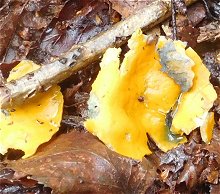
The day of the North West fungus Group AGM at Risley Moss. After business and a talk from our president, Geoffrey Kibby, we went for our traditional walk around the reserve. All the usual winter suspects were present. Until a casual search of the pathside vegetation revealed the presence of Caloscypha fulgens (Golden Cup). This Red List endangered species was found on this site in 2009. The literature says that it appears infrequently so we were very fortunate to see it again. In 2009, this species also grew in numbers at Mere Sands. Interestingly, both are peat sites. Sadly the specimens were not very photogenic.
Wedneday 22nd February 2017


I collected a mystery over a week ago at Halewood Triangle. A yellow disc on the underside of a fallen branch. Having found nothing useful under my microscope it was left in a damp box for eight days. It rained today so I decided to clear out the debris. Surprise. The yellow disc now sported small black ostioes. I found asci and spores. It is Hypocrea aureoviridis. Clearly some of these species need patience.
Tuesday 21st February 2017
After some digging on the allotment, I went for a walk round Calderstones Park which is round the corner from my allotment. The park was owned by the McIver family, he being a founding partner of Cunard Shipping Line. The Park is full of specimen trees from all over the World and it is interesting when a common fungus grows on Polyepsis australis. Today, after no rain for ten days, it is very dry. And the Park staff are pruning and clearing up. No fungi. No fallen wood. I found nothing except some young Kretzschmaria deusta (Brittle Cinder). But it was an education. I did not know that the grey bit was conidia and that the proper spores form later. Had me fooled for a bit.
Friday 17th February 2017


Digging my allotment at the moment, while it remains dry. I did find time to visit Halewood Triangle Country Park, which turned out to be wet and muddy. All the usual winter species were around, a good show of Sarcoscypha austriaca (Scarlet Elf Cup). Most of the site is not only wet but impenetrable. Lots of fallen wood. One log sported a rusty brown smear, a crust fungus perhaps?. I microscoped a scrape - nothing. I tried for a spore print - nothing. Looking at it under my Lidl Bresser microscope, I noticed these small 'pinhead's. A scrape produced nothing but I dug one out and after four broken cover slips, found some spores. My conclusion is Hypoxylon subticinense. Only forty records on the National Database. I am sure I have found this before but never managed to extract the necessary information. One to look out for.
Sunday 5th February 2017
A beautiful morning so I decided to take a look at Formby National Trust which I have not visited for over a year. Unfortunately, a thousand other people had the same idea. So I disappeared into the woods. The first thing I noticed is that the dunes have made incursions into the woodland and paths have disappeared under sand. Plenty of fallen wood to poke around at, especially coniferous which I do not have much of in Liverpool. I found a few resupinate crust fungi that I had not seen before such as Peniopherella pubera, Hypochnicium geogenium and Skeletocutis amorpha (Rusty Crust). Highlight of the day was when I reached the dunes at the edge of the wood and came across Agaricus devoniensis (Sandy Mushroom) buried in the sand. I did not venture further into the sand as it has been windy for a couple of days and any fungi were likely to be covered. So I went home early to beat the rush.
Friday 3rd February 2017
I paid a visit to Otterspool Park. Not a favourite. It was once the bed of a tributary of the Mersey. It is a ravine with high sides and a lot of mud. Also the Council had been out clearing away the fallen branches and cutting down trees. Despite this, I had a good day. Schizophyllum amplum (Poplar Bells), a Red Data List species that seems to be common in this area. I have found it at four local sites. Kew says that it should like north west coastal sites with poplar. It does. Another find was an Ascomycete new to me, at last. Calycellina ochracea, a bright yellow disco with hairs.
Thursday 2nd February 2017
I popped to my local golf club. Not for fungi. I saw a Goldcrest there last week so went to look for it again. As I waited (in vain), I turned over a piece of old fence post. It looks like dust. It was another group of Phaeoisria clavulata. Having never seen one before, I have now found it twice in one week. I have clearly got my eye in for this one.
Wednesday 1st February 2017
At last, the sun came out. I went for a walk round Sefton Park for a bit of exercise. Being one of the premier parks of Liverpool, it is more ornamental than most and kept very tidy. A bit sterile for fungi. There are a few fallen beech trees whose dead trunks produce a number of common species. Nothing special to report although I did find yet more Schizophyllum commune (Splitgill). So not really a fungus found in south east England.
Tuesday 31st January 2017


Today it was my local golf course. More Schizophyllum commune (Splitgill). I tried another of these white fluffy resupinates found on loose bark. I took a scrape but it was difficult to remove without getting bits of the substrate. Also the wood was covered with a lichen so all I could see were lots of green lichen spores. With little confidence, I stuck it on to a glass slide to see if anything fell out. It did. I got a mass of sausage shaped allantoid spores. Then it got difficult. Using Mycokey, Fungi Europaei and Google, I managed to narrow it down to Sistotrema brinkmanii. Said to be common but rarely reported. Not surprised in view of the work I had to do to identify it. And you need access to the literature.
Monday 30th January 2017
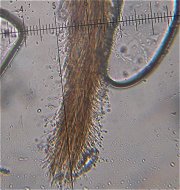

I brought home a piece of branch from yesterday's short outing as it had an Ascomycete growing on it. When I looked more closely at the wood, I saw lots of tiny white spots that looked like dust. Under a microscope they look like treelike candles. With the assistance of my Ellis & Ellis Microfungi on Land Plants, I identified it as Phaeoisria clavulata. Only 70 previous records on the National database but that is not surprising in view of the size. I would have missed it had I not brought the wood home.
Sunday 29th January 2017

The frost melted. The sun came out and so did I to a local park for a quick walk. I came across a nice collection of Schizophyllum commune (Splitgill) on a fallen beech tree. I note that the Checklist of British Basidiomycota describes it as locally common in south east England, occasional to rare elsewhere. I find it regularly in the parks of south Liverpool which are all planted with lots of beech.
Friday 27th January 2017

I had been struggling with a resupinate that I found under a log. One of those white cottony things that I would have ignored if my collection had been larger. I decided to give it a go. With a hand lens you can see lots of prominent cystidia. When I scraped a bit off to look under the microscope there were so many different spores, I could not tell which came from my specimen. So I tried for a spore print, usually disappointing from this type of fungus. It came out beautifully. Unusual long, thin spores. I was able to identify it as Subulicystidium longisporum.
Tuesday 24th January 2017
Weather still holding so I paid a visit to Childwall Woods, just up the road. I always find this wood very sterile. No fallen branches. I think that they are collected for these wood-stoves that are now popular. The most exciting species from a very poor haul was Hemimycena tortusosa growing on the underside of a cut log. I know that this wood can produce rarities but finding anything of interest is hard work.
Sunday 22nd January 2017
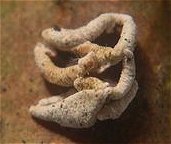
Spent the morning trying to find a nest of rats that have moved in. They must go! Managed to go for a quick spin around Speke Hall in the afternoon. Bits and pieces. The best bits being a collection of Schizophyllum amplum (Poplar Bells) on pruned Poplar twigs. They can be hard to spot as when they are dry they look like very small dried up Auricularia (Jelly Ear) or Chondrostereum (Silver leaf). And they can grow on quite thin twigs.
Friday 20th January 2017
Another sunny day. So I visited a new site, Stadt Moers Country Park, ten minutes down the motorway. Named after a German twin town, the site was a Corporation tip until 1990 so young woodland. Not expecting to find much, I was pleasantly surprised to record twenty four species. Most of the usual winter suspects were present, including Sarcoscypha austriaca (Scarlet Elfcup). It was some small conifer copses that were interesting. All produced Baeospora myosura (Conifercone Cap) on the cones and one copse held six groups of Lyophyllum fumosum. It is a very large site so I need to go back to see what else it has to offer.
Wednesday 18th January 2017
The rain has stopped so I have been out and about getting some hard exercise in while my golf is curtailed. I went back to Croxteth Country Park to explore a bit more of the woodland and improve my geography of the site. It was very wet after recent downpours and area I visited last week were almost impassable. I nearly lost one of my wellies in the mud. Not many fruitbodies showing. I spent a bit of time with some birders, identifying all the fungi photos he had on his mobile phone. I did find a resupinate on a stick that keyed out to Athelia epiphylla, a new one for me. Looks like many other white things on wood but it has distinctive spores many of which appear to be stuck together.
Tuesday 10th January 2017
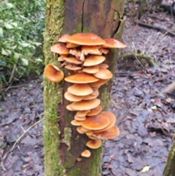
The day started well when I noticed a large patch of Clitocybe metachroa in the Asda car park shrubbery. The sun then came out, so I took advantage and visited the Eric Hardy Reserve. Even more difficult than my last visit as at least four more trees have fallen down. Impassable without commando training. Plenty of fungi about. I found Peziza arvernensis growing on a mossy branch of a fallen beech, at head height. A nice collection of Stereum pubescens on a dead tree. There were hundreds of Flammulina velutipes (Velvet Shank) on nearly every tree that was not still alive. Eventually I got tired of slogging through the mud so went home.
Sunday 8th January 2017
Speke Hall had opened their gates so I took the opportunity to wander round Stockton s Wood. Ususally good for Ascos but my finds were disappointing. One I found was a perfect fit for Parorbiliopsis minuta as shown in Peter Thompson s book. But when I checked the Internet I found a very long discussion on Ascofrance about this species. By the time I had finished reading the various opinions I was so confused that I have recorded it as Hyaloscypha unknown. I also found a late/early Melanoleuca polioleuca (Common Cavalier) hiding under a holly hedge.
Thursday 5th January 2017
A visit to Hale Hall and adjoining woods. Nothing unusual although I was surprised to find Leratiomyces ceres (Redlead Roundhead) still growing.
Wednesday 4th January 2017
Back to Croxteth Country Park for a bit more exploration. This time I chose Cocked Hat Wood. It has a bridlepath, along which, a pile of woodchips was supporting a group of Peziza vesiculosa (Blistered Cup). Nice to see as I have recorded very few Pezizas last year. I walked off the main path for a bit but it was mainly Rhododendron so not very promising. I did not realise the wood was so large. It took me one and a half hours just to walk round the perimeter. I noted that a path led off into another woodland, Ewans Park. This once private path joined Croxteth Hall (Lord Sefton) to Knowsley Hall (Lord Derby) and was used to visit each other. This will be my next expedition.
Monday 2nd January 2017
I went for a walk along the new Coastal Reserve beside the river Mersey. It was cold. The area is mainly a thick tangle of scrub and reeds. Good for birds. I had a poke around with my stick at various points and found nothing until I noticed some small white fruit bodies in a blackberry patch. I managed to get a couple out. After much microscopy and research, I eventually identified them as Hemimycena delectabilis. Not easy as the literature is sparse and they are very small to work with.
Friday 23rd December 2016
I walked to my local shopping street, about a mile. Lots of grass verges that are always worth inspecting. Mycena flavoalba (Ivorty Bonnet) under a cherry tree. Tricholoma scalpturatum (Yellowing Knight) under Tilia. I have found this locally a few times on roadside verges. These were immediately outside the main entrance to Tesco. Fortunately, it was windy so I do not think anyone noticed me skulking around waiting to pick a couple. I also found one penny in the middle of them. Good luck?
Thursday 22nd December 2016
Went to fill the bird feeders. Crossing the lawn I spotted a group of Arrhenia retiruga (Small Moss Oysterling) growing in the moss. I must inform Mrs. Mykogolfer that her lawn needs a bit of attention.
Wednesday 21st December 2016
Must continue to take advantage of the weather before storm Barbara arrives. I again visited my local park where I came across hundreds of Psathyrella piluliformis (common Stump Brittlestem) on a fallen beech tree. Although very common on beech, the most common of trees in this area, I rarely see this species.A poke through the oak leaves and litter produced Mycenas polyadelpha and stylobates(Bulbous Bonnet).
Monday 19th December 2016
A short cut through my local park takes me past a Polyepsis australis tree (Quenoa). Liverpool Botanical Society has a list of the trees in the park that they tell me were planted by the then owner who was a director of Cunard Line. The trees were specially brought from overseas, this one is Argentinian. Anyway it is covered with Coniophora puteana (Wet Rot).
Sunday 18th December 2016
Up to my allotment to pick some sprouts. I found Clitocybe vibecina (Mealy Funnel) along the boundary hedge. New for the site.
Thursday 15th December 2016
Back to Croxteth Park. Nobody there. I explored Mull Wood which is where I was taken when I first started my interest in fungi. I did not remember the wood being so big. Difficult to access as there are a number of ponds and very thick undergrowth. The ecology of this wood is typical for this area so the fungi are very much the same. Best finds were Grifola frondosa (Hen of the Woods) and a huge crowd of Hemimycena tortuosa (Dewdrop Bonnet). I only scratched the surface of wood and there are two other large woods to explore. I may spend a little time there next year now that my local golf course has been privatised and under redevelopment.
Tuesday 13th December 2016
I had to shop at the Co-op today. They have a couple of miserable flower beds that people use as ashtrays and for drinks tins. Despite this, Lepista saeva (Field Blewit) grows in them and has done for the past three years. A supermarket car park off a large roundabout on a main road. No fields there.
Sunday 11th December 2016
I visited Croxteth Country Park, somewhere I rarely go to even though it is only fifteen minutes by car. Once the home of Lord Sefton, the hall and grounds were sold to Liverpool Council. A lot of the estate went for housing and it is very popular with the local population. It gets busy and today was no exception as there was a Xmas Market. I managed to disappear into the woods. Not a lot of interest about, the best find being a small Pluteus podospileus which is new to me. Too many dog walkers so I went home.
Wednesday 7th December 2016
Another sunny day. Just time for a walk round Sudley Hall. To my horror the Council have swept the woodland clean. Not stick or twig in sight. So much for nature conservation. I did manage to find a couple of Lepista saeva (Field Blewit) by a path adjoining the football field. Knocked over of course. My other find was of Mycena olida (Rancid Bonnet) on a mossy stump. Difficult to separate from very similar species. It can only be done with a microscope. It is supposed to smell rancid but they are so small that I could not detect any smell when squashed. I had just washed my hands so the smell of soap won the day.
Monday 6th December 2016
Taking advantage of some sunshine, I went or a wander and ended up at the local crematorium. Behind the business end is an area of formal gardens and open land that I did not know was there. It has a boundary of mature Cupressus. As these provide shelter during cold weather, they invited closer inspection. I was not surprised to find a large colony of about fifty Geastrum striatum (Straite Earthstar), the third site for this species in my area. It is more common than Geastrum triplex. There was also a few very common species. My other interesting find was made when I raked through the drifts of fallen leaves in an adjoining park. Mycena polyadelpha is a tiny species growing on oak leaves. I must go back.
Monday 28th November 2016
I paid a visit to Hale Hall woods to check on my Lycoperdon utriformis. Just old blown fruitbodies now but at least I can check the spores. I did manage to resolve an identification of an amorphous growth on a fallen ash tee that has had me fooled since the beginning of the year. It is a Nodulisporium species. I can not tell which one but that is good enough for me.
Sunday 27th November 2016
The forecasted frost failed to materialise so I went to take a look at the lawns surrounding Speke Hall. They have been disappointing so far this year. Today there were lots of waxcaps but all the same species, Gliophorus laetus (Heath Waxcap). Very few other species to be seen and not many fruit bodies. Walking back through the woods I came upon a group of Infundibulicybe geotropa (Trooping Funnel), a species I have not seen for years.
Thursday 24th November 2016
At the request of Kew Herbarium, I went back to Ainsdale to find some Bovista pusilla. I have identified this before (as Bovista limosa) and sent a specimen to Kew. However that was based on literature that now seems confused and has been superseded. It needs looking at again. Unfortunately, a bright sunny morning in Liverpool translated to a very frosty Ainsdale. Lots of fungi about but all frozen solid. Trying to find a tiny frozen puffball was impossible. Pleasant walk. I never saw another soul all morning.
Wednesday 23rd November 2016
My local Aldi is very near Childwall Woods so I often pop in on the way home. Nothing very interesting but it does have its moments. Just not today. The old churchyard opposite produced Geoglossum fallax and Hygrocybe reidii (Honey Waxcap). Again a disappointing return.
Sunday 13th November 2016
I led the North West Fungus Group foray at Ainsdale Sand Dunes NNR. Heavy rain on Wednesday followed by warm weather and a lovely sunny day. I took everyone straight out to the dune areas and we were well rewarded. I have already recorded 116 species and more still being looked at at home. Highlights so far are Bovista pusilla ex limosa (Least Puffball) which is a speciality of these dunes but very hard to spot among the more numerous Lycoperdon lividum (Grassland Puffball). Arrhenia griseopallida, Omphalina galericolor var. lilacina (Dune Navel) and Melanophyllum haematospermum (Redspored Dapperling) were also collected. The area has such a variety of habitats ranging from mobile dunes to coniferous, beech, oak, alder and birch woodland that it can be a problem deciding which parts to look at. Weather plays a part as it can be a tad harsh out on the dunes in the wind and rain. But today was perfect.
Thursday 10th November 2016
My morning started with a visit to a friend's house. They look like Christmas trees? He had a fabulous collection of Honey Fungus. Fortunately he lives opposite the entrance to Calderstones Park so I went for a quick walk round. And very productive it was. Last week there was nothing there. This week it had exploded into life. Huge rings of Clitocybe nebularias and Lepista flaccida. Stars of the walk were Lepiota aspera (Freckled Dapperling) and a Cortinarius. I thought I had collected a Hebeloma. It was only when I got it home that I realised it was a Cortinarius. It had very small spores for a Cortinarius that happily limited my choice to only a few species. My conclusion is Cortinarius vibratilis.
Wednesday 9th November 2016
Driving back from the city centre, I dropped by the old Garden festival site. I never find much there and today was no exception. Pholiota gummosa (Sticky Scalycap) was all I found.
Wednesday 2nd November 2016
The weather was too good to miss so I paid a visit to the Sefton Coast, this time Formby Hills and the adjoining Recreation Area. The lack of rain is not helping. There was nothing at all in the pinewoods. There were lots of fruitbodies on the extensive dune heath but no variety. They were either Lepiota erminea, Melanoleuca cinereifolia (Dune Cavalier) or Clitocybe rivulosa (Fools Funnel). A few Tricholoma cingulatum (Girdled Knight) and that was it. Not much better in some Birch scrub so I decided to see if there was anything growing on the dunes. Formby Hills are high and steep. I had found nothing but sand so decided to give it up when I spotted two Phallus hadriani (Sand Stinkhorn). A liitle past their best but I have been trying to find this species for many years so I did not care. Mission accomplished. We could do with some rain.
Tuesday 1st November 2016
Another nice day so I went for a walk along the riverside promenade. There are a couple of miles of maintained amenity grassland so I was interested if anything grew on it. A couple of waxcaps, Hygrocybe pratensis (Meadow) and quieta (Oily) plus a few Mycena galopus var. nigra (Black Milking Bonnet) but not much else. It has been very dry. It was a pleasant walk.
Monday 31st October 2016
Outside my local Tesco Express is the stump of a cherry tree which is growing a healthy display of Gymnopilus junonius (Spectacular Rustgill). It is suspected of being hallucigenic. In the USA it is known as Happy Jack although there are suggestions there may be more than one similar species. I hope nobody feels tempted as there are a couple of highly dangerous Cortinarius that look very similar and I might be mistaken in my identification. Happy Halloween (All Hallows Eve).
Saturday 29th October 2016
Following my observations of grassland fungi at Wetherby, I decided to take a look at the North Lawn at Speke Hall, always good for waxcaps. Nothing. As it was also childrens' Haloween Day, I escaped to the nearby woodland surrounding a fishing pond. Some common Russulas (Brittlegills) a Genus that has been hard to find in any quantity this year. A nice group of Tricholoma sulphureum (Sulphur Knight) and Pleurotus dryinus (Veiled Oyster) in a cavity in a birch tree. A small Conocybe (Conecap) caused me some identification problems and eventually keyed out as Conocybe vexans. This group is not easy.
Friday 28th October 2016
I went racing at Wetherby today. Beside the stand is a largish patch of amenity grassland. It was covered in grassland species. I counted four species of Hygrocybe (waxcap), two Mycenas (Bonnets), lots of Galerinas (Bells), Panaeolus (Mottlegill), Psathyrellas, (Brittlestem), Coprinus comatus (Shaggy Inkcap), some Parasolas, what looked like Entoloma sericium (Pinkgill) two types of Conocybe (Conecap) , Clavulinopsis fusiformis (Golden Spindles) and a good quantity of Psilocybe semilanaceata (Magic Mushroom). Sixteen species in ten minutes from such a small space makes one wonder what else might be found on the rest of the racecourse. And I beat the bookies. A rare event.
Thursday 27th October 2016
A quick visit to a local wood. A couple of species new for the site but nothing of importance. The only interesting observation was of the very numerous number of Lanzia luteovirens that grows on the petioles of fallen Sycamore leaves. They were everywhere.
Wednesday 26th October 2016
I received a request from Kew for permission to use my photograph of Bovista limosa for an article about the Lost and Found project. This puffball is found at Ainsdale. I was lucky to find a young specimen together with one that was sporulating. Essentiial for identification. The species is probably common at Ainsdale as there are always lots of tiny puffballs around. Just cannot collect them all.
Tuesday 25th October 2016
A quick walk round my local golf course. Mostly a collection of Mycenas, including Mycena flavoalba. Most books describe it as a species of grassland. Mine was growing on a dead blackberry. The microscopics are good so can not be anything else. A new species for the site is Conocybe aporos. Under the same blackberry bush.
Sunday 23rd October 2016
North West Fungus Group foray at Moore Nature Reserve. We were joined by an enthusiastic naturalist group from Wilmslow. The Reserve is a mix of wet woodland, heathland and the bed of an old canal. I can only speak of my own contribution at this stage. My first find was one I had not seen before, Lepiota grangei. Then Hebeloma sinapizans (Bitter Poisonpie). Someone handed me a tiny species on an oak leaf that I have researched to Gymnopus quercophilus. New to me. We had some fun showing the naturalist group Ossicaulis lignitalis (Mealy Oyster) that has grown in a hole in the same birch tree for many years. Just too high for comfort. More identifications of interest are bound to come from such a large group. Watch this space.
Saturday 22nd October 2016
A couple of hours to spare before tea so I went to the Speke-Garston Coastal Reserve an area of rough grassland and scrub that once was Liverpool Airport. I did not expect much so was surprised to see lots of Hygrocybe conica (Blackeneing Waxcap). Also Lyophyllum decastes (Clustered Domecap) and a lone Volvariella gloiocephala (Stubble Rosegill). I must go back when the plantlife has died down a bit.
Wednesday 19th October 2016
I joined colleagues from Merseyside Naturalists at Freshfield Dune Heath. Part birch woodland and part heathland, pine and gorse, produced a good mix of forty species but nothing unusual. Dozens of Suillus luteus (Slippery Jack), Entoloma papillatum (Papillate Pinkgill) and lots of Lycoperdon nigrescens (Dusky Puffball). After lunch we moved acroos the railway for a quick walk in Ainsdale Sand Dunes Reserve. Coprinellus picaceae (Magpie Inkcap) was a first for the Reserve. We only found the stem but it is unmistakeable. As was Skeletocutis amorpha. turning apricot coloured as soon as it was picked. The area was very colourful as there were dozens of Amanita muscaria (Fly Agaric), some of the largest I have ever seen. Another 25 species recorded. Also of interest were groups of Pholiota gummosa (Sticky Scalycap) growing in the middle of the fairway of Formby Golf Club. Fore.
Wednesday 12th October 2016
I visited Halewood Triangle Country Park, so named because it once was where they manoeuvred the trains round at the end of the old Cheshire Lines. It is now part of the Trans Pennine Trail. Although only ten minutes drive, I rarely go there as a lot of it is fairly new and there is a lot of footfall. It surprised me this time. Two large groups of Lepista irina (Flowery Blewit), Gymnopilus junonius (Spectacular Rustgill) and Lacrymaria lacrymabunda (Weeping Widow) and a decent collection of more common species. Unfortunately my visit was cut short by heavy rain. I must go back soon.
Tuesday 11th October 2016
Have finished my last specimen from Dibbinsdale. They included two Tomentellas. I found one at Formby on a foray last year but could not identify it. The available literature is not helpful. One is a nondescript rusty brown but the other, grey back number was found on a muddy footpath. Some do grow on soil. The rusty one is Tomentella bryophila. The grey one is Tomentella fuscocinerea. Both have spores that look naval mines.
Saturday 8th October 2016
I joined Liverpool Botanical Society who were having a fungi foray at Dibbinsdale. A good start with Pluteus leoninus being one of the first finds. This is a very wet site with ponds and streams throughout. As the only mycologist present, I collected too may specimens. I have too many that I could not identify in the field. Quite a few are new to me. I have spent most of Sunday photographing the main features in the hope that I will identify them later. So far I have identified Ciboria batschiana that grows on acorns, Psathyrella multipedata (Clustered Brittlestem) Flagelloscypha minutissima and Tomentella bryophila. This last one has very spiny round spores. I have managed 55 so far. The one that has me fooled is a grey resupinate growing on soil. I am awaiting a spore print.
Friday 6th October 2016
I paid a visit to Speke Hall. It was so dry. The leaves were crackling under my feet. I found a number of Clitocybe rivulosa (Fools Funnel), one small Boletus edulis (Cep) and a few Psathyrellas (Brittlestems). I also found a tiny white Ascomycete that looked like the very common Lachnum virgineum but the spores were too small. Also another similar hairy white cup with long thin spores but they had no asci. Nor could I find any basidia. Both have me completely stumped. The joys of fungi foraying.
Wednesday 5th October 2016
I have been taking advantage of the dry weather to get my allotment into shape before winter sets in. I allowed myself an hour for a quick walk to a local park. Very dry. Not much to see. Except I found another Conocybe rugosa (Fools Conecap) on woodchip. The only other thing of interest was a Daedaleopsis confragosa (Blushing Bracket) that appeared to have Datronia mollis growing from it. I could not get any spores to confirm and on reflection, I think it is just an extension of the original fungus that has gone misshapen after falling from the tree.
Tuesday 4th October 2016
Having sorted out the finds from Ainsdale I went back to try and identify a fungus found last week on woodchip mulch in a local park. It did not register at all on Mycokey so I decided to follow my intuition. It looked like a Conocybe but without the cystidia with round heads. It also had a very wrinkled cap. I eventually tracked it down to Conocybe (Pholiotina) rugosa. It has bottle shaped cystidia. It is usually reddish. What threw me was that mine is golden brown and had no ring. It must have dropped off. To confuse matters, some authorities suggest it may be a form of Conocybe filaris (Fools Funnel). Anyway, job done.
Saturday 1st October 2016
I led a foray at Ainsdale Sand Dunes Reserve for English Nature. Thirty people turned up, all very enthusiastic. We did very well. All the usual suspects were to be found. Amanita muscaria (Fly Agaric), Paxillus involutus (Brown Rollrim), some Russulas (brittlegills), Lactarius (Milkcaps), and Leccinum scabrum (Brown Birch Boete). Heaven sent for a pubic foray. Then my audience became too enthusiastic and found three Inocybes and two Cortinarius. I have not yet identified any of them. I was very pleased to show them Henningsomyces candidus (White Tubelet). I seem to have my eye in for this one. They rewarded me with a huge Boletus edulis (Penny Bun) which has now been sliced for drying.
Friday 30th September 2016
A walk round a local park for exercise rather than fungi. A lot of grassland with the odd tree, mostly beech. My first waxcap of the year, Hygrocybe persistens, which is one of the earliest. I have never recorded it previously. Entoloma papillatum was another new species for the site. I had to cover a lot of grass before I found them. I usually stick to the wooded areas. So it was nice to find something new. Must do it again soon.
Sunday 25th September 2016
North West fungus Group foray at Maes y Pant, near Gresford in north Wales. An old quarry site. We had to work hard but the final list looks good and there was plenty of variety. A few I had never seen before but that is the point of visiting a different site. We have only just started to put a final list together but new to me were Lactarius chrysorrheus (Yellowdrop Milkcap) and Cortinarius alboviolaceus (Pearly Webcap). Lots of Helvella lacunosa (Elfin Saddle) and Suillus granulatus (Weeping granulatus). If anything else turns up, I shall keep you posted. Sadly, I think my camera is on its last legs as I had to take most of my pics on my scanner. Dear Santa....
Thursday 22nd September 2016
A quick walk to my local golf course. Lots of heavy machinery about. Some of my better areas have been decimated which is a shame. My first Russula nigricans (Blackening Russula) of the year under pine. Geatrum triplex (Collared Earthstar) in a new spot. Best find was of Henningomyces candidus (White Tubelet) under a very rotten log. I nearly did not spot it as the area is quite dark. It looked like dust but I suspected it might be a fungus. Since I got my eye in, I have found this quite often.
Tuesday 20th September 2016
I visited my favourite wood at Hale Hall. Still very dry and overgrown but the vegetation is starting to thin. My woodchip pile had been added to. Six large Ramaria stricta (Upright Coral) had set up home. Although said to be common, this is the only place I find it. Apart from four ageing Grifola frondosa (Hen of the Woods) under their usual Beech, there was not much else around.
Saturday 17th September 2016
Just got back from Barcelona. Too hot for foraying but some nice mushroom tapas. The allotment has grown well. I had to pick my pears before they fell off. The tree is not looking so good. It is infected with Gymnosporangium sabinae (Pear Leaf Gall). Like many rusts it needs a primary host plant, in this case Juniper, on which it overwinters. No Juniper on the allotment so I wonder where it is. According to the experts the way to prevent this damaging rust is to exterminate all Junipers near the pear tree. Not sure the neighbours would appreciate that.
Tuesday 6th September 2016
Todays short walk to the local golf course produces Xerula radicata (Rooting Toughshank), Lactarius subdulcis (Mild Milkcap) and Conocybe apala (Milky Conecap). Also a couple of Inocybes (Fibrecaps) but they were not in good condition. Sadly the new management is more concerned with building a new clubhouse so not a lot of maintenance on areas that are not part of the golf course. The grass is getting very long and the undergrowth very wild. Not looking good for the autumn.
Sunday 4th September 2016


Another morning of harvesting and clearing on the allotment. A quick walk to a local park in the sunshine. Not much to see. Incocybe sindonia under a beech hedge just where I parked my car. Scleroderma areolatum (Leopard Earthball), the first I have found in Liverpool for ten years. I wonder why?
Saturday 3rd September 2016
After a morning digging my allotment, I went for a quick walk around Stockton's Wood. Clitopilus prunulus (The Miller) in the grass on the edge. Lots of Russula ochroleuca (Ochre Brittlegill) and Lactarius tabidus (Birch Milkcap). A nice Amanita citrina (False Deathcap) under the brambles. A first find of Fistulina hepatica (Beefsteak Fungus) for this site despite there being a lot of dead and fallen oak in this wood. I also spotted a very healthy Laetiporus sulphureus (Chicken of the Woods) growing out of a cherry tree on the central reservation of the dual carriageway on my way home.
Thursday 1st September 2016
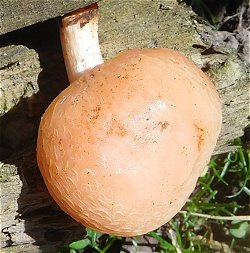
Today I went out to collect elderberries to make wine. My favourite spot is the Eric Hardy Reserve in Liverpool as it is away from the roads. However it is very muddy and tough going. My way was blocked by a couple of old fallen trees so I had to struggle round them. As I did so, I noticed what I thought was a small bracket, so I picked it. To my surprise it turned out to be Rhodotus palmatus (Wrinkled Peach). It was common on Elm but is now rare. I have no idea what the fallen tree was. It is my second find of this species in the Merseyside area, the last being on Ash. I assumed that because of the Daldinia also growing on the wood although that can not be regarded as a definite. Kew Herbarium took that one.
Tuesday 30th August 2016



I inherited a document about the findings of mycolgists on the Formby dunes in 1951. It is an area that the North West Fungus Group does not visit because it is difficult to access. So I had a look today. Nothing there but the area will have changed since 1951 due to erosion of the coastline. I decided to look for Taphrina alni (Alder Tonge) in the large Alder Carr at Ainsdale Sand Dunes Reserve. NWFG always foray at the wrong time of year so we never find it. Today I found it within five minutes. I then found an orange Suillus that I identified as Suillus bovinus (Bovine Bolete). My identification was helped because there were numerous Chroompgomphus rutilans (Copper Spike) growing in the same area. They are natural companions. Star of the day was a large ring of Leucopaxillus giganteus (Giant Funnel), a first for Ainsdale. Not many species but some good finds.
Friday 26th August 2016
A Bioblitz at Freshfield Dune Heath. I was asked to attend as I seem to be the only local mycologist. It is one of my favourite areas and I had high expectations after the recent warm wet weather. However, the heath was still very dry and the adjoining woodland was not much better. I only found twenty species and all were common. Of the three Boletus edulis (Cep) that I found, one was devastated by slugs and the other two way past their best. Highlight was a confrontation with a red squirrel who had wandered away from the NT Formby Squirrel Woods.
Wednesday 24th August 2016

On the allotment produce is being harvested. Nets and canes are being taken down. My neighbour has stacked his bamboo canes by his shed. I checked them and was pleased and surprised to find Astrosphaeriella stellata, my Asian alien, on the end of one. It was on the end that had been stuck in the ground. I kept a piece of cane from my original find. The fruit bodies are now dull and many have fallen off leaving small craters. On this new cane, the fruit bodies are bright and there are hardly any craters. This suggests that the growth is from this year. Having sawn the specimen off, I have stuck the cane back into the soil to see if I can grow it.
Saturday 20th August 2016


My plans went awry as the rain lashed down. When it eventually stopped, I went for a quick walk. Nothing much to record. Then it rained again. I was sheltering under a willow tree and spotted a couple of tiny white bits on the mossy trunk. I thought they would be Ascomycetes. When I put them under a microscope, I saw that they were gilled. They were Mycena corynephora. Just 129 records on FRDBI but the caps on mine were only 2mm and the stems 4mm. Without a microscope you would never be able to see the unique cystidia. My pics are x 40 so it shows how small they are. No wonder they are rarely reported.
Wednesday 17th August


Lots of problems sorting out the Scutellinia (Eyelash) fungi. Apprently the common one, Scutellinia scutellata is not common any more. It is now Scutellinia crinita that is found. It seems to depend on the length of the hairs. There is a 1990 key by Schumacher that gives more detail. Peter Thompson has details in his book. The paraphyses stain purple with iodine, which mine did. There is a newer draft key by Yao from 2015 but this does not mention crinita even though it is a species recorded in the National Database. Curious.
Sunday 14th August 2016


North West Fungus group foray to Delamere Forest. I had not been there for years. It was very dry on the surface and still lots of undergrowth to negotiate. An interesting find of an albino Psathyrella. Many years ago I found one on my allotment. I identified it as Psathyrella gracilis form substerilis as described by Kit van Waveren. Gracilis is now corrugis and it seems the white form is now regarded as a synonym. Another find was Tarzetta catinus hiding under the bracken. I also identified both Leptospheria acuta and dololium on dead nettle stems. Usually only one of this genus is found on site. I now have a couple of Scutellinia (Eyelash) fungi to look at. I am told the genus has been revised but am not sure where to find the latest documentation.
Friday 12th August 2016

My local golf course, that I visit frequently, was run by the Council. Due to lack of funds they have handed over the running to a private company. It is now a private golf course. There is a public right of way through part of it but I have always wandered at will. Now there are notices to stick to the path which they have helpfully churned up with heavy machinery. And they have dug a cable trench through one of my favourite bits. I have sent a letter asking permission to wander 'off piste' but have not yet been graced with a reply. Over to the adjoining park, I went to see if my Geastrum striatum (Striate Earthstar) were still thriving. I am pleased to say they have increased in number. I stopped counting at sixty. They are still in the same enclosed area no bigger than 10 x 4 feet. Not much else. A couple of Gymnopus peronatus (Wood Wooly Foot) and Scleroderma bovista (Potato Eartball) and that was it.
Sunday 7th August 2016
North West Fungus Group foray to Pennington Flash, a large lake that formed after colliery subsidence. A new site for the Group, I had visited once about ten years ago. The woodland was very dry despite the presence of the water and recent rain. Not so many higher fungi about but we did manage to exceed fifty. Of note was Hebeloma birrus. Not one I have seen before but obviously different from the more common species. Xerocomellus engelii with orange spots in the stem. Postia stiptica (Bitter Bracket) and tephroleuca (Greyling Bracket). And three Sclerodermas (Earthballs), citrinum (Common), verrucosum (Scaly) and bovista (Potato). I did a few dead stems and our rust expert attended so a few more will be addeed to the list. It was a bit windy but a nice day out.
Tuesday 2nd August 2016


When it stopped raining, I went for a walk to one of my parks. Not much about. I pulled some dead stems of Senecio jacobaea (Ragwort). They all had lots of the Ascomycete, Mollisia clavata growing on them. Also a very, very tiny white hairy thing. I managed to extricate a couple to discover that they were Lachnella villosa, a Basidiomycete. Passing a woodchipped shrubbery, I saw a large group of Clitocybe fragrans (Fragrant Funnel). They did not smell but I have noticed this with previous finds. Beside them were two grey fungi that I thought were Entolomas from the small size and that the gills were pink. However, the spores were wrong. I eventually identified them as Pluteus cinereofuscus, an uncommon woodchip dweller.
Monday 1st August 2016
Two days ago I found eight species in a small beech copse. Today, same habitat but two different parks, only one specimen. Interestingly it turned out to be Russula sororia (Sepia Brittlegill). There is a very similar Russula amoenolens. The difference is in the reaction to guaiac and iron sulphate chemical tests. In the case of sororia the reactions are weak.
Saturday 30th July 2016

A busy day on the allotment. When I finished I paid a visit to Sudley House, former home of a shipowner, now a local museum. There is a small copse of mainly Beech that often supports early species, sometimes uncommon. Today's collection included Russula fellea (Geranium Brittlegill) and Xerula radicata (Rooting Shank). Best of all, a group of Inocybes that I did not recognise. Scaly cap with a wine red tint as had the stem. The smell was sort of unpleasant scented commercial soap. The nearby town of Widnes makes soap and the smell often drifts to the surrounding countryside. I recognised that smell on these Inocybes. Incobe erubescens (Deadly Fibrecap).
Tuesday 26th July 2016

My walk along the coast on Saturday proved very interesting. We found only two species. The first, looking like a Psathyrelle, has been identified as Conocybe dunensis. The other is the Inocybe. Not lacera. It became a choice between Inocybe agardhii and dulcamara, both sand lovers. I had to contact Penny Cullington for further information about the Inocybe Key before I could get any further. She helpfully pronounced them to be agardhii. The key to identification is the ring like cortina at the top of the stem.
Saturday 23rd July 2016
I joined Liverpool Botanical Society at Birkdale Hills on the coast for a walk along the dunes. This part of the coast is more a low sand bank than high dunes and can be covered by the sea at very high tides. Magnificent for flowering plants with many a rarity. Not much in the way of fungi. A few Inocybe lacera (Torn Fibrecap) in the creeping willow and a small brown job in sand that needs research. This area is also one of the main breeding areas for Natterjack Toads and we found a few baby ones crawling through the undergrowth. First time I have seen one.
Friday 22nd July 2016
A quick visit to Speke Hall and the adjoining woodland. Almost a fungi free zone. A couple of common Russulas (Brittlegills), ochroleuca (Ochre) and fragilis (Fragile) ,the smell of stinkhorns and that was all. It is very overgrown, mainly with brambles so I will have to wait until it starts to die back before visiting again.
Thursday 21st July 2017
Driving past a wide central reservation, I noticed some Amanitas. In 2010 I made my first find of Amanita franchetii here so I had to take a look. There was at least a hundred fruitbodies stretching for fifty yards, a considerably larger area than my first find. This particular central reservation is really a piece of parkland left from the estates of the Liverpool merchants before urban spread and supports a mix of mature trees. This is the second central reservation on which I have found this species. Also present was Boletus erythropus (Scarletina Bolete), although I am at a loss as to what the current name of this species now is.
Monday 18th July 2017
I went for lunch with some friends. They told me that I am on YouTube. They keyed in Tony Carter-Fungi and there I was. It was of a family foray I led for the National Wildflower Centre in 2013. I did not know it had been filmed. You would think someone from NWC would have told me. I do remember this strange chap who stayed aloof from the group. Never joined in at all. He must have been filming. I also remember that it was he who stood on and squashed my Amanita muscaria (Fly Agaric), that I had brought from my golf club specially to show the kids.
Sunday 17th July 2016

Unable to attend the North West Fungus Group foray, I had to content myself with a walk through a local park. Lots of woodchip had been laid resulting in hundreds of Psathyrella microrhiza (Rootlet Brittlestem), Leratiomyces ceres (Redlead Rondhead) and a large patch of Peziza vesiculosa (Blistered Cup). One had me fooled until I put it under the microscope. Agrocybe putaminum (Mulch Fieldcap), a recent addition to the woodchip lovers' list. Finally a couple of perfect Agaricus arvensis (Horse Mushroom) under some pines. Breakfast.
Thursday 14th July 2016
I have tendonitis so still unable to swing a golf club. Am struggling changing gear so it is bus, train and foot which is a bit restricting. A short cut through a local park produced Russula amoenolens (Camembert Brittlegill) and Russula subfoetens. They look similar but the first smells of cheeses, the other a sort of off colour fruity smell. There are different microscopic features. The roadside verges are starting to show fungi. A huge patch of Amanita rubescens (Blusher) in clumps on a dual carriageway together with Paxillus involutus (Brown Rollrim). I spot them from the bus and then go back to see what they are. Some interesting ones at the library. I must go and borrow a book.
Sunday 10th July 2016

I joined Cheshire Group at Mere Sands. It is years since I visited this site. Quite a bit around. A total of 66 species identified. A Russula (Brittlegill), a couple of Lactarius (Milkcaps) and Xerocomellus (Boletes). Also a nice collection of Tarzetta catinus (Toothed Cup) and Helvella macropus (Felt Saddle). I also collected a few dead stems and immediately recognised Flagelloscypha minutissima on Foxglove. I had to confirm it later under a microscope but I can now tell it apart from Lachnum virgineum. We were further surprised when we also found it on a small twig and a Hogweed. These made five finds in two weeks. Is it because I am better able to identify it or is it increasing? We finished early so Fungalpunk Dave, leader of the Cheshire Group went off to Ainsdale to look for the rust, Chrysomixa pirolatta on Wintergreen. It is one of the species in The Lost and Found Project. Following my directions, he found it. So a good day all round.
Friday 8th July 2016


From our recent foray to Clock Face, St. Helens, I have eventually identified Flagelloscypha minutissima. It was on a dead thistle stem. Even with a decent magnifier, it looks like Lachnum virgineum, of which there were lots on various substrates. That is what I originally thought it would be but for some reason took it home and, after two weeks, got round to checking it, just in case it was subvirgineum or niveum. Under a microscope, I could not find any asci and it had long pointed rough hairs. So not a Lachnum. Finding basidia requires much patience. From yesterday's walk along the Sefton Coast, I took a dead hogweed stem to check out a Lachnum. Wrong again. It turned out to be Flagelloscypha. There was something about the two samples that influenced me to take them home and look at them more carefully. To my eyes the Flagelloscypha seems more woolly than hairy. I do not think it is rare as I have recorded it six times. It is most probably overlooked as it is so tiny.
Thursday 7th July 2016

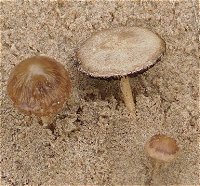
I have injured my shoulder so can not play golf. Needing the exercise I decided to walk the coastal dunes from Blundellsands to Hightown. Varied habitat, grass meadow, sand dunes and finally estuary reed beds. Not a lot about but everywhere is overgrown. Even a marked path on the Sefton Coastal Path was almost impassable. I must buy a machete. I did pick some interesting dead stems along the way, in particular from Angelica which is prolific at the Hightown end of the estuary. The stems all have Ascomycetes on them but they are probably the usual ones that grow on all stems. Gives me something to look at on a rainy day.
Saturday 2nd July 2016
I joined Liverpool Botanical Society who were visiting the local Childwall Woods. The main interest of the day was grasses of which I know next to nothing and struggle even when I have a book in my hand. Lacymaria lacrymabunda (Weeping Widow) and Crepidotus cesatii were the only higher fungi on show. I did collect a lot of dead stems from plants I would not have been able to identify without the expert help on hand. My one disappointment is a rust on Cocksfoot grass. It supports four different rusts and I can not find any spores.
Thursday 30th June 2016
I spent most of the day on my allotment and went for a walk to my local golf course to wind down. Lots of Marasmius rotula (Collared Parachute) on bits of wood and twigs. I walked through a small copse of pine and found Otidea bufonia (Toad's Ear), a new species for the site. This one that can only be identified with a microscope. It is the only Otidea with hairs (so they say). Then, under the next tree was (had been) a huge Agaricus augustus (The Prince). Of course, someone had just kicked it over. I salvaged it as it is one of the best edible mushrooms. It measured 22cms aross, 12 cms high and weighed 450 grams. I wish I had seen it before it was vandalised. Anyway, it is now soup.
Wednesday 29th June 2016


I intended to spend a bit of time at one of my favourite woods at Hale. After twenty minutes it rained so hard I abandoned my visit. I did spot a dead nettle stem that was pure white to find it covered in Lachnum virgineum (Snowy Disco). I have never before seen so many so tightly packed on one stem. Also Scutellinia scutellata (Eyelash Fungus) on a fallen Ash trunk. Then I had to run.
Tuesday 28th June 2016

Allotment this morning. A rush to pick raspberries, loganberries, redcurrants before the rain spoiled them - again. My neighbouring allotment is in a poor state, the tenant having been ill. Last year he grew a squash Cucurbita ficifolia (Figleaf Gourd or Shark Fin Melon). They have now gone rotten. Growing on the skin I found Volutella ciliata. Common fungus. Unusual host.
Monday 27th June 2016
My golf club produced Gymnopus peronatus Wood Wollyfoot) and Sceroderma bovista (Potato Earthball). A local park produced Boletus chrysenteron (Red Cracking Bolete). This one is now regarded as uncommon but it is a regular find in my local parks which do have a fair collection of Pine and Beech, often together. The details fit the key by Geoff Kibby. My allotment has a large patch of Marasmius oreades (Fairy Ring Campignon) growing on the main path. Things are looking up.
Sunday 19th June 2016
North West Fungus Group held a foray at Clock Face Country Park, St Helens. Still early so we did not expect too much. Nevertheless we recorded a good number with lots still to be examined at home. Finds identified so far include Tricholoma scalpturatum, Leocarpa fragilis, Peniophorella praetermissima, Tomentella fuscocinerea, Agrocybe semiorbiularis and pediades. We collected a few dead stems from nettles and thistles which have already added to our species list. More still to come.
Tuesday 14th June 2016

Holiday abandoned because of an airline strike so I had to play golf instead. A few Agrocybe pediades (Common Fieldcap) in the rough and Coprinellus disseminatus (Fairy Inkcap) in moss round the base of a tree. Fortunately I forgot to throw my nettle stems away so had something to examine at home. Still things growing and I added Belonidium sulphureum to my list. There are still lots more to find so I may continue with my dead stem collections until the main season starts.
Friday 10th June 2016



Am off on holiday for a week so had to dispose of my bits of nettle stem. Amazingly, they are still growing fungi of all sorts. The latest finds are Acrospermum compressum (like Dead Mens Fingers), Crocicreas dolosellum (a goblet on a stem) and Laetinaevia carneoflavida (looks like Calloria neglecta but is smaller). The lazy way to mycology. Just pick dead stems and see what grows. I was very surprised at the number of different species. And it is obvious from the different spores that there are others present that I have not been able to identify. Yet.
Wednesday 8th June 2016
I played golf in a competition today so no time for fungus hunting. However, despite the scorching hot weather, the coolness of early morning persuadede a few to show themselves. There were dozens of Coprinopsis lagopus (Haresfoot Inkcap) in long grass along one of the fairways. Also a dozen perfect Agaricus arvensis (Horse Mushroom) under some birch trees. Unfortunately, I was unable to stop and pick them. Finally a group of Agaricus xanthodermus (Yellow Stainer) in their usual home on one of the teeing areas. I was able to show my playing partners how not to poison themselves.
Sunday 5th June 2016



The weather in Liverpool has been scorching for the past few days. At last we had a thunderstorm last night. First rain for ages. No fungi about and I have been kept busy watering my allotment. I have continued collecting dead nettle stems and giving them a soak. Someone has to do it. I have even moved up to Heracleum (Hogweed). The nettles produced the expected Calloria neglecta. Also Discocistella grevillei. The hogweed grew Mollisia clavata. The problem is that a number of species grow on the same stem, some very tiny. It can be difficult to separate the fruit bodies and decide which spore comes from what. I have photographed most of them and shall sit down this evening with Ellis and Ellis to see if I can identify them. I might get lucky.
Wednesday 1st June 2016
At last my golf course is growing some fungi. Amanita rubescens (Blusher), Bolbitius titubans (Yellow Fieldcap) and Agrocybe praecox (Spring Fieldcap). I also increased my dead nettle stem collection with Calloria neglecta and Leptosphaeria acuta. I do not usually have time to collect any Ascomycetes when playing golf but we had to wait for the people in front. These additions bring the total number of species at my golf course to 420.
Wednesday 25th May 2016
Golf today but nothing to be seen. I am playing quite well so no unplanned visits to the trees. While waiting to play I grabbed a handful of dead nettle stems. After soaking overnight, I identified Lachnum virgineum, Leptosphaeria dololium and more Periconia. In the afternoon I cut a load of dead wood from an old Symphoricarpus (Snowberry). Quite a bit of Peniophora lycii on the branches. I think it is on its way out.
Monday 23rd May 2016

We have had some heavy showers over the past few days. The sun came out so I had a walk round my local golf course. I spotted some Calocybe gambosa (St. Georges Mushroom). The rest of my finds were all tiny and all found on dead nettle stems. These included Calyptella capula, Hymenoscyphus vitellinus, Leptosphaeria acuta and Periconia byssoides. The last one looks like hundreds of tiny black pins all over the stems. I also noted that the Stinkhorn eggs I saw at the end of January were still in situ but no development yet.
Sunday 15th May 2016



I joined the NWFG foray at Styal Woods, a National Trust property. As expected for this time of year, not many gilled fungi to be found. We did find some very interesting piles of wood and sticks that delivered up some uncommon Ascomycetes including a Vibrissea. Still working on them at home. Two photogenic finds were Polyporus tuberaster and a splendid slime mold, Lindbladia tubulina, looking like caviar on a tree trunk.
Saturday 14th May 2016
I briefly joined Liverpool Botanists who were holding a bioblitz at Speke Garston Coastal Reserve. Once part of the old Liverpool Airport on the banks of The Mersey, part has been annexed to Speke Hall as a nature walk. It is rough grassland and was very overgrown and dry so not much of interest for me. I found a couple of Ascomycetes, on on the dead stem of Phragmites australis. I had difficulty identifying it as the spores were too small for the more common species. Fortunately I found someone on Ascofrance.com with the same problem. The answer is Lentithecium arundinaceum.
Friday 13th May 2016
Golf today. At last I found Calocybe gambosa (St. Georges Mushroom) on the course. Only a few in a regular site but nothing in the other usual areas. And they are very late this year.
Thursday 12th May 2016
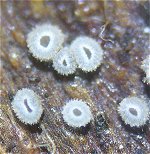
I finished hoeing my allotment so went for a quick walk to a local wood. A rummage in a pile of dead blackberry twigs produced lots of Lachnum virgineum, Mollisia clavata and Hyaloscypha fuckelii. A few spots and pimples to look at but not bad for 15 minutes.
Thursday 5th May 2016
At last. Calocybe gambosa (St Georges Mushroom). I am assisting The Biodiversity Project in Merseyside. They visit various local nature reserves to record wildlife. This site, Carr Lane Woods at Prescot was on the list. A small wood and fishing lakes split off from the local golf course when the M57 was built. Despite the ponds, it was very dry and clearly well maintained. All the dead wood was too big to move. A few Conocybe aporos and that was it. Might be better in the autumn.
Wednesday 4th May 2016
Golf today. Scorching hot this afternoon. At last, a fungus. Twelve Conocybe aporos, a species with a ring, on a mulched flower bed where I parked my car. But that was it. Still no St. Georges Mushrooms to be seen.
Monday 2nd May 2016


It poured this morning. Then the sun came out so I paid a quick visit to one of my favourite haunts at Hale Hall. I managed to beat the Bank Holiday crowd. Some interesting finds. The remains of old Calvatia gigantea (Giant Puffball) on a woodchip pile. A heap of grass cuttings and leaves produced Cheilymenia theleboloides in large quantities. There was also a lot of small pinkish things scattered on the same pile. It is not an Ascomycete but has spores. I have no idea what it might be and can only hope that something will turn up in the literature. A Mollisia with a yellow centre and darkish exterior also has me puzzled as the yellow turned to grey after I got it home.
Friday 29th April 2016

Terrible weather so I finished off my identifications from Monday. I found some tiny all-white fungi growing out of a fallen branch and also growing on a dead leaf. I first thought a young Crepidotus epibryus but the spores were wrong. The spore print appeared to be white. So I tried for Mycena. But it had a four spore basidia and I could not find any typical cheilocystidia for adscendens or corynephora. A closer look at the spores and I could just make out a line through the middle. It reminded me of a Clitopilus spore. So I looked them up and there is a Clitopilus hobsonii. Striate spores. You can just see them on the photo if you look carefully. Then it gets more difficult. My spores are 8-9.5 x 5-6.5 (7) which is said to be too big in some books. One book suggests that the larger spored variety is Clitopilus daamsi for which there are only 4 records. Personally, I am not convinced when species are differentiated by spore size alone especially when the difference is not that great, as here. I shall stick to hobsonii.
Monday 25th April 2016
I joined members of The Biodiversity Project on a visit to Goyt Hey Wood that adjoins Carr Mill Dam. A regular foray site for NWFG, I had not been there for a couple of years. The reason being the rapid and unchecked encroachment of Himalayan Balsam that restricted any search for fungi. Although we have not had much rain recently, the area is naturally wet and still flooded in parts. Despite this my finds were disappointing. Hemimycena tortuosa (Dewdrop Bonnet) and an immature Crepidotus being the only gilled finds. Not much of anything else either.
Thursday 21st April 2016
The Merseyside Naturalists are visiting a local nature reserve at Pex Hill Observatory near Widnes on Saturday. As I was in the area I popped in to see if it was worth joining them. I had not been before. It is small with a number of stunted oaks. It also has a disused quarry. It is sand stone. It was very dry after only a few days of hot weather. It is also very tidy. Not a piece of fallen wood to be seen, although a lot of this seemed to have been used to create natural barriers. It was also a bit too doggy for my liking. I found nothing. The volunteers also told me that in summer the bracken, now dormant, grows to six feet high. I shall cross this one off my list of possible foray sites.
Saturday 16th April 2016
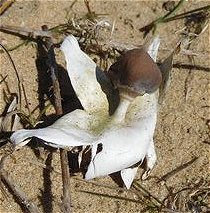

Having been told by the Reserve Manager that he had found 24 morels, I was joined by two colleagues and the seven year old son of one of them for an assault on dune slacks. We found them. Most of them were in areas I have not been to before. The benefit of taking an adventurous 7 year old whose eyes are closer to the ground than mine. They were a long way out and we would never have made it last Sunday unless we had gone directly there. Hard walking and two metal gates to climb. We found over a dozen Morchella elata (Black Morel), all very fresh. Also lots more Geastrum pectinatum (Beaked Earthstar) which seems to prefer the tops of the sand hills. Also a good number of Melanoleuca cognata (Spring Cavalier). And the weather was beautiful.
Thursday 14th April 2016
I played golf today. There is nothing showing on the course which seems strange when compared to what I have found on other sites. I have just received an Email from the Site manager of Ainsdale Sand Dunes Reserve that he has counted ten fresh Morchella elata (Black Morel) on the very dune slack that I visited last week but found nothing. So I did not take my foray party there on Sunday. There again, it is a healthy hike out to this area so we probably would not have made it.
Tuesday 12th April 2016
I joined a Biodiversity survey at the grounds of the old Rainhill Hospital (now demolished and turned into a Local Wildlife Site). I had not been to this site. There are no previous fungi records. It is a fairly large woodland. No sign of anyone tidying up the fallen wood so there was a lot of promising material. Standard stuff for the time of year but plenty of it. I identified thirty species on site and collected a further dozen. Although there were no people around during our visit, there is evidence of heavy footfall, the area being surrounded by houses. Also the ground seems solid, perhaps the foundations and paths of the old hospital. I shall certainly return in the autumn.
Sunday 10th April 2016

I woke up to a heavy frost. I was worried it might spoil my foray to Freshfied and Ainsdale. The day turned out to be a beautiful spring day. A dozen enthusiasts attended. Lots of fallen wood. Lots of crusts, brackets and ascomycetes. A few gilled fungi such as Clitocybe fragrans (Fragrant Funnel) and the odd Panaeolus (Mottlegill). A nice Calyptella capula on an unknown piece of vegetation was found in the dunes. Everyone enjoyed the day. As one said, the area is so nice that one could spend days just walking around. We spent a little time chasing butterflies. I came back with a full box as usual so am praying for rain so that I can get on with them without distraction.
Tuesday 5th April 2016
I decided to revisit the local Eric Hardy Nature Reserve. It is split into upper and lover levels, the lower having a stream that floods and turns the paths into quagmires. This is regularly impassable in winter. It was muddy and passable but the way was instead blocked by a dozen or so trees that had been blown or just washed down from the upper level. It was more like an assault course. I managed to get through but I fear this favourite site may become off limits. I would not go there on a windy day. Lots of fallen wood but not many specimens to be found. Probably too fresh. Nothing unusual identified.
Thursday 31st March 2016


Just returned from my annual springtime pilgrimage to Ainsdale Sand Dunes Reserve to see if any morels had grown. Lots of fallen damp wood so I made a small collection of Ascomycetes and crusts but I could have spent all day in one spot. I came across four patches of Clitocybe vermicularis, a speciality of Ainsdale. A couple of Melanoleucas. But sadly no morels even though there was plenty of water in the slacks. But Ainsdale never disappoints. There were hundreds of the usual Geatsrum triplex on the dunes. When I sat down for lunch, right beside me were two Geastrums (or is it Geastri), that are not triplex. The distinctive spores show it to be Geastrum pectinatum. New to Ainsdale and me. I know it has been found in Anglesey so one to look for again.
Tuesday 29th March 2016


I had been digging my allotment so popped over the road to my local golf course to wind down. Someone had kindly piled some sticks and leaves so I could not resist a rummage. Four obvious Ascomycetes. Under the microscope, I identified the very common Rosellinia aquila but the other one had very long points on the ends of the spores. This keyed out as Rosellinia thelena. A new one for me. Another find turned out to be the minute Basidiomycete, Hemmingsomyces candidus. Looks like fine sand to the naked eye and can only be identified with a microscope. Said to be common, I have found it before on this site.
Sunday 27th March 2016

The weather was dreadful so I was able to look at the finds from Friday. I did well with Ascomycetes. I identified nine species including Hyaloscypha leuconica, one that grows on pine. Most of the pine in Liverpool is in public parks where the fallen wood is tidied up. Nice to find some logs and branches to have a look at. I had a lot of trouble with Orbilia coccinella because I could not isolate a spore size. Then I realised that this grows on old Sphaeriales. So I looked again and there was Chaetosphaeria myriocarpa. This was where the spore confusion came from. Silly me. Not much luck with the crust fungi which steadfastly refused to give spore prints. I shall try again.
Friday 25th March 2016
Such a warm sunny day but everybody and his dog was out. I could not find a parking space at my usual haunts. However there is a little known narrow stretch of woodland alongside Speke Hall which is only accessible if you know where the hole in the fence is. I do. Mixed woodland with lots of pine and lots of fallen wood. Nobody to tidy up. I found an Ascomycete under nearly every piece I picked up. And a good collection of crusts. As the weather forecast is terrible for this weekend, it will give me something to look at.
Tuesday 22nd March 2016
No rain for well over a week has now left very dry conditions. I paid a visit to Pickerings Pasture, a fairly new local nature reserve on the banks of the River Mersey at Widnes. I did not find much, because of the tinder dry conditions. Amazing when you remember all the rain we have had. The site is small and the trees young. There is a lot of fallen wood in the copses. There is a large expanse of grass heath. It definitely has potential and I shall pay another visit in the season. It does suffer from popularity with dog owners. I shall never understand the mentality of people who hang their black plastic bags on bushes.
Saturday 12th March 2016


Three days without rain. I went for a stroll around Speke Hall. Amazing how quickly this site dries out. Lots of prunings in heaps. Schizophyllum amplum (Poplar Bells) was still there but hardly recognisable as it had dried up so much. A few crusts and microfungi but no gilled species. A few months ago I identified a tiny specimen growing on a twig as Pachnocybe albida. Under a microscope it looks like a tree. I found another similar looking fungus today. My earlier find has elliptical spores but these were round. So I am stumped. But according to my Ellis & Ellis book the species needs taxonomic revision anyway.
Saturday 5th March 2016
The slight dusting of snow on the Costa del Liverpool soon disappeared and turned into a lovely spring afternoon. The paths in the local nature reserve were muddy and unpassable so I cut through the woods. Stacks of fallen branches and twigs. A few fallen trees, mainly birch. Disappointingly, hardly any fungi. Just a few common resupinates and only one Ascomycete, Mollisia cinerea. I shall certainly take another look later in the year although it is likely to become overgrown and impenetrable by then.
Tuesday 1st March 2016

It did stop raining eventually and turned out to be a sunny spring afternoon. I went to Hale Hall woods. It is managed so there are piles of sticks all over the site. Rummaging around in one pile, I found a very small Mycena attached to a twig. In another pile, I noticed these tiny tiny fungi on rotting oak leaves. The second lot had 4 spore basidia, cheilocystida with short spines, cap hyphae looking like a hedgehog, some had hardly any gill. Consulting Cullington and Aronsen, the conclusion is Mycena polyadelpha. Photos not good but they show how small this species is. The first Mycena had cystidia with 3 to 4 long finger like attachments, smaller spores but also hedgehog cap hyphae. This I have identified as Mycena mucor. No photo as I only took one thinking it might be adscendens. Both are rarely reported but not surprising due to their size and that they hide in piles of sticks and leaves.
Saturday 27th February 2016

A good turn out at the North West Fungus group AGM to welcome our new President, Geoffrey Kibby. He gave a very interesting talk about the rise and demise of various species due to warmer temperatures, pollution and the increased use of woodchip. We went for a quick walk round Risley Moss. Not a lot about but we did find Helvella acetabulum (Vinegar Cup), a spring species. I had not seen one before. I thought it was a Disciotis venosa but fortunately someone was on hand to put me right. The ribbed stem is very clear.
Saturday 20th February 2016

The frost had disappeared so I went for a walk in Stockton's Wood. The National Trust had been tidying up again. Lots of twigs and branches in piles. Evidence of a bonfire. I managed to turn over a couple of larger pieces of tree. Tapesia lividofusca, shown here with a visitor. Hyaloscypha daedaleae, a small white cup, new to me. Also another Hyaloscypha type but I could not identify it to my satisfaction. Still stuff about but you have to search hard for it.
Sunday 14th February 2016

A beautiful spring morning. Sun shining. So I went for a walk round my local golf course. Lots of fallen wood which has been stacked along the boundaries as a barrier. A bit young for fungi now but looks good for the future. Not much around but I did find Mesmodes anomala. This is another tiny Basidiomycete that looks like an Asco. When dry it looks like a brownish crust. When wet it blossoms into small hairy cups. It looks very much like the Episphaeria I found last week. You can see a difference in that the centre of the cups of Episphaeria are yellow. Mesmodes are grey. The spores are different.
Friday 5th February 2016

Heavy rain forecast so I had to get my broad beans sown. I also managed to dig out one of my compost bins. While doing so I noticed some tiny white blobs on a piece of stem, runner bean this time. I took it home and have identified it as Volutella ciliata. Very common on dead stems during the winter but so small it is hard to spot. Interestingly, I found something similar on a piece of wood at Speke Hall on Wednesday. However, according to my books, this Volutella does not grow on wood and the spores on these were round not elliptical.
Wednesday 3rd February 2016

Golf course closed but it was a sunny afternoon so I went for a walk round Speke Hall, where they have very kindly piled up all the branches that have blown down. This time I came up with Episphaeria fraxinicola. Very tiny, it looks like an Ascomycete until you examine it under a microscope and realise that it does not have any asci but has basidia. There are not many records for it but it is very small (my photo is x 400). I have found it before. Perhaps Liverpool is an Episphaeria hotspot.
Sunday 31st January 2016

I braved the light rain to get out of the house for a bit. Unfortunately I was not out long before it threw it down. Lots of Sarcoscypha austriaca (Scarlet Elf Cup) so spring is in the air. Conversely, hidden away under a pile of cut logs, I found three eggs of Phallus impudicus (Stinkhorn). So is it still autumn? Very confusing weather. I must keep watch to see if they develop.
Wednesday 27th January 2016

High winds but very little rain here so I took advantage and went for a walk. The local golf greenkeepers have been out collecting all the dead wood from the course. They have put it in a big pile. How considerate of them. I could not resist a search. The problem is that if I do find something, I have little idea what tree it has come from. I did manage to find Hyalopeziza millepunctata, new for the site. Makes a change from the usual Mollisias.
Tuesday 26th January 2016
I recently wrote a survey report in which I explained to the recipient that fungi were very fleeting and that it was not possible to produce a comprehensive list without numerous visits. Today, as the promised floods had not arrived in Liverpool, I went back to the park to see if I could photograph the spectacular collection on a felled beech tree that I recorded only four days ago. They had all gone. Dried up completely. What a disappointment. I did find some Mensularia radiatus on a fallen Alder by the boating lake, a first for the site, so all was not lost.
Monday 25th January 2016
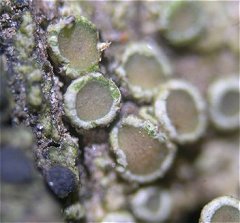
I picked up a stick because it seemed to have a pink/red fungus growing on it. I could get nothing from it. But I also noticed a tiny green cup on a bit of lichen. I have identified this as Lecanora chlarotera, a lichenous fungus. Interestingly, there are a number of adjacent black cushions that have the same spores. I assume that it is part of the cycle but have not been able to find any literature to explain this.
Saturday 23rd January 2016
No rain. I went for a wander round an area of one of my local parks that I have not visited recently. It is very muddy. A couple of Geastrum striatum (Striate Earthstar) were in the same place as last year under a group of four Cupressus. Also a smallish Agaricus with large spores but it will not key out. A couple of large fungi that I though were Melanoleuca had smooth round spores and keyed out as Lyophyllum decastes (Clustered Domecap), in a form I had not previously seen. The caps peeled. A large felled beech was quite spectacular. I recorded Stereum hirsutum (Hairy Stereum), Pleaurotus ostreatus (Oyster Mushroom), Phlebia radiata, (Wrinkled Crust), Schizophyllum commune (Split Gill) and Bulgaria inqinans (Black Bulgar) as well as the Ganoderma that probably killed it. Very colourful. Sadly too large to photograph and get them all in the frame.
Wednesday 20th January 2016
I played golf today for the first time since before Christmas. Still very wet. Clavulina rugosa (Wrinkled Club) still prospering under a Hornbeam. A first find of Clitocybe metachroa (Twotone Funnel) in the same line of trees. Most unusual was a very mature Lycoperdon pratense (Meadow Puffball) rolling down one of the fairways. Where did that come from?
Tuesday 19th January 2016

A nice day at last. I had time for a brief walk to my local golf course. I keep finding a small brownish species growing in litter that has had me fooled. I found it again today. This time growing on a cone. It is Baeospora myosura (Conifer Conecap). I have been visiting this site for twenty five years and this is the first time I have recorded this common species. -
Monday 18th January 2016

I went to my allotment today. Still too wet to do anything useful. I have a pile of prunings from my blackberry and raspberry canes. I have been waiting for it to stop raining so that I can burn it. I gave it a kick to turn it over. My tame robin waits for me to do so and then looks for titbits. I was lucky to spot this tiny Typhula on a dead stem. Not many grow on stems but it was still a difficult one to identify. In the end it came down to size and shape of the spores and that they were not amyloid, they did not change colour when chemically treated. My conclusion is Typhula uncialis. I must look for some more.
Sunday 17th January 2016

Hardly any snow in Liverpool. It stopped raining so I went for a walk round Black Wood. When I started being interested in fungi I went to this wood often. In recent years my visits have been few and fairly fruitless. The wood has lots of potential. Lots of fallen trees and branches. But not much in the way of fungi, not even Ascomycetes. It is well used by the public so perhaps there is too much footfall. Having said this, I did identify Basidiodendron eyrei, a grey coloured smear on a fallen tree. It took a lot of research to nail it down but when you only bring home one specimen there is more time to do it.
Friday 15th January 2015
I took advantage of a sunny afternoon and that the local golf course was closed. No need to avoid golf balls. A few bits and pieces but nothing unusual. All the Ascomycetes I find are the same, Bisporella citrina or Polydesmia pruinosa. Very disappointing. I was surprised to find a healthy Lycoperdon expuliformis (Pestle Puffball) and added Clavulina cinerea (Grey Coral) to the list for the site. But nothing new.
Wednesday 13th January 2015
Finding a gap in the rain I visited a local park that I ignored last year. It is steep sided having been a river in days well gone. So difficult to get at. It is not well maintained. The Council does not cart away any of the fallen trees and branches, of which there were lots. Plenty of woodpiles to look through and I found a good number of species but all of them very common. Then it rained again. I must go back soon.
Monday 11th January 2016


I managed to identify two of my crust fungi. At this time of year there is more time to study them. One is Hyphoderma setigerum, a white pimply smear on a piece of dead wood but it has unmistakable microscopic features. The other, which looks just the same, is Brevisllicium olivascens. Another white smear on a piece of dead wood. I though it was something completely different but the spores were wrong, the cystidia were wrong. I got a result but you do need access to the literature. My books do not cover everything so I have to use Mycokey and the various Internet sites. I do not always manage to identify a specimen but I am happy with these two. Both are common but you need a microscope to extract the necessary information.
Sunday 10th January 2016

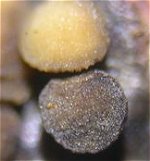
I intended to go to a new DIY supermarket but it was so full I continued on to Speke Hall again. I like this time of year. The chance of something new but not too many specimens to examine. My two newbies, not rare but I have never previously found them, were the Ascomycete Mollisia ramealis and the Myxomycete Craterium minutum. Still a couple of crust fungi to look at.
Friday 8th January 2016

Maintenance day on the allotment. Cleaning pots and sorting out bamboo canes. So afterwards I went for a quick walk to my local golf course which is just across the road. I took my usual route. Today the brambles and nettles had receded. Exposed were the remains of a beech tree that had fallen down and then been sawn up. Growing on these remains were two Oudemansiella mucida (Porcelain Fungus). Described in all literature as very common. But not in Liverpool. Although my local area has hundreds of beech trees, and quite a few have fallen over, I have never before recorded a Porcelain Fungus.
Wednesday 6th January 2016
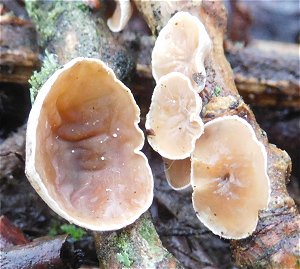
Golf course closed. But it was a nice sunny day so I went for walk at Speke Hall. Pickings were good. Still waxcaps on the Great Lawn. I found Phallus impudicus (Stinkhorn) in the woods. A couple of the more common Ascomycetes. The National Trust staff had been clearing up all the fallen twigs and small branches and kindly piled them up for me to sort through. Star of the day was Schizophyllum amplum (Poplar Bells) on poplar twigs. I found it here some years ago when it was deemed unusual enough for it to be sent to Kew Herbarium. I have found it elsewhere. Always at this time of year after storms have blown bits off the trees. Looks like a tiny Auricularia (Jelly Ear) and dries up very quickly so best looked for after rain. I filled all my boxes. I must go back soon.
Monday 4th January 2015
I went to a local supermarket which is sited at the junction of two main roads. In the car park is a small, brick, raised bed with a scrubby tree and a privet bush. In the surrounding soil, woodchip and assorted rubbish were four Lepista saeva (Field Blewit). Who knows how they got there. The nearest grassland is a school football field, two hundred yards away.
Saturday 2nd January 2016
It finally stopped raining so I went for a walk to a local park. Another beech tree had toppled since my last visit. Part of the park is getting quite a collection of fallen beech trees. I noticed that one trunk had a good number of Sarcomyxa serotina (Olive Oysterling). Growing twenty yards away, another tree casualty seemed to have similar. I took samples from both trees. The first I confirmed because it has tiny sausage spores. To my surprise the second produced brown spores and I identified it as Crepidotus mollis (Peeling Oysterling). I do not recall having seen mollis with such large fruit bodies. Just as well I checked.
Friday 1st January 2016
A quick walk round the park after lunch. The park was full of children on various types of transport. A lot of Sarcomyxa serotina about on the fallen beech trees. The brackets seem to be in very good condition but I am not finding many ascomycetes. Last year at this time I had recorded a good number. Perhaps they need a cold spell. I keep finding white fungi at various sites in Liverpool but mine have all been Lepista irina (Flowery Blewit) which seems to have replaced Clitcybe nebularis as the 'abundant' winter fungus. I brought some home just before Christmas to check the spores. I forgot about them. I wondered what the strange smell was. Fortunately it was pleasant.
Wednesday 30th December 2015

Poured with rain today. Here is one I found earlier. Henningsomyces candidus that has been sitting in my damp box awaiting identification. Thought it was an Ascomycetes but it is not. Found growing in a birch wood. It is very tiny so easily missed.
Tuesday 29th December 2015
A sunny day. I decided to visit Halewood Triangle Country Park as I had not been for over a year and it is one of the local Biodiversity sites. The Triangle is so named because it was where they turned railway engines round. As a woodland it is fairly new, mainly birch. It looks promising but usually disappoints. I started well with Lepista irina (Flowery Blewit) in the car park. As I walked round the site it became obvious that this was the dominant species. It was everywhere in great numbers. I also found Mycena corynephora, a very tiny white Bonnet with distinctive microscopics, a new one for me. Not much else though.
Monday 28th December 2015


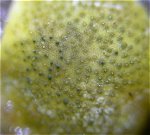
I have been struggling all week, trying to identify some specimens of Hypocrea that I collected in my local park. I had no trouble with Hypocrea aureoviridis because it is bright yellow. Then Hypocrea pulvinata because it grows on Birch Polypore. But I still have two more. Both on wood, one yellowish and one orange. Suggestions gratefully received. Apart form pulvinata, I have never found an Hypocrea before. Now I get four at once.
Friday 25th December 2015

I needed a quick walk after Xmas lunch so, as it managed to stop raining for a bit, I popped up to one of my local parks to check on the Geastrum striatum (Striate Earthstar) that grow in a small copse of mixed conifers. The earthstars occupy a small patch protected by three pine trees where they seem happy and from which have never moved despite increasing in number. I cut a piece from a resupinate fungus on a fallen tree. It was bright orange brown and I would have taken bets that it was Phellinus ferreus or ferruginosus although that would have been unusual on pine. It had tiny allantoid (sausage) spores and encrusted hyphae. It turned out to be Gloeoporus taxicola, a new one for me.
Thursday 24th December 2015
I managed another game of golf today. Still lots of fungi around. Gliophorus psittacinus (Parrot Waxcap), strangely clustered round the base of a tree instead of in the grass. Entoloma conferendum (Star Pinkgill), easy to identify from the shape of the spores. Some large Melanoleucas (Cavaliers) in the car park. I must have missed them on Monday. They were not in best condition. I could not find any cystidia but they were not Melanoleuca melaleuca so I had to give up. Merry Christmas to one and all.
Tuesday 22nd December 2015
So what happened to the Hohenbuehelia that I found in Childwall Woods, Liverpool. It went to Kew from where I received the following - this has to be "atrocoerulea" and cited various notes from FAN3 and FN that mastrucata is usually bigger, with thicker gelatinous layer and metuloids with little in the way of a crystal cap (whereas yours are heavily encrusted). I agree that your material and photo do not look like the mastrucata that I ve seen. Alick, like me, is not completely happy with H. grisea as a distinct and recognisable taxon which is distinguished by Elborne. Again this is supposed to have thinly encrusted metuloid caps which doesn t match your material (however the drawings of these cystidia in FN are unhelpful as encrustation not shown). So we agree that atrocoerulea is the best place to file it for now and I ve done this as K(M) 200880. So next time you see a Crepidotus, take a careful look at it.
Monday 21st December 2015

Back on line again after an enforced absence. Still fungi about on my golf course. It has been so warm if a tad too wet. Plenty of Amanita muscaria (Fly Agaric) and Russula fragilis (Fragile Brittlegill). As an indication of how late some species are, I found two Agaricus augustus (The Prince) on the 7th December and 2 Boletus edulis a couple of days before. Each specimen weighed in at 8 ounces and not an insect to be seen. Excellent eating. The wet weather has prevented the mowers doing much cutting. One of the teeing areas is currently covered with Melanoleuca brevipes (Stunted Cavalier) and another teeing ground with Melanoleuca excissa (Smoky Cavalier). They look similar but the microscopics are different. Interestingly, I have found both species before, some years ago. Both on the same teeing areas.
Friday 13th November 2015

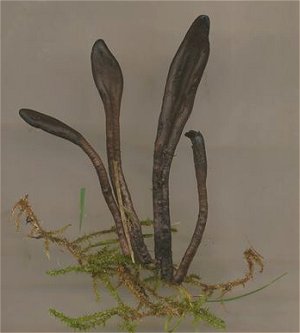
A sunny break in the weather so I checked the churchyard of Liverpool's 14th Century All Saints Church for waxcaps. One or two. The best find was Geoglossum fallax. The churchyard adjoins Childwall Woods. So looked in there while I was in the area. Very muddy and lots of leaves. The wind got stronger and the rain started. On my way out, having found nothing, I turned over a fallen branch. I saw what looked like a tiny Crepidotus mollis. I took to check the spores. It is not a Crepidotus, it is an Hohenbuehelia. It has metuloid cystidia and a four spored basidia. The microscopics fit Hohenbuehelia mastrucata, a Red Data list species, although it looks nothing like any of the photos on the internet. The alternative choice is even rarer in the UK but it has only a two spored basidia. They could be wrong. I have asked Kew if they want it but it is only 7mm big so by the time I have dried it, it will be very small indeed.
Wednesday 11th November 2015
Golf today and it failed to rain. I was surprised by the amount of fungi on the course. It was mostly small, Mycenas (Bonnets), Conocybe (Conecaps) and the like. The top of nearly every sand bunker had a collection of some sort. Mycena olivaceomarginata (Brownedge Bonnet) is one I find every year in the same place. The same for Clavulina rugosa (Wrinkled Club) that grows under the same Hornbeam tree every year at this time. A first find of Stropharia caerulea (Blue Roundhead) but it was on woodchip in a flowerbed so not really part of the golf course.
Tuesday 10th November 2015

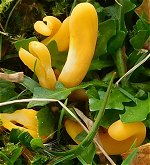

A beautiful day so I popped into Speke Hall to have a look at The Great Lawn as the recent weather has been too wet for them to mow. I was right. It was alive with fungi. At least a hundred Suillus luteus (Slippery Jack), six varieties of waxcaps including a hundred Hygrocybe pratensis (Meadow Waxcap). Entoloma chalybaeum (Indigo Pinkgill) was also prevalent. There were hundreds of Club fungi. I did not know that Clavulinopsis helvola (Yellow Club) and luteoalba (Apricot Club) grew happily together. Obvious when you see them. I filled my collecting box in one hour. I am now struggling to identify some, especially the three Cortinarius.
Saturday 7th November 2015
Horrendous weather this morning. I had to wait for a break in the rain to go up to my allotment and pick some veg for tea. The grass paths were alive with fungi. Melanoleuca excissa (Smoky Cavalier) was unexpected, growing with Clitocybe fragrans (Fragrant Funnel) and Hygrocybe virginea (Snowy Waxcap). So I went for a walk round to see what else I could find. The list got better with Melanoleuca polioleuca (Common Cavalier), Galerina clavata and Clitocybe rivulosa (Fool's Funnel). Best of all was the find of Tubaria dispersa (Hawthorn Twiglet). Mine grow on Cotoneaster berries (Reds supporters?). Last year only one. This year I am up to two.
Thursday 5th November 2015

I went to my allotment to pick a cabbage. The grassy path is growing some excellent fungi. Panaeolus olivaceus, which has spores with warts like the common Panaeolus foenisecii but you need an oil immersion lens to see them. I have found it once before. Then I found a new one for me. Stropharia inuncta (Smoky Roundhead). Looking like a Psathyrella but it has a ring on the stem, a slimy cap with a pointed umbo and the cap peels. Described as occasional but widespread.
Wednesday 4th November 2015
Golf and another Boletus edulis (Penny Bun). This time weighing in at 12 ounces. Nothing much else around but the weather has been warm so they are still mowing regularly. Until they get halted by wet conditions it is likely to remain quiet.
Tuesday 3rd November 2015

Allotment today to plant my garlic. This year, I grew some spare cloves in a large plant pot. They were OK. The surprise was to find a group of Conocybe filaris (Fool's Conecap) had taken up residence in the same plant pot. It seems they like nutrient rich soil so perfect habitat.
Saturday 31st October 2015
I joined Liverpool Botanical Society at Calderstones Park in Liverpool to be educated about trees. This is my local park that I visit weekly. To my shame I know little about the trees. The estate was laid out by Charles MacIver, joint founder of Cunard Line. Most of the specimen trees are from the Americas and Asia. I was disappointed with the number of fungi around. I expected more. But how may people have recorded Pleurotus ostreatus (Oyster Musghroom) on Laburnicytisus adamii (Broom Laburnum) or Hypholoma fasciculare (Sulphur Tuft) on Polyepsis australis (Quenoa). A very interesting day.
Friday 30th October 2015
Out and about today. I started at my allotment and found six species had grown overnight. They were not there on Thursday. One waxcap, One Pinkgill, One Funnel Cap, two Bonnet species and a Psathyrella. Encouraged by this I went to Stockton's Wood where the fungi were also blooming. Unfortunately, there were hundreds of children running around as National Trust had some sort of entertainment on. So I gave up but not before I had recorded Boletus badius (Bay Bolete) and a very nice Pleurotus cornucopiae (Branching Oyster). So I moved on to my local golf course, which had very little. Interesting how different sites are even though only a few miles away.
Wednesday 28th October 2015

Golf on someone else's course today. Look what turned up under a birch tree. Boletus edulis (Penny Bun). What a fine specimen weighing in at 8 ounces. Tea tonight.
Sunday 25th October 2015


Another survey day at Westhoughton. At last it has rained. Now the site has gone from dry to very muddy. A lot of fungi had been washed away. I did not think we were doing very well until I put the final list together. We found some interesting specimens. My colleague identified Galerina pallida, Mycena diosma and Marasmius recubans. I joined in with Tricholoma lascivum (Aromatic Knight). It is a white Tricholoma which I thought would be easy. No. There are five of them. One test was to taste it. Acrid does not accurately describe it. Wow. To identify it I had to work out the Q! ratio of the spores. Takes the fun out of it? We looked at some of the pasture used for grazing horses and cows and I noted a few I had not seen before. Not many cow fields in Liverpool. Star find was Coprinellus bisporus. Not much to look at but very interesting microscopics.
Friday 23rd October 2015

Bonfire day on the allotment to get rid of all the raspberry and blackberry prunings. I was surprised to find a Lepista sordida hiding under the pile of canes. I then went for a quick walk to the adjacent golf course. A mystery. Someone had carefully placed two Melanoleuca cognata side by side on a path. So who else has an interest in mycology? Who has been picking my fungi?
Wednesday 21st October 2015

Another day for a survey at Westhoughton. We looked at one wood which had a gorge running through it so a bit difficult to access all parts. However, there were plenty of species about including Lentinellus cochleatus (Aniseed Cockleshell) and Pleurotus dryinus (Veiled Oyster). We also surveyed some of the cow pasture. Most of the species were the expected Panaeolus papilionaceus (Petticoat Mottlegill) or similar, with only a very small patch that had a couple of waxcaps and Yellow Club.
Sunday 18th October 2015

I led the NWFG foray at Ravenmeols Nature Reserve. It was very dry. I searched for the spot where I found Tulostoma brumale (Winter Stalkball) last year. Only one miserable specimen left. The reserve has various habitats, pinewoods, scrub willow, heathland and dunes all within easy reach of the car park. We started well as the dune heath around the car park produced some interesting species, Lepiota alba and very pale Mycena pura (Lilac Bonnet) that waited until I got them home before they showed their true colour. One pinewood was fairly productive, Geastrum fimbriatum (Sessile Earthstar), Russulas caerulea (Humpback), sanguinaria (Bloody) and xerampelina (Crab).The other had nothing. The scrub willow surprised us with some waxcaps, Gliophorus psittacina (Parrot) and Hygrocybe insipida (Spangle) while the main heathland had nothing. We had time to look at the sand dunes and found Melanoleuca cinereifolia (Dune Cavalier) and Inocybe serotina. I brought a number of specimens home but the problem is most are in poor dry condition or too sandy.
Friday 16th October 2015
After an afternoon of digging my allotment while this dry weather holds, I needed a walk to stretch my muscles. The entrance to my local golf club is just across the road from my allotment, so I paid a quick visit. I was only there for 40 minutes but managed to spot Mycena pura (Lilac Bonnet), lots of Lepista flaccida (Tawny Funnel) and Clitocybe nebularis (Clouded Agaric). There has been a lot of maintenance done leaving piles of logs, branches and twigs. It is starting to rot down. As long as they do not burn it, I should have plenty to look a this winter. As usual I found a small Ascomycete. It is a Hymenoscyphus but the spores do not match anything in my books. Another one for the Mystery Folder.
Thursday 15th October 2015
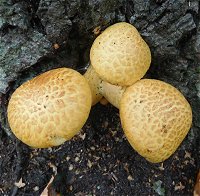
I went shopping for some garlic cloves for my allotment. Having made my purchase, I popped into nearby Speke Hall. The first fungus I found was a huge Boletus edulis (Penny Bun), sadly too far gone to be edible. Beside it were a couple of Cliyocybe odora (Aniseed Funnel), a species I have not identified for many years. Not too much around as they had just mown The Great Lawn and strimmed a lot of the surrounds. After identifying Pluteus umbrosus (Velvet Shield) on a fallen beech, I went into Stockton's Wood on my way back to my car. The first tree was an oak and at the base was a small group of Pholiota squarrosa.
Tuesday 13th October 2015
I had to go back to Clarke Gardens to get some more samples of a resupinate fungus on some stacked branches that had defeated me. The new specimens were more productive and I identifed it as Physisporinus vitreus (a Porecrust). Walking back through an area of beech that I never visit, I found Xerula radicata (Rooting Toughshank) and Russula emetica (Sickener). I must add this area to my usual route.
Monday 12th October 2015
I played golf this morning with a partner who sometimes goes out with Liverpool Botanists. He is always interested when I point out the various fungi in the course. Not bad today as Leccinum scabrum (Birch Bolete) and versipelle (Ornage Birch Bolete) were growing together under some birch trees. He got stuck behind a newly planted ornamental tree and after playing his shot handed me a pale yellow Russula. I was as going to tell him it was Russula ochroleuca (Ochre Brittlegill) but it had a distinctive smell. So I took it home. It turned out to be Russula farinipes (no English name). First time I have seen one. Hard to believe that such a chance collection should turn out to be an uncommon species. Aleuria aurantia (orange Peel Fungus) has started to grow. Clearly getting nearer to winter.
Saturday 10th October 2015

National Fungus Day and a training session and foray for The Biodiversity Society. I had to give a talk, show people how to use a microscope and then take them on a foray. I had five pupils. I took them to Clarke Gardens, a Liverpool Park that is one of the sites earmarked by Biodiversity. I go there quite often. This time I had six pairs of eyes. The difference was quite remarkable. I have a box full of unknown species and they found fungi in places I never normally look at. Find of the day so far is Mutinus caninus (Dog Stinkhorn). It is many years since I last saw one.
Thursday 8th October 2015
Nothing on my golf course this morning. I am giving a talk and foray on Saturday and was hoping that I could collect some specimens to take with me. This afternoon I popped up to the local golf course. Saved. Amanita muscaria (Fly Agaric) and a couple of Russula grisea (Oilslick Brittlegill). Some coming through so I left them to pick tomorrow. They are in the fridge so I hope they last. I did spot Lyophyllum decastes (Clustered Domecap) in some scrubby woodland. New for the site.
Tuesday 6th October 2015


I went with a colleague to Hulton Hall, Westhoughton, as we have been asked to do a mycological survey there. A private estate where few members of the public are allowed to enter. Lots of mature woodland, mainly Fagus but also some areas of Quercus. I was disappointed with what we found but beech is never a prolific habitat. Some nice Oudmansiella mucida (Porcelain Fungus) which is not common in this area but the rest were standard fare. There again, we were only having a look round and shall do a more detailed survey in a couple of weeks when, hopefully, there should be more fungi around. I did find a potential entry for stump of the year.
Monday 5th October 2015


I spent most of the morning trying to identify a Psathyrella (Brittlestem) from Ainsdale. It has a cystidia with crystals on the end which is unusual for this genus. I eventually homed in on Psathyrella spadicea (Chestnut Brittlestem). Not common and a first for the site. I also finished off the remaining specimens from Moore. Nothing too unusual. Parasola leiocephala, a tiny inkcap growing on bare soil. This evening a quick look round a local park produced Russula atropurpurea (Purple Brittlegill) growing under Liriodendron tulipifera (Tulip Tree) an uncommon host.
Sunday 4th October 2015

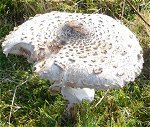

A beginners' foray at Moore. Beautiful day. No beginners. Not one. So Paul and I set off alone. Lots of fungi but all the same species. The Site Ranger was kind enough to let us have the keys to all the gates so we could wander at will where the public could not. We spied some large Lycoperdon excipuliformis (Pestle Puffball) on one of the heathland sites. Investigating these we came upon some very large Macrolepiota procera (Parasol). One was 22cms wide (8 inches for Eurosceptics). If this was a public area I doubt It would have survived. Too big for my frying pan. Paul was happy that we had at last found Geastrum triplex (Collared Earthstar) on the site, after years of searching.
Saturday 3rd October 2015
My annual public foray at Ainsdale Sand Dunes Reserve. I thought it would be very dry, being a sandy site. The Reserve Manager wanted to take everyone out to the dunes and walk back. After a quick look round, I has found Amanita muscaria (Fly Agaric), Paxillus involutus (Brown Rollrim), Leccinum scabrum (Brown Birch Bolete), some Russula, Lactarius, Hebeloma, Collybia. Everything you need for a public foray. So why make it difficult? I won the argument. We stayed close to the Manager's office and were rewarded with 45 identified species in two hours. Not bad seeing that I was the only person identifying them.
Thursday 1st October 2015
Back from holiday. I went out to get some elderberries so that I could make some wine. I found Hygrocybe virginea and Conocybe arrhenii. Nothing unusual but new for the site. It was very dry. I am taking a public foray at Ainsdale on Saturday. It might be hard work.
Saturday 19th September 2015
Last look before I go on holiday. Local golf course for half a hour. Ten species in this time, mostly hidden under nettles and brambles. Nothing unusual. Mycena adscendens (Frosty Bonnet), Marasmiellus vaillantii (Goblet Parachute), Leratiomyces ceres (Redhead Roundhead) to name a few. Also Boletus chrysenteron (Red Cracking Bolete) under Quercus ilex.The experts say it does not grow with Oak but it fits the description perfectly.
Friday 18th September 2015
Another curious find on a fallen branch in my local park. A white pinhead fungus. Under the microscope the pins look like a stalk of wheat with the spore bearing conidiophores at the top. It is called a Synnemata. The only fungus I can find that fits the bill is a Pachnocybe, the only white one being Pachnocybe albida. Not many records for it but they are so small and not many people would spot them. More research again.
Wednesday 16th September 2015
Golf. Things starting to show. Russula ochroleuca (Ochre Brittlegill), Amanita rubescens (Blusher) and a large patch of Gymnopus peronatus (Wood Woolyfoot).
Saturday 12th September 2015
A quick visit to my local park as I had not had a look at my favourite woodchipped flowerbed for a few weeks. Some large Agaricus under Cupressus proved to be interesting. Golden brown and scaly with a very thick stem, they bruised yellow which made me think they were A. xanthodermus (Yellow Stainers). But, the colour was too bright and they smelled of almonds. Back home under the microscope they keyed out a Agaricus lanipes. I have identified this uncommon species in the same area before. Nearby on the lawn under a Sweet Chestnut I found another golden brown Agaricus. Smaller, it also smelled of almonds. The spores were larger and it keyed out as Agaricus augustus (The Prince), an excellent edible. A strange grey furry resupinate has me fooled. It has long spores that have bristles on both ends. I think it is a Menispora but further research is needed.
Friday 11th September 2015
My local museum grounds has a small compact beech woodland which usually produces interesting species. Today I found two Boletus radicans (Rooting Bolete). Seems to becoming a regular.
Thursday 10th September 2015
A quick walk to my local golf club. Boletus chrysenteron (Red Cracking Bolete) under pine trees. A large patch of Agaricus xanthodermus (Yellow Stainer) amongst the nettles together with Lepiota cristata (Stinking Dapperling).
Sunday 6th September 2015
North West Fungus Group foray at Styal was well supported. Hard work in the morning but lots of finds later. Highlights identified on site were Boletus edulis (Penny Bun) and Cordyceps militaris (Scarlet Caterpillarclub) still attached to the larvae. About 70 finds in total. The final list will be published on the North West Fungus Group website as soon as I sort it out.
Friday 4th September 2015
A short walk along the drive to my local golf course to wind down the muscles after a morning digging on my allotment. Lots of Scleroderma bovista (Potato Earthball) under a Thuja (I think). The Agaricus bernardii (Salty Mushroom) beside the roadway. I have failed to identify this on previous occasions. I did not realise that the cap splits into deep cracks. I do now.
Thursday 3rd September 2015
One measly Lepiota cristata (Stinking Dapperling) from my golf club. At least it did not rain and we picked lots of plums behind the last green.
Wednesday 2nd September 2015
A visit to Hale Woods dodging the rain. Very disappointing. A couple of Russula grisea (Oilslick Brittlegill?) at one end of the woods, parazurea (Powdery Brittlegill) at the other end. Acres of brambles and nettles in between.
Saturday 29th August 2015

To save waste on my allotment, I cut the ends from large plastic coke bottles. I stick the necks into the ground beside a chosen plant, courgette, and put in fertiliser and water. This year I used pelleted chicken manure. Having taken out the now finished plants, when I examined my water bottles, they had a solid cake of pellets in the bottom. But it was growing an Ascomycete. After much research, I believe I have identified it. Cheilymenia theleboloides. Most of the species in this Genus are to be found on horse and cow dung. This one is more of a generalist.
Monday 24th August 2015
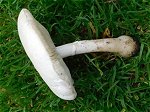
This came from a neighbour's garden growing in his flowerbed. Leucoagaricus leucothites (White Dapperling) :-
Sunday 23rd August 2015

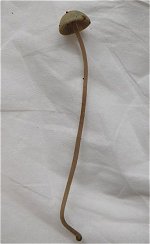
Mrs. MykoGolfer and I visited a friend in north Wales. She went off to play golf so I joined members of the Cheshire Group who were foraying at Hawarden Castle. We finished with about 70 species but it was hard work. It seems a bit slow this year, I suspect because everything is still so green and lush. Of interest to me was Mycena amicta (Coldfoot Bonnet) on pine litter that started turning a bluish colour after being picked. Some very large Boletus luridus (Lurid Bolete) on someone's lawn, Phaeolus schweinitzii (Dyer's Mazegill) and Skeletocutis amorphus (goes red on the underside). A number of species associated with cow dung including Psilocybe coprophila. Not species found in Liverpool due to lack of cattle.
Friday 21st August 2015


A quick scout round my local golf course. Things are looking up. Russula cyanoxantha, loads of Crepidotus mollis and Marasmiellus ramealis. Also an early Macrocystidia cucuminis that I though was a Mycena but the microscopic showed very large cystidia, hence the name. A nice Skeletocutis nivea under a log. A couple of Ascomycetes, one of which I have identified as Orbilia auricolor. A tiny yellowish pinhead species has got me fooled. I have all the microscopic bits but am no nearer an answer.
Monday 17th August 2015
A lot more Leccinum duriusculum (Slate Bolete) have popped up on the golf course. A lot of Populus tremulsa (Aspen) were planted when the course was built. Not a popular tree because it throws up lots of suckers. Good for Boletes though. Only one Calvatia gigantea (Giant Puffball) so far but the area they live in is subject to golf traffic so others may have been destroyed.
Sunday 16th August 2015
I visited Croxteth Hall which is only fifteen minutes away by car. I rarely visit, yet it is an ancient woodland. However, it is surrounded by housing and very popular. Everywhere is full of people and the area is well used. It should have lots of fungi but I have always struggled to find many. Today, I found Xerocomellus engelii, Agaricus sylvaticus (Blushing Wood Mushroom) and Inocybe sindonia. A poor return for two hours.
Friday 14th August 2015
A friend asked if I knew where to find sloes. Prunus spinosa (Blackthorn) is not a plant that is widely grown in suburbia. I knew of a large planting in my local nature reserve but it is young, not many sloes and, looking at the all the tracks through the undergrowth, I am not the only one who knows where they are. One of the Liverpool botanists advised me of a large thicket on the banks of the Mersey, close to the new Mersey Coastal Reserve set up by National Trust. I had a look. Lots of bushes, lots of sloes, no sign of competition. Some of the sloes were deformed, a condition caused by the fungus Taphrina pruni (Pocket Plum). No sign of the red rust being sought by Kew in the Lost & Found Project.
Wednesday 12th August 2015

Golf today. Leccinum duriusculum (Slate Bolete) under the Populus tremula (Aspen). A bit late this year. On the way home, I popped into a local park to see if anything was growing. Under an Oak tree I found a small Boletus pulverulentus (Inkstain Bolete). Aptly named as the flesh turns bright blue as soon as it is cut. A first for me.
Sunday 9th August 2015
We held a foray at Clock Face Country Park, St. Helens. This was the site of a colliery, that was closed and the land replanted about twenty five years ago. Despite being young woodland, it produces a lot of fungi. Every one who attended remarked that they had seen more fungi in the first 15 minutes than they had all month. The site has broadleaf woodland, copses of Larch and Pine and a grassy heathland. Up to now, we have identified seven Russulas, five Boletes and a host of other species. Of interest so far is Leccinum cyanobasileucum on the heath. Looks like Leccinum scabrum (Brown Birch Bolete) but the flesh changes to red and blue. The other is Resinomycena saccharifera, a very tiny species that was growing on dead Phalaris arundinacea (Reed Canary Grass). We are still working on the finds. Full list on the NWFG website when the work is completed.
Tuesday 4th August 2015
We have a foray on Sunday so I popped out to see if there was anything about. Not too bad. Agaricus campestris (Field Mushroom) on a path at my allotment. Someone must have dropped some manure. A nearby park produced three Xerocomus poropsorus (Sepia Bolete), Russua fellea (Geranium Brittlecap) and Xerula radicata (Rooting Shank) in fifteen minutes. We should be fine on Sunday.
Monday 3rd August 2015

As the weather forecast was so poor I went for a quick walk round Hale woods to see if anything was growing. Still a bit dry but I was hindered more by the thick lush undergrowth rather than the conditions. I did find lots of Marasmius rotula (Collared Parachute), a couple of Psathyrellas (Britletem) and Volvariella gloiocephala (Stubble Rosegill). I also found the rust, Puccinia behenis (Red Campion Rust). Most interesting was Handkea utriformis (Mosaic Puffball) growing on woodchip which I thought was an unusual place to find this grassland species.
Sunday 2nd August 2015
I noticed a powdery mildew on Nipplewort leaves at my allotment. Usually if you can identify the plant then you can identify the mildew. I checked my Ellis & Ellis, the bible of tiny fungi. It suggests Podosphaera fusca but there is an another, a Sphaerotheca species that has been recorded on this plant but only once. Reading University are offering to identify powdery mildews if you send them. So I sent it.
Tuesday 28th July 2015
Encouraged by my find of Xerula, following more rain, I paid a visit to the stream area of my local nature reserve. All I found were some Ascomycetes that I had found on my previous visit. I was checking photographs on Google and came across one that was perfect for Orbilia xanthostigma that I had identified. I then realised that it was my photo from last month. I did find a mildew on Enchanter's Nightshade, to add to the rust I found on the same plant species a couple of days earlier.
Monday 27th July 2015
I had a golf match today. After a couple of days of decent rain, some fungi had been tempted to show themselves. Panaeolina foenisecii (Brown Mottlegill) was everywhere. A lovely clump of Xerula radicata (Rooting Shank) had sprouted on one of the paths. I wish I had packed my camera. Unfortunately, they were too exposed to golf traffic to survive for long.
Saturday 25th July 2015
I managed to identify one of the Ascomycetes from my visit to the coast last week. It was Mollisia hydrophila which grows on Phragmites australis (Common Reed). The other one, an Orbilia, still avoids identification. Today, I popped into one of my local parks on the way back from a shopping trip. A small plant with white flowers was clearly supporting a rust. First identify the plant. After much searching through my botany books, I identified the plant as Circaea lutetiana (Enchanters Nightshade) and the rust as Pucciniastrum circaeae.
Thursday 23rd July 2015

I went to Formby to see if I could find the wintergreen rust Chrysomyxa pirolata where it was recorded in 1931. I think the area has changed considerably since 1931. No dunes but pinewood immediately adjoining the Red Squirrel Reserve. There had been a blowout of a couple of dunes so much of the area was covered in sand which was still on the move. I did not even find any wintergreen. There were lots of Agrocybe pediades (Common Fieldcap). On Saturday, when I visited Birkdale there were no Agrocybe, only Psathyrella ammophila. Today no Psathyrella. I am told that the dunes create localised ecosystems supporting different species depending on where you are.
Wednesday 22nd July 2015
Golf today. The only species seen was Polyporus squamosus (Dryad's Saddle) growing on the same Acer stump as it has for the past three years.
Saturday 18th July 2015
Another visit to the Ainsdale Coast, this time with Merseyside Naturalists. The area between Southport and Ainsdale is known as The Green Beach because the plants are reclaiming land from the sea (for a change). A number of rare pioneer plants have been identified but not much in the way of fungi yet I did find some Psathyrella ammophila They were growing in the strip of very low dune separating the sea from the slack area. It is an area that is frequently covered by high tides and very exposed. These Psathyrellas must be tough. Lots of Wintergreen but no sign of the Chrysomyxa rust on any of them. A couple of Ascomycetes on dead Reedmace stems but have not yet been able to identify them.
Tuesday 14th July 2015
An interesting find of a Conocybe at my allotment. It looks like Conocybe apala. Very fragile with a fragile white stem. The spores fit apala and it has a four spored basidia. However, it was not growing in grass but on bare soil. It was in a frame where I harden off young plants before planting outside. It is very close to a grass path and the area does have some grass weeds. But there are so many Conocybes and not much literature on some of them. I have not yet found an alternative with the same microscopic features so I shall stick with Conocybe apala (Milky Conecap). But there is a lingering doubt.
Friday 10th July 2015
I went back Ainsdale today. As it had rained for a couple of days, I thought some fungi might have grown. They had not. I finished up on the dunes along the Dune Path not far from where I visited last week. I came across one patch of wintergreen and found some more of the rust Chrysomyxa pirolata. It does not seem to be endangered at Ainsdale. Not having been out so far before, I had no idea where exactly I was. Luckily a man with a smartphone was passing so I accosted him and he gave me the Latitude/Longitude. So I can find it again if necessary.
Monday 6th July 2015
I received the following Email from Dr. Martyn Ainsworth at Kew - Thanks for the very nicely rusted and pressed Pyrola material, now duly confirmed as Chrysomyxa pirolata and nice to know that it can produce sori on the upper surfaces of leaves and on petioles too (although fewer of them). The specimens now preserved as K(M) 198768. Success.
Wednesday 1st July 2015

Another quick visit to the local Reserve on a scorching hot day. Too hot to stay in and the woods were refreshingly cooler. Still a bit of dampness in the ground, sufficient to encourage a couple of species. Nothing special. The ascomycetes, Tapesia fusca and Orbilia delicatula were common under fallen wood. The most interesting find was a resupinate polypore but it failed to shed any spores so I had to give up.
Tuesday 30th June 2015
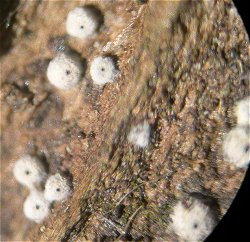
I packed my specimen of Wintergreen rust off to Kew. I hope I got it right. I then took a look at a large stand of Prunus spinosa (Blackthorn) that grows in a local Nature Reserve. A colleague in north Wales reports that all the trees there have been infected by Taphrina pruni which turns the berries into pocket plums. Useless for sloe gin. My trees seem fine although not carrying a lot of fruit. There was still a bit of moisture in the ground and the underside of a fallen branch produced a collection of the tiny Ascomycete, Lasiosphaeria ovina.
Saturday 27th June 2015
I joined the Liverpool Botanista at Knowsley Safari Park. Lots of Bee Orchids on waste ground. I have seen them on every outing. Must be their year. Not much in the way of fungi. Some very dried up Pleurotus ostreatus (Oyster Mushroom) in the Moose enclosure. A few rust fungi on some grasses that I was only able to identify because the botanists could identify the grass species. I now know how to identify a Deschampsia (Hair Grass). I am learning bit by bit.
Thursday 18th June 2015


I was asked by Kew Herbarium to look for a rust, Chrysomyxa pyrolata, that grows on Pyrola (Wintergreen). It was last found on Ainsdale & Birkdale Sandhills Reserve. So I decided to start there. Not being a botanist, I was struggling to identify Wintergreen. Luckily I met an entymologist who thought I was a botanist. Long story but he knew where to find some Wintergreen. Unfortunately it did not support any rust. However the same hillock did support a large colony of Tulostoma brumale (Winter Stalkball). After lunch, I moved to another section of the Reserve. On another hillock I found some Wintergreen that was definitely rusty. Macroscopally and microscopally, it fits the bill and is from the same area as previous records.
Monday 15th June 2015
Golf today. I found a lone Suillus grevillei (Larch Bolete). In twenty years this is the earliest record for my golf course. Also Agrocybe praecox (Spring Fieldcap) which is expected at this time of year. At least something is growing.
Sunday 14th June 2015
I got bored with the cricket on TV so went for a quick walk to a site that I knew would produce fungi, even in these drought conditions. The Eric Hardy Reserve is a ravine with a stream that is like a swamp when it rains. After two weeks of no rain, the stream has dried up so all the fallen wood that is normally submerged is now accessible. Mycena acicula and speirea were common. The fallen wood delivered Orbilia xanthostigma and Flagelloscypha minutissima, a second find this year. Also more Phanerochaete sordida. I was only there for thirty minutes. I must go back soon. On my way back home, walking through the adjacent park, I came across a large patch of Allium ursinum (Ransom). Only one leaf had a rust and it had aecial cups, so Puccinia sessilis.
Tuesday 9th June 2015
During my recent visit to Stockton's Wood, I collected a nondescript white resupinate from the underside of a fallen branch. It was the only thing I found. Being dry, it had to be soaked for a day before it was soft enough to take a sample for my microscope. Then another day on a glass slide to see if it would drop any spores. It had long pointed cystidia, some with a suggestion of crystals. It had short sausage shaped spores. My conclusion is Phanerochaete sordida. Described in the British Checklist as very common and widespread, it is only the second time that I have identified it. I probably would have overlooked it if there had been other fungi to collect.
Saturday 6th June
I joined Liverpool Botanists at Aughton in West Lancashire. Arable land so not much in the way of fungi but some interesting flowering plants. Calocybe gambosa (St Georges Mushroom) popped up on a dual carriageway and Phellinus pomaceus (Cushion Bracket) on a cherry tree in a garden. Nothing else, not even a rust fungus.
Friday 5th June 2015
I had a couple of hours to spare so went down to Stockton's Wood at Speke. The whole place was full of people playing Its A Knockout. Despite the blaring music I had a quick look round but all I found was a lone Pluteus cervinus (Deer Shield). Nothing at all under the fallen wood. Eventually the noise was too much so I hurriedly left.
Saturday 30th May 2015
Looking at the weather forecast, I took a walk to my local park before it rained. Not much about. Volvariella gloiocephala (Stubble Rosegill) in one of the flowerbeds and a Laetiporus sulphureus (Chicken of the Woods) on a Cherry instead of the usual host of Oak. I checked on my group of Geastrum striatum but there were only two old specimens left.
Thursday 28th May 2015
I played golf but we had to abandon the game due to torrential rain. Running back to the clubhouse, I spotted some Calocybe gambosa (St. Georges Mushroom). The first I have seen on the course this year. Usually there is a large ring to be found next to one of the teeing areas. It seems it has moved twenty yards north into a piece of peripheral woodland that I would not have visited if it had not rained.
Wednesday 27th May 2015

For two years I have been waiting for spores from a Ganoderma growing on a dead Escallonia bush in my garden. When I first reported it to Kew, they requested a specimen as it was an unusual host. Because it was in a awkward position, I used the lid from a margarine tub to collect the spores that conveniently stuck to it. I was able to identify it as Ganoderma australe (Southern Bracket). I immediately told Kew. Now they say they do not want it. After all that waiting I am disappointed. At least I save on the postage.
Tuesday 26th May 2015
The sun came out. It was almost warm. I did not want to miss this so went for a walk to my local golf course. I had not been for a few weeks. It is now very overgrown. Grass seems to be having a good year. So there was noting much to see. I pulled up a few dead herbaceous stems and found Calloria neglecta and Leptosphaeria acuta. Nothing special. However, I had not previously recorded either species for the site.
Friday 22nd May 2015


I joined Liverpool Botanists at Altcar Rifle Range to look for orchids. Not usually open to the public (for obvious reasons), this is an SSSI because of the number of orchid species recorded. This evening there were a few Marsh Orchids but mainly Green Winged Orchids. At the last count over 25,000 of them. That is a lot of orchids. Not much in the way of fungi. The only species was Agrocybe paludosa. It is quite small with a ring on the stem. This is not a common Agrocybe but the wet marshy meadow is perfect for this species. I did manage a quick look round the outer dunes before going home and recorded over twenty Psathyrella ammophila in the sand.
Sunday 17th May 2015



North West Fungus Group foray at Beacon Park, Scarisbrick. The weather did not look promising. Cold, dry and windy. Our leader was not very optimistic. But many eyes soon started a reasonable collection and we finished up with about seventy species identified and a few more in boxes to take home. Not many gilled fungi as to be expected at this time of year. Plenty of smaller stuff under logs and branches. Highlight so far is Flagelloscypha minutissima, a very, very tiny white hairy fungus that looks like an Ascomycete. It was on Willowherb. I have found it before so was fairly certain of its identification at the time, now confirmed under a microscope.
Friday 15th May 2015
Just got back from Madrid. While walking through the Palace park I did see some fungi under some pine trees but it was up a hill and the temperature was 35degC. I left them where they were. I did like the mushrooms in garlic and paprika that I had for dinner.
Saturday 2nd May 2015
Interesting phone call from someone who is running a Bioblitz. Could I do fungi? Where? Southport coastal dunes. When? June 12th. I explained that the likelihood of finding fungi in sand dunes in June was nil. As a bioblitz is supposed to be the recording of all living species within a designated area there did not seem much point in looking for fungi. It was then suggested I could go along and talk to people about the life cycle of fungi? I declined this invitation.
Monday 27th April 2015


When I went to Freshfield, I managed to break my camera. It had an ON button which was a bit sensiitive. It switched on accidentally. The lens came out in my bag and jammed. So I bought a new Nikon Coolpix S7000. It is small and neat and also will take a picture as close as 1 centimetre. I attach a picture I took of Datronia mollis at Dibbisdale on Sunday. It is much better than the old one. I also succeeded in identifying a lichen from on Sunday. It is Lecidella elaeochroma. I thought it was an Ascomycete but it had no asci. I do not usually bother with lichen. Fungi are difficult enough.
Saturday 25th April 2015
I joined the Liverpool Botanists at Dibbinsdale Nature Reserve. It is a very wet site, being a flood plain at the bottom of a steep gorge. After a week of scorching weather I hoped it might produce something. It proved to be disappointing. The only find was of Kuehneromyces mutabilis (Sheathed Woodtuft). Not much under the fallen wood although, the site looked a bit 'clean'. Most of the wood was too big to tackle or in the middle of the water. It rained heavily after lunch so, hopefully, things might begin to grow. I still have not seen St. George's Mushroom yet.
Tuesday 21st April 2015

Too hot and dry for gardening so I went for a walk in one of my local woods. I did not expect to find very much and was proved correct. A fallen branch with Lasiosphaeria ovina was all I found in a very dry woodland. Toward the end of my normal route is a hollowed trunk, where I found Coprinopsis spelaiophila in 2012. I always check just in case. Lo and behold there they were. Two fruitbodies growing inside the hollow toward the bottom. I took one which checked out microscopically. I could not get at them to take a photograph so have used the one from 2012.
Wednesday 15th April 2015

Golf this afternoon. My wife informed me about a patch of fungi in a flowerbed on the course. I followed the directions and found a large patch of Pholiotina (Conecaps). These had a ring on the stem. Not many choices at this time of year but they still had to be taken home for microscopic examination. I was surprised that they turned out to be Pholiotina aporas. Growing on mulch, I expected another species.
Sunday 12th April 2015
I had to lead a foray at Freshfield Dune Heath and Ainsdale on Sunday. The weather was horrendous. A howling gale to start. Then, just after lunch, it poured. We kept to the woods and made no attempt to reach the dunes. The results were quite good considering. Sixty species identified so far. One couple left early. On their way back to the carpark they found Disciotis venosa (Bleach Cup). So they came all the way back in the rain just to show us. This is a first for this site. We found a few Entolomas and Panaeolus but most of the finds were brackets, resupinates and tiny things under logs. A find of Hapalopilus nidulans (Cinnamon Bracket) was interesting because I had found one last week at another site, not having seen one for fifteen years. Could this be good year for this species?
Thursday 9th April 2015
Golf today. It has been hot and dry yet I found a very large Pluteus cervinus (Deer Shield) by the side of the first green. Hopefully, something will have grown by Sunday when I lead my foray.
Wednesday 8th April 2014
I went to Freshfield and Ainsdale to check out the route for my foray on Sunday. A bit too warm for such a long hike. Despite all the rain, it was very dry. No water in the slacks and not a Morel to be seen. Last year it was wellies only and the the Morels had drowned. I did not bother to foray, just a look round. I did spot some Clitocybe vermicularis, a rare specialty of Ainsdale. I have not seen any for two years so nice to see them back. I had a look under a couple of logs in passing and had no problem finding Ascomycetes. Hopefully the additional eyes on Sunday will turn up a few specimens.
Tuesday 7th April 2015


A colleague has sent me some photos from a site in north Wales of some Morels and Paxina leucomelas, the latter being one I have never seen. I must ask him where it is, if he will tell me. So Spring is here. I hope we have some Morels at Ainsdale where we go on Sunday.
Monday 6th April 2015


Thick fog this morning so I burned the remainder of the rubbish on my allotment. Then the sun came out and it was very warm. So I sowed my carrots and then went for a walk to my local golf course. I take the same walk at least once a week and look at the same fallen branches and twigs. There is always something new. Today in a quick half hour I collected Calloria neglecta (believe it or not, a first for this site). This was followed by Calycina conorum, a white disco on a fallen pine cone and Anthostomella rubicola on dead blackberry stems, a tiny back spot but with a very distinctive spore.
Saturday 4th April

I have identified one of my ascomycetes as Eriopezia caesia. Apparently common but new to me. The other one still has me fooled. It looks like the very common Polydesmia but the spores are half the size and the microscopic bits are the wrong shape. The nearest I have got is Parorbiliopsis minuta for which there are very few records. I can not find a decent photo of it on Google to back up the one in my book. I may need assistance.
Thursday 2nd April 2015
I went for a stroll round Stockton's Wood, a National Trust property. They had been out chopping things down and burning again. Why not use a Vacuum cleaner? A few bits and pieces were left. Hemimycena tortuosa {Dewdrop Bonnet) under some stacked logs. This is becoming a regular winter find with the water droplets on the cap and stem. Another nice find was Hapalopilus nidulans (Cinnamon Bracket} on a dead tree. Only the second time I have ever seen it. A few Ascomycetes to still identify.
Monday 30th March 2015
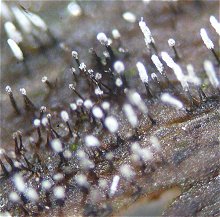

Played golf and came across a branch with small black fungi on it. Not having a knife with me, I had to stick a four foot long branch into my golf bag. My playing partners merely shook their heads. Back home I identified the fungus as Eutypella scoparia. However, on the branch I detected another fungus, so small, it is merely a suggestion. I could not recognise any asci but it has long spores. I have no idea what it is. Another one for the Mystery Folder.
Friday 27th March 2015
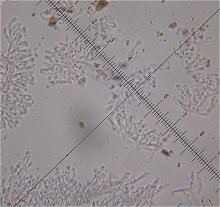

I was going to join Merseyside Naturalists at Moore on Saturday but the weather forecast is so poor I decided to go today. I wanted to see if the mysterious purple resupinate fungus was still there. I hoped to have another go at identifying it. No luck. It had finished. It was a very nice day and the birds were all in song. Lots of birders looking for the Lesser Spotted Woodpecker. No luck there either. And the Bitterns had gone. I turned over a log and came across a tiny white toothed fungus. Had me fooled. Brought it home and eventually identified it as Mucronella calva. New one for me. My photos are not the best but it is very small and hard to focus.
Saturday 21st March 2015

I visited Knowsley Triangle Country Park, a site I last visited thirteen years ago when I set up a foray for the rangers. Then it was very young, having been created on a major railway junction of The Cheshire Line, hence the triangle. Now it is mature and a site I must visit again. Mainly birch, I was surprised that I did not see any Birch Polypore or Stagshorn Xylaria. It is very damp woodland with a few ponds where I scared the toads who were very busy doing whatever toads do at this time of year. Lots of logpiles to turn over. I did not find a lot, the best being Mycenella tortuosa. Not always covered in slime but still identifiable from the snakelike hairs on the stem and narrow spores.
Tuesday 17th March 2015

A quick walk over to my local golf course after an afternoon allotment digging. A couple of Ascomycetes that I am still struggling with. Most interesting was a resupinate polypore on a fallen branch, probably beech. It has allantoid (sausage spores) and when KOH is applied it quickly turns purplish. Using my just arrived Porois Fungi of Europe by Ryvarden, my determination is Ceriporia purpurea, a new one for me.
Monday 9th March 2015
I went for a bit of golf practice on my own. It gave me the chance to examine some of the fallen branches which is difficult to do when playing in a match. In reality, there are not very many as they get cleared away. I found only Chaetosphaerella phaeostroma. Not exciting except that I had never previously recorded it on my golf course. It is species number 400 which is not bad for a suburban course on old farmland.
Friday 6th March 2015
Waiting for my car service to be completed I went for a stroll in a nearby green space. I picked up a piece of pine branch and noticed what appeared to be an Ascomycete. Not having a magnifier or a knife I had to take the whole branch. The receptionist at the garage was a bit bemused. Preparing it for microscope, I noted it was tough and broke a cover slip. I had to use potassium hydroxide on it to soften it. It was clearly not an Ascomycete.The spores are like thick sausages, but it also has smaller round spores. My conclusion is Dacrymyces capitatus. Not one I had identified before. The books say rarely reported but I suspect it is overlooked.
Saturday 28th February 2015

A sunny spring morning so I went to Speke Hall to see if anything had started growing. Not a lot. Apart from a nice show of Sarcoscypha austiriaca (Scarlet Elf Cup), the few specimens I brought home were from under logs and fallen branches. Four Myxomycetes that I managed to identify for once. Two or three Ascomycetes, one of which is causing me a problem. It is either Hyaloscypha albohyalina or Hyaloscypha fuckelii. It depends on the length of the hairs which are quite small and I am struggling to isolate one in order to take a measurement. On the way out, I noticed that the Nation Trust volunteers were 'cleaning up' the woodland floor again. They will be laying carpet next.
Thursday 26th February 2015
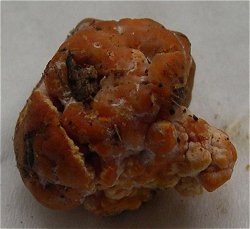
A day off from golf due to course maintenance so I visited one of my favoured woods at Hale Hall. It was a hard slog in the mud. Not a lot about but a couple of new species for the site. The first I identified as Rosellinia mammiformis. The members of this Genus look the same so it is down to what plant they are on, in this case Hedera (Ivy), then size and shape of spores. The other was Hypoxylon rubiginosum. All the other Ascomycetes I found were the common ones, Mollisia cinerea, Tapesia fusca and Polydesmia pruinosa. A couple of mysteries, one being an orange lump. It has spores but no other microscopic features that I could see. Is it a fungus?
Saturday 21st February 2015
The AGM of North West Fungu Group was held at Risley Moss today. I gave my foray report for last year, Professor Bruce Ing, our retiring President, gave an illustrated talk on his speciality subject, Myxomycetes (Slime Moulds). Then when lunch was being prepared, a young man entered, armed himself with a knife and threatened people. The police were called and he was arrested. We then went for a short walk round the Reserve. Found a few specimens (there are always lots of Sarcoscypha (Scarlet Elf Cups). It then hailed and sleeted, so I went home. All very exciting.
Friday 13th February 2015

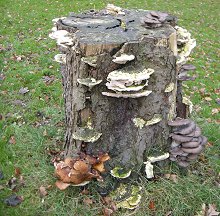
It has been very dry for a week. Even looking under logs and branches has been unrewarding. I have spent most of my evenings as an archivist, typing up the records of Pat and Len Livermore, who undertook frequent forays in the Gaitbarrows area. Laptop on knee in front of the TV, one eye on the typing and the other eye on the football. I am committed to seventy hours and have only reached halfway. My photographs of interesting stumps were accepted for publication in the Field Mycology magazine. International fame at last. I also managed to get some dried specimens off to Kew Herbarium. I have not heard from Kew so I hope they got there alright.
Tuesday 3rd February 2015

Quite frosty but very sunny so the ground warmed up by lunchtime. I am having new windows fitted but the weather was too nice to miss. A small selection of polypores and crusts but nothing unusual until I tuned over a very rotten piece of old beech and noticed some very tiny white things. It was not until I put the piece of wood under my little microscope that I could see any shape to them. I had thought they would be Ascomycetes but was wrong. They are Henningsomyces candidus, a Basidiomycete. They are only 0.5mm or less so I was very lucky to see them. A new one for me. The photo is not too good but they are very tiny.
Saturday 31st January 2015
The weather is cold and very windy. I have not been able to get out. I have been busy archiving old hand written records from Gait Barrows Nature Reserve. They were collated by Pat and Len Livermore in the 1980s. The intention is to add them to the Fungal Records Database. It can get a bit dull after a time but I can do them while watching the football and racing on TV which helps. Arsenal versus Aston Villa tomorrow so I should get a good few finished.
Sunday 25th January 2015
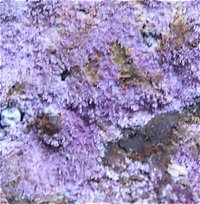

I have been a bit quiet recently but it changed on Sunday when I joined the Cheshire Group at Moore Nature Reserve. Lots of Ascomycetes. I brought home every colour variation of Mollisia cinerea. I managed to isolate Mollisia fusca and melaleuca but the rest looked the same under the microscope. One interesting find was of Chaetosphaeria cupulifera which looks like a common species but the spores gave it away. Another new to me was a pink one on lichen, Illosporiopsis christiansenii. We are still puzzled by an unusual purple cottony resupinate found under a log. I think it is Hypochnella violacea but have yet to convince my colleagues.
Thursday 15th January 2015
Still no snow so I took another walk to the park. I like looking for fungi at this time of year because, there being so few to collect, you have time to study species that would probably be discarded after an autumn foray. A couple of white cottony resupinates under logs were examined. At this time of year they are damp and usually producing spores. The first had distinctive smooth spores and I identified it as Hypochnicium eirksonii. The other one produced some unusually shaped brick like 'spores' that had me guessing. Another sample revealed some small spiny spores. After some research I found that Trechispora stevensonii produces an anamorph, a non sexual structure, that breaks into pieces. So both were present at the same time. Both species are common and widespread but I had never taken on the challenge of identifying them.
Tuesday 13th March 2015
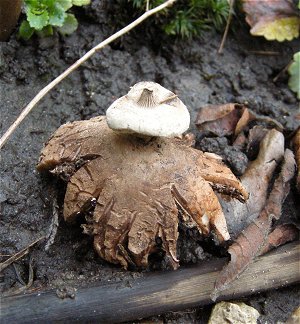
I went for a quick walk round my local park before the threatened snow arrives. Under some Cupressus leylandii I found a small patch of Geastrum striatum. I now have two local sites for this uncommon species. Both are under Cupressus so worth having a look if you have any in your area. I also brought back a few Ascomycetes that will keep me occupied for a couple of days.
Monday 12th January 2015
The sample that I cut from the cherry tree stump has finally produced some spores. They fit Phellinus pomaceus (Cushion Bracket), which is what I thought it would be. I probably found it some years ago on a roundabout immediately opposite the kiddies playground of a pub. I was too embarrassed to wade into the undergrowth to take a specimen.
Thursday 8th January 2015

As the weather forecast for the weekend is dreadful, I took advantage of a sunny day to look round Speke Hall and the adjoining Stockton's Wood. Apart from a couple of common Mycenas, my finds were of ascomycetes growing on the debris from the trees. I struggled with a white hairy disc that I eventually identified as Hyaloscypha hyalina - no stem, pointed hairs. I also took home an orange cushion but when I looked at the piece of wood under a microscope, I saw that it supported a number of black discs that I had not seen. This was Durella connivens, new to me and, looking at the National database, not recorded very often. A bit of good luck.
Wednesday 7th January 2015

Just my luck. I had to pop down the road to my local Tesco Express. Outside the door is the stump of an old cherry tree that was cut down. And growing on it is a bracket fungus. I sneaked down early this morning while no-one was around and cut a small piece off. Unfortunately there are no spores yet. There are no clamps on the hyphae which suggests it may be a Phellinus. I shall have to bide my time and wait for the right moment to take a sample. Yet another supermarket fungus.
Saturday 3rd January 2015
The manager of Ainsdale Sand Dunes Reserve sent me a couple of Tulostomas (Stalkballs) that he had found durng his travels round the various reserves on the Sefton Coast. He asked if I could identify them which I could. One was Tulostoma brumale (Winter Stalkball), the other being the much rarer Tulostoma melanocyclum (Scaly Stalkball). The former has a brownish stem, the latter reddish. There are microscopic differences which were also present. It was very interesting to have both species together and be able to compare them.
Friday 2nd January 2015

A sunny day but very windy. Not to be wasted, I went to one of my favourite woods on the banks of the Mersey. There it was very, very windy. Undeterred I found a good selection of common resupinates. New for the site, on a pile of conifer prunings, I found Panellus mitis (Elastic Oysterling) and Stereum sanguinolentum (Bleeding Conifer Crust). Unusual for these woods because there are only a couple of pine trees, probably ornamental plantings when the old hall was in use. I had quite a struggle to identify a Myxomycete (Slime Mould). I eventually settled on Physarum nutans for microscopic reasons. Not easy as there are two very similar species.
FUNGAL SNIPPETS from MYKOGOLFER for 2014
Monday 29th December 2014

The snow has nearly gone. The local golf course was closed for play so I went for a wander to places normally out of bounds. Not much around but a good day for oysterlings. Crepidotus cesatii on a dead birch tree, Crepidotus epibryus on fallen twigs and Resupinatus applicatus (Smoked Oysterling) on the underside of a number of fallen branches. A few Ascomycetes, Mollisia ligni being a new find for me.
Saturday 27th December 2014

The snow hit with a vengeance last night. I shall definitely stay at home and do some armchair foraying. A member of my Group sent me a picture of a splendid Hericium cirrhatum (Tiered Tooth) seen growing on a beech stump near Rochdale. I have found this a couple of times in my local parks but nothing near as spectacular as this specimen.
Friday 26th December 2014
Played a couple of holes of golf this morning. Still a few bits and pieces around including Pholiota gummosa (Stick Scalycap), one I had not found this year.
Wednesday 24th December 2014
The spore print from the supposed Lyophyllum that I picked yesterday was not right. I did not get enough to note a colour but the spores were ellipsoid and spiny. Looking at the specimens again, this time in sunshine, I just glimpsed a hint of mauve on the stem. I had to ask Mrs. MykoGolfer to confirm it. Yesterday was so dark and gloomy, especially when I picked them at about four o'clock, I could not see it. Even now it is not bright but the specimens are old and dry. The photo I took on my scanner just shows it. The answer is Lepista saeva (Wood Blewit).
Merry Christmas
Tuesday 23rd December 2014

I was driving past a Co-op supermarket and remembered I needed some bread. I parked my car beside a raised flowerbed. I saw some fungi in the old woodchip. But it was beside a bus stop where people were waiting. So I had to wait ten minutes for the bus to arrive and take them away before I could pick them. I did not want to look silly. They look like Lyophyllum decastes (Clustered Domecap) but I am waiting for a spore print before I can confirm. I shall consider writing a book about supermarket car park fungi. Buy one - get one free?
Monday 22nd December 2014
The additional pages to the book, Ascomycetes in Colour by Peter Thompson, arrived today. This page includes the Astrosphaeriella stellata that grows on my old bamboo canes at the allotment. I had recently sent a couple of samples to him so that he could take a photograph. Fame at last.
Saturday 20th December 2014
I popped into Tesco to buy my essential Christmas stocks. There is flowerbed right outside the main entrance that is heavily woodchipped. Last year I collected Gymnopus fuscopurpureus on this very same flowerbed. This year it i covered with a Clitocybe. Unfortunately the shop was busy and there were dozens of shoppers going in and out. So I had to leave them. Most annoying. Why did it not grow on the many other flowerbeds in the car park? Perhaps I could sneak round early tomorrow morning before the shop opens?
Friday 19th December 2014
I played golf today and was surprised by the number of fungi still around including Lactarius (Milkcaps) and Russulas (Brittlegills). I thought these species would have disappeared before now. I was playing in a competition so did not have time to examine them more closely. And the weather was a bit severe. I doubt there was anything new. Warmer weather is forecast so we might be foraying for a little while longer.
Wednesday 17th December 2014
I was asked to send a sample of my finds of Astrosphariella stellata, an Ascomycete that I found on my old bamboo canes, to Peter Thompson. He is going to add it to his recent book. I keep giving all my specimens away and I have not kept any for myself. Peter Thompson offered to return my specimens. Fungal etiquette. Then, Mrs. MykoGolfer said ''And what are you going to do with it?'' Point taken. I am about to send my last piece to Kew . Back to my allotment to see if I can find some more.
Monday 15th December 2014

Some atrocious weather at the moment. The chances of finding a moment to get out have been limited. I found some very small brown fungi on soil last week that I could not identify. I found another group of them in litter this morning. It is brown with a brown stem, brown gills and brown spore print, although the spores under a microscope are more yellow. After a lot of research my conclusion is a Psilocybe and the only one I can find of this size and with the size of spores and cystidia is Psilocybe inqillina. New to me but now found twice in one week.
Thursday 11th December 2014

Dodging the hail showers, I went up to my allotment to make sure the greenhouse was in one piece after the gales. OK. Fine. Having taken down my runner beans and stacked the bamboo cane supports, I checked to see they were secure. I noticed a small black fungi on one of the canes. The return of Astrosphaeriella stellata? Yes indeed. I contacted those who are interested in this species and ALL want a piece of this species. Peter Wilberforce, who first identified it, Peter Thompson to add to his Ascomycete book and Kew Herbarium. The only person who does not have a piece is me, the person who found it.
Monday 8th December 2014
I took a chance on a break in the weather for a quick walk to my local park. Despite the frost, there were still Russulas around, blennius and ochroleuca. A Melanoleuca has me foxed but a lot of them look the same. The larger spores and type of cystidia ruled out the common ones, the only one I could find that fitted all the microscopic features was Melanoleuca schumacheri but this is a Red Data species. There were lots of very small fungi in the undergrowth. I collected three. I have not managed to identify any of them. One looks like a tiny Collybia with very small white spores. I have looked at Micromphale brassicolens. I note that the genus has been changed to Gymnopus (Collybia). But I cannot get the microscopic features to fit. Frustration.
Thursday 4th December 2014

People know I am interested in fungi and send me terrible photos, asking me to identify them. Here is the latest (one of the better ones) found in a churchyard. Looks like it is covered with confetti?
Monday 1st December 2014
I have been contacted by The Biodiverse Society, a partnership of various wildlife trusts, who are looking for volunteers to assist with surveying sites, recording wildlife and training people to do these things. Some of my regular sites are on their list so I met a couple of nice young ladies at Clarke Gardens in Liverpool, to discuss having a foray there next year. I took them round the site and showed them the proposed route. We collected a few fungi on the way round including Lyophyllum fumosum, which I eventually identified from the globose white spores. Only the second time I have seen this one. There was a good collection of species considering the date. So I agreed to assist as long as it does not impinge on all my other fungal commitments, or my golf, or my allotment, or my horseracing or my**********
Sunday 30th November 2014

Another beautiful November day so I decided to take a look at Raven Meols Hills in Formby as I hope to run a foray there next year. It has a good mix of sand dunes, conifer, birch scrub and heathland. I did not expect to fill my collecting box within thirty minutes. Most of it came from the pinewoods. The dune heathland was very disappointing. I found a quiet spot in the dunes to eat my lunch. I noticed that I was sitting beside a patch of Tulostomas melanocyclum (Scaly Puffball). For years there was a patch of these at Ainsdale Nature Reserve but they have slowly disappeared, I suspect because visiting forayers keep digging them up to look at them. I shall record these but keep them a secret.
Wednesday 26th November 2014
Golf today. Still bits and pieces around. I counted a good number of Melanoleuca polioleuca (Common Cavalier) under a newly planted tree. The Mycena meliigina were still on the poplar tree but have been joined by another species. I did not have time to examine further. I also found Agaricus campestris (Field Mushroom) on one of the tees. One for breakfast.
Monday 24th November 2015
When I go to my allotment, I park my car opposite the gates to the local golf club. I often walk up the driveway to see if anything is growing. I was in luck. A couple of Lepista saeva (Field Blewit) in grass beside a Yew. This is not a common species in this area.
Sunday 23rd November 2014


I joined colleagues of the Cheshire Group at Ainsdale Sand Dunes Nature Reserve. It was a gorgeous day. We were tripping over fungi. Our first find was of a yellow milkcap with purple milk by a pond. I have identified it as Lactarius aspideus. Never seen it before. This was followed by a Lepiota that looks like Lepiota castanea except the spores are tiny. I did identify it as Lepiota langei but it appears this one has been split into two and given different names. So I have no idea what it is. Other highlights were Russula persicina, an Ainsdale speciality. Sand lovers Inocybe sindonia and Hygrocybe conicoides (Dune Waxcap) were found on the dune heath. We found ninety-three species with a few still to do in boxes. Not bad for November. One interesting birch stump had six different fungi growing on it.
Saturday 22nd November 2014

Where I park my car outside my allotment, the householder has cleared the path of fallen leaves and piled them into the gutter. Within a week, two Geastrum triplex have grown right in the middle. That is what I call opportunism.
Friday 21st November 2014

I joined colleagues at Dunham Massey, where we hope to negotiate with the National Trust to hold a foray there next year. It was cold and wet. There was a good number of fungi around. Nothing unusual regarding the larger fungi. We hoped to find some waxcaps on the main lawn but we only found Hygrocybe laeta (Heath Waxcap) and psittacina (Parrot Waxcap). There was a lot of fallen beech trees and branches that produced a variety of wood lovers including Peziza micropus, Rutstroemia firma (Brown Cup) and Lycoperdon pyriforme (Stump Puffball). The dead bracken produced Mycena pterigena (Ferny Bonnet). An interesting find that I thought would be a myxomycete turned out to be the anamorph state of Botryobasidium aureum. I could not find it in my books but eventually found it on the internet.
Wednesday 19th November 2014
Golf today. Still lots of fungi around. On a mossy trunk of a black poplar, I found some tiny brown Mycenas (Bonnets). There are a couple of common species that grow on this habitat but this was neither of them. It had large round spores, a very chubby four spored basidia and cystidia with large digital growths. My conclusion is Mycena meliigena. It is said to be rarely collected. But it is very small and difficult to extract the microscopic information. I had taken four gill specimens and destroyed the fungus before I got lucky and found the necessary bits. It was the only fungus I brought home otherwise I may not have got round to it.
Tuesday 18th November 2014
I did my talk this evening to the Liverpool Organic Gardeners. After finding a couple more specimens, I was able to take a good collection to the meeting. Unfortunately it clashed with England versus Scotland. Only one man and a a dozen ladies turned up. I am not sure if their organic gardening extended further than their own back gardens. I had to explain about fungi in general before reaching the examination of my specimens. I am not sure if this was of great interest. Certainly the meeting warmed up when the tea and biscuits turned up. Ah well.
Monday 17th November 2014
It poured last night. I decided to collect some of the specimens for my talk while it had stopped raining. Sadly, the condition of some of my targets had deteriorated after all the rain. I collected them anyway. Clitocybe nebularis (Clouded Funnel), Lepista flaccida (Tawny Funnel) safely boxed. I was fortunate to find some Armillaria (Honey Fungus) and some Aleuria aurantia (Orange Peel Fungus) so some good talking points. Hopefully they will survive until tomorrow evening. I must pop up to my golf course and hope that some Amanita muscaria (Fly Agaric) have survived. They were there last week.
Sunday 16th November 2014
Kew Herbarium did not seem to think much of the specimen of Ganoderma applanatum (Artist's Fungus) found on pine. They described it as immature. I admit it was a bit small but it was the only one we could get off the tree. And it is expensive sending large packages through the post. Undeterred, I joined a colleague back at Beacon Park to see if we could remove another, bigger one. Could we find the tree?. Not immediately. We scoured every pine wood we could remember for over two hours. The woods were full of fungi but our interest was not in foraying. We did find Hygrophorus hypothejus (Herald of Winter). Very apt. Also Flammulina velutipes (Velvet Shank) and Sarcomyxa serotina (Olive Oysterling) which I collected for my forthcoming talk. We had given up on the Ganoderma when, in the last pine wood, nearest to the car park, we found the tree. I had brought a saw so I was able to remove a large specimen. I hope Kew will be satisfied this time.
Friday 14th November 2014
Peter Thompson seems satisfied that the specimen on a bamboo cane that I sent him is Astrophaeriella stellata and may include it in his book. I was at my allotment this morning, looking for it without success. I did find some Resupinatus applicatus (Smoked Oysterling) on a cane. It seems to grow from the pith. I then took some rubbish to the recycling plant. It is very close to the Liverpool Garden Festival site so I had a quick walk round. The only species were growing along the pathsides in disturbed ground. Nothing at all in the woodland yet. Perhaps too early. There were hundreds of Lacymaria lacymabunda (Weeping Widow) and Coprinopsis atramentaria (Common Inkcap). Also lots of Lyophyllum decastes (Clustered Domecap) and, if my identification is correct, Lyophyllum fumosum. I relied on the microscopic features of the cap. It is a nice place to visit. A pity there is not much fungi.
Wednesday 12th November 2014
Not much on the golf course this morning but in the car park was a huge Aleuria aurantia (Orange Peel Fungus). I picked it in the hope it will last until I do my talk next week. This may not be necessary. When I went to my allotment this afternoon, on the hardcore entrance road, were dozens of them. As long as the delivery lorries do not run over them, I should have a good collection. I read that this species prefers stony ground although this is the first time I have found it in such a substrate.
Sunday 9th November 2014
A beautiful sunny day so I went for a stroll in some local parks. Lots of Clitocybe nebularis (Clouded Agaric). I came across five large rings. A stand of pine produced a couple of Gymnopilus penetrans (Common rustgill), not a species I have ever found locally. Mycena pura (Lilac Bonnet) appeared, another first. It is said to be very common. Not in my area. I collected a few Ascomycetes so back to my microscope to see if I can identify them.
Saturday 8th November 2014

Having watched the Chelsea Liverpool match, I popped out to check on my local sites. In one of the parks, amongst a large group of waxcaps, Hygrocype laeta (Heath), psittacina (Parrot) and chlorophana (Golden). Under a monkey puzzle tree, I came across this nondescript fungus (see picture) with a brown cap, brown gills and brown stem. It had me fooled until I did a spore print. Surprisingly, it was white. I have identified it as Gymnopilus fuscopurpurea. Described as uncommon but spreading. I found it last year in a Tesco car park on woodchip.
Friday 7th November 2014
I have at last sent of all of my specimens to Kew and Peter Thompson. Nothing much at the golf course on Wednesday except for a very new Boletus edulis in yet another different area. The latest I have found before this year was 31st October but I do not go every day so there may have been later ones that I have missed. And it depends where I hit my golf ball. I am preparing for a talk I have agreed to give. I have reconnoitred my sites to see if there will be any fresh specimens. I should be able to produce Clitocybe nebularis (Clouded Agaric), Lepista flaccida (Common Funnel Cap), Hypholoma fasciculare (Sulphur Tuft). I just hope the weather stays warm and the Amanita Muscaria (Fly Agaric) and Paxillus involutus (Brown Rollrim) keep growing. And the mowers do not get them.
Monday 3rd November 2014
Golf this morning. Lovely sunshine. Lots of fungi showing. Dozens of Amanita muscaria (Fly Agaric) everywhere. The Clitocybe nebularis (Cloud Agaric) has spread out. Two new areas for Boletus edulis (Penny Bun). This species has spread out over the last couple of years. I wonder if the age of the trees, which were all planted about the same time, has an influence? I managed to identify Cortinarius hemitrichus (Frost Webcap) and Entoloma conferendum (Star Pinkgill) neither of which has been collected on this site for a few years.
Sunday 2nd November 2014
I was at my allotment when I noticed a small black fungus erupting from the rotting end of a bamboo cane on a neighbouring plot. Thinking it might be another example of Astrosphaeriella stellata, I cut the end off. I tried to get some microscopical evidence but only succeeded in breaking a few cover slips. Not really my forte. I therefore offered my speimens to Peter Thompson as I saw no point in me hacking away until there was nothing left and no result. He has agreed to look at it.
Thursday 30th October 2014
I got it wrong. The spore print from yesterday's find was not from an Entoloma at all. It turned out to be Mycena galopus var. nigra. I got over excited. In the meantime, I have managed to identify some of the Ascomycetes from my collection on Sunday. Hymenoscyphus herbarum and Orbilia auricolor. They are hard work to identify. For such small fungi, there is such a lot to look for. Both species are common.
Wednesday 29th October 2014

An interesting day. My wife was hanging out the washing when she noticed a small black fungus on the lawn. I was called upon to identify it. My decision was Entoloma nitidum (Pine Pinkgill). It grows in boggy areas which is a good description for this bit of my garden. I then went to play golf. The first thing I found was a small piece of fallen wood with Schizophyllum amplum (Poplar Bells) growing on it. It was under willow but there is poplar nearby so difficult to say what the wood was from. Lots of Mycenas on the backs of the bunkers. They all were Mycena olivaceomarginata (Brownedge Bonnet). Also a large ring of Clitocybe rivulosa (Fools Funnel) under hornbeam.
Tuesday 28th October 2014

I am battling my way through the specimens on dead nettle stems with mixed results. For the second week running I have identified Leptosphaerea dololium on a dead nettle. Usually it is acuta but my specimens have only four segments in the spores. In future, all nettle stems will have to be checked. I got bored so went to my allotment. On my neighbours's plot I found two Lepiota boudieri (Girdled Dapperling). They smell very sweet and the microscopics confirm the identification but I have no idea why they are in an allotment garden. I found two in the adjoining allotment in 2012 which suggests that the fungus is spreading.
Monday 27th October 2014
Golf this morning. The extra hour makes it a bit easier to get up. Things starting to pop up in the warm weather. Quite a few Amanita muscaria (Fly Agaric) were showing and large group of Leccinum scabrum (Brown Birch Bolete). My best find was of Mycena speirea (Bark Bonnet), presumably growing from buried wood from the adjacent ash trees. Not unusual but a first for the site.
Sunday 26th October 2014
I joined the North West Fungus Group for their foray at Rostherne Mere, the deepest lake in Cheshire. It is privately owned by the water authorities and entry is restricted to permit holders. Lots of undisturbed woodland to look in. Also extensive reed beds and a couple of grazed fields. No full list yet but amongst the finds were some Tephrocybe on burnt ground, still to be identified. There was a lot of tiny species in the wet ground. On one small piece of twig, I found a Typhula, a Bisporella, a Mollisia, a Leptosphaeria and an extremely small Agaric. I also brought home a selection of nettle stems which have similar collections of fungi growing on them. These will keep me occupied for the rest of the week.
Saturday 25th October 2014
I read an article about a foray in a Welsh churchyard that produced a wealth of fungal species. So, I decided to take a look at a local Liverpool churchyard. Mind you, it is medieval. I only had time to spend fifteen minutes walking round the small graveyard. I found four waxcaps species, Cystoderma, Entoloma, Aanita, Galerina and Clavulinopsis. Nothing special but a varied selection. I must take time to take a closer look.
Thursday 23rd October 2014
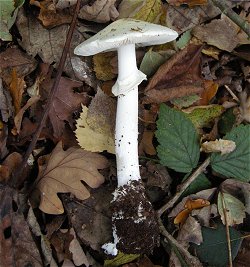
I visited a couple of sites today, looking for specimens to dry for a talk I am booked for. Calderstones Park in Liverpool always has lots of Geastrum triplex so I collected a couple. I also found an unusual Pluteus cinerfofuscus. I thought it was Pluteus salicinus but I examined six gill sections and could not find any of the typical Pluteus horned cystidia. I then went to Speke Hall for some more bits and pieces and found a beautiful Amanita citrina var. alba (False Deathcap). It differs from the standard citrina as it does not have the yellowish veil remnants on the cap and has a smooth stem. I did not know there was a variety until I checked it at home.
Sunday 19th October 2014


I was unable to get to my North West Fungus Group foray but having fulfilled my family commitments, I joined a colleague who was holding a public foray at Moore Nature Reserve. He was a bit overwhelmed when over forty people turned up. Thankfully the fungi have started to sprout and we found lots of species, over one hundred. Highlights were Lepista panaeola, growing in a very large ring in the same place as last year. Ossicaulis lignitalis (Mealy Oyster) growing in a hole in a birch trunk, Agrocybe erebia (Dark Fieldcap) and Entoloma hebes (Pimple Pinkgill). One that caused discussion was a Coprinellus growing on an orange ozonium. The spores matched Coprinellus micaceus but, at this time of year, it should be Coprinellus domesticus. This is why mycology is so interesting.
Thursday 16th October 2014

I went out this afternoon. Things are starting to pop up. I came across a young couple who were foraging for edibles who said that they had found a large ring of Marasmius oreades. Unfortunately my arrival disappointed them because they were Hygrocybe laeta (Heath Waxcap). I then proceeded to mesmerise them with my knowledge of fungi. I probably saved them from an early death. I persuaded them into my favourite copse of conifers where we found forty or so Geastrum striatum (Striate Earthstar). I have never seen this many before. Hopefully, we will have two new members next year. Still alive I hope.
Tuesday 14th October 2014
An interesting day at my allotment. A day of tidying up before heavy digging begins. My first find was of Mycena olivaceomarginata. It has cystidia with thick digital growths, as does Mycena vitilis. But vitilis grows in woods. Mine was in grass. Taking down my runner bean frame, I was surprised to see Psilocybe cyanescens (Blueleg Brownie) was attached by mycellium to the base of one of the bamboo canes. Next, while clearing grass from my raspberry canes, I noticed a violet coloured film-like fungus on an old stem. After much research, my conclusion is Exidiopsis efffusa. This species is not previously recorded on raspberry. Another Exidiopsis is but it is described as white which mine is not. The microscopy fits effusa better.
Monday 13th October 2014
Golf today. It did not rain. Still nothing much around. A couple of Lacrymaria lacrymabunda (Weeping Widow) on a flowerbed. We did come across the most perfect Amanita muscaria (Fly Agaric) on the last hole. I wish I had packed a camera. As one of my non-mycology colleagues said - it was just a round ball on Saturday. So it was.
Saturday 11th October 2014
I joined colleagues at Dibbinsdale Nature Reserve to promote National Fungus Day. A disappointing turn out mainly of Reserve volunteers. Fortunately the recent rain brought a few fungi out but many species expected at this time of years were absent. There was enough of interest, including Stropharia aeruginosa (Verdigris Roundhead), Inocybe geophylla (White Fibrecap) and Rhodocollybia maculata (Spotted Toughshank). We managed to find a good number of Ascomycetes and Polypores so we were able to cover most fungal groups. Our audience seemed to enjoy themselves. Let us hope that they continue their iterest.
Friday 10th October 2014

I am hosting a Nationa Fungus Day foray tomorrow so I had a look round one of my local woods to see what the prospects were like. Still not much but they are starting. A lot of Coprinopsis atramentaria (Common Inkcap) and Pholiota gummosa (Sticky Scalycap). I shall take some with me tomorrow just in case. An interesting group of Lasiosphaeria ovina on dead wood. I have only seen white ones before. These were grey and the hairs were very obvious. I thought I had found one of the other species but the spores confirmed ovina.
Thursday 9th October 2014
My colleagues have now returned from their weekend at Keswick. Despite the rain, they seem to have had a productive time. Seventeen different species of Hygrocybe (Waxcaps) from Latrigg Fell. That is a great deal more than we found at Moore on Sunday. I am not sure if we managed to find seventeen species. Dodging the heavy showers as usual, I managed to get to my allotment to pick some veg. I came across a fungus growing on the grass path. It had a greyish cap but did not ring a bell at the time. Under the microscope, the white spores were warty and the few cystidia I found were pointed some with encrustations. Clearly a Melanoleuca. I narrowed it down to Melanoleuca excissa (Smoky Cavalier) but the literature is not clear on a couple of similar species. It is a difficult genus on which to reach a confident conclusion.
Sunday 5th October 2014
Most of the North West Fungus Group went to Keswick for the weekend. I and a few colleagues held a foray at Moore in Cheshire. The rain came a little too late and it turned cold. The fungi were a little sparse but we found enough of interest. A new species for me was Phlebiella tulasnelloidea, a grey resupinate on a fallen branch. The corticiod fungi can be difficult to identify. Luckily this one has very distinctive round warty spores.
Sunday 28th September 2014
Today I led my annual public fungal walk for the rangers of Ainsdale Sand Dunes Reserve. According to the news this is the driest September for sixty five years. It was a struggle but we did manage to identify thirty five species. Nothing unusual, which is preferable when leading a public walk. It avoids the embarrassment of not being able to identify something. Rhodocollybia maculata (Foxy Spot) is not a common find on this site. Psilocybe cyanescens (Blueleg Brownie) also turned up.
Friday 26th September 2014
Just returned from my week in Switzerland. Very spectacular scenery but not many fungi. All I saw was an unknown Hebeloma (Poisonpie) and Pholiota squarrosa (Shaggy Scalycap). I did see some Pleurotus eryngii (King Oyster) on sale in a supermarket. I intended to buy some as I have never tasted them. Unfortunately I forgot. So I still do not know what they taste like.
Sunday 14th September 2014

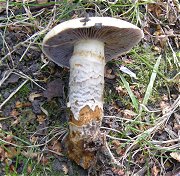

I went to the North West Fungus Group foray at Clock Face Country Park near St. Helens. We found large patches of Lactarius pubescens (Bearded Milkcap). This species was growing just about everywhere a pine tree grew. Further along the path we came across a more colourful relative, Lactarius torminosus (Wooly Milkcap) and also Lactarius deliciosus (Saffron Milkcap). The boletes were also well represented by Suillus luteus (Slippery Jack), Suillus grevillei (Larch Bolete) and an uncommon Suillus viscidus (Sticky Bolete).The most interesting finds were of Cortinarius, a difficult genus to identify even with a microscope. Fortunately these had very clear distinguishing features, Cortinarius trivialis (Girdled Webcap) and Cortinarius alboviolaceus (Pearly Webcap). Also found was a very uncommon Tricholoma psammopus (Larch Knight) that has not previously been recorded locally. Considering that this former colliery land was only reclaimed in the late 1990s, we were surprised by the diversity and numbers of fungi that could be found. Sixty species identified on the day.
Friday 12th September 2014

I have spent days looking at a small Ascomycete found on a fallen branch at Ainsdale. It has projections like fingers. I have been carefully scraping the ends of the 'fingers' looking for spores. Nothing. My book shows a species, Eutypella scoparia, that looks just like my specimen. Reading the description, I discover that the spores are all kept in the base and that the 'fingers' are sterile. So I had been wasting my time. I then found the spores and asci.
Sunday 7th September 2014

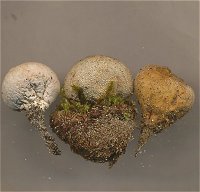
I led a foray for North West Fungus Group to Ainsdale Sand Dunes Nature Reserve. A joint effort with Mersyside Naturalists to honour a founding member and mycologist who died some years ago. We could have done with a bit more rain as, being sandy, it was a little dry. We did not find as much as usual but we identified about sixty on the day. Highlights were Amanita submembranacea on the dunes in the same spot as it was in 2005, Bovista limosa (Least Puffball), a tiny thing which is a specialty of this coast. Also Suillus collinitis (Weeping Bolete), a double for Suillus granulatus but it has pink in the stem base. Still battling through the little boxes. I actually succeeded in identifying a Cortinarius uliginosus (Marsh Webcap), found in a ditch. The other three Cortinarius have totally defeated me.
Friday 5th September 2014



I spent most of the day picking my apples and pears. Then I gave most of them away. It was such a good year. I then decided I deserved a walk so I went to Speke Hall. Quiet now that the schools have gone back. I managed to access a boggy area that is usually too wet to access. A nice Lactarius blennius (Beech Milkcap), Lepiota boudieri (Girdled Dapperling), which I thought was a Cystoderma until I was able to look at the spores. New one for me. Three different Inocybes of which I have so far only managed to identify Inocybe mixtilis. An interesting white thing, that stained red, was in patches on the dried boggy area. No idea. Lots of Lyophyllum decastes (Clustered Domecap) in the kiddies adventure area. And some pretty Russula caerulea (Humpback Brittlegill). Not a bad couple of hours.
Thursday 4th September 2014
Played golf at Huyton this afternoon, just for a change. Lots of fungi about, in numbers rather than species, mainly under oak. Usual suspects. Paxillus involutus (Rollrim), Russula atropurpurea (Purple Brittlegill), Amanita rubescens (Blusher) in hundreds. One Inocybe caused me problems. I settled on Inocybe stellatospora (Wooly Fibrecap) but not with total confidence. The other species of interest was Gloeophyllum sepiarum (Conifer Mazegill) growing from wooden supports on the paths.
Monday 1st September 2014
The day got off to a bad start when I discovered I had a flat tyre. So no golf. Not all bad though. It just so happens that the local tyre fitters have their premises just down the road from Speke Hall. I was able to leave my car and go for a quick look round Stockton's Wood. The fungi were all standard species like Hebeloma crustiliniforme (Poisonpie), Lycoperdon perlatum (Common Puffball), Lactarius tabidus (Birch Milkcap) but each had produced a large number of fruiting bodies. A few species, although common, were new to my list for this wood although I do not often visit this part which is a good walk from the Hall and my usual parking place. Must go back soon for a closer look.
Friday 29th August 2014

I played in a golf competition this morning. Not much time for fungi as it poured down and I was hitting the ball straight. I did have time to collect another four Boletus edulis (Penny Bun), one from a new area. They are branching out. A bit of news from our foray to Dibbinsdale on the 17th. A fairly large brownish fungi growing in grass has been identified as Amanita lividopallescens. It is to be sent to Geoffrey Kibby for confirmation. It was very deep rooted as I had to dig it out to get at the volva. Only 29 records on the National Database so a good find.
Thursday 28th August 2014


Mrs. Myco was playing golf. The sun came out. I decided to use my National Trust membership and visit Errdig Hall, near Wrexham. A very impressive house. I did not intend to look for fungi but one always has an eye open. The woods were disappointing. I sometimes think that NT means National Tidy. I did find a very photogenic Gymnopilus junonius (Spectacular Rustgill or is it Happy Jim?) but not much else. It was such a nice day, I decided to go on to Chirk Castle. Impressive building, beautiful gardens but not much sign of fungi apart from Grifola frondosa (Hen of the Woods) on and around a fallen tree in the car park. Perhaps too early for these sites?
Wednesday 27th August 2014

Big day today. I played golf. It did not rain. The fungi exploded. Loads of Leccinum duriusculum. Nearly every Aspen tree was surrounded. Lots of Amanita rubescens. I have never seen so many. Every Larch copse had Suillus grevillei. Leccium scabrum under the birch. AND I picked 1 KG of Boletus edulis which has now been sliced and put in the boiler cupboard to dry. The only other species of interest was a group of Pholiota gummosa, presumably on an old stump.
Tuesday 26th August 2014


After a muddy morning of harvesting and then pickling beetroot, when the sun eventually came out, I went for a quick walk round on of my local parks. There were fungi everywhere. I brought a boxful home. A couple of large ones, Agaricus impudicus and Chlorophyllum brunneum, both under Cupressus. A small (unfortunately) Boletus edulis (Penny Bun), three different Russulas, Parasola leiocephala and auricoma, which look quite different when seen together. The afternoon sun also brought out lots of parents and children so I had to curtail my effort. I shall go back when it rains.
Monday 25th August 2014

I took advantage of a break in the rain to visit my greenhouse and harvest some tomatoes. On the grass path, I found Mycena olivaceomarginata (Brownedge Bonnet). The English name is very accurate. The brown edge to the gills is very distinctive. I also found a patch of the poisonous Clitocybe rivulosa (Fools Funnel). This is early as all my previous records for this area are from October onwards.
Saturday 23rd August 2014
I agreed to take a public walk in support of a Bioblitz at Knowsley Safari Park. The Park has a woodland walk. The woodland is not very large, you can walk round in about ten minutes. Half is pine, the other half sycamore with a few oaks. Most of the ground is covered with bracken. Not promising. Unfortunately, I had to compete with the falconry show in the adjoining enclosure. When that ended only one person joined me for the walk. He was a very nice man and we found twenty species, the most exciting being one Macrolepiota procera (Parasol). It seems that fungi can not beat hawks and owls.
Friday 22nd August 2014


After a morning of picking and pickling green chilli peppers, I needed a breath of fresh air so I went to Speke Hall for a look round. The public was out in force so I visited the adjoining ancient woodland. My first find was of Lepiota brebissonii (Skullcap Dapperling), an uncommon woodland species. Most spectacular was a large group of Laetiporus sulphureus (Chicken of the Woods). Not an unusual fungi but this was growing on a living horse chestnut. There are only five records for this host on the National Database. That said this species is often found on unidentifiable trunks and stumps.
Thursday 21st August 2014


I have recently done so many forays for other people that I had a look round on my own at one of my favourite woods at Hale Hall. Never disappointed. My first find was of a couple of Melanoleuca verrucipes (Warty Cavalier). Not a bad start. In an hour, I had collected over 20 species without trying. Two Xercomellus species, one being X. engelii with orange spots at the stem base, the other was X. porosporus, a drab cap that cracks to show a white flesh. Gymnopus ocior is an unusual find for me. Prettiest was Leratiomyces ceres (Redlead Roundhead), a good specimen on some fallen bits of wood.
Sunday 17th August 2014

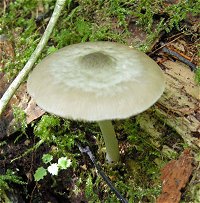
I went to the North West Fungus Group foray at Dibbinsdale Country Park at Wirral in Cheshire. Our debutante leader was concerned because she could not find much when she went to reconnoitre the site earlier in the week. However the joint effort found seventy-five species identified so far. Boletus edulis (Penny Bun), Pluteus chrysophaeus (Yellow Shield) and salicinus (Willow Shield), Megacollybia platyphylla (Whitelaced Shank), Lasiosphaeria ovina , Sceroderma cepa to name but a few. It was blowing a gale but we did manage to avoid the rain. It is over ten years since I forayed on this site. It is still as productive as ever.
Wednesday 13th August 2014
I led a public foray for Merseyside BioBank who organised a bioblitz. Unfortunately the morning started with an immense cloudburst. This seemed to have washed all the fungi away. The best find was of a large Agaricus augustus (The Prince) under conifer. After that only the usual common brackets and even they were hard to find. I think the audience was disappointed but it was not the messenger's fault. Then the sun came out and I played golf. Still lots of Leccinum duriusculum (Slate Bolete) and some Agaricus bitorquis (Pavement Mushroom). Then, on my way to the pub to wind down my day, I found Inocybe napipes (Bulbous Fibrecap) under a young beech tree. Busy day.
Monday 11th August 2014
Walking down the path to my allotment, I came across an Agaricus growing in the grass. It was Agaricus campestris (Field Mushroom). These are not so common in places where there are no horses. But on the allotment site, we buy a wagon load of horse manure from the local stables and members then barrow it along the paths. I had it for breakfast. Very nice.
Saturday 9th August 2014
I joined the Liverpool Botanists at Hightown on the Sefton Coast. They identify the plants which helps me identify any ascomycetes. Unfortunately, all the plants seemed to be in pristine condition. The only one I found was an inconclusive Alternaria on Soapwort. A few proper fungi, Lepiota erminea and Bovista plumbea (Grey Puffball) on the fixed dunes. I also found Claviceps purpurea (Ergot) on some oat grass which was of more interest to the botanists. For my part I was very interested in the finds of Isle of Man Cabbage, a rare coastal plant. Also lots of Marsh Samphire. Must look up some recipes and go back and pick some.
Sunday 3rd August 2014
I spent the morning picking peas and beans (and courgettes) on my allotment. After two days of heavy rain I went for a quick walk to see if anything had started to fruit. Not a lot. I was surprised by a large patch of Polyporus leptocephalus (Blackfoot Polypore) in a beech wood. Nearly every piece of fallen wood had a specimen on it. Poking about under some blackberry I spotted a Cyathus striatus (Fluted Birds Nest). Unusual for it to be on its own, unless I just did not see any others.
Friday 25th July 2014
After a week of scorching hot weather, I did not expect to find any fungi when I played golf this morning. I was wrong. Under an aspen tree, I found two patches of very healthy Leccinum duriusculum (Slate Bolete).
Monday 21st July 2014
My allotment neighbour asked me if I knew what was affecting his Monarda plants. They were obviously displaying a powdery mildew. I could not find any reference to Monarda in Ellis & Ellis. Research on the web showed it was part of the mint family but that did not help. Eventually I found a website that identified the mildew as Erysiphe cichoracearum, apparently a common problem with this flowering plant.
Sunday 20th July 2014
I have spent most of the week trying to, identify the fungi we found last Sunday. As expected the Inocybes proved to be difficult but we democratically decided on Inocybe curvipes. The Psathyrellas were unresolved as 'Little Brown Jobs' and the Cortinarius totally escaped recognition. The Melanoleuca cognata turned out to be Xerula radicata (Rooted Toughshank). The day did produce ninety confirmed species. Not bad for a park that was only created sixteen years ago. And in July.
Wednesday 16th July 2014
Golf. I am playing well so not much time for fungi. I did spot Polyporus squamosus (Dryad's Saddle) growing from a sycamore that had been pruned. The tree is still alive so it must be growing from the dead wood left after the pruning.
Sunday 13th July 2014
North West Fungus Group held a foray at a new site, Beacon Country Park in west Lancashire. Being our first foray we did not know what to expect as it has been very hot recently. We had an excellent day. So far 76 species identified with some more to look at in little boxes. An interesting find of Ganoderma applanatum (Artists' Fungus) on pine, a very uncommon host. Also of interest were Pluteus plautus (Satin Shield), Psathyrella leucotephra and Pholiota flammans (Flaming Scalycap).
Saturday 12th July 2014
Today I joined the Liverpool Botanists at Wigg Island, Runcorn. Situated in the middle of the River Mersey, I expected a wetter site but it proved to be very dry. Apart from various mildews on plants for which I have to thank the botanists for identifying, the only large fungus I saw was Psathyrella candolleana (Pale Brittlestem). The site of an old demolished ICI chemical plant, a lot of it is about to be included in the new Mersey Bridge project. It is a nice reserve but probably a bit too young for decent shows of fungi.
Wednesday 9th July 2014
Golf today. I was a bit wild so ended up in trees where I had not been before. There I found some Amanita fulva (Tawny Grisette). A little later on we came across some Lacrymaria lacrymabunda (Weeping Widow). Considering that the golf course has recently been prepared for a major competition, to find anything still growing is a bonus. Looks good for the future.
Saturday 5th July 2014
I joined the Merseyside Naturalists at Freshfield Dune Heath. Not much fungi about as it has been very dry and the area is sand based. A small woodland produced a couple of Amanita fulva (Tawny Grisette). I also found some Daldinia fissa on burnt gorse. After lunch we moved to Ainsdale to look for tiger beetles and Helleborines on the sand dunes. Both were found, this being the most northern site for the beetle. I was able to show my companions a large number of Psathyrella ammophila (Dune Brittlestem). None of them had previously seen fungi growing on sand dunes so I was able to extend their knowledge.
Thursday 3rd July 2014

Bad news on the allotment. My onions have been attacked by the aptly named Peronospora destructor (Onion Downy Mildew). I checked the spores which remind me of fruit on a branch.There is no chemical cure and all I can do is use the onions as quickly as possible and destroy the leaves. Looks like a lot of onion soup. -
Wednesday 2nd July 2014

Did a spot of gardening this morning. One of my bushes is dying. I noticed a bracket fungus starting to grow near the base. It looked to me like a Ganoderma. Not knowing what the bush is, I had to go down to the local Garden Centre. They tell me it is an Escallonia. Checking the National Database, I note that Heterobasidion annosum (Root Rot) has been found on this host. Could be. I shall have to wait and see how it develops. Unfortunately, the bush might fall over before that happens.
Saturday 28th June 2014
Merseyside Biobank held a bioblitz at Sudley Hall, Liverpool. An old merchant's house, now a museum, it has a small stand of beech that sometimes produces unusual specimens. However, it is a bit early in the year so I declined to run a foray for the public as I did not think we would find enough to justify public participation. I had a look round. It has been very dry and the current policy of minimum maintenance of the grassy areas made my search difficult. I only found seven species. Some old and dry Russula nigricans (Blackening Brittlegill), Russula fellea (Geranium Brittlegill) and Boletus erythropus were the only Agarics. The rest were the usual common species found on stumps. I was right to decline.
Friday 27th June 2014

I was at my allotment this morning and noticed that my Scarlet Pimpernel was showing a leaf fungus. I identified this last year as Alternaria anagallidis. I sent details to Kew but their view was that this species may not be host specific so they would not take my specimens. I managed to get some very good spores samples this time. It is definitely an Alternaria. If not Alternaria anagallidis, what could it be?
Thursday 26th June 2014
During my visit to Iceland I had an interesting conversation with my tour guide. She told me how plentiful are the fungi there. She picked them to eat. In particular some brown ones under birch. Her husband was sceptical when she cooked them for him but liked them. They had gills so were not boletes. She also told me that all the red ones under birch were edible and she also cooked them. I offered some cautionary advice but this was not accepted. I wish them both well.
Tuesday 24th June 2014

Just arrived home having been on holiday to Iceland. Not many fungi about. Lots of birds and flowers. I did manage to find Agrocybe pediades (Common Fieldcap). The only other one I found was a bright red Russula on short turf. Not a tree in sight. The only one that I can find that fits the description is Russula nana (Alpine Brittlegill). It grows in alpine meadows with alpine dwarf shrubs. Spot on. -
Sunday 8th June 2014

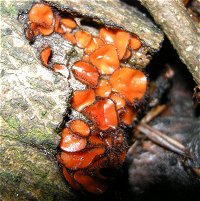
The North West Fungus Group held a foray at Tandle Hill, Royton near Oldham. It has an extensive beech wood which is very wet and this kept us occupied for most of the morning. Because of the early date we were restricted to looking for the smaller fungi under logs and on branches. An interesting find of Flammulaster carpophilus (Powdercap?) on a beech cupule and dead wood. A collection of Scutellinia scutellata (Eyelash Fungus) on some stacked logs. Lots of myxomycetes (Slime Moulds) on the soggy deadwood. Ceratiomyxa fruticulosa was everywhere. Fifty species recorded so far. We ended with a spectacular display of Fomes fomentarius (Hoof Fungus) and Pleurotus ostreatus (Oyster Fungus) on the same fallen tree.
Monday 2nd June 2014
Proper golf today. My first find was of Calvatia gigantea (Giant Puffball). It has grown on the same spot since 2010. How a fungus so large survives in such a heavily maintained environment is a mystery. A later find was of a group of Amanita excelsa var. spissa (Grey Spotted Amanita), smelling of radish. Again in the same place as previous years.
Sunday 1st June 2014

After a morning of planting cabbages and peas, I went for a quick walk round the local golf course to get my muscles working. The entrance to the course is directly opposite my allotment. I was fortunate to spot some very tiny Mycena acicula growing from the end of a fallen twig. First record for this site.
Friday 30th May 2014
Golf this morning. A few more early Amanita rubescens (Blusher) have appeared in a different area. I also found Agrocybe pediades (Common Fieldcap) growing on the top of a sand bunker. I wonder if they came with the sand?
Thursday 29th May 2014

I popped out for an hour after it finally stopped raining. No gilled fungi to be seen so I had to resort to looking under logs and sticks. One ascomycete, Tapesia fusca and one myxomycete, Steminotopsis typhina, were all I had to show for my time.
Tuesday 27th May 2014
I visited one of my local woods. Unfortunately the warm and wet weather has encouraged plant growth and it was very overgrown. I found some piles of woodchip on which were growing Coprinopsis lagopus (Haresfoot Inkcap), Parasola auricoma (Humpback Inkcap) and Melanoleuca verrucipes (Warty Cavalier). My only other source was a single dead stem from Arctium minus (Burdock) on which I found Lachnum virgineum, Calpytella capula, Mollisia clavata and Periconia cookei. Not bad for one stem. I did not even see the Periconia until I looked at the stem under my microscope.
Monday 26th May 2014
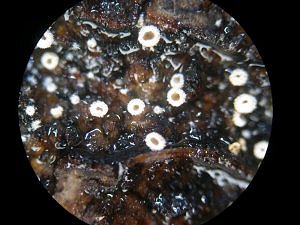
I have been befuddled by a small fungus that I found on an old log a couple of days ago. It is a tiny hairy disc that looks like a Lachnum. But the spores are not typical. Then (after three days of research) I realised that I not found any asci so it could not be an Ascomycete (spore shooter). I eventually tracked it down to Episphaeria fraxinicola. Only twenty-five records on the National Database. It is very, very tiny so easily missed.
Wednesday 21st May 2014
Golf today and I played well so did not visit the trees at all. For the past couple of years, I have not found any Calocybe gambosum (St Georges Mushroom) on the course. They had grown in the same places for the past 15 years. Today, while waiting for my partners to play, I was walking along the side of a small copse where I have never before seen any species of fungi. And there they were. A large ring of Calocybe gambosa. There were also a number of Lycoperdon pratense (Meadow Puffball) growing on various teeing areas, where they like the very short grass. The tees are mown in the morning. How do they grow so quickly?
Tuesday 20th May 2014
Allotment today. Passing a nice crop of poppies on a neighbouring plot, I noted that some of the leaves were showing a few spots. The only fungus I can find is Entyloma fuscum, a smut, for which there are only four records on the National Database. I managed to photograph a spore but lost some others when I tried to improve the specimen on my slide. It looks right from the information I have gleaned from the Internet but I need to have another go. Fortunately there is plenty of material. I hope my neighbour does not decide to get his hoe out.
Monday 19th May 2014
Golf today. I was very surprised to find Amanita rubescens (The Blusher) in a small copse of pine and birch. This is the earliest by two weeks of any previous record that I or the North West Fungus Group has. Add this to the Leccinum I found in April and the Russula from Sunday, there may be a pattern of early fruiting emerging.
Tuesday 13th May 2014
Allotment today. I found a couple of Agrocybe praecox on a grass path.
Monday 12th May 2014
Passing the woodchip on my golf course, I noted that the Melanoleuca verrucipes numbers had increased to about fifty. Many of them are only a few centimetres across. The same shrubbery is also supporting the same number of Agrocybe rivulosa.
Sunday 11th May 2014
I led the North West Fungus Group foray to Carr Mill Dam. I chose the site because spring has been so dry for the past two years and there are lots of marshy areas where we always find fungi even at the height of summer. Of course this year it poured with rain and it was flooded. Also lots of Himalayan Balsam which is growing unchecked. We found a very early and slugeaten Russula gracillima (Slender Brittlegill) by the water s edge. This is very early for any Russula. We identified fifty-three species. The most interesting was Cudoniella clavus var. grandis (Spring Pin). The dead Balsam stems did produce a few ascomycetes which we are still discussing.
Wednesday 7th May 2014
Last year my Golf Club removed some ancient Rhododendrons and replaced them with a shrubbery on which they spread copious amounts of wood chip. Today I recorded seven Melanoleuca verrucipes (Warty Cavalier). A new record for my golf course A couple of years ago this would have been regarded as a rarity. This fungus has benefitted from a warmer climate. The woodchip is home grown so it is not an introduced species. It got there by itself. It clearly likes very fresh wood chip so I doubt it will be there next year.
Friday 2nd May 2014
I have just returned home after a visit to Great Yarmouth. I walked along the coast and they have a wonderful expanse of coastal dune grassland. Unfortunately it was so cold that I did not venture too far. I ended up at Great Yarmouth Races where a woodchip bed produced the usual Coprinellus auricomus, Leratiomyces ceres (Redlead Roundhead) and Agrocybe putaminum. Am now back home. Warmth at last.
Saturday 26th April 2014

I joined the Liverpool Botanists for a walk through the woods at Runcorn. Runcorn is a new town. I have only ever seen it when driving along the many expressways that crisscross the area. I did not know that it is built through and around a large area of ancient woodland. So large an area that a pedometer carried by one of us registered 8.5 miles when we finished. It was a long walk. The botanists identify the plants which means I can then identify the various host specific rusts. Otherwise I would struggle. Not many fungi about but I was able to contribute Disciotis venosa (Bleach Cup), Calocybe gambosa (St. Georges Mushroom) and introduce them to the delights of the ascomycete, Lachnum virgineum (Snowy Disco) that they had previously though were a few spots until they looked at them the through my magnifier. In turn their identification of an Arum maculatum (Lords and Ladies) helped me to identify the uncommon Puccinia sessilis.
Wednesday 23rd April 2014
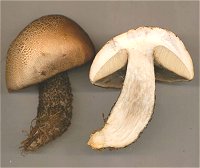
I played golf today and this one took me by surprise. Leccinum scabrum under a birch tree on the 23rd April. The earliest Leccinum I have ever recorded is of Leccinum variicolor, on the 25th May, on the same golf course. So this find is way off the scale :-
Sunday 20th April 2014

A colleague found some strangely shaped specimens that looked like a type of Morel but he could not identify them. He circulated the details to see if any of us could help. The size and shape of the spores confirmed a type of Morel. We reached the conclusion that they were large and misshapen Verpa conica. A request for assistance from Wild About Britain confirmed our deliberations.
Saturday 19th April 2014

Someone took a photo of the Xylaria oxyacanthae from the foray on Sunday. Here it is :-
Sunday 13th April 2014
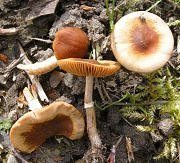

I led a foray for North West Fungus Group to Freshfield Dune Heath and then into Ainsdale Sand Hills Nature Reserve. Not a lot of gilled fungi, the best being Entoloma clypeatum, Conocybe parasola and Parasola leiocephala on Formby Golf Course. A rare Inocybe ochroalba was the highlight. It is a unique area and often produces rarities. Lots of Ascomycetes, so I shall be spending most of the week trying to identify them. An interesting find was of Xylaria oxyacanthae. It looks like Xylaria hypoxylon (Candlesnuff) and grows on buried hawthorn berries.
Friday 11th April 2014
I met up with some colleagues at Dibbinsdale Nature Reserve on the Wirral. We intend to hold a public foray on National Fungus Day in October so thought we should have a look and sort out details with the Ranger. This is a good fungi site that I have not visited for twenty years. It now looks very different but I managed to find my way round. Sadly we did not find much in the way of fungi at this time of year despite the fact that this is a wet site. Disappointing but I am sure that it will be productive when we hold our event.
Saturday 5th April 2014

I spent this morning sowing peas and putting up nets for them to climb up. As I was sticking my bamboo cane supports into the ground, I noticed that one cane was sporting some fungi. I have not completed my examination but the signs so far indicate Resupinatus applicatus (Smoked Oysterling). It is very tiny. There is no mention on the National Database of this species growing on Bamboo. The cane is hollow and there is some soil (and a couple of worms) in the space but there is nothing else to support it. It also seems to be growing inside the cane.
Wednesday 2nd April 2014
Yesterday, while out walking on my local golf course, I found a couple of Psathyrella candolleana (Pale Brittlestem) growing under some Sycamore trees. It has to be checked microscopically to see the comparatively small spores and rounded cystidia. Today, while playing golf on my own course, I found a couple of Psathyrella, which, after microscopic examination, proved to be Psathyrella spadiceogrisea (Spring Brittlestem). It has slightly larger spores. They can be difficult to tell apart without a microscope.
Monday 31st March 2014
Too busy planting potatoes and sowing peas on my allotment to go foraying. Even golf takes a back seat this week. I did find a solitary Galerina clavata (a Bell) on one of the grass paths which is new for the site. It grows after heavy rain which fits perfectly.
Tuesday 25th March 2014
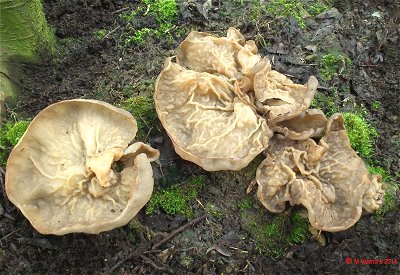
The North West Fungus Group held a foray at Spring Wood, Whalley, Lancashire on Sunday. Unfortunately, I could not attend but the foray leader has sent me a list of finds. Fifty one species were recorded. The highlight of the day was a collection of several Disciotis venosa (Bleach Cup). A first for the site. Being an excellent photographer, he sent me a photograph of the specimens. I have only seen this species once, in North Wales. I shall certainly be on the lookout in my local sites.
Monday 24th March 2014
Did a spot of gardening today. I was putting nets over my blackcurrants when I saw a Peziza growing on the bare soil. It proved difficult to identify because I could not find any spores. Not even in any of the asci. Without a spore I was stymied. Best guess is Peziza badia but it is not a species that I have found on my allotment before.
Thursday 20th March 2014
All quiet at the moment, probably because it has been dry for over a week. Rain today so hopefully things will pick up. I did come across a couple of Agaricus campestris (Field Mushroom) on the grass path at my allotment site. Nothing on the golf course but I am playing well at the moment so no excursions into the woods. I still have not identified the Ascomycete on my African Marigold stems. Now consigned to the Mysteries folder. I photographed everything so it may turn up on one of the specialist websites.
Sunday 16th March 2014
I visited my favourite wood at Hale Hall. It is all very dry. Only Coprinellus micaceus (Glisteneing Inkcap) and a very dry Laetiporus sulphureus (Chicken of the Woods) to be seen. Someone had removed all of my old dead trees that I had been nurturing for years. However, six mature tress had been blown over in the gales so I can start again. My most interesting find was in my back garden on the stem of a Tagetes (African Marigold). One of those tiny black specks had colonised the dead stems. It is an Ascomycete but I cannot find any reference to it in my books or the national database. I have added it to my Mystery file.
Wednesday 5th March 2014
There is a pile of pruned twigs and small branches in a hedge on my allotment site that has been slowly rotting down for a couple of years. I often pick through it as it is a good source for small Ascomycetes. Today I was surprised to see a large gilled fungus growing from the pile. I thought it would be a Pluteus but the spores are white and ornamented. The conclusion is a Melanoleuca (Cavalier). After 5 gill sections, I could not find a cystidia so I have recorded it as Melanoleuca melaleuca. The twig pile must have rotted down to form a sufficient soil base to support this specimen.
Thursday 27th February 2014


I have been struggling to identify a small Ascomycete (spore shooter) that I found on a pine cone. I was checking the website forums on AscoFrance and noticed an article about a Pyrenomycete fungus living on an Ascomycete that looked just like my mystery. Further research showed my fungus to be Propolis farinosa. This is a common species but none of my books had it growing on pine. A check on the National Database revealed a number of examples on pine, including cones. I wonder why the books omitted this.
Tuesday 25th February 2014

Many years ago I bought one of the small Bresser microscopes from Lidl. It is useful because it has an overhead light so I can take photos of tiny Ascomycetes. But when I moved to Windows 7 and 8 the microscope camera would not work because the software was too old and I could not replace it or update it. A colleague told me about a download from a site run by Richard Shotbolt. It works fine. Better than the original. I found this black thing on Himalayan Balsam. It is Torula herbarum. Only two entries in FRDBI but I fancy it is very common as there are lots of pics on Google. The spores are taken with the camera. Not bad?
Saturday 22nd February 2014

The Annual General meeting of the North West Fungus Group at Risley Moss is always followed by an informal walk around the Reserve. Lots of log piles that were very fruitful. It is mainly Birch and the first find was of the uncommon Ciboria betulae (Goblet). A colleague found another on an old Alder catkin that should be Ciboria caucas (Alder Goblet). Hemimycena tortuosa (Dewdrop Bonnet) was under many of the log piles. As usual, there was a lot of Sarcoscypha austriaca (Scarlet Elfcup). I await the results of other members with interest.
Wednesday 19th February 2014
Another nice day so I played golf. I was surprised to find another Earth Tongue. This time in the car park. It was Geoglossum cookeianum. That makes 2 different species this month. I also found Galerina graminea, another new species for the site. As I foresaw, I am struggling to identify many of the Ascomycetes from Ainsdale. One on a pine cone, I thought would be easy but no luck so far in my books.
Tuesday 18th February 2014
I took advantage of some beautiful weather to take a look at Freshfield Heath and Ainsdale Reserve. As you would expect after the high winds, there were lots of fallen trees, branches and debris. And it was very damp. I managed to get a good collection of Ascomycetes and a few Myxomycetes very quickly. Whether I manage to identify them all is another matter. The dead gorse on the heathland was particularly fruitful. There is a lot of cow and sheep dung but perhaps too fresh at the moment. A few basidiomycetes, Clitocybe fragrans (Fragrant Funnel), a nice Galerina clavata, Crepidotus luteolus (Yellow Oysterling) and mollis (Peeling Oysterling).
Sunday 16th February 2014
After the hurricane winds and heavy rain, I was able to get out to see if any promising trees and branches had been dislodged. I went to my local golf course where there is a very old Monkey Puzzle tree. I collect all the fallen bits from this tree in one place so that I can check to see if and when they support the growth of Hohenbuehelia cyphelliformis. The first thing I found was a freshly fallen branch from this tree. I knew it was fresh because I had been there only on Thursday to check. It was sporting three little specimens. As none of my branch collections have ever grown anything, I am tempted to conclude that this fungus grows on the attached dead branches before they fall rather than afterwards. Nothing much else around. The rain must have battered them into submission. All dead leaves, needles and twigs have been washed off the raised banks and there is a lot of erosion leaving some of the trees in a perilous position.
Monday 10th February 2014
No rain. Golf. A bit of early light frost. The warm, wet weather seems to have confused some fungi. An errant golf ball landed in a small copse of Silver Birch (Betula pendula). It was surrounded by Gymnopus dryophila (Russet Toughshank). During the early gales before Christmas, one of the Silver Birch trees snapped and the rest was sawn down. The resultant sawdust has been very quickly colonised by Tubaria furfuracea (Scurfy Twiglet).
Tuesday 4th February 2013


I have been collecting lots and lots of discs, blobs and hairy things from various bits of dead and rotting wood. Half of them are common and easy to identify. The other half, despite having all the microscopic information, totally mystify me. I have been looking at Ascofrance.fr for inspiration only to find that there dozens of people who are just as confused as I am. I collected a dead nettle stem that had been colonised by what turned out to be the very common Leptosphaeria acuta. However, under under my microscope, I also noted some unseen tiny spikes that I thought would be young or old Leptosphaeria. But they had different spores and my Ellis & Ellis directed me to Endophragmia (now Phragmocephala) atra. Only fifty four entries on the Database so not seen very often.
Wednesday 29th January 2014

At last it stopped raining long enough to play golf. A bit rusty and I ended up in the trees. In a patch of moss I found Clitocybe fragrans (Fragrant Funnel). As I was picking it, I noticed a first for the Golf Course. Some Geoglossums (Earth Tongues). I have tentatively identified them as Geoglossum glutinosum from the size of the spores and other microscopic bits. Hopefully a more knowledgeable colleague, who wrote the Beginners Guide to Earth Tongues will confirm it.
Tuesday 28th January 2013
Too wet even for me to get out. Earlier in the year, I identified a find as Lepiota subincarnata. I had not seen one before and the books suggested that it was unlikely that I should find it in the shrubbery at my local park. With some help with literature from my colleagues, I decided that there was nothing else it could be. Having received the latest copy of Field Mycology, I was very pleased to see a featured article about it. It seems my local park should be the perfect place for it.
Wednesday 22nd January 2014
Still wet and warm. I went for a walk to see if the Geastrum striatum (Striate Earthstar) were still in the usual place as I could not find them at the end of last year. I did find them but it was hard work trying to spot them in the coniferous debris. Another find was Schizophyllum commune on a fallen Beech tree, only the third time I have ever found it in this area. The mossy areas beneath the Yew and Pine trees produced lots of Galerina vittiformis (Hairy Leg Bell) and Hygrocybe laeta (Heath Waxcap). Having carefully collected lots of very small Mycenas (Bonnets) from twigs, moss, logs, branches, whatever, they were all Mycena adscendens (frosty Bonnet). Very disappointing.
Saturday 18th January 2014
How long will this good weather last? Back to Speke Hall and the adjacent Stockton's Wood. Still a few Mycenas (Bonnets) about. Usually small and white. Usually Mycena adscendens (Frosty Bonnet). But I live in hope that something unusual will appear. That is the whole point of foraying. I am building a large dried collection of unknown Ascomycetes that I cannot find in any of my books. They are all photographed and measured so I am ready if something turns up. Like a Volutella that I waited for a year before I finally was able to identify it. But I got it eventually.
Wednesday 15th January 2013

I paid another visit to Speke Hall to do a bit of 'log rolling' in the ancient woodland. A few Ascomycetes were unearthed including Tapesia fusca and Polydesmia pruinosa. Best find was of the tiny Hemimycena tortuosa, identified from the water droplets on the stem and cap. This species likes living under logs so has to be searched for. Unfortunately the droplets had disappeared by the time I photographed it.
Monday 13th January 2014

Another sunny day. Golf this morning. I was very surprised to find a Russula fragilis (Fragile Brittlegill) growing under the birches on one of the holes. I know it was not there on Friday so the fungi are confused by the continuing good weather. I noticed some black bits on a dead Ivy stem so took it home. I identified it as Lasiosphaeria hirsuta. Apparently common but a new one for the site.
Saturday 11th October 2014
Glorious weather again. I visited a wood that I did not look at last year. lt is usually full of dogs and kids and famous for 'male exhibitionists' so a difficult area to foray alone. It is on another of Liverpool's sandstone hills so it keeps warm in winter. I was surprised to find a Pluteus cervinus (Deer Shield) on a beech stump. The next stump was growing a mass of Melanotus horizontalis (Wood Oysterling). I remember when this species was new to the UK, having been introduced from Scandinavia and could be found on plywood bird boxes and the like. I once found it growing on my doormat. Now it grows wild.
Sunday 5th January 2014
I had intended to go to Ainsdale but the weather forecast advised staying away from the coast. I went to a wood at Speke Hall instead but only got an hour in before it started to pour with rain. Within a few minutes, I found three Mycenas (Bonnets) and Hypholoma fasciculare (SulphurTuft), the latter being totally absent from the wood I visited on Saturday. Strange how similar woods can be so close and yet one was devoid of gilled fungus. They are both mature Beech, Oak and Birch so you would expect similar fungi, especially as Speke Hall is exposed to the wind coming off the Mersey. It was cold. I also noted a lot of Cudoniella acicularis (Oak Pin). I must go back when the weather improves.
Saturday 4th January 2014

No rain. No gales. Sunny day. So I went out to look at a local wood that I rarely visit. Not much around which is probably why I give it a miss. Yet it is full of old oak and beech trees with lots of fallen wood. Very disappointing. Interestingly, the fungus of the moment in all the sites I have recently visited is Resupinatus applicatus (Smoked Oysterling). Not one I have recorded often but in the past couple of weeks I have found it every time I have been out. Sadly, no sign of its hairy relation, Resupinatus trichotis.
FUNGAL SNIPPETS from MYKOGOLFER for 2013
Tuesday 31st December 2013

An interesting one to finish the year. I collected a small sliver of wood (about 3cms) on which I thought was the common fungus, Chaetosphaerella phaestroma, a very, very black Ascomycete that grows as a mass of little, hard balls on dead wood. I scraped a bit off to look at the spores but to my surprise, the spores were for another similar type of black fungus, Melannoma pulvis-pyrius, also common. Just to check, I scraped another area of my small sliver of wood. Too my surprise, this did have spores from the Chaetosphaerella. So, on one small piece of wood lived two fungi. I must check more often. Happy New Year.
Friday 27th December 2013


The period between the gales was quite nice. I managed to visit a couple of my local sites. An interesting late find of Lepiota castanea (Chestnut Dapperling) that had been protected by a deep pile of leaves. The rest of my finds were of crust fungi or Ascomycetes growing on and under pieces of fallen timber. Bisporella sulfurina (a yellow Disco) grows on old Pyrenomycetes (usually small black fungi embedded into bark). I have found this on a Diatrype and an Eutypella this week. Another find under the leaves was of Crepidotus epibryus (an Oysterling). This one often grows from the dead leaves. It can be very tiny so not easy to spot.
Sunday 22nd December 2013
I went up to my allotment to check on my Brussels sprouts. We have a large entrance gate from the public road. The fenced entrance roadway is of crushed stone hardcore as we regularly have visits from delivery lorries. The entrance has a liberal but not deep, loose scattering of leaves and mast from a large Beech. I was surprised to see five Geatrum fimbriatum (Sessile Earthstar) in this Beech litter on the hardcore roadway. I have not found this earthstar in the area before. I am puzzled as to how they arrived and survived in this particular fungus unfriendly spot. It is a soil free area. The public road and footpath immediately outside have been covered with deep drifts of dead leaves for some weeks until the recent gales and the Council dispersed them last week. Did they grow with the dead leaves? Did they blow in? Very strange. They are not the only fungi that grow from this roadway. The odd Agaricus and Xerocomus force through the surface.
Wednesday 18th December 2013
One of the specimens I collected on Sunday was of a bracket growing on a tree stump. At the time, I thought it would be a Trametes but there was something about the pore structure that made me take it home. I have been waiting patiently for it to drop some spores. After placing it on wet paper a couple of times, it has finally produced. The spores are elliptical not long and thin. My identification is Cerrena unicolor. I have not knowingly seen this before. As it is very similar to a Trametes, I probably do not bother to collect as it would be a long job to examine every similar looking bracket in the hope that something different might turn up. The Checklist describes it as occasional. I must check more often.
Sunday 15th December 2013
Not being a Manchester United fan, I took advantage of the lunchtime weather to look at The Eric Hardy Nature Reserve. Usually it is flooded as the stream regularly overflows. But without appreciable rain for some weeks, it was not the usual morass. Lots of things still growing along the stream bottom which contains lots of soggy logs and branches. Lots of Mycenas (Bonnets), adscendens (Frosty), speirea (Bark), galopus var. nigra (Black Milking), luteoalba (Ivory) and arcangeliana (Angel). Inocybe geophylla var. lilacina (Lilac Fibrecap) in the same place that I found it last year at this time. I found some strange jellylike thing growing on rotten bark that I have not a clue what it is (if it is a fungus). Back in time to watch Liverpool on TV.
Saturday 14th December 2013
I had to take some composting material to my allotment. I was surprised to find a Conocybe rickenii on one of the paths. Under the microscope, the two spored basidia and skittle shaped cystidia abounded. The spores are very large so the eventual choice of species was not difficult. They like dung and rich soil of which there is plenty on an allotment site. I did not expect to find this so late in the year but it has been so mild.
Wednesday 11th December 2013
Golf today. There has been no rain so the grasscutters had been out and decimated everything. I did find a very large patch of Aleuria aurantia (Orange Peel Fungus). My golfing partners thought that someone had spilled a pot of paint on the ground. An errant golf shot landed under a Hawthorn where there was an old stump of something unknown. The two specimens I picked turned out to be Psathyrella spadiceogrisea (Spring Brittlestem). It does grow in autumn and the recent cold spell followed by very warm weather may have fooled it into growing out of season.
Monday 9th December 2013
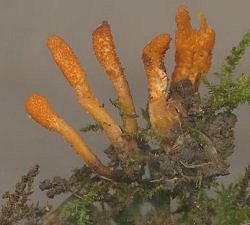
A beautiful sunny day so I decided to go to my golf club and practise a few shots. Aiming toward a small newly planted tree, I noticed some fungi around the base. They turned out to be Cordyceps militaris (Scarlet Caterpillar Club). These grow on dead and buried moth pupae and caterpillars.There are six of them, quite small. I wonder if it was just one dead caterpillar or a mass grave. It is the first time I have found this species on my golf course.
Sunday 8th December 2013
After the battering from the stormy weather, I went for a wander to see if anything interesting had fallen from the trees. Along an avenue of elderly beech trees, I was surprised to find four species of Russula (Brittlegills) still in growing amongst the litter. The common Russula ochroleuca (Ochre) together with nigricans (Blackening), fellea (Geranium) and probabaly ionochlora (Oilsslick) but there was not a lot of this one left. I also found a Lacarius subdulcis (Mild Milkcap) in the same area. I did find a few sticks with bits and pieces on so something to research on dark nights.
Sunday 1st December 2013
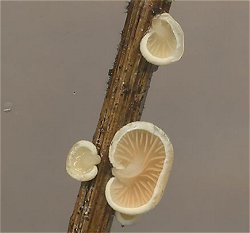
After finding Mycena capillaris last week, I have been searching through the leaf and plant litter for some more of the smaller fungi that grow at this time of year. With some success. Lots of Mycena adscendens (Frosty Bonnet) as one would expect. Also, Marasmius setosus (one of the Parachutes), growing on dead leaves. Another was Crepidotus epibryus (a small Oysterling) on small plant stems. One or two Myxomycetes (Slime Moulds) but I struggle to identify them.
Friday 29th November 2013
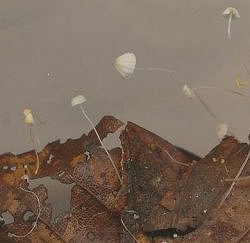
Kicking over some wet leaves in the park, I noticed this small Mycena. Then I noticed hundreds of them. There are a number of different tiny white species of Mycena so impossible to identify them without using a microscope. Using a new key, I identified these as Mycena capillaris. They were on beech leaves so that met one of the criteria. The others are the shape of the spores and the type of cystidia (in this case the round heads with the little spikes on). I have found this new key to be very useful. But the slice of gill edge has to be so thin, almost invisible, otherwise it is difficult to find the cystidia. With my failing eyesight and shaking hand, I need about ten goes before I get the bit I need.
Wednesday 27th November 2013

A few bits and pieces on the golf course this morning. A group of Mycena galopus var. nigra (Black Milking Bonnet) under a Hornbeam tree. While waiting for my colleague to extricate himself from a copse of Poplar, I picked up a fallen branchlet and noticed some tiny black things poking through the rotten wood. Under the microscope, they were cushion like but overnight they dried to discs. From the large curved spores and a lot of help from my Ellis & Ellis, I determined that they were Lecanidion atratum. New one for me. Back home, parking my car, I saw a mucky looking fungus growing from the gap between the pavement and my front wall. It turned out to be Agaricus subperonatus.
Saturday 23rd November 2013
A nice crisp, frosty morning. I played golf. To my surprise, I came across a couple of Boletus edulis (Penny Bun) still in good condition. I did not expect them to continue so late and in such cold weather. So I made some mushroom soup and added them to it. They certainly add flavour to the supermarket ones.
Friday 22nd November 2013
Have received a response from Kew regarding my offer of specimens. Kew would like me to send the Sowerbyella radiculata. They have recommended that I throw the Paxillus obscurosporus away because they have no-one to work on it. I am pleased about this as it was going mouldy and flies were emerging from the airing cupboard.
Thursday 21st November 2013
As the person in charge of next years foray programme, I like to check out the directions to new foray sites to make sure that they are easy to follow. I know how to get to the sites that I frequent but it is a different matter to instruct someone else how to get there. Today, I went to Beacon Hill Country Park, Upholland. A very awkward place to get to, especially if a bus is stopped in front of the ornamental clock you have to turn left at. Having successfully sorted that one out, I moved to find Clock Face Colliery Country Park. Much easier to find and give directions. I had time for a quick walk round and was surprised at the amount of fungi still growing. I collected about thirty in twenty minutes. Most of it the same as those we identified last month but I did add a few to the site list. I am looking forward to foraying this site next year.
Sunday 17th November 2013
Trying to have a look at my local sites before the cold weather hits. This time, Otterspool Park. An interesting place. It was once the base for the Mersey fishery being the best salmon river in the area and good for sturgeon. That was the 18th century. Hard to believe now. Not much about but the park is a ravine from an old stream and is very steep and difficult to access when wet and muddy. My only decent find was of Schizophyllum amplum on a fallen aspen. It is not supposed to be common but I have now found it three years in a row on different sites. The fungus is not very big, looks like an old Auricularia (Jelly Ear) and dehydrates quickly. Easily missed. Kew tell me that it should be common on west coast maritime poplars and they could be right.
Saturday 16th November 2013


Still working on Friday's collection. I thought I had collected Lasiosphaeria ovina but when I looked under my microscope, the spores were wrong. It turned out to be Rosellinia aquila that had been colonised by another fungus, Calcarisporium arbuscula. Had me fooled a while. I did manage to take a photo of the Bolbitius reticulatus, which I had dangling in water while waiting for a spore print. It shows the lined cap very clearly.
Friday 15th November 2013
Went for a mooch round Hale Hall before the weather gets cold. I found a nice group of Lepista saeva (Wood Blewit). This is the only local site that I find this species. It was not until I got home that I was able to identify most of my finds. A large standing dead trunk produced some Ossicaulis lignitalis (Mealy Oyster) but it was a tiny nondescript specimen with a slimy cap that caused me problems. It had a red-brown spore print. It was Mycokey that pointed me to a Bolbitius but it did not match anything in my books. It turned out to be Bolbitius reticulatus but it did not have a deeply reticulated cap as shown in my books. It appears that the cap is usually just lined. If I had known what it was I would have taken a photo but it was too late after I had cut it up. Apparently it is another southern species moving north.
Wednesday 13th November 2013
Played golf today. Still plenty of fungi about. Apart from Aleuria aurantia (Orange Peel Fungus), nothing new. However, under a small stand of birch, I found five Hygrophoropsis aurantia (False Chanterelle). Last week, I found one under a hornbeam. According to the British Checklist, this should grow with conifer. A major publication says it is rarely outside forests. I can inform these authorities that it happily grows on a parkland golf course with not a conifer in sight.
Monday 11th November 2013
I sent Geoffrey Kibby a photo of the Paxillus obscuruporus (Rollrim) as he published a Key for this Genus in 2004 in Field Mycology. The colour of the spore print is said to be wine red/brownish but I was unclear what that meant. The spore print did not look anything like the wine stains on my tablecloth. He confirmed that my find was definitely Paxillus obscurosporus and that the colour should be reddish brown and not the usual yellow brown of a Rollrim. The colour is shown in a later edition of the magazine describing a Paxillus vernalis .Fortunately, I had that copy and confirmed the colour against that of the piece of A4 on which the fungus currently sits. I only hope all the maggots vacate soon.
Sunday 10th November 2013
I stayed in today. Despite the lovely weather, I just had to finish the microscope work on my finds of the past few days, particularly the Mycenas (Bonnets). I had collected Mycena flavescens, galopus (Milking), olivaceomarginata (Brownedge) and sanguinolenta (Bleeding). Also Russula rosea (Rosy Brittlegill). All in all, I had a good week.
Saturday 9th November 2013

Avoiding the heavy showers, I went to see if Geastrum striatum still grew in the small pine copse at one of my local parks. I could not find it but came across what, I thought, was a Peziza. However, It had a stalk. Back at the ranch, the microscope showed that it had large ornamented spores, so not Peziza nor Otidea. It was Sowerbyella radicatum. New to me. This small copse has produced some very interesting fungi.
Friday 8th November 2013

Just a normal day. Down to the pharmacist for my prescription. Instead of waiting, I have a look along the central reservation of the dual carriageway. Who wants to stay in the shop? Entoloma conferendum (Star Pinkgill) and Hebeloma sinapizans (Bitter Poisonpie). As I drove home, passing the Juniors' School, immediately outside the gates, I saw a large fungus. In the pouring rain, while no-one was watching, I sneaked out and snaffled it. It was a giant Paxillus, 280 millimeteres across. There is only one in the keys that grows so large, Paxillus obscurosporus. I have offered it to Kew but I shall have to send it by parcel post.
Thursday 7th November 2013
After digging over my allotment this morning, I went for a walk to my local golf course to straighten my back out. There were lots of fungi about. Perhaps the season is getting longer? A lot of species I expected and recorded before But I had a lot of first finds for the site. Boletus badius (Bay Bolete) under beech, Lacrymaria lacymabunda (Weeping Widow), Rhodocollybia distorta, Tubaria dispersa (this has no recognised name but as it grows on mummified hawthorn berries - Hawthorm Twiglet?). A lot of Mycenas (Bonnets). I identified some, Mycena pura (Lilac Bonnet) and Mycena abramsii, probably always there but identified for the first time.
Wednesday 6th November 2013

I went shopping at Tesco yesterday. The car park has a few miserable patches of shrubbery with old woodchip mulch on them. I managed to spot Lepiota cristata and Melanoleucha excissa. Then some small brown jobs which I thought would be Psilocybe cyanescens (Blueleg Brownies). These were directly outside the main entrance but at risk of personal ridicule, I managed to pick some. Despite having brown gills, the spores are white. After some microscope work, I identified the species as Gymnopus (ex Collybia) fuscopupureus. Described in the Checklist as previously a rarity but now commoner, particularly in southern England. As I have found a number of 'southern' fungi in Liverpool over the last couple of years, its presence is not a surprise. There is still a doubt about its identification because it should react green with KOH. It may be an American import, Collybia bicornis. One to look out for next time you go shopping.
Tuesday 5th November 2013
Kew have asked that I send them my specimens of Tephrocybe impexa, found on a bonfire site at Speke Hall. Also my bits of Scarlet Pimpernel with the Alternaria angallidis on the leaves. I have dried it and it looks a bit like tea leaves. I have sent them a copy of my photos as well so that they know what they looked like when I found them. In the post.
Monday 4th November 2013
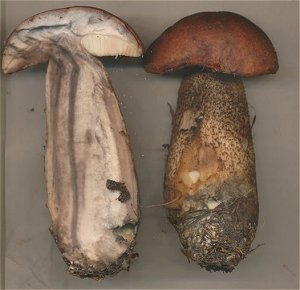
Golf this morning After the heavy rain of Sunday, there was not a lot of smaller fungi about. Another Boletus edulis (Penny Bun) for the pot. A patch of Leccinum aurantiacum, under Aspen. The first of the orange capped Boletes of this year. An attractive foxy red cap with dark brown squamules on the stem, the flesh turns black when cut. A few of the poisonous Clitocybe rivulosa (Fools Funnel) and a large patch of Clavulina rugosa (Wrinkled Club). Both have been growing under the same Hornbeam tree for many years.
Sunday 3rd November 2013
It pored with rain and hail for most of the morning. I had to go out to buy some new Wellingtons. As it stopped raining for a brief period I popped into my local golf course to see if my stack of Monkey Puzzle branches had produced anything. They had. Looks like more Hohenbuehelia cyphelliformis, though very soggy. I shall wait until the weather picks up and them pick them up. I did not need to see a ring of Lepista Nuda (Wood Blewit) to tell me that winter had arrived.
Thursday 31st October 2013

Golf today. First find was of Hygrophoropsis aurantiaca (False Chanterelle) under a newly planted pine. Did the fungus come with the tree? The same small pine also produced two Boletus edulis (Penny Bun). But as the pine is planted close to a birch that produced a further four Penny Buns, it is difficult to say which tree they are associated with. The birch has been supporting the Boletes for many years. My surprise was finding another Boletus edulis under a mature Hornbeam with not a Birch within a hundred yards. A total of 1.25 kilos of edible goodies. I do not win that much playing golf. My best find was of Inocybe mixtilis beside some Poplars. Not a common Inocybe and very similar to Inocybe praetervisa but is smaller at only 2 cms and with much smaller spores.
Wednesday 30th October 2013
Having spent most of the morning looking through my microscope at the remnants of Sunday's foray, I popped out for a quick hunt round the grounds of a merchant's house, now a museum. There is a moderate sized lawn which was alive with fungi. Hygrocybe virginea (Snowy Waxcap), Hebeloma leucosarx , Entoloma sericium (Silky Pinkgill), Leratiomyces ceres (Redleg Roundhead), Cystoderma ammianthinum (Earthy Powdercap), and Clavulinopsis helvola (Yellow Club). Collecting was a bit awkward as people kept looking out of the windows to see what I was doing. The beech wood was quieter and I found Flammulaster carpophilus in the litter. I thought they were Marasmius but the gill colour was wrong.
Sunday 27th October 2013
I led my North West Fungus Group foray to Ainsdale Nature Reserve. After an early shower, the weather was perfect if a little windy. We joined with Merseyside Naturalists in a tribute to Ken Jordan, sadly now deceased. It was Ken who encouraged mycology on Merseyside and this was his favourite site. After a couple of days on my microscope, I have identified over ninety species. Most have been recorded before, as one would expect for a site that has so far yielded almost one thousand species. It always produces something new. This time Pholiota flammans (Flaming Scalycap), Mycena hiemalis and Mycena olida (Rancid Bonnet), two very tiny bonnets that grow on mossy bark. Tricholoma scalpturatum (Yellowing Knight) was also identified. Having never seen before, this is the third site I have recorded it for this year.
Friday 25th October 2013

I was invited to Knowsley Safari Park to look at their woodland as they have a Woodland Walk for families. They want to add a bit of interest to the experience. I was a tad disappointed. Mixed woodland. Lots of fungi but all the same. The only one of interest, that fooled me at the time, was Entoloma longistriatum var. sarcitulum. Took a bit of sorting out but I got there in the end. The animal keepers are particularly worried about their charges eating poisonous fungi. They remove all Amanita muscaria because of its reputation. I was given a full tour of the Safari Park to see if I could see anything of danger. I have offered to be their consultant on such matters. Is their a Mycena hyena?
Thursday 24th October 2013
At last my golf course has come to life. I came home with a few I had not seen on the site for a couple of years and then not very often. Russula vesca (Baretoothed Brittlegill) appeared for only the second time since I have been interested in fungi. Russula aeruginea (Green Brittlegill) and exalbicans (Bleached Brittlegill), the latter being almost completely white and under, unusually, a recently planted Oak. Neither is common on this site. Also Rugosomyces carneus (Pink Domecap) and Entoloma sericeum (Silky Pinkgill), both in short grass on the tees. Because of the rain, the mowers have not been out so often allowing the fungi to grow in places that are intensively maintained.
Tuesday 22nd October 2013

I did my public foray at The National Wildflower Centre. Quite a number of children turned up and they were all very interested, particularly the girls. Lots of very good questions which I was fortunately able to answer. Not many fungi around but most of the interesting ones, Armillaria mellea (Honey Fungus), Agaricus arvensis (Horse Mushroom), Coprinus comatus (Shaggey Inkcap), Lepiota cristata (Stinking Lepiota). None of the adults could smell the Lepiota but all the kids thought is was awful. One of the girls found a Clavaria crstata (Grey Coral). For a grand finale, Amanita muscaria (Fly Agaric). I was limited in what I could say about this in front of the children but they had all read Alice in Wonderland. However, a couple of mature ladies (my age) asked some awkward questions which I had to answer later, over lunch. An excellent morning. However, there was one that interested me. It was not mature so I did not attempt to identify it. I have my suspicions but can not prove it without a spore. Photo attached.
Sunday 20th October 2013
In view of the lack of mycorrhizal fungi at my venue on Tuesday, I decided to add something of interest to what might be a boring foray, especially as it is a family affair. I do not think little children will be too interested in Bjerkandera adusta (Smoky Brackets). I went up to my golf club early this morning and picked some of the numerous Amanita muscaria (Fly Agaric) and Chalciporus piperatus (Peppery Bolete) that are currently growing. They should keep in the fridge until Tuesday. I shall turn up early on and place them at strategic points. As long as nobody kicks them over we shall have something to talk about. I know it is cheating. But this is Showbiz, Baby.
Saturday 19th October 2013

I am booked to take a public foray for The Wildflower Centre in Liverpool on Tuesday. I decided to take a look at the site in preparation. I found very little and most of them were brackets or crusts on dead stumps. Not even a Sulphur Tuft. I shall now have to think of something to make it interesting. People think that because they have a few trees then there will be fungi. Not so.
Monday 14th October 2013
I was invited to Clock Face Country Park, St.Helens. Built on an old coal mine, it opened in 1990 and has been extensively planted with young trees. For a site so young one would not expect to find much, especially as most other local sites are producing very little. It was the best site I have visited this autumn. Russulas, Boletes, Inocybes and Cortinarius in numbers and lots of grassland species. It proved to be a good area for Tricholoma, as we found cingulatum, ustale, scalpturatum and another still waiting for a spore print. I have to admit that I failed with some of the Inocybes and Cortinarius. I took too many home and never really got round to them. Certainly worth another visit.
Sunday 13th October 2013


Today was National Fungus Day. But I did not have a venue because my usual sponsors decided that they would prefer to hold a foray at school half term - which is next week. Makes sense. So, I had a look at my favourite local woods. Not much in numbers but some finds of quality. My first wood at Hale Hall produced two large Grifola frondosa (Hen of the Woods) and a Leucoagaricus leucothites (White Dapperling), the latter being totally new to me. At Speke Hall, they had obviously mown The Great Lawn but there was no sign of broken fruit bodies. Nothing much in the woods apart from Lactarius quietus (Oak Milkcap) and Russula fragilis (Fragile Brittlestem). The adjoining Stockton's Wood produced a very nice Amanita citrina (False Deathcap). However, my day was saved when I got back to the car park where I found six large Boletus edulis under a beech tree. Sadly they were a bit old but I managed to salvage a boxful of stems for drying.
Saturday 12th October 3013
Leaving my allotment, I noticed something orange growing on a piece of timber that had been used as a border of one of the beds of my neighbour's garden. It was at soil level. Being curious, I saw that it was an orange bracket fungus. Not very big, just over an inch. At home, I put some Potassium hydroxide on the cap to test for Hapalopilus nidulans (Cinnamon Bracket). There was no violet reaction. I took a spore print and it was wrong for Hapalopilus. They are right for a Gloeophyllum and the average size of 7 x 4-4.5um is right for Gloeophyllum trabeum. This is an uncommon fungus but it does grown on construction timber. More work needed. I have also been told that new research on Pyronema fungi has decided that the size of the spores is not the deciding factor and that my finds of yesterday were Pyromena omphalodes.
Friday 11th October 2013
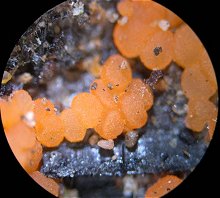
A hard afternoon digging on my allotment. I went for a walk to straighten out my back muscles. There is a small piece of waste land on the site where branches and timber from maintenance work is burnt. I have looked at this area for years without success, probabaly because it is in constant use.Today, I got lucky. I saw the orange colour on the ground but thought it might be the rust from a piece of metal. It turned out to be a Pyromena, a small orange cushion Ascomycete. I identified it as Pyromena domesticum from the size of the spores.
Thursday 10th October 3013

I had to collect a prescription so I popped into my local pharmacist. While I was waiting, I had a look at one of my favourite central reservations. It did not disappoint. Xerula radicata (Rooting Toughshank) under a Sycamore tree. This is the same central reservation area I found Amanita fanchetii. They seem to have a more efficient mowing system now. It is the first time this year that the grass had not been cut.
Sunday 6th October 2013
I joined colleagues for a North West Fungus Group foray at Moore Nature Reserve. Beautiful day. Lots of fungi. I brought lots home to look at under my microscope. Highlights so far are a rare Lepista panaeola, identifiable by the spots on the cap, and Hygrocybe psittacina (Parrot Waxcap).
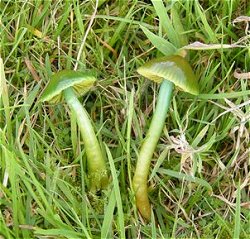

Saturday 5th October 2013

A mixed day. As I parked my car to go to my allotment, I saw two Coprinus comatus (Shaggy Inkcap) growing out of the pavement. I took a photo before they got kicked over. I then found lots of Mycena leptocephala (Nitrous Bonnet) growing under my raspberry canes. After an couple of hours digging, I went for a walk in the adjoining park, just to loosen up the rest of my joints. I only saw one fungus, on old woodchip in a shrubbery. It was not in good condition but I picked it anyway. By the time I got it home, the sweet smell was overpowering. The size of the spores, the strong smell and the description of the cap all suggest Lepiota subincarnata. Except for one book, Phillips, all the authors have the cap size of this species as 3.5cms. Mine is 6cms. I can not find any other Lepiota that fits my research.
Thursday 3rd October 2013


I have been working on my allotment for forty years. In addition to vegetables, I also grow Scarlet Pimpernel. In one small area of the garden the leaves of this plant are infected by a fungus that looks like an Alternaria. This is a circular patch that is very common on cabbages. There is only ONE record for this fungus on the National database. So, for years, I have been scraping away at the leaves, trying to extract a condiophore in order to prove identification. For years, I have failed because the leaves are very soft when fresh and tear. Or they dry so quickly and just crumble. This year, I did it. I got some conidiophores. The fungus is Alternaria anagallidis. I shall ask Kew if they want some.
Wednesday 2nd October 2013
I was waiting for a bus when I noticed some Hebelomas on the grass verge next to the bus stop. Fortunately I was alone so was able to pick some. Not an an easy genus to identify. The had a smell. It was not radishy but not particularly sweet either. These had very long spores, up to 16um and slightly warty. The cystidia were very long and cylindrical.The obvious choice is Hebeloma sacchariolens (Sweet Poisonpie). However, further reading reveals that this species has not been fully resolved so it could be something else. Anyway, it is the best I can do.
Sunday 29th September 2013
North West Fungus Group held a foray at Rostherne Mere today. The day started well with a find of Psathyrella spadicea under a Birch tree. It has distinctive cystidia. Not one I have seen before. A large Grifola frondosa was found on an old stump. Another interesting find was of Ciboria batschiana on an old oak cup. I have no idea how my colleague saw it on the forest floor.



Saturday 28th September 2013

I led a public foray for English Nature at Ainsdale Sand Dunes Nature Reserve this morning. Fortunately we found some of the more popular fungi such as Amanita muscaria (Fly Agaric) and rubescens (Blusher), a few Russulas (Brittlegills) and Lactarius (Milkcaps). So everyone was happy. However, there was one that totally bemused me. A white specimen that I could only identify as a Powdercap because it was very woolly and the powder came off on my fingers. I could not find it in my old Courtecuisse. Having brought it home, I have identified it as Cystolepiota pulverulenta. My photo does not do it justice as it was taken after the foray had ended by which time it had lost is former splendour. Said to be a southern species. Ainsdale never fails to surprise.
Thursday 26th September 2013
I went for short walk to the local golf course to see if the recent rain had improved matters. A few small species. Galerina vittiformis (Hairy Leg Bell) in the moss, Mycena leptocephala (nitrous Bonnet) and what looked like a Psathyrella. It was only 1.5 cms with brown gills. However when I looked at it under the microscope the spores were also very small. Although the spore print was brown, the spores appeared to be yellow. I checked with Mycokey which suggested an Agaricus. So I checked further and came across Agaricus comtulus. Not one I had found before but perhaps I have overlooked it in the past. It can be an advantage having only a few to look at.
Wednesday 25th September 2013
My golf course is improving. The first Leccinum scabrum (Brown Birch Bolete) has appeared, together with Paxillus involutus (Brown Rollrim). The most prolific species at the moment is Lacrymaria lacrymabunda (Weeping Widow), which can been seen in several areas. It likes disturbed ground which is why a very large group is clustered round an area left vacant when a dying horse chestnut tree was removed, stump and all, following an attack of bleeding canker.
Sunday 22nd September 2013


I joined a colleague who was leading a foray at Formby Nature Reserve, where the red squirrels live. This is about two miles south from Ainsdale, where I normally foray on this coast. I was surprised that the fungi species should be so different. The only Earthstar I find at Ainsdale is Geastrum triplex. At Formby it is Geastrum fimbriatum (Sessile Earthstar). We found lots of Chroogomphus rutilus (Copper Spike) and Auriscalpium vulgare (Earpick Fungus), a fungus we struggle to find at Ainsdale. Later in the day we had a look at the sand dunes. We found four species within ten minutes. The star was a Melanoleuca that I eventually identified as Melanoleuca cinereifolia. The one we found was a very light brown. There is a lighter coloured variation named maritima, now incorporated into cinereifolia. The spores, cystidia and substrate are right and no other species fits.
Saturday 21st September 2013

I had been asked to take a foray at the RSPB reserve at Burton Mere but as I did not know the site and the warden was unable to say if it had any fungi (essential), I declined. As Merseyside Naturalists were meeting there, I joined them. The woodland is very small and dry. I only found 24 fungi in two hours and none of them microrhizzal nor any of the most common species which you need if you are holding a foray for the public. The best find was of Gymnopilus junonius (Spectacular Rustgill). The bird life was more interesting. A Hen Harrier, two Hobbies and a Purple Sandpiper.
Thursday 19th September 2013
The weather has gone cold and wet. Despite this, there were dozens of swallows hunting the fairways of my golf course today. I thought they would have migrated by now. The fungi have certainly migrated from Liverpool. All I found on the golf course today was a small group of Lacrymaria lacyrmabunda (Weeping Widow) and a single Psathyrella pseudogracilis.
Sunday 15th September 2013
A colleague has kindly identified the fungus at Munich Mushroom market as Pleurotus eryngii (King Trumpet or King Oyster Mushroom). Sold at Morrisons.
Saturday 14th September 2013
Boletus radicans (Rooting Bolete) keeps turning up on my walks. On yet another central reservation, being the third time I have found it in such a situation. Does it like exhaust fumes? Checking through our database, it had only been recorded in Lancashire (Warrington) once before in 2003. I have now found it for two years running at four different sites.
Wednesday 11th September 2013

Post holiday golf. The golf course is being prepared for the grand finals day so everything has been mown to ground level. A pile of very fresh woodchip produced the usual Coprinopsis lagopus (Haresfoot Inkcap). Also Agrocybe rivulosa, a foreign interloper which seems to be spreading everywhere that new woodchip is used. Golf was abandoned very quickly as it poured with rain. I had collected some branches from my Monkey Puzzle tree in a safe place so I went to see if anything had grown. They were happily supporting some more Hohenbuehelia cyphelliformis. I telephoned Alick Henrici, who, having examined my previous submissions, agrees that the fungus that I found is Hohenbuehelia and not Resupinatus. This is the first record for this fungus a conifer.
Tuesday 10th September 2013

Just got back from Munich where the fungi season is in full swing. The market stalls were loaded. Where do they find all those Boletus edulis (Penny Bun) without insects inside them? Lots of Sparassis crispa (Wood Cauliflower) as well, one I have never seen in the wild. I could not work out what the ones marked 'frisch getrocknet in Schreiber' were. The stem was like a bolete but the cap was flat with rudimentary gills. Any suggestions?
Could they be King Oyster as sold in Morrisons over here? - Paul Hamlyn
Monday 2nd September 2013
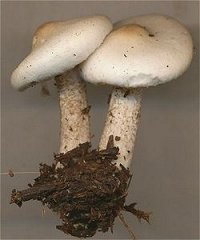
Before I go on holiday, I popped into Hale Hall Wood to see if the Daldinia that I found on Oak last year had reappeared. It had not but there was an old Beefsteak Fungus by the tree so at least my tree identification seems good. Passing a pile of fairly new woodchip, I saw 2 fungi that I thought were Inocybe geophylla. On closer inspection they were not but were small Melanoleuca verrucipes. If you have any new woodchip near you, it is worth a look.
Sunday 1st September 2013



I joined the North West Fungus Group foray at Styal Woods. TV buffs will recognise this as being part of the same National Trust Estate as Quarry Bank Mill. Although it was dry there were lots of fungi about. Xerocomellus, chrysenteron (Red Cracking Bolete) under Pine, porosporus (Sepia Bolete), cisalpinus and pruinatus (Matt Bolete) under broadleaf in other sections of the woods. A good selection of Russulas, including Russula chloroides (Blue Band Brittlegill), with its distinctive blue ring at the top of the stem. Lepiota brebissonii was found in two areas. I associate this fungus with greenhouses and did not expect to find it outside but it had been found at Styal previously. A new species for me and the site was Tylopilus felleus (Bitter Bolete), in good numbers round a large Beech tree.
Saturday 31st August 2013
There are still some doubts about my Hohenbuehelia cyphelliformis versus Resupinatus alboniger. Alick Henrici telephoned me last night to discuss the issue. Now I have to send all my photographs of the one I found last year, the specimen having been deposited at Kew. I also have to send my latest piece of Monkey Puzzle and the photographs I took of the cystidia. Hopefully the matter will be sorted out once and for all. I went up to the local golf coursed to find some more but the car park was full being Saturday morning. I shall wait until this evening when all the golfers have gone home.
Friday 30th August 2013
Had time for a quick walk around another of my park sites. Again, the Beech trees were the only trees producing fungi. More Russulas. Today it was Russula nigricans (Blackening Russula) and Russula grisea (No English name but is said to be the same as ionochlora - Oilslick Russula). On my way home I saw some large Boletes in the middle of a central reservation of the dual carriageway. I parked and saw that they were Boletus radicans (Rooting Bolete) again under Beech. I wonder what the passing car drivers thought I was doing? Fortunately, I am no longer embarrassed.
Thursday 29th August 2013
This morning I visited The Liverpool Garden Festival site, reopened last year having been closed since 1984. All I found was a couple of Conocybe apala (Milky Conecap) and a Parasola plicatilis (Pleated Inkcap) on a lawn. There are lots of trees but it was very dry and overgrown. I shall look again once the undergrowth has started to die back to see if there has been any fungal colonisation. Better luck when I popped into Sudley House on my way home. The site has a small stand of Beech trees that support fungi which are not common in Liverpool. It did not disappoint. Lacatrius piperatus (Peppery Milkcap) is a new one for me and was only finally identified from the subglobose cells in the cap. Russula fellea (Geranium Milkcap), smelling of apples. Two very interesting species were Amanita franchetii (a yellow coloured Blusher) and Boletus radicans (Rooting Bolete). I have only found these once before, on a dual carriageway, where they grew together as they did today. I wonder if they have some connection other than a liking for Beech?
Wednesday 28th August 2013
I took a late evening walk to one of the larger Liverpool parks at Calderstones. Lots of mature trees which were supporting a range of Russulas (Brittlegills) - parazurea (Powdery), amoenolens (Camembert), ionochlora (Oilsli) and ochroleuca (Ochre) together with Lactarius tabidus (Birch Milkcap). I only had time to survey a small corner of the park so I must go back soon while the fungi are growing well.
Tuesday 27th August 2013
The first Leccinum scabrum (Brown Birch Bolete) of the year on my golf course. At home, my wife's patch of Lobelia seems quite productive. In addition to the Laccaria tortilis it now supports a small colony of Inocybe acuta (Fibrecap). Always difficult to identify, this has knobbly spores and a slightly enlarged base to the stem. The telling feature is the size of the cells which make up the cap. These are very broad, some with clamps holding them together.
Monday 26th August 2013
Went for a walk in my local parks this afternoon. Plenty of fungi about, mainly Russula parazurea (Powdery Brtittlegill) under many of the Beech trees. Russula atropurpurea (Purple Brittlegill) and amoenolens (Camembert Brittlegill), both under the same Liriodendron tulipifera (Tulip tree) an interesting and very unusual host. A large group of Collybia confluens (Clustered Toughshank) was growing under some Rhododendron very close to some Psathyrella candolleana (Pale Brittlestem). At last, the season is getting started.
Sunday 25th August 2013

Last year I found a small fungus on a Monkey Puzzle branch. I identified it as Hohenbuehelia cyphelliformis. Soon after, an article appeared in The Field Mycologist that a rare Crepidotus alboniger had been found on Monkey Puzzle. It looks exactly like the H. cyphelliformis but does not have the distinctive Hohenbuehelia cystidia. I have to confess that I did not find any cystidia on my specimens but as I had no information or even heard of the Crepidotus, I plumped for H. cyphelliformis based on the description and the spores. Was I correct? I found some more today from the same tree. This time I found some typical Hohenbuehelia cystidia, so I was right first time. It is H. cyphelliformis. I am beginning to wonder if the people identifying C. alboniger found, as I did, a cyphelliformis without cystidia, or just could not find the cystidia, as I did not. Allantoid spores are not typical of a Crepidotus.
Friday 23rd August 2013
My golf course is producing fungi at last. Lots of Leccinum duriusculum (Slate Bolete). Almost every Aspen tree had a fruit body growing beside it. Suillus grevillei (Larch Bolete) in good numbers in the usual copse. Both of these species are fruiting late this year. I usually find them first in June and July. Lots of Amanita rubescens (Blusher) under the Birch. Also a couple of Agaricus arvensis (Horse Mushroom). Sadly they were full of maggots so not fit for breakfast.
Wednesday 21st August 2013
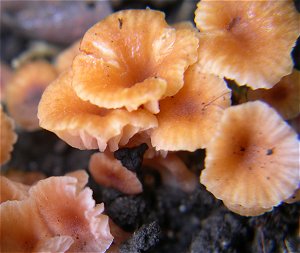
I went to my allotment this afternoon and found a very nice Agaricus campestris (Field Mushroom) on a grass path. One for breakfast. When I got home, my wife directed me to a large group of Laccaria tortilis (Twisted Deceiver) growing with Lobelia in my small suburban garden. You just never know what will turn up.
Thursday 15th August 2013
At last, my golf course has produced a fungus. Only one Russula ochroleuca (Ochre Brittlegill) but it is a start. I thought it was an early specimen but my records show that this species has regularly appeared in mid July. Lots of Panaeolina foenisecii (Brow Mottlegill) but nothing else.
Tuesday 13th August 2013
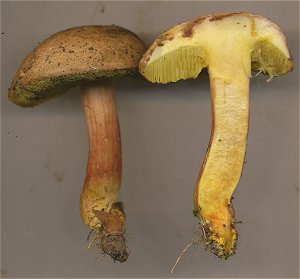
At last. Some fungi have appeared. The first on bare soil in a shrubbery turned out to be Parasola kuehneri. Looking very much like plicatilis (Pleated Inkcap) but the habitat was wrong and the spores too small. One of a number of Inkcaps that all look the same and can only be identified by recording the shape and size of the spores. Very difficult to split them. The second, another difficult genus, proved to be Xerocomellus engelii. This can be identified by the bright orange spots at the base of the stem. You have to be very careful when collecting specimens to ensure that the base of the stem is intact otherwise there is little point in trying to identify them as the important information is lost.
Monday 12th August 2013

I have been away enjoying myself so have not been able to pursue fungi for a couple of weeks. I did find Agaricus arvensis on my allotment site but, although new for the site, is.not otherwise unusual. One of my colleagues has found a great abundance of Quaternaria quaternata on cut Beech trunks in Lancashire. In some cases, covering several metres. Not uncommon but only one previous record for Lancashire. Perhaps another example of fungi moving north as the climate warms up.
Wednesday 31st July 2013
On Saturday, as we left the woods, we saw a large, yellowish, resupinate fungus growing on a large cut trunk. My immediate thought was Schizopora. I took a piece off to show my companions and saw that it had rounded pores rather than slots. At, home, I scraped it but nothing much showed under my microscope. I put it on some wet paper to soften it up a bit and then put some on a slide for a spore print. The result was a host of tiny allantoid (sausage shaped) spores. Using Mycokey, I narrowed it down to Skeletocutis and further research on the Internet arrived at Skeletocutis vulgaris, one of the few of this genus that prefers broadleaf trees.
Saturday 27th July 2013
I went out with the Liverpool Botanical Society to the Mersey shore at Hale. I was looking for rusts and mildews as I keep finding them but have difficulty identifying the plants. My cunning plan was that the biologists would identify the plants for me. They did but I did not find many rusts. I have managed to identify Puccinia veronicae on Wood Speedwell, Cercospora apii on Wild Celery and Lentithecium arundinaceum on the dead Reed stems. A couple of Ink Caps on some woodchip and a fresh Chicken of the Woods were the only larger fungi to be seen. Still very little rain and it was a blistering hot day again.
Wednesday 24th July 2013
Flooding in Lancashire and Cumbria, Lightening strikes and rain in Manchester. Liverpool gets one light shower. So everything is still bone dry. The only fungus seen on my golf course was Polyporus squamosus (Dryad's Saddle), notable because I saw it in the same place on the same date last year.
Friday 19th July 2013
Another gilled fungus at my golf course. Panaeolina foenisecii (Brown Mottlegill). Growing in very short grass on the side of one of the tees. I do not know how it has survived the hot weather as the course is bone dry and starting to turn yellow.
Wednesday 17th July 2013
Still very hot but it is golf day. The course is very dry. But, at one hole, they have recently cut down and replaced the old rhododendron bushes with new shrubs. At the same time a lot of locally produced woodchip was introduced. The site lies in the shade of a copse of trees so does not get much sun. Today I counted 24 Volvariella gloiocephala (Stubble Rosegill) growing in the woodchip. And I forgot to take my camera.
Sunday 14th August 2013

I led a North west Fungus Group foray at Carr Mill Dam today. After such a blistering hot July, we expected little. However, the site was selected for a summer foray because a lot of it is flooded during the winter. The ground was still soft and a bit boggy, so the plan worked. The fact that we found a number of Scutellinia scutellata (Common Eyelash) gives an indication of the conditions. Lots of Ascomycetes and crusts under the logs and branches. An interesting find was of Eutypella scoparia, a small Asco with digital outgrowths. I also identified Mycoacia uda, a yellowish toothed crust fungus which was new for me. Some gilled fungi were found. Russula parazurea (Powdery Brittlegill), Conocybe rugosa and Coprinellus micaceus (Glistening Inkcap) and a few Mycenas. Also a number of Polyporus tuberaster (Tuberous Polypore). This is the only site in Merseyside that I find this fungus. We collected over forty specimens so not a bad day in view of the weather.
Thursday 11th July 2013
Just got back from Heidelberg. Very hot there. The only mushrooms were on the market stalls, chanterelles and not very many of those. My allotment was a jungle so I have spent the last few days, picking, cutting, weeding and strimming. One weed was rampant, Nipplewort. At least it was sporting a fungus, Puccinia lapsanae. Not very exciting but the best I can do in this weather.
Saturday 29th June 2013

After two long awaited solid days of rain I decided to take a look at Speke Hall. Being Saturday, it was packed. So I went into the adjoining Stockton's Wood, which was empty and peaceful. As soon as I entered the wood, I could smell the Stinkhorns (Phallus impudicus) and soon found some. A fungus with a gill and stem but only Hypholoma fasciculare (Sulphur Tuft). Well it is a start. A very nice Polyporus tuberaster (Tuberous Polypore) was growing from a stump, softer and whiter flesh than the similar but much tougher Polyporus squamosus (Dryad's Saddle). And it was growing from a central stem. Resupinatus applicatus (Smoked Oysterling) on rotten wood and a few crust fungi but not much else of interest.
Thursday 27th June 2013

Last month, I was sowing some seeds, using pieces of bamboo cane to mark the rows. One piece of bamboo had a fungus growing on it. I could not identify it so I consulted my colleague in Oban. He could not identify it so it was sent to Kew. It has now been identified as Astrosphaeriella stellata. I have to admit that this is beyond my literature and capability. It now resides at Kew Herbarium and has an official number K(M)187041. I have checked with the National Database and it is not recorded. So how did this fungus finish up on a tiny piece of bamboo cane in Liverpool? As every one says - Its amazing!
Wednesday 26th June 2013
As a member of the Seniors golf team, I played at Huyton Golf Course. Still no rain so it was no better than my own course. The only fungus I found was Kretzschmaria deusta (Brittle Cinder), which seems to be common at the moment. Most of my recent finds have been of Ascomycetes on branches and twigs. Even though I have Peter Thompson's book on Ascomycetes, I am still struggling to identify them.
Wednesday 19th June 2013
Golf today. Still no rain. But I found a gilled fungus at last. The first this year for this site. Volvariella gloiocephala (Stubble Rosegill) growing with woodchip in an ornamental shrubbery.
Monday 17th June 2013

I was at my allotment garden and decide to pull up some overlong grass on my paths surrounding my onion bed. Guess what? I found a patch of Epichloe typhina (Choke) growing on Agrostis solanifera (Creeping Bent Grass). Now must be the time to look for the white collars on grass stems. What a coincidence.
Thursday 13th June 2013


I was invited to join Professor Tom Bultman of Hope College, Michigan, to assist in looking for Epichloe (Choke) fungi at Court Hey Park. It is a fungus that grows on grass and chokes it so that the seeds are not viable. We managed to find a couple of patches of Epichloe typhina. It was a bit like looking for a needle in a haystack. The interesting thing is that the spores are carried from plant to plant by a fly that also lays eggs on and eats the fungus. This fungus is host specific which means I shall have to be able to identify the grass it grows on. I also made a very good find of Pleurotus pulmonarius (Pale Oyster) on a fallen Beech.
Sunday 9th June 2013
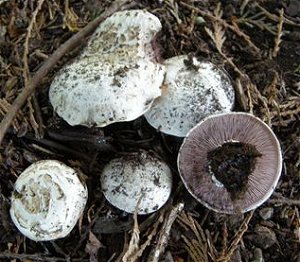
At last. I took an early morning walk in the park and found some gilled fungi. First was a group of Agaricus bitorquis (Pavement Mushroom) under a Cupressus. Second Parasola plicatilis (Pleated Inkcap) in a flower bed. Then a third growing under a log but it was too far gone to identify. I also found a couple of Ascomycetes but even after studying the latest book, I still struggle. Rain is forecast so things should improve.
Saturday 8th June 2013

I was sowing some seeds on my allotment, using bits of bamboo cane to mark the rows when I noticed that one piece of bamboo was displaying lots of tiny black Ascomycetes (spore shooters). Under my microscope I saw that they were papillate. The usual species of this shape are in the families of Rosellinia or Lophiostoma. However, the spores were the wrong shape being very long at 41um and 2 septate (two sections). After a lot of research I have reached a conclusion that they are Herpotrichia macrotricha. Unfortunately, I can not find a decent picture of this species to compare with my find. As Ascos on Bamboo are unusual, my friend in Oban wishes to see them. So they are off to Scotland.
Tuesday 4th June 2013
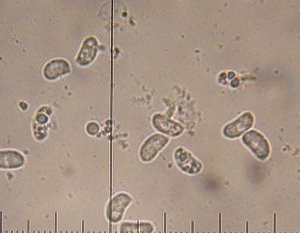
I am still finishing off my collection from last week. One I picked up on a fallen stick in a beech wood. It looks like Hyphdontia sambuci (Elder Whitewash), which is what I thought it was. I decided to check it anyway and surprise, surprise it was not. I have identified it as Exidiopsis effusa. It has large sausage shaped spores, up to 17microns. But some of them have extensions (handles). This is because it forms secondary spores by repetition. (I don't know how that works either). It was difficult to get a sample without the wood and as soon as the slide was prepared, the spores seemed to fall apart very quickly. By by the time I got my oil immersion prepared they had gone. Very strange. Just because something looks like Elder Whitewash, it is worth checking because it might not be. You just never know.
Sunday 2nd June 2013

I went for a walk at my local golf course. Still nothing with gills and a stem. I have not yet seen St. Georges Mushroom or Spring Cavalier. I came back with another collection of crusts and spots. Underneath one log I found some discomycetes that were surrounded by an orangy coloured fluffy substance. The discos turned out to be Mollisi cinerea (Grey Disco). The fluffy stuff had very interesting microscopic features that I eventually tracked down as being conidiophores of Botryobasidium aureum. Not one I have identified before. It is similar to Botryobasidium conspersum but the conidiophores are larger and more irregularly shaped.
Thursday 30th May 2013
Just got back from Normandy and had to sort out my allotment and pot up the tomatoes. A piece of fallen branch from a neighbour's tree caught my eye. Some tiny fungi were growing underneath. They turned out to be Resupinatus applicatus (Smoked Oysterling). Not unusual but this year I have found this fungus on every foray so far. Perhaps the particular weather conditions are to its liking.
Sunday 19th May 2013
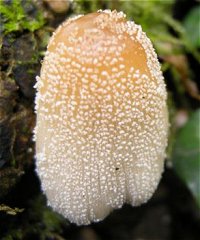

I helped out at a Bioblitz at the request of a colleague. The venue was Beacon Hill Country Park at Skelmersdale. A new site for me. Very varied woodland with lots of different tree species and lots of fallen wood. Not much in the way of gilled fungi yet, Coprinus micaceus (Glistening Inkcap), Resupinatus applicatus (Smoked Oysterling) and Strobilurus tenacellus (Pinecone Cap). Lots of brackets, Inonotus radiatus (Alder Bracket) and Trichaptum abietinum (Purplepore Bracket). Prettiest is Lachnum bicolor, a small disco Ascomycete (spore shooter) on oak twigs. Nice site, nice day. Must put it down for a full foray as it has large car parks and a ladies loo.
Thursday 16th May 2013
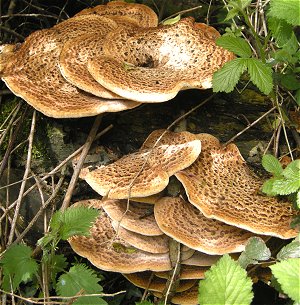
I popped up to my local golf course to see if anything had started to grow. That little Polyporus squamosus (Dryad's Saddle) that I reported last month has really developed, living on a fallen tree trunk with some Pleurotus ostreatus (Oyster Mushroom). Dryad's saddle is one of my favourite finds.
Tuesday 14th May 2013

I have been going through my collection from Sunday. One, I thought was a Peniophora, with encrusted cystidia, had spores that were far too small. I was stuck, so I tried MycoKey. It came up with Scopuloides. That was it. Unfortunately there are two Scopuloides, rimosa and hydnoides. The differences are very subtle. I have plumped for rimosa.
Sunday 12th May 2013

I joined The North west Fungus Group at Rivington Country Park for our monthly foray. Not a lot around. Even looking under logs produced very little. Had it been too dry, too cold or even too wet after recent heavy rain. Anyway, the fungi were in hiding. Lots of Peniophora quercina on fallen oakbranches. A Fuscoporia ferreus (Cinnamon Porecrust) on the underside of a branch. The only gilled fungi were two Oysterlings, Crepidotus cesatii and Resupinatus trichotis, which has a mass of hairs on the top of the cap. Nice find. We had lunch. Then it poured down yet again. I went home.
Saturday 11th May 2013
The Merseyside Naturalists held a meet at Carr Mill Dam today. They usually bird watch but I decided to join them as it gave me the opportunity to check out the area before I lead a foray later in the year. It is very old woodland and always produces a good selection of interesting species. Although it has and did rain, the temperature has dropped so not much was to be found. I collected a few rusts and crusts but only one gilled fungus, Mycena acicula (Orange Bonnet).
Friday 10th May 2013

The Reserve Manager has sent me a photo of Morchella elata, at Ainsdale Sand Dunes Reserve. It was not at their usual spot, at which we found nothing this year. This was a mile further north near one of the slacks that we do not include in our usual route. At least we know they are still there, somewhere. I must pop up and investigate to see if it is worth including in our next foray there.
Thursday 9th May 2013
Although I have been inactive, some of my colleagues have been foraying. Liverpool has dried up but not all of the north west has missed the rain. One of my colleagues follows the blogs on the Wild About Britain website. Prompted by a recent post he set about looking for a smut that grows on the leaves of Persicaria bistorta. (Bistort). The smut, Bauhinus marginalis is described on The National Database as 'Extinct 1921 (Red Data List). Off he went into he depths of Lancashire and found it straight away, at three sites so far. Bistort grows on my allotment. I shall be extra vigilant this year.
Wednesday 8th May 3013
I have had nothing to report since we went to Ainsdale on the 14th April for the very good reason that it has not rained since then. Everywhere is dry and not a fungus to be seen I have not yet seen any Calocybe gambosa (St Georges Mushroom) which has never failed me at my golf course. So I have been updating my records, making sure I have the current names. Checking my Ainsdale Sand Dunes nature Reserve, SSSI, I now have 922 different species recorded. And that is from the collections I know about. If you then add Ainsdale & Birkdale Hills Reserve, Ravenmeols and Freshfield Dune Heath, this is a very productive coastline.
Thursday 25th April 2013

I have finally finished my last specimen from Ainsdale, now ten days old. I kept it moist in a box. It is a pinkish-brown crust fungus on a piece of blackberry twig. Should be easy. I identified all the necessary bits but could not match it to anything in any of my books. I turned to MycoKey, the internet identification guide. I ticked all the boxes and it suggested Aleurodiscus. A quick check on other internet sites turned up Aleurodiscus aurantius. Job completed. Not one I had seen before but seemingly common enough on Rubus and rosae families.
Wednesday 24th April 2013
Since my trip to Ainsdale I have found very little locally. The start of a Polyporus squamosus (Dryad's Saddle). Diatrype stigma (Common Tarcrust) in a pile of twigs. Most of my time has been spent trying to identify the finds from Ainsdale. It is annoying when you seem to have all the necessary bits but still can not identify the species. One of our forayers had an interest in lichen and identified a number of species about which I would not have a clue. Lichenised fungi are included in the National Database but some of the stuff he identified are not. Not sure what to do with them.
Sunday 14th April 2013

Today, I led my foray at Ainsdale Sand Dunes Reserve. Fortunately a beautiful spring day if breezy. At least the flooding had receded and we were treated to a multitude of mating toads. We even found a Great Crested Newt under a logpile, still drowsy but warming up. Not a great deal about as it has been so dry. But we reached thirty quite easily and I have a number of ascomycetes to still sort out. Highlight was the discovery of numerous Monilinia johnsonii on hawthorn berries. They were well hidden in the undergrowth but some dedicated scraping revealed them.
Monday 8th April 2013
I recently identified Hohenbuehelia cyphelliformis that I found growing on a fallen branch from a Monkey Puzzle Tree. I dried it and sent it to Kew Herbarium. I have just received the latest Field Mycology magazine. It has an interesting article about Resupinatus alboniger. This not a fungus I have heard of and it is not in any of books. Unfortunately, it looks like Hohenbuehelia cyphelliformis and has exactly the same spores. And there have been two records on Monkey Puzzle trees. The only difference is in the cystidia. Whoops. I have suggested to Kew that someone re-examines them. Still a good find, whatever it is.
Thursday 4th April 2013
I went to Ainsdale Nature Reserve to check on the situation before I lead my foray next Sunday. Last month part of it was flooded due to a blocked drainage system. It has gone down but some of it is still boggy. I did not spend any time foraying as I was more intent on working out a safe route. All I found were some Bovista plumbea (Grey Puffball), but I am sure more eyes will produce more results. It is very noticeable how dry the surface has become. The top soil of nearby fields was being blown across the main road by the strong wind. Rain is forecast for next week. I hope they are right.
Sunday 31st March 2013
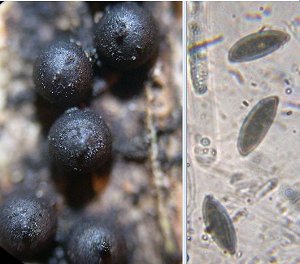
Still very frosty so I have not been able to sow or plant anything on my allotment. I checked a pile of prunings and twigs on a neighbour's site and found a some Rosellinia aquila. It was fairly easy to identify as the spores have appendages. One is very clear on the largest spore. I found a good number of sites on the Internet which showed photos of the fruitbodies and spores for this species. I found this very helpful as it is not pictured in any of my literature, although I probably would have sorted it out using my old version of Ellis & Ellis.
Thursday 28th March 2013

One good thing about the snow and high winds is that a large number of dead wood has fallen from the trees. These branches and twigs must have had something wrong with them and therefore worth looking at. A thin branch that dropped off a beech tree had a brown hard crust-like fungus. I put it onto some soaked paper to soften it up and make it easier to extract some spores.. It then showed itself to be Merismodes anomala, so no further examination was necessary.
Wednesday 27th March 2013

It has stopped raining. It is snowing instead. I have not been able to get out at all, so I have been looking at some of my mysteries. The ones I can not identify. One little specimen that I found on a dead blackberry stem has had me fooled for months. I put a picture on to one of the forums to see if anyone else could help. That was three weeks ago. Until yesterday, I had no response. I have now had one suggestion, a species of Volutella. Never heard of it. The spores seem wrong but there is very little information available to me. I shall probably never know what it was.
Sunday 17th March 2013

Clearing up at my allotment this morning, I noticed some small lesions on a dead blackberry stem. I managed to get some spores out of them using a very sharp razor blade and a lot of patience so as not to get any of the woody material. Otherwise the slides just break. With the help of Messrs. Ellis & Ellis, I have identified them as Clypeosphaeria mamillana. Said to be common but you need good eyesight to find them.
Thursday 14th March 2013
After the bitter weather at the weekend it was nice to get out for a quick walk to my local golf course. We did not get much snow here and the ground is still very dry. So not much around yet. I found the slime mould, Trichia scabra, hiding in hollows under fallen branches. I find it impossible to tell this from Trichia varia without looking at it under a microscope. It depends on the pattern of the elaters, spiral strand features inside the fruit body. Also the spores are very yellow. Another find that might confuse was the tiny cuplike Tapesia fusca. In the field it could be mistaken for Mollisia cinerea (Common Grey Disco) but the spores are longer and thinner.
Friday 8th March 2013
Parking at the supermarket, I noticed that the bark of some dead branches was loose. Suspecting a fungus,I snapped a bit off and took it home. Close inspection showed that the exposed wood clearly had a pale covering of some sort. A few scrapes on to a slide and under my microscope. I found a number of quite large sausage shaped spores which fit the description for Vuilleminia comedens (Waxy Crust).
Tuesday 5th March 2013
Managed to get out for a quick visit to my fallen tree on the local nature reserve. It is rotting away very quickly. Not much around as it has not rained for two weeks. A few brackets and crust fungi but they are also dry and difficult to extract the necessary microscopic information. I managed to identify Fomitiporia punctata (Elbowpatch Crust) and Polyporus brumalis (Winter Polypore). Not too difficult as it is orange coloured. I was surprised that some more mature trees had fallen, their anchorage to the ground probably weakened by flooding. The area was littered with fallen branches. Looks promising for the fungi but I would not like to visit when it is windy.
Saturday 2nd March 2013
Out came the micrometer, first thing this morning. Having calibrated the eyepiece, I went for a wander to find something to look at. Of course, after months of torrential rain, it has not rained for over a week and everything has gone dry. I wonder if we are going to have another dry spring, which is not good for my allotment as it is difficult to get seeds to germinate. Fortunately, I knew where to find some Geastrum triplex, so I was able to test my measurements out on the spores. Spot on.
Friday 1st March 2013
Today, I took delivery of my brand new microscope, an SP100. My old Pryor has been gradually deteriorating and I have had problems with the illumination that I am unable to fix. It still works but an update is long overdue. Now I must go out and find something to look at.
Saturday 23rd February 2013
Today we held the AGM of the North West Fungus Group at Risley Moss. I had to give my annual foray and recording report to an entranced audience. We were then treated to a talk by our President, Professor Bruce Ing. His subject was Powdery Mildews of which I have some knowledge as my allotment vegetables and resident weeds are frequently attacked by these fungi. It is with some satisfaction that, up to now, using my copies of Ellis & Ellis and Dennis, I have been able to identify most of them and their host plants. We have now been told that, following DNA research, the number of such Mildews has increased from 60 or so to over 130. Not only that, but similar DNA on the associated plants has resulted in major reclassification of those as well. The conclusion is that, not only do I no longer know the identity of the Mildews I have examined but that I do do not know the identity of the host plants either. My daisies may not now be daisies.
Sunday 17th February 2013

A beautiful spring morning. So I went to Ainsdale Nature Reserve for a look round and to see if any morels had gown. I was very disappointed. Our usual productive sites were flooded due to a collapsed drainage ditch. Heavy machinery had ploughed up a large area in order to build fire breaks. The usually dry slacks were also flooded. Good news for the natterjack toads but not for the morels. Never mind. It was a good healthy walk before foray season begins. A couple of Tubarias (Twiglets) and some as yet unidentified crusts were all I had to show for my effort. One of our members has found some Mitrula paudosa (Bog Beacon) up in the Pennines so I hope to pay a visit and see those very soon.
Thursday 14th February 2013
The snow and rain of the last two days had stopped and the sun came out. So I went for a walk to my local park. Nothing much around. Just mud and puddles. I did manage to find some Panellus stipticus on the cut end of a fallen beech tree but that was all.
Wednesday 13th February 2013
I received an message from Kew that they do not need my Schizophyllum amplum because they have the ones I sent last year. If I find some in Cheshire or on wood other that poplar, then they would be interested. They tell me that they have sample of this species from all seasons except summer. When I found my branch, I put it in my golf bag to take home. Four hours later the fungi had dried up and were invisible. I had to put my branch in a bucket of water to rehydrate them before I could examine them. This may explain why they are not found in summer. With all the rain we have had recently, now is probably a good time to look for them.
Tuesday 12th February 2013

One of my colleagues spotted a fungus growing on a fence post but could not identify it. Having read his directions I set off along the Mersey Way, a very muddy public footpath along the banks of the Mersey Estuary. Although next to Liverpool Airport and a housing estate, this piece of countryside must be one of the bleakest places in England. Fabulous for birds, as I saw Shelduck, Pinkfoot Geese, Curlew and Sparrow Hawk but it was bitterly cold with the wind blowing in from the river. I found the said fungus which turned out to be Gloeophyllum sepiarum, a species that likes fence posts. Known as Conifer Mazegill, I found this species a couple of years ago but growing on willow. I sent it and a piece of the wood as proof, to Kew Herbarium where it now resides.
Friday 8th February 2013

I played golf today. My ball landed beside a fallen branch of which there are many after the recent weather. I picked the branch up to move it so that I could hit my ball. I saw what I thought were Crepidotus but they had no gills. I put the branch in my golf bag to look at later. Now that I have looked at the fungi, they have no gills. Because they are Schizophyllum amplum. They are not very big, 0.5 cm max. so the photos are not as good as I would like. The interesting thing is that the branch fell off a Manchester Poplar, which is a hybridised Black Poplar. Last year I found this species at Speke Hall, on Poplar, on the 17th February. This may be the time to look for this uncommon fungus.
Wednesday 6th February 2013
My golf course was closed, even though it was sunny, so I went for a look round two of my favourite woods at Hale. The woods are on the banks of the Mersey Estuary. The wind was bitingly cold. After the heavy snow all the vegetation was flattened. There were lots of fallen branches and I quickly put together a dozen specimens of various crusts, brackets and slime moulds. Back home under the microscope, I managed to identify all but one. They all produced spores. Sadly nothing unusual. The ones I thought were promising turned out to be common species, Phellinus ferreus (Cinnamon porecrust), Penniophora limitata, Byssomerulius corium (Netted Crust). Even the slime moulds, Trichia varia and Didymium squamulosum, are probabaly the two most common in the UK.
Sunday 3rd February 2013
My neighboring allotment is cultivated by a lady who works abroad a lot. I noticed that the stems on her broad beans, which have been unharvested since August, were now displaying rows of a tiny black fungus. As it was another rainy day, I picked a stem. I thought it would be a Diaporthe or something similar. However, when I looked at it under my microscope I saw that the spores had tails, like tadpoles. The fungus is a rust, Uromyces viciae-fabae. This is very common and can cover a plant with orange pustules. I did not realise that it totally changed form as it aged.
Friday 1st February 2013


I found a myxomycete on a beech trunk just before Christmas. A spectacular orange colour. As the weather was a bit kinder today, I went to see what it had developed into. The transformation is startling. I have provisionally identified it as Badhamia urticularis. Not my best subject but I can now see why people get so interested in Myxos.
Tuesday 29th January 2013

At last the snow has gone. We got quite a battering and it has brought down a few branches for future examination. Also the vegetation has been squashed flat, revealing a lot of fallen trunks and stumps that I had not seen before. I was surprised to find Leratiomyces ceres (Redleg Roundhead), not on woodchip but on a fallen tree in natural woodland. Another find was Sarcoscypha austriaca (Ruby Elfcup). Although this a very common early spring fungus, not so in Liverpool. This is only the second time I have found it on my patch in twenty five years. I wonder why not?
Tuesday 15th January 2013
Just got back from snowy Northumberland. A colleague asked if I could identify a white bracket that had started to grow from a snapped trunk, so I went to take a look. It was a white Trametes, with just a faint hint of a yellow zone on the edge. A difficult one because the genus is very common and seems to have an infinite variety of colours. Fortunately it produced some spores which enabled me to identify it as Trametes pubescens. Not one I identify often but I rarely collect specimens as even the light coloured ones almost always turn out to be the very common Trametes versicolor (Turkey Tail).
Friday 11th January 2013
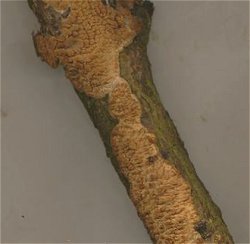
Played golf this morning. It had rained all night and the ground conditions were atrocious. Surprised it was not closed. Still things about. Agaricus langei (Scaly Wood Mushroom), sheltered under some Cupressus, Aleuria aurantia (Orange Peel Fungus) making its usual early winter appearance, lots of Laccaria laccata (Deceiver) clustered around a newly planted ornamental conifer and a fallen oak branch supporting both Exidia glandulosa (Witches Butter) and Radulomyces molaris. Not bad considering that the aim of the exercise was to hit a golf ball, not foraying.

Sunday 6th January 2013
No rain again. I did a couple of hours digging on my allotment. To unloosen my back muscles, I went for a walk to my local golf course which is just across the road. I was surprised to find Clitocybe phyllophila (Frosty Funnel) attached to a pine twig. Another find was of Phellinus ferreus (Cinnamon Porecrust), which can only be identified by its cylindrical spores. What I thought was a Mycena on a holly leaf turned out to be the slime mould, Didymium squamulosum. But the star of the day is Pluteus phlebophorus (Wrinkled Shield). New to me but not rare.
Friday 4th January 2013
I went to Frodsham Hill, a wooded, sandstone outcrop that I thought might be a possible foray site. I was wrong. The very muddy path, along the side of a cliff was only suitable for a mountain goat with webbed feet. In the three hours I was there, all I saw were Laetiporus sulphuareus (Chicken of the Woods) and a few Crepidotus cesatii (Oysterling), a Phellinus and a Mycena (Bonnet). So I shall not return to look for fungi but the view over The Mersey Estuary is magnificent.
Tuesday 1st January 2013

Well. The sun came out so I could not stay at home doing nothing. I had one local park I had not been to LAST year. The first fungus I found was Bjerkandera fumosa (Big Smoky Bracket), then Resupinatus trichotis (an oysterling with black hairs on top of the cap). I saw a man looking very carefully at a fallen tree, trying to figure out what were the fungi growing on it. So I enlightened him. They were Flammulina velutipes (Velvet Shank) which he happily photographed. I was also able to point out some Scutellinia scutellata (Common Eyelash) growing on the same trunk. He went on his way very happy. Mycena speirea (bark Bonnet) and stylobates (Bulbous Bonnet) in the litter. And a few crusts to look at at home - when it rains.
